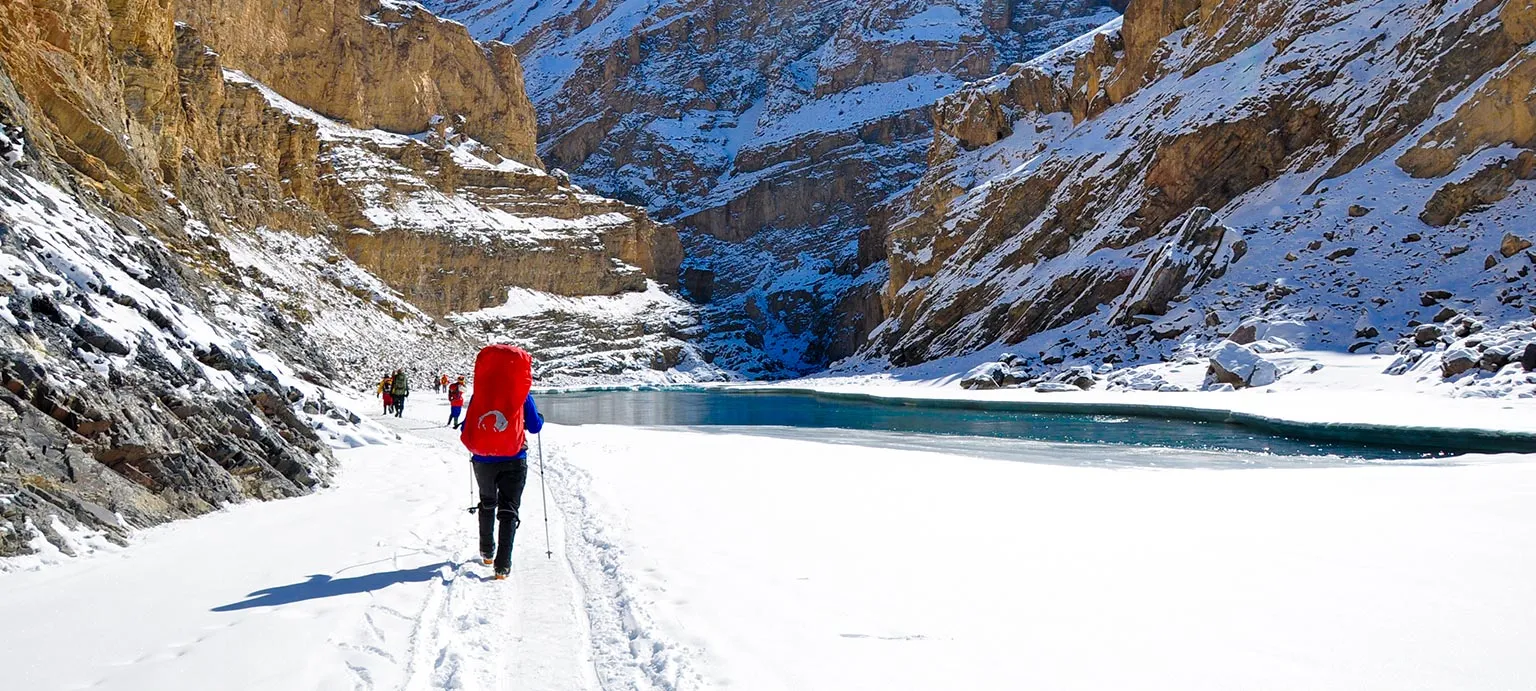

Chadar Trek Frozen River
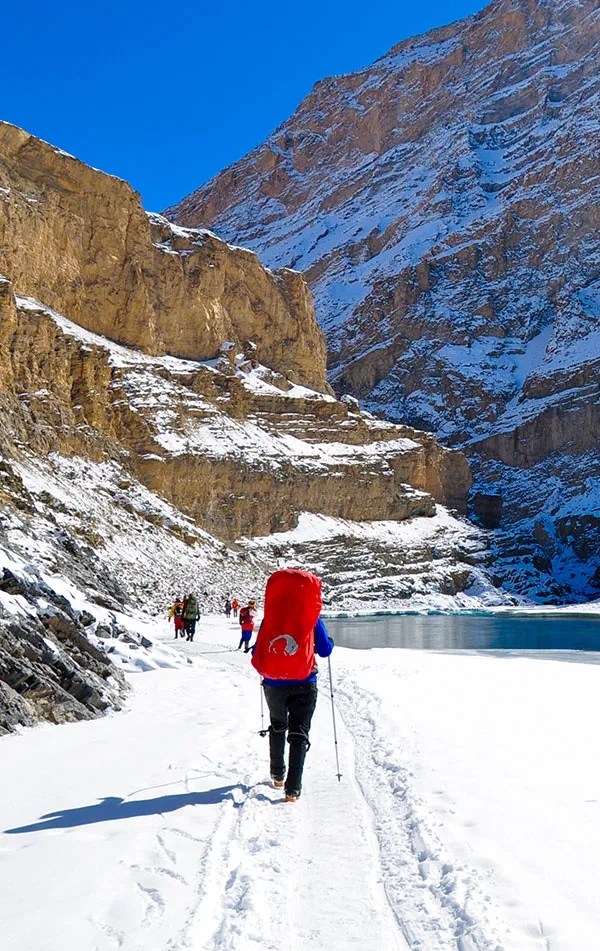
Ladakh | India
Max Altitude
Trekking Km
Help & Support
26500 /person $ /person.
- +5% GST (goods and services tax)
- Services Leh to Leh
For more information. Please complete this form.
Help & Support
Trek Name: Chadar Trek Frozen River
Adventure Type: Trekking
Base Camp: Leh
Season: Winter |
Month: January | December |
Country: India
Altitude: 11100 Ft.
Grade: Difficult
Rail Head: -
Stay: Hotel & Camping
Food: Meals while on trek
Location: Ladakh
Distance: 62 Km.
Trail Type: Point to point trail | Camping at the same location upon returning.
AirPort: Leh (Kushok Bakula Rimpochee)
Why Chadar Frozen Trek is a Must-Do Trek?
- The Chadar Frozen Trek is renowned as one of the world's most iconic and challenging treks, offering a unique and extraordinary experience for adventurers.
- Takes trekkers through the starkly beautiful and remote landscapes of Ladakh, providing an opportunity to witness the untouched beauty of the region.
- Trekkers traverse the frozen Zanskar River, experiencing the thrill of walking on a solid ice sheet, transforming the river into a surreal frozen wonderland.
- Trekkers face extreme winter temperatures, with the mercury often plummeting well below freezing, reaching as low as -30°C (-22°F) during the night. This challenging environment adds an element of resilience to the trek.
- Provides an incredible cultural experience as trekkers pass through the remote villages and interact with the local communities along the frozen river.
- Highlights the awe-inspiring Nerak Waterfall, a significant milestone on the trek. The frozen cascade of ice is formed due to the chilling temperatures, creating a mesmerizing natural wonder.
- Features the Tibb Cave, a naturally formed overhang along the frozen river cliffs. This cave serves as a crucial shelter for trekkers, offering respite from the biting cold, wind, and a place to rest, warm up, and prepare meals.
- The trek is only possible during the frozen winter months, making it an exclusive and limited-access adventure that adds to its allure.
- For those seeking a rare and challenging experience in the Himalayas, the Chadar Trek is considered the ultimate choice, providing a blend of natural beauty, cultural immersion, and physical challenge.
The Chadar Frozen Trek , located in the northernmost part of India in the region of Ladakh, is one of the world's most iconic and challenging treks. The trek takes adventurers on an extraordinary journey along the frozen Zanskar River offering a unique opportunity to explore the starkly beautiful and remote landscapes of Ladakh, complete with breathtaking ice formations and an incredible cultural experience.
The Chadar Trek takes place in the Zanskar region of Ladakh, India. The trek begins near the village of Chilling and extends through the frozen Zanskar River. The Chadar Frozen Trek occurs during the coldest months of the year, typically from January to February when the Zanskar River freezes over. This is the only time when it's possible to undertake this unique adventure. Winter temperatures in the Zanskar region can plummet well below freezing, often reaching as low as -30°C (-22°F) during the night.
For those seeking a rare and challenging experience in the Himalayas, Chadar Trek is the ultimate choice.
Frozen Landscape
The trek takes you through a surreal frozen wonderland, where the Zanskar River transforms into a solid ice sheet. Trekking on the Chadar , or frozen riverbed, is a remarkable experience.
Nerak Waterfall
Nerak Waterfall, often referred to as Nerak Waterfall Camp, is a significant milestone on the Chadar Frozen Trek . This awe-inspiring site is a cascade of frozen ice that has formed as a result of the chilling temperatures in the Zanskar region.
Tibb Cave is another remarkable feature along the Chadar Trek . It's a naturally formed overhang in the rocky cliffs along the frozen river. This natural shelter provides trekkers with a respite from the biting cold and wind, offering a place to rest, warm up, and even prepare meals.
- Who can Participate
- Important Links
- How to Reach
- Trek Essential
Who Can Participate
- Age; 12 years +.
- First timers can apply; previous trekking experience is more appreciated.
- The climber must be fit and have sufficient stamina to cover 5 km of distance in 35 minutes without stress.
- The climber should be able to carry a 10-15 kg backpack.
Reporting day at Leh
- Altitude: Leh 3,500m/11,450 ft.
- Keep your woolen cap and gloves handy at Airport.
- Airport pickup is not included in the cost.
- Orientation & Briefing of the trek at 12:00 noon (Mandatory).
- Check in Hotel (10:00 am | centrally heated room |attached washroom in running condition | hot water in buckets.
- Bring a copy of your ID proof and 2 photographs. Foreigner, a copy of passport and visa.
- Keep the boarding pass with you, it will be needed for permission on the third day.
- The network is available (only post-paid).
- ATM is available.
- Visiting any very high-altitude place or pass is not advisable.
- Consumption of alcohol and smoking is strictly prohibited.
- Spend the day in the room itself to acclimatize.
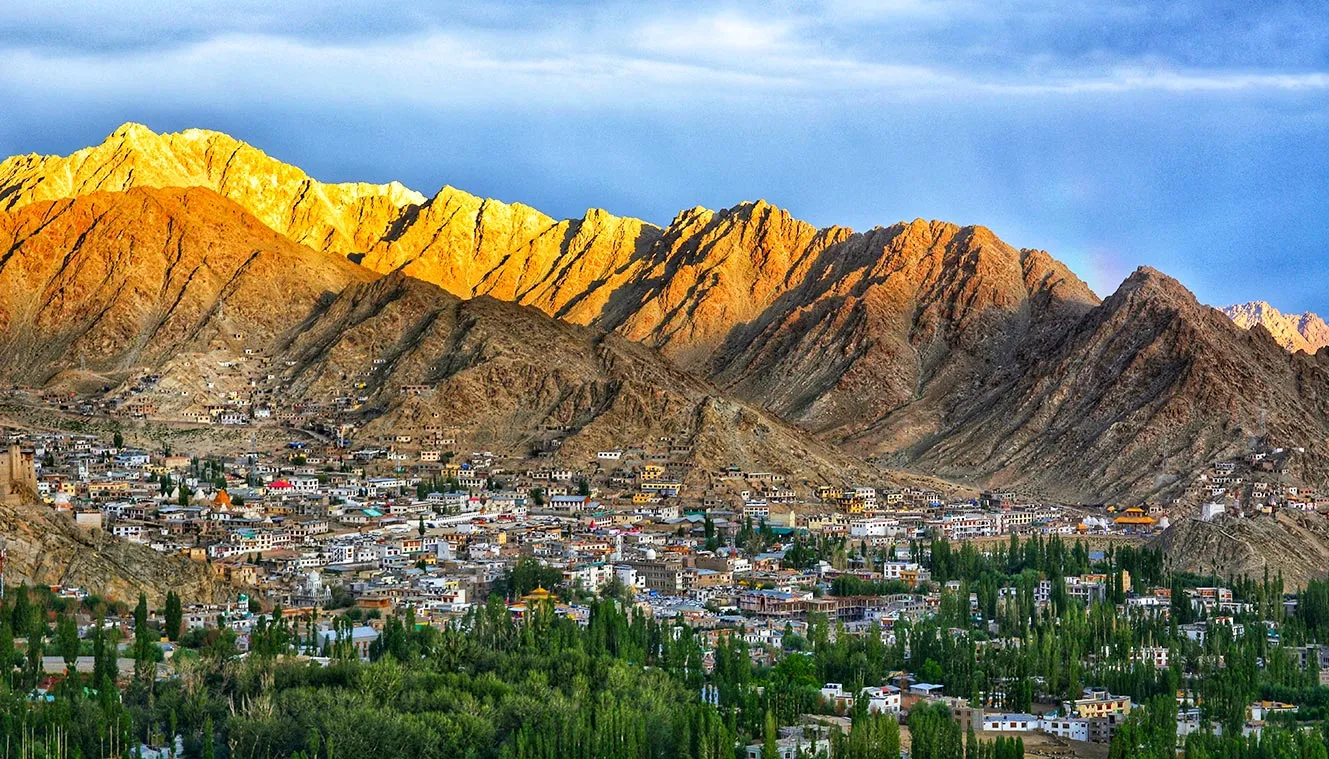
You will be landing at the Leh airport which is one of the most picturesque airports that you would come across. Just before touchdown time, you'll be greeted with the entire range of snow-capped peaks that will surely get you wonderstruck. It's important to keep your warmies handy as you'll feel the sudden drop in temperature as soon as you arrive at the Leh airport. A jacket, woollen gloves and a woollen cap is a necessity. After reaching the guesthouse you will be given enough time to relax and acclimatize to the conditions. Later in the evening, you can spend some time at the Leh market for last minute window shopping. It is very important that you get used to the cold temperature in Leh because the temperature will only tend to fall as you start walking on the frozen Zanskar. From the end of January to mid-February, the temperature can be anything between -10 to -15 degrees during the day. It is also important to keep your body hydrated by increasing the intake of fluids that will help to maintain your body temperature.
Acclimatization Day
- Rest + Acclimatisation day.
- Sightseeing included in the cost (Hall of Fame, Shey Monastery, Thiksey Monastery).
- Visit of any very high altitude place or pass is not advisable.
- Stay in Hotel | centrally heated room |attached wash room in running condition | hot water in buckets.
Keeping in mind the health problems that trekkers are facing (AMS), as per the new regulations applied, anyone doing the Chadar Trek should be atleast spending two days in Leh to get your body fully acclimatize to the weather conditions. It is irrevocable and it is important that it is strictly followed by every trekker. You can spend the day by visiting the places around the city. You can also join us while we conduct a small sight seeing session(included in the cost). It is only for 3-4 hours, covering all the major spots of Leh. It is advisable that you avoid visiting places which are at a higher altitude. Crosscheck your essentials before going to bed.
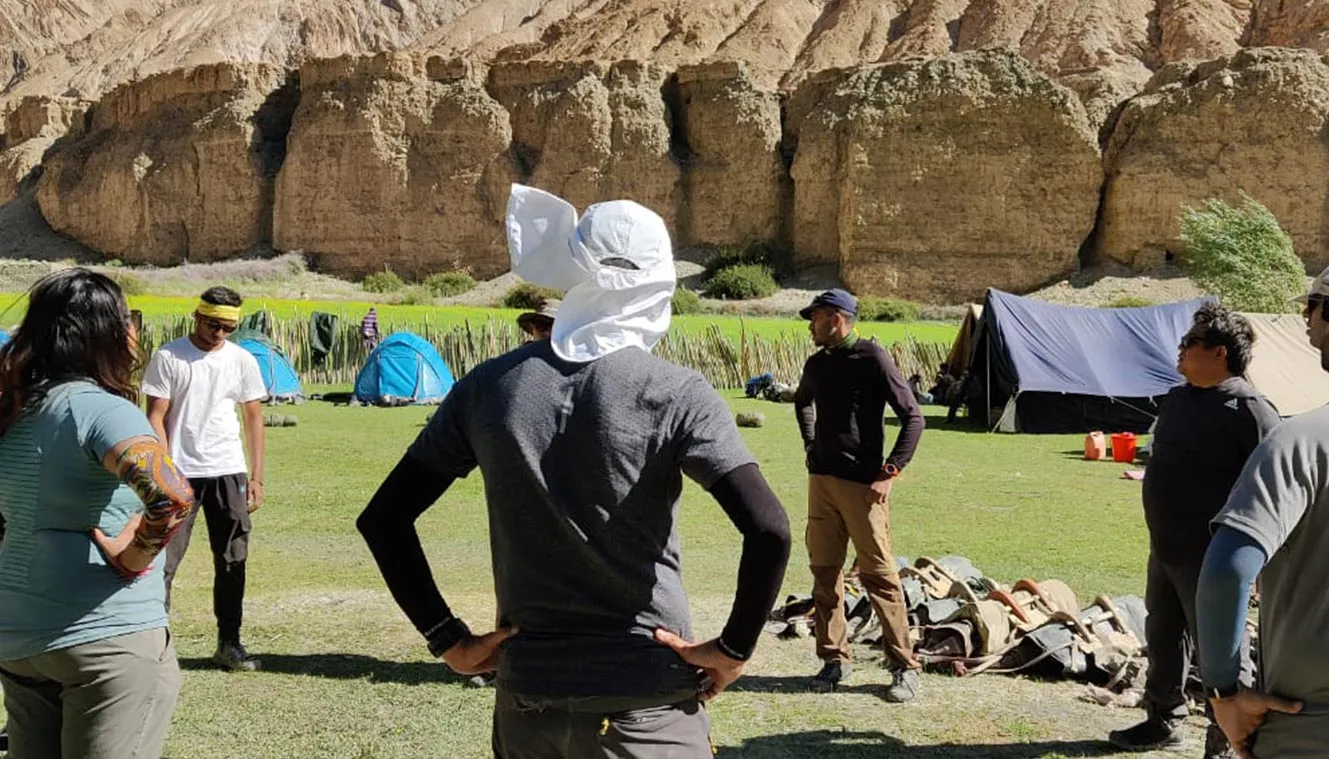
Medical test day
- Wake up early and get ready for medical tests | height & weight, blood pressure and oxygen level.
- Drive/Walk to the Government Medical camp.
- Get your Oxygen and BP reading (There is a long queue due to rush of tourists. It may take 3-4 hours depending on the rush).
- Late afternoon insurance formalities.
- Enjoy evening in Leh.
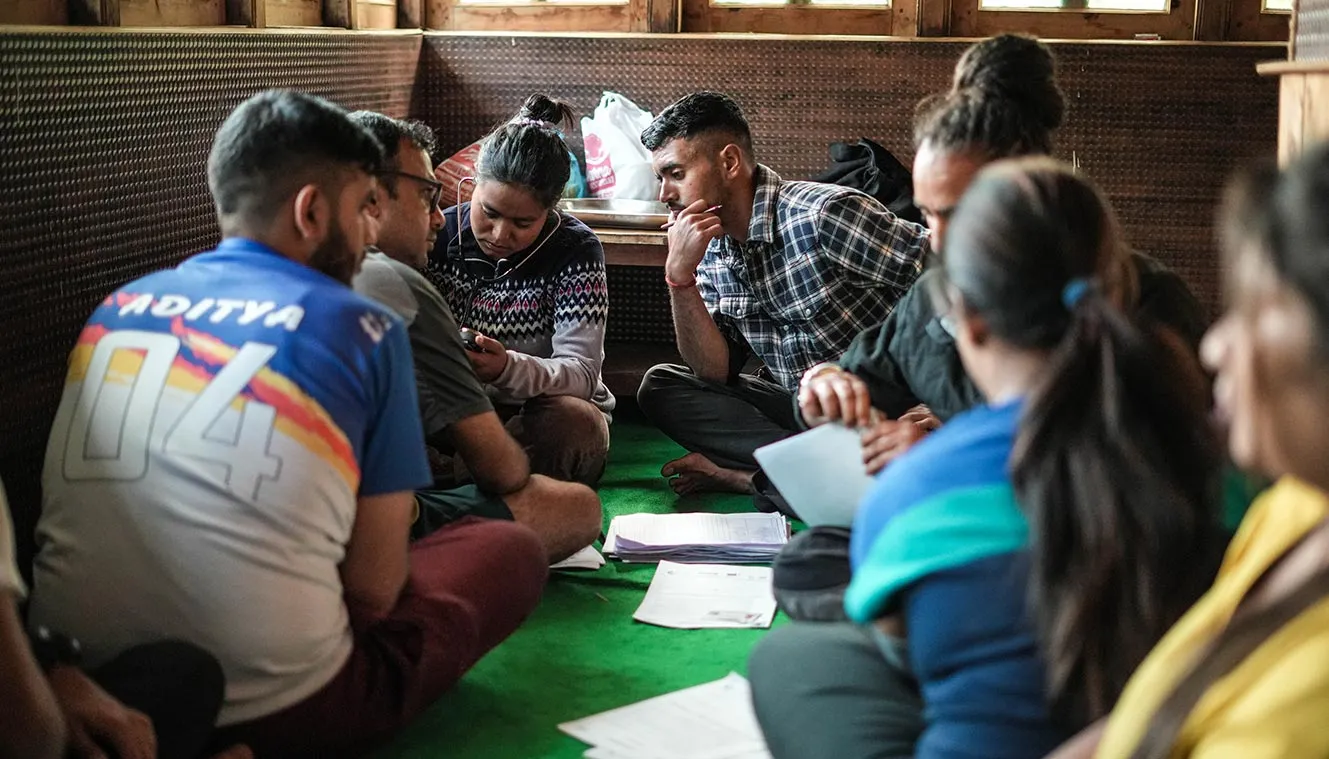
Note: Walking in gumboots will take a while, so be prepared for some slips and falls! It’s advisable to carry a small backpack which will protect your back at the time of falls.
On this day, you'll be headed to the first campsite which is Tsomo Paldar via Chilling & Shingra Koma. Shingra Koma is the most unique place of Chadar for it is placed at U bend of Zanskar. Forming a wonderful place with lots of views. Today will be one of the most scenic drives which lets you witness some of the top spots in Ladakh. Gurudwara Pathar Sahib, Magnetic Hill and the confluence of the Zanskar and Indus are some of the places where you can take a pit stop for clicking pictures. After 3-4 hours drive along the Zanskar will get you to Shingra Koma. The car will drop you right where the road ends, this will be your starting point of walking on the Zanskar.
The layer of Chadar may seem thin here, but you can also see various rock formations. Walking with gumboots on will definitely be a challenge in the initial stage. Understanding the ice patterns will take time, slowly but steadily you will know which surface is fragile and which is trustworthy. There are multiple ice surfaces that you would come across while walking on the mighty Zanskar and as you start walking you will know more about it. Planting your foot will be important in most cases, you can check for the ice for its steadiness with your walking stick before stepping on it wholeheartedly. A small and light backpack will help as you will able to manage your body weight in an effective manner. After an hour and a half of slipping, falling and trying to gather your balance you'll be reaching your first campsite at Tsomo Paldar. This will be your first experience of camping under sub-zero temperatures.
Tsomo Paldar to Tibb Cave
- Altitude: 3,350m/ 10,950 ft.
- Trek 14km | 6-7hr.
- Make sure you fill your thermos with warm water before you leave.
- Pass through a waterfall which never freeze.
- It will be sunny only around 9-10 in the morning.
- Hot Lunch on the way.
- Visit small cave, in that cave the local porters rest for the night.
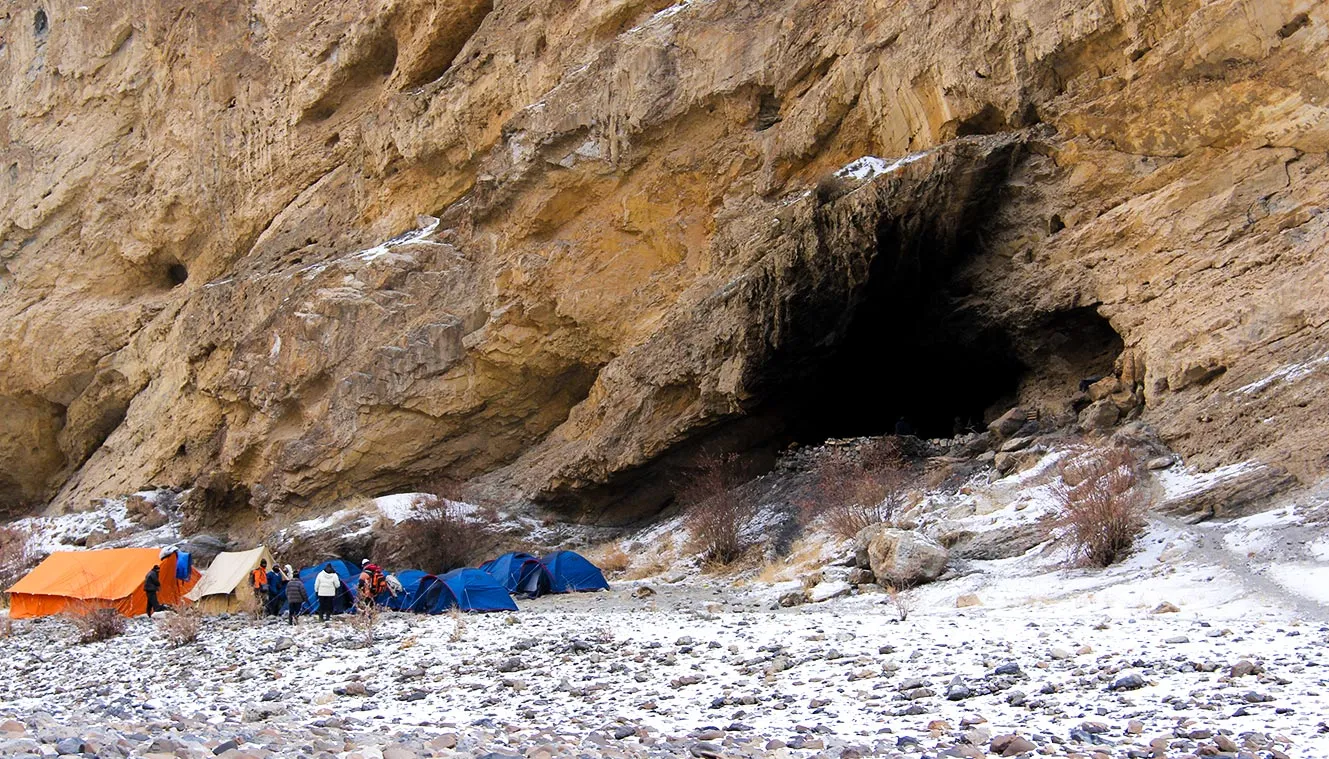
Chadar is one such trek where your not gaining altitude in quick successions. Slowly but gradually from Tsomo Paldar to Tibb Cave (6-7 hours), you will be gaining an altitude of 400ft. (Tsomo Paldar: 11,400 to Tibb Cave: 11,800) After spending a cold night in the tent at Tsomo Paldar get done with you breakfast that will re-energize your senses in the morning. The much needed hot cup of tea will be special in such frosty conditions. As you start heading to the next campsite which is Tibb Cave, this trek route has some of the most eye-catching frozen waterfalls that youll see. Waterfalls that stand frozen in time. The source of some of these frozen waterfalls is still unknown and there are a lot of myths amongst the villagers. The mighty Zanskar will be flowing all along with you on the trail and the emerald green water will have a smooth soothing You will be served lunch midway to Tibb cave. After walking for a couple of hours youll come across different rock patterns along the way which look art looks when the sun rays fall on them making their way from behind the clouds. You will be camping near the Tibb cave which is surrounded by dry sand.
Tibb Cave to Nerak
- Altitude: 3,400m/11,100 ft.
- Trek 13 km / 6-7 hrs.
- Attraction Frozen waterfall.
- Nerak is the first village of Zanskar region.
- If we reach Nerak Camp on time, we can go to Nerak village.
- Stay in tent.
As you move on to the most awaited campsite of the trek which is Nerak, the 13km long trail will take you to the most iconic landmark of the Chadar trek. i.e. The frozen waterfall. The frozen waterfall is a natures masterpiece that attracts trekkers around the world. Hot lunch will be served on your way to Nerak. By far, Nerak will be the coldest of all the campsites on the trek where the temperature goes down to as low as -30 degrees during the night. It will be important that you wear proper clothing in layers to stay safe from the biting cold. If you manage to reach the waterfall on time, there are chances of paying a visit to the Nerak Village as well. You will be camping at a distance of 15-20 minutes from the waterfall.
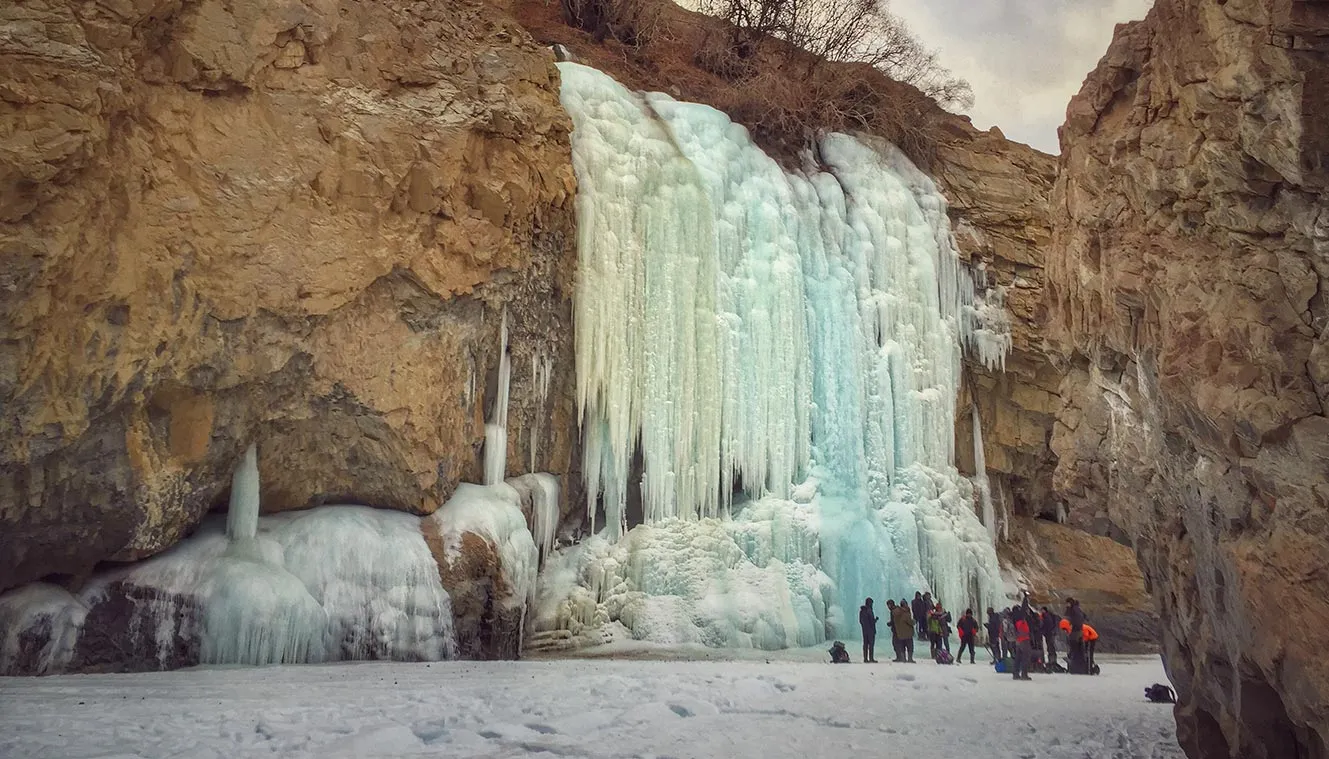
Nerak – Tibb Cave
- Altitude 3,400m/11,100 ft to 3,350m/10,950 ft
- Trek 13 km / 5-6 hrs.
You might have heard stories of how unpredictable the weather patterns can get here on the Chadar trek. There are instances where the formation of Chadar no longer exists on your way back from Nerak. In the same way, you will witness a new layer of Chadar formed at some. Even though its the same route, youll be amazed to see how different it appears while coming back. Chadar Trek is an experience of a lifetime that every trekking enthusiast should witness. And then, what if we told you that these eight days of your life are going to be some of the best days youve lived so far and that youll cherish these moments till the very end.
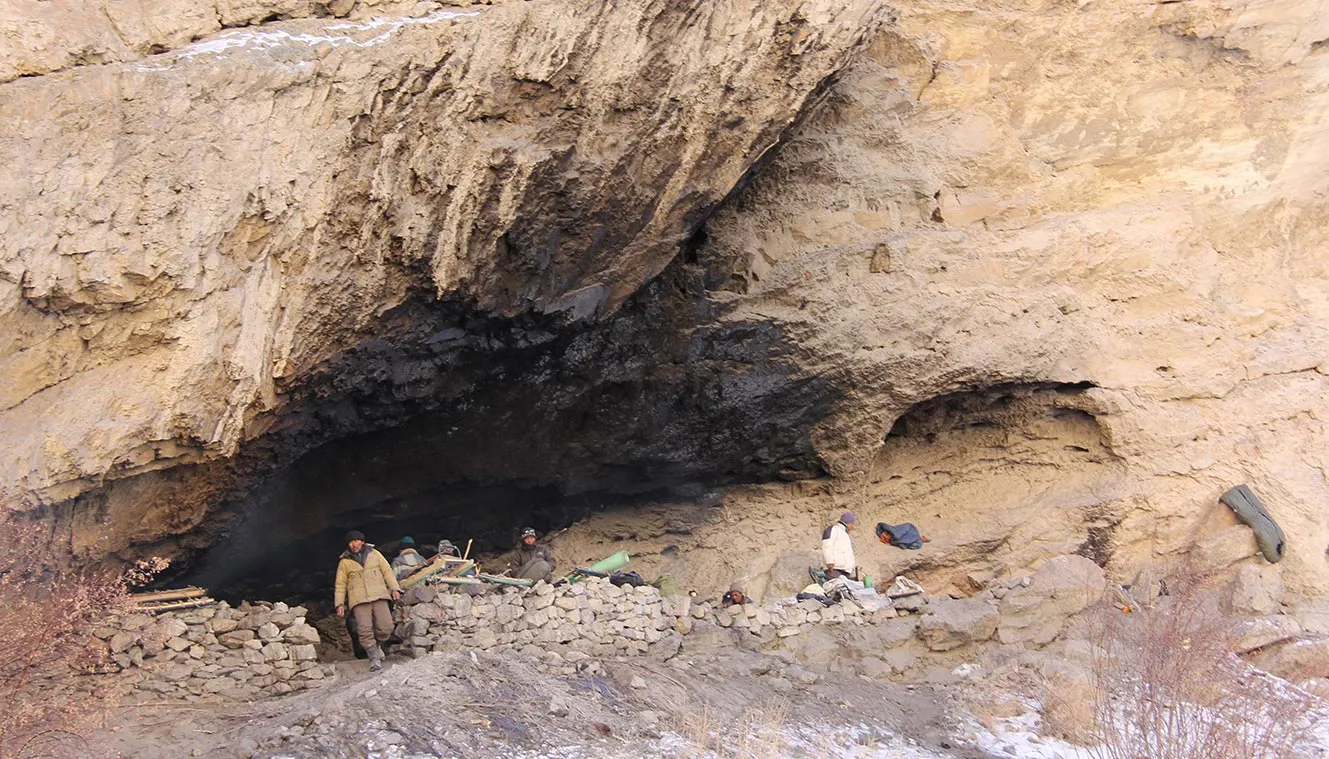
Today retrace your steps back to Tibb Cave. You get another last chance to cherish, relive and gather the memories. Wave goodbye to all the locals while you make your way back. Be careful and enjoy your last stay in tents.
Tibb Cave to Shingra Koma then Drive to Leh
- Altitude 3,350m/10,950ft to 3,150m/10,300 ft.
- Trek to Shingra Koma 17 km/ 5-6 hours.
- Drive to Leh 70 km/ 3-4 hours.
- You will reach Leh by the evening.
- Stay in hotel (Centrally heated room) (Running hot water in taps).
Again wake up early for a long walk back. It is not really retracing steps because you may observe a lot have changed. Chadar may have melted, layer of Chadar may have gotten thin, wonderful rocks are visible now. Wea ll, thats the beauty of nature and Chadar trek. Reach Shingra Koma and get ready to board on vehicles. Another bumpy ride and you will arrive in Leh.
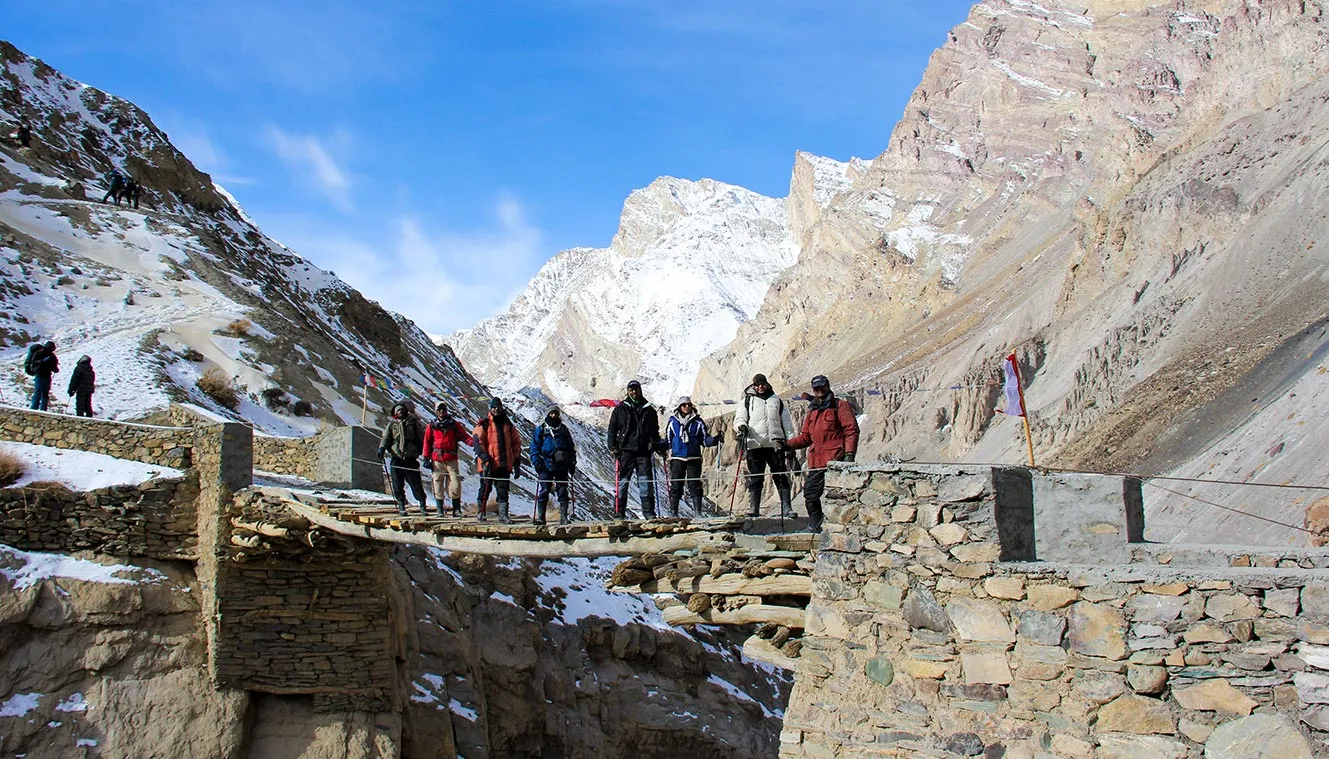
- Keep 1or2 buffer day in your travel plan
- If buffer day is not used in the travel then it can be used to Explore Leh.
- Distance, Altitude, and Trekking hours are approximate and rounded off.
- Keep the original and copy of ID proof handy
- Come one day early if planning to come by plane.
Day-1: Reporting day at Leh
Day-2: acclimatization day, day-3: medical test day.
- Wake up early and get ready for medical tests.
Day-4: Leh to Shingra Koma drive & Trek to Tsomo Paldar
Day-5: tsomo paldar to tibb cave, day-6: tibb cave to nerak, day-7: nerak – tibb cave, day-8: tibb cave to shingra koma then drive to leh.
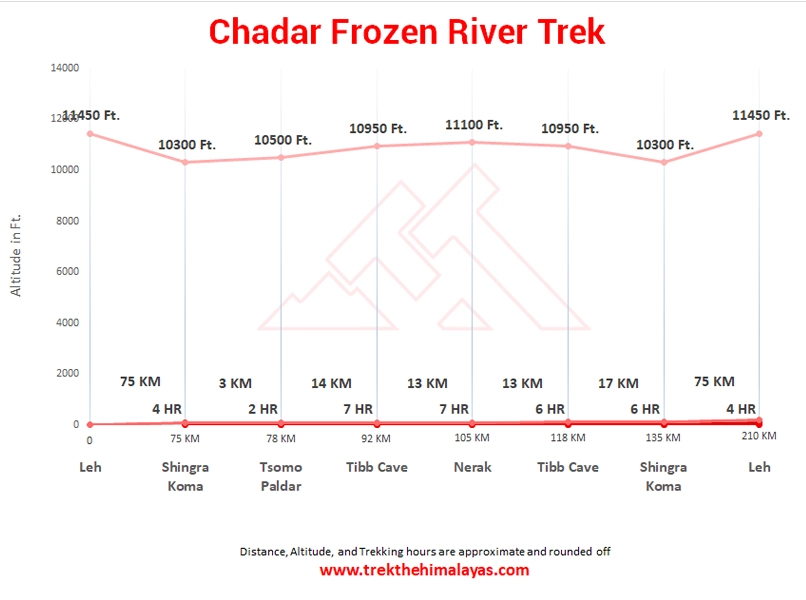
Pulse rate at rest must be in between (60 to 90 beats per minute).
Blood Pressure Reading must be in between (DIASTOLIC 70 – 90, SYSTOLIC 100 - 140 mm Hg).
Respiratory rate at rest must be in between (12 to 20 breaths per minute).
Should not have Liver and kidney issues.
Should not have Diabetes Mellitus, Bronchial Asthma, Heart problems, Hypertension, etc.
No pacemaker implant.
People with Sinus issues, Epilepsy please contact to trek coordinator before booking the trek.
If your BMI is not normal, Please contact our Trek coordinator before Trek booking.
Medical & Disclaimer Form (Mandatory Documents) Click here to download Medical & Disclaimer Form
- Government Employees can avail the benefit of Special Casual Leave (SCL) when they join us for a trekking expedition. As per the rules of the Pay Commission, Special Casual Leave can be availed for up to 30 days in a calendar year for trekking/mountaineering expeditions through a registered organization. Trek The Himalayas is a registered adventure tour operator by the Indian Mountaineering Foundation (IMF) and the Ministry Of Tourism (MOT).
- Trekkers have to apply for leave at least 20 days before the trek departure date.
- This service is exclusive to Indian government employees and is applicable only for treks within India.
- Do mail at info@trekthehimalayas to apply and mention your booked trek date and trek name.
Junior trekkers (below 15 years) should have a company of parents/guardians.
Trekkers between 15 to 18 years can come solo with the disclaimer form signed by parent/guardian.
- Medical & Disclaimer Form (Mandatory Documents) Click here to download Medical & Disclaimer Form
Exercise For Difficult
Fitness Regime For:
Calculate Your Bmi
Your BMI value is
Congratulations, your body is in good conditions!
Medical & Disclaimer Form (Mandatory Documents) Click Here.
How To Reach
It is essential for everyone to arrive at Leh (01:00 pm)
The only way to travel is to fly to Kushok Bakula Rimpochi Airport located in Leh. It is just 4 km away from the main city. The airport is well connected to Delhi and also receives flights from Mumbai, Srinagar, Jammu, Chandigarh and other general destinations in India. Even international travellers can fly directly from major cities like Kolkata, Mumbai and Delhi.
It's quite convenient to secure a cab from outside the airport to reach our hotel. Alternatively, you can inform your coordinator to arrange a cab for you. Upon booking the trek, your trek coordinator will furnish you with the hotel details.
Travelling by both the road routes, the Manali-Leh Highway and Srinagar-Leh Highway, is not possible since they are not open in the snowy winters of Ladakh.
The Manali-Leh and Srinagar-Leh highways are generally closed by October-November
For your return journey from Leh, you have to choose only air transport options. Please ensure an early check-out in the morning, as all flights operate during the morning hours.
.webp)
1. Accommodation (as per the itinerary):
- Guest house (centrally heated room)(attached washroom) in Leh on Day 1, Day 2, Day 3 & Day 8 (twin sharing basis, triple in very rare cases)..
- Camping during the trek (Day 2 to Day 6).
2. Meals (Veg + Egg):
- All meals while on trek. .
- Day 4 breakfast to day 8 lunch.
3. Support:
- 1 Versatile base camp manager: handles communication and deploys extra manpower in emergencies.
- 1 Mountaineering & First aid qualified professional expedition Leader.
- 1 Experienced high altitude chef.
- Local experienced guides (Number of guides depending on the group size).
- Enough support staff.
4. Trek equipment:
- Sleeping bag, Sleeping liners (if required), Mattress, Utensils.
- 3 men all season trekker tent (twin sharing), Kitchen & Dining tent, Toilet tent.
- Camping stool, Walkie talkie.
- Ropes, Helmet, Ice axe, Harness, Gaiters & Crampon (if required).
5. First aid:
- Medical kit, Stretcher, Oxygen cylinder, Blood pressure monitor, Oximeter, Stethoscope.
6. Transportation (as per the itinerary):
- Leh (Guest house) to trekking point (Day 4).
- Trekking point to Leh (guest house) (Day 8).
7. Clock room service at Leh. 8. Mules/porters to carry the central luggage. 9. All necessary permits and entry fees, Upto the amount charged for Indian. 10. Services from Leh to Leh.
1. Food in Leh. 2. Insurance (Mandatory). 3. Any kind of personal expenses. 4. Pickup and drop from Leh airport. 5. Mule or porter to carry personal luggage. 6. Emergency evacuation, hospitalization charge or etc. 7. Anything not specifically mentioned under the head Inclusion. 8. Any additional cost due to the final decision incurred by the Administrative. 9. Pre Medical Check-up and Rescue fee, Wildlife/environmental charges, ALTOA NOC, and entry fees upto 6K to 8 K paid to the authority on the spot.
Things can be provided on demand and availability (participant has to pay extra for these things).
1- Gamow/PAC HAPO Bag (Portable Hyperbaric Bag) - is a unique, portable hyperbaric chamber for the treatment of acute mountain sickness (AMS), also known as altitude sickness.
2- AEDs (Automated External Defibrillators) - are portable life-saving devices designed to treat people experiencing sudden cardiac arrest, a medical condition in which the heart stops beating suddenly and unexpectedly.
Cancellation terms:
Cancellations prior to 25 days from the start of the Trip
Refund options
- 5% deduction of trek fee
- 100% cash voucher for any trip till one year
- Transfer your trek (any trek, any date) to your friend
Cancellation between 24 days and 15 days to the start of the Trip
- 30% deduction of trek fee
- 100% cash voucher for same trip till one year
- 85% cash voucher for any trip till one year
- Transfer your trek (same trek, any date) to your friend
Cancellation between 14 days and 10 days to the start of the Trip
- 50% deduction of trek fee
- 80% cash voucher for same trip till one year
- 70% cash voucher for any trip till one year
- Book the same trek, in the same season, with any other batch
Cancellation less than 9 days to the start of the trek
- No cash refund
- 20% cash voucher for the same trip till one year
- 10% cash voucher for any trip till one year
- Transfer your trek (same trek, same date) to your friend
Note- If a booking is made using a voucher or discount code, the policies related to vouchers and discounts cannot be modified.
In the unlikely event that TTH cancels a trek prior to the scheduled departure date:
While it is extremely rare for TTH to cancel a trek, we understand that unforeseen circumstances or natural disasters may occasionally require us to do so before the scheduled departure. These circumstances could include continuous rain or snow, thunderstorms, snowstorms, landslides, floods, earthquakes, or any other natural calamity that poses a risk to the safety of our trekkers. Additionally, unforeseeable events such as local riots, curfews, pandemics, lockdowns, government orders, or any similar situations that compromise the safety of the trekking experience may also necessitate a cancellation.
In the event of such a cancellation, TTH will provide you with a voucher equivalent to the amount you paid for the trek. This voucher can be redeemed for any of our treks within the next year, allowing you to still enjoy an adventure with us at a later date.
The issuance of a voucher is not applicable in situations where you are required to descend from the trek for any reason. The trek leader may make the decision to send you down from the trek due to factors such as insufficient fitness level, symptoms of Acute Mountain Sickness (AMS), high blood pressure, exceeding the designated turn-around-time, health concerns, or if you are found smoking, drinking, or violating the rules set for the trek. In such cases, the provision of a voucher does not apply.
In the rare event that TTH shifts a trek:
We would like to emphasize that weather conditions in high-altitude areas are highly unpredictable and can undergo sudden changes at any time, irrespective of the day. Additionally, circumstances beyond our control, such as natural disasters, political unrest, pandemics, and lockdowns, may impact the feasibility of conducting a trek. In cases where we are unable to proceed with an event due to such circumstances that are beyond our direct control, we will make every effort to provide you with an alternative trek that is safer and more suitable.
In such situations, we will issue a voucher to offset the cost difference between the originally scheduled trek and the alternative trek. This voucher can be redeemed at any time within one year from the date of issue. Please note that a refund fee or reimbursement of the cost difference is not applicable in these cases.
- Change of trek batch is dependent on the availability of seats in the batch
- In case of transferring a trek to a friend, he/she should satisfy all the mandatory requirements put forward by TTH
- TTH holds the right to change/cancel the policies, without prior notice
- Cash refund is applicable only in case of bookings made without using any promotional offer code or vouchers
Cash Voucher Terms:
- This is a non-transferable voucher
- The voucher cannot be merged with any other offer of Trek The Himalayas
- The voucher is valid for Trek booked directly with Trek The Himalayas in India
- To avail the voucher please use your register phone number or e-mail id
- All the other Terms of booking a trek with Trek The Himalayas are applicable to the voucher
- Trek The Himalayas holds rights to add/remove any of the Terms and Conditions without prior notice
Itineraries are based on information available at the time of planning and are subject to change. "Trek The Himalayas" reserves the right to change expedition dates, people or itineraries as conditions warrant. If a trip must be delayed or the itinerary changed due to bad weather, road conditions, transportation delays, government intervention, airline schedules, sickness, or other contingency for which TTH or its agents cannot make provision, the cost of delays and/or other changes are the responsibility of the participant. TTH reserves the right to decline, or accept, any individual as a trip member for any reason whatsoever.
Trek Essentials
PDF Of Trek Essential Download
Frequently Asked Questions(FAQ)
How to register/create an account with tth.
To register with TTH, visit our website - www.trekthehimalayas.com and create your account. To create your account you will need to use your email address and fill in all the details, set your unique password and your account is ready to use.
How to book a trek?
- To book a trek with TTH, you first need to register with us and create an account.
- Choose the trek that you want to do and click on available dates.
- You will land at the login page, fill in the required details.
- Add Participants, choose add-on services click on the Pay now button, choose your preferred payment method, and make the payment. TTH accepts multiple payment options, including credit/debit cards, net banking, and UPI.
- You will receive a confirmation email from TTH with all the necessary details about the trek, including the meeting point, transportation, accommodation, and other important instructions.
Made a payment but did not receive any confirmation.
please send an email to us at [email protected] or reach out to the numbers provided in the Help and Support section of your Trek Page. We will ensure that your issue is promptly resolved.
How to book off-load luggage and transportation?
To book services such as off-load luggage and transportation, you can find them listed as add-ons. These additional services can be booked at the time of your initial booking. If you miss booking add-ons during the initial reservation, you can log in anytime and easily book 4 days before the departure date add-ons through the platform.
If I have booked the wrong trek or date, how can I make changes?
In such a situation, please log in to your account and transfer your trek or date to the desired one within 12 hours or drop us an email at [email protected] 10 days before the departure date of the trek. After the initial 12-hour period, any changes will be processed according to the cancellation policy.
I am a beginner and confused which trek to book.
We recommend visiting our "Suggest Me a Trek" page. By filling out the form, our experts will contact you with the best possible trek options based on your preferences and experience level. Alternatively, you can reach out to us via email at [email protected] or give us a call using the numbers provided on our website for personalized assistance and recommendations.
How is family trek different from regular trek?
Family treks differ from regular treks by focusing on ease of difficulty, offering shorter durations for younger participants, Kid-friendly and easily digestible foods, child-friendly activities, maintaining a higher guide ratio for diverse age groups, and implementing additional safety measures for families.
Ideal treks for children.
Family Trek with Kids recommendation Only Dayara Bugyal and Chopta Chandrashila Trek.
Minimum age for children to trek with TTH.
Minimum age for TTH treks is typically 7 years, though this may vary depending on the specific trek.
Can we take children to high altitudes with their guardian?
Yes, you can take a kids to a high-altitude trek with a parent. Discuss with a trek expert before booking a trek.
Can we send kids without Parents/guardian?
Medical & Disclaimer Form (Mandatory Documents) Click here to download medical and disclaimer form
How to prepare a child for a high altitude trek?
Physical Fitness: Ensure your child is physically fit. Engage them in regular exercise, outdoor activities, and hikes to build stamina and endurance. Hydration: Emphasize the importance of staying hydrated at high altitudes. Encourage your child to drink water regularly, even if they don't feel thirsty. Proper Nutrition: Provide a well-balanced diet with sufficient carbohydrates for energy and foods rich in iron to prevent altitude sickness. Adequate Sleep: Ensure your child gets enough sleep in the days leading up to the trek. Quality rest is crucial for altitude adaptation. Educate on Altitude Sickness: Teach your child about the symptoms of altitude sickness, such as headache, nausea, and dizziness. Encourage them to communicate any discomfort immediately. Appropriate Clothing and Gear: Dress your child in layers to adjust to changing temperatures. Ensure they have appropriate trekking gear, including sturdy footwear. Positive Mindset: Foster a positive mindset. Encourage your child, and let them know it's okay to take breaks when needed. Medical Check-Up: Schedule a medical check-up before the trek to ensure your child is fit for high-altitude activities. Consult with a healthcare professional about any potential health concerns.
Kind of food will be served during the trek for children.
TTH takes special care to provide wholesome and nutritious food for children on treks. Here are some of the foods that are typically served for children: Breakfast: For breakfast, TTH serves a variety of options like porridge, cornflakes, bread, butter, jam, honey, boiled eggs, omelettes, and pancakes. Children can choose from these options to fuel themselves for the day's trek. Lunch: For lunch, TTH serves lunch which includes rotis, vegetables, rice, dal, and salad. The rotis are usually made fresh on the trek and are a good source of carbohydrates. The dal and vegetables provide protein and other essential nutrients. Snacks: TTH provides healthy snacks like fresh fruits, dry fruits, energy bars, cookies, and biscuits to keep the children energized throughout the day. Dinner: For dinner, TTH serves a hot and wholesome meal which includes soup, rice, dal, vegetables, and a non-vegetarian dish (if requested in advance). Children can also choose from a variety of desserts like custard, jelly, and fruit salad. Dietary requirements: If a child has any special dietary requirements, TTH can cater to those needs as well. For example, if a child is lactose intolerant or allergic to nuts, the kitchen staff can make arrangements to accommodate those requirements.
How to choose the right trek?
Choosing the right trek for a beginner can be a bit overwhelming as there are many factors to consider such as distance, elevation gain, terrain difficulty, weather, and time of year. Here are some tips that can help you choose the right trek for a beginner:
1. Determine fitness level: Assess the fitness level of the beginner to understand their physical capabilities. This will help you select a trek that is challenging but not too difficult.
2. Choose a well-traveled trail: A well-traveled trail will have more amenities such as signposts, water stations, and shelter. It is also safer as there will be other hikers on the trail.
3. Consider the length of the trek: For beginners, it is recommended to start with a shorter trek that can be completed in a day or two. This will help them get acclimatized to trekking and build their confidence.
4. Look for gradual elevation gain: Choose a trek with a gradual elevation gain rather than steep ascents. This will make the trek easier and more enjoyable.
5. Check the weather: Check the weather forecast before selecting a trek. Avoid treks during the monsoon season or winter when the trails can be slippery or dangerous.
6. Research the trail: Read about the trail to get an idea of the terrain, altitude, and difficulty level. This will help you select a trek that is suitable for the beginner.
7. Consult with an expert: If you are unsure about which trek to choose, consult our trek expert Mr. Nitin (+91 70600 59773) between 10 AM to 6 PM (Tuesday - Friday). Mr. Nitin will provide you valuable advice and guidance.
Overall, it is important to choose a trek that is enjoyable, challenging but not too difficult, and suitable for the beginner's fitness level and experience.
Can a beginner choose a tough trek?
It is not recommended for a beginner to choose a difficult Himalayan trek. Trekking in the Himalayas can be physically and mentally challenging, especially if you are not used to the high altitude, steep slopes, and rugged terrain. Choosing a difficult trek without the proper experience, fitness level, and preparation can be dangerous and put you at risk of altitude sickness, injury, and other hazards.
If you are a beginner, it is recommended to start with an easier trek and gradually build up your skills and experience. This will help you understand the challenges of trekking in the Himalayas, and also prepare you physically and mentally for a more difficult trek in the future. It is also important to choose a trek that matches your fitness level, experience, and interest.
What is the age limit for a beginner trekker?
There is no specific age limit for a beginner trekker. However, it is important to consider your physical fitness, health condition, and personal interests before embarking on a trek. Trekking in the Himalayas can be physically and mentally demanding, and requires a certain level of physical fitness and endurance.
If you have any pre-existing medical conditions or are above a certain age, it is recommended to consult with a doctor before embarking on a trek. It is also important to listen to your body and take breaks as needed during the trek to prevent exhaustion or injury.
If I am solo, can I join the trek in a group?
Yes, you can join the trek. We have fixed departure groups where you can simply book your trek and we will take care of curating a group.
How does my family get updated about my Trek?
Before you start the trek, it is recommended that you make all the necessary phone calls as during the trek you may or may not receive network coverage, once you come back to the Base Camp, you can reconnect with your family via phone once again. You can share your trek coordinator contact detail with your family members to get the latest updates about your trek batch.
What food can I expect?
At TTH, we provide wholesome and nutritious meals during the trek. The food is vegetarian and includes a variety of dishes such as rice, dal, vegetables, chapati, paratha, pasta, noodles, and soup. We also offer snacks such as biscuits, and salty, and dry fruits during the trek. Special dietary requirements such as vegan, gluten-free, or Jain food can also be arranged if informed in advance.
I am allergic to some foods.
If you are allergic to some foods, you need to let us know in advance so that we can make arrangements accordingly.
How safe is trekking with TTH?
TTH is a trekking company that prioritizes the safety of all its participants, including women trekkers. They have a comprehensive safety system in place, which includes a dedicated team of experienced and trained trek leaders and support staff who are equipped to handle emergency situations and provide first aid.
TTH also takes specific measures to ensure the safety and comfort of women trekkers. They have a separate tent accommodation for women trekkers, female trek leaders, and support staff. They also provide separate toilet facilities for women and encourage a safe and respectful environment for all trekkers.
Moreover, TTH has a strict policy against any kind of harassment and has a zero-tolerance policy towards such incidents. They have a designated Internal Complaints Committee (ICC) to investigate and address any complaints related to harassment or misconduct. Overall, TTH has a good reputation for safety and responsible trekking practices, and women can feel comfortable and safe while trekking with them.
How TTH will manage if I am the only woman in the group?
In case you are the only women in the group, we provide a single sleeping arrangement. Also, during the trek, the trek leader will always remain by your side to provide optimum safety and reassurance.
How can I know that other women are in the batch?
You can reach out to the trek coordinator to inquire about the number of female trekkers and their respective states who have booked the trek. Please note that the trek coordinator cannot disclose personal details of any trekker. Once you've confirmed your booking, a WhatsApp Group will be created for all the trekkers in your batch. This allows you to connect with fellow trekkers before the trek begins.
Can I know in advance, which trek is led by a women Trek Leader?
While many of our treks are led by female trek leaders, however, it is not possible to know which trek leader is assigned to which group. But nonetheless, whether the trek leader is male or female you can be completely assured of your safety and security with us.
Can I trek with periods? If yes, then where can I dispose of the sanitary pad?
Yes, it is possible to trek with periods. However, it is important to take some extra precautions and preparations to ensure a comfortable and safe trekking experience.
Here are some tips that can help you trek during your period:
1. Use menstrual hygiene products that you are comfortable with, such as tampons, pads, or menstrual cups. It is recommended to carry enough supplies for the entire duration of the trek.
2. Pack wet wipes, hand sanitizer, and plastic bags to dispose of used hygiene products.
3. Wear comfortable and breathable clothing that allows for easy movement and reduces friction. Avoid wearing tight or restrictive clothing that can cause discomfort.
4. Carry pain relief medication, such as ibuprofen or acetaminophen, in case of menstrual cramps.
5. Stay hydrated and maintain a balanced diet to support your energy levels and overall health.
6. Take breaks as needed and listen to your body. If you feel uncomfortable or experience any unusual symptoms, seek medical attention immediately.
It is also recommended to consult with a doctor before going on a trek during your period, especially if you have a pre-existing medical condition or are taking medication. By taking necessary precautions and being prepared, you can have a safe and comfortable trekking experience even during your period.
We provide proper disposal facilities for sanitary pad disposal during the trek.
How will the accommodation be during the trek?
We offer three person tents with twin-sharing for optimum comfort. A woman trekker will share a tent with another woman trekker and if you are the only woman in the group, you will be given a single accommodation for your comfort and privacy.
Are trek poles, Jackets and other equipment available for rent from Trek The Himalayas?
Yes, we do provide gears on rent. You can book it using you TTH account directly.
Who will be with us on the trek from Trek The Himalayas?
Mountaineering qualified Experienced and first aid certified Trek Leader, First Aid Certify local guide, Cook, helpers and supporting staff.
Who can not join the trek?
People suffering from Bronchitis, Asthma, High blood pressure, Epilepsy (got faints), TB , Heart problem or on higher BMI side are strictly not allowed to go on any Himalayan trek. Apart from this if you had any medical history, please let us know.
When it gets really cold can I consume alcohol?
No. Alcohol and smocking isn’t allowed while on trek. It is totally misconception that it will keep you warm. Your body need to acclimatize properly and for that eat properly and drink enough water; these things will keep you warm.
What type of toilet facility is TTH providing at the trek?
Toilet tents provide a convenient solution for answering nature's call in the great outdoors. Dry toilets, in particular, offer a highly sanitary approach. By digging a pit and utilizing mud and a shovel, you can easily cover up your waste. This method ensures cleanliness and hygiene while camping or exploring in the forest.
Remember to pack essential toiletries to complete your outdoor bathroom kit and maintain proper personal hygiene during your adventures. With these practices in place, you can enjoy nature while also respecting it.
How do I manage the negative temperatures on the trek at higher camps? Do I need special jackets?
Layer Up From Head To Toe Eat Full Meals, never sleep empty stomach You can keep warmee (if you’re more susceptible to cold). Use sleeping bag in right way and don’t leave free space in sleeping bag.
For upper body – Thermal layer – T-shirt (full-sleeves) – Fleece T-shirt (for extreme colds) – Fleece layer – Thick Jacket/Down Jacket – Waterproof or Windproof layer (outermost layer, when it is snowing or raining) - For Lower Body – Thermal layer – Hiking pants (normal) or Winter hiking pants
Based on how warm you feel you can skip any of the above layers. Your outer later should be windproof since it is windy at high altitude. The idea behind layering is that the more insulation you have the less cold you feel, and instead of wearing a very thick jacket if you wear multiple layers, your body will be better insulated against the cold.
Do you provide crampon/micro spikes and gaiters?
Yes, we provide micro spikes and gaiters, if required.
What documents need to carry on trek?
Mandatory documents: 2 xerox of ID having address (addhar card/driving license), 2 Passport size photographs, hard copy Medical form signed & sealed by doctor, disclaimer form sign by trekker and high altitude insurance.
If we come prior the trek date, Do you provide accommodation?
No. We don’t but we can suggest you good hotel/Stay nearby pick up location.
Do we get enough water for drinking?
Yes, trekker must carry 2 water bottles 1 litre each so they can refill it at campsite for drinking and keep themselves hydrate.
What kind of shoes we should buy for the trek?
You should buy shoes which has these three features –Good grip, Ankle Support and additional water resistant layers. Generally, we advise Quechua Trek 100, MH 500 and MH 100.
What happens if some members of the team need to turn back before the summit?
No one is forced to go on. There is always enough staff to split the party according to need and regroup later at the camp. Most people have no trouble reaching the highest campsite. If some members decide not to climb the final distance they can wait for the climbers to come back down the same way or take a lateral path to the descent route.
What is Chadar Trek Frozen River?
The Chadar Frozen River Trek is a popular winter trek in the Indian state of Jammu and Kashmir. It involves walking on a frozen river, the Zanskar River, which is transformed into a thick sheet of ice during the winter months. The trek is known for its scenic beauty and challenging terrain, as well as the unique experience of walking on a frozen river.
When is the best time to do the Chadar Trek?
The best time to do Chadar Frozen River Trek is during the months of January and February when the river is frozen enough to support the weight of trekkers.
What is the difficulty level of Chadar Trek Frozen River?
Chadar Trek Frozen River is a Difficult Grade Trek.
What is the duration of the Chadar Trek Frozen River?
It is an 8 days long trek.
Are there any altitude-related concerns on the Chadar Trek?
Yes, altitude-related concerns can be a factor on the Chadar Frozen River Trek . The trek starts at an altitude of around 3,300 meters and reaches a maximum altitude of approximately 3,850 meters . While this may not be extremely high, it is still significant enough to cause altitude-related issues for some trekkers.
Altitude sickness, also known as acute mountain sickness (AMS), is a common concern on the Chadar Trek . Symptoms of AMS can include headache, nausea, dizziness, and shortness of breath. Trekkers can take several precautions to avoid AMS, such as acclimatizing properly, drinking plenty of fluids, and taking necessary medications.
It is also essential to be aware of frostbite and hypothermia, which can occur due to exposure to cold temperatures and wind on the trek. Trekkers should dress in layers, wear proper gear, and stay warm to prevent these conditions.
Overall, while altitude-related concerns are something to keep in mind, with proper preparation and caution, many trekkers are able to successfully complete the Chadar Frozen River Trek without any significant issues..
What kind of gear is needed for the Chadar Trek?
The Chadar Frozen River Trek is a challenging winter trek that requires specialized gear to ensure the safety and comfort of trekkers in extreme cold and icy conditions. Here are some essential gear items needed for the trek:
1. quality trekking boots with sturdy soles and good traction to provide adequate grip on slippery ice.
2. Warm and waterproof clothing, including thermal layers, fleece jackets, and down jackets, to keep you warm in sub-zero temperatures.
3. Waterproof gloves or mittens and socks to keep your hands and feet dry and warm.
4. A warm hat and a balaclava or a face mask to protect your face from the cold winds.
5. Sunglasses to protect your eyes from the glare of snow and ice.
6. Trekking poles to help maintain balance and stability on the icy terrain.
7. Sleeping bags are rated for sub-zero temperatures to ensure a good night's sleep in the extreme cold.
8. Headlamp or flashlight with extra batteries to navigate in the dark.
9. First aid kit including altitude sickness medication, pain relievers, and basic medical supplies.
10. Backpack with at least 60 liters capacity to carry all your gear and supplies.
What kind of food will be provided during the Chadar Trek?
During the Chadar Trek , TTH provides all meals, including breakfast, lunch, and dinner. The meals are prepared by a team of experienced cooks, who use fresh and locally sourced ingredients to provide nutritious and tasty food to the trekkers.
Is it necessary to have the prior trekking experience to do Chadar Trek Frozen River?
While prior trekking experience is not strictly necessary for the Chadar Frozen River Trek , it is highly recommended that trekkers have some level of physical fitness and experience with hiking or trekking in challenging terrain. The trek is considered to be a moderately difficult trek, and the icy conditions can make it even more challenging.
It is important to note that the Chadar Trek requires trekkers to walk on a frozen river, which can be slippery and unstable. Trekkers must also navigate through narrow gorges, steep canyons, and frozen waterfalls, which can be physically demanding. Therefore, it is recommended that trekkers engage in regular physical exercise and prepare themselves mentally and physically for the trek.
Additionally, trekkers need to be prepared to face extremely cold temperatures, which can drop to as low as -25 degrees Celsius at night. Therefore, it is essential to have appropriate gear and clothing to keep warm and protect against frostbite and hypothermia.
What kind of physical fitness is required for Chadar Trek Frozen River?
It is recommended that trekkers engage in regular physical exercise and prepare themselves mentally and physically for the trek.
Here are some specific physical fitness requirements for the Chadar Frozen River Trek:
1. Cardiovascular endurance: Trekkers need to have good cardiovascular endurance to tackle challenging terrain and high altitude. Regular cardio exercises such as running, cycling, or swimming can help improve endurance.
2. Strength training: Trekkers need to have strong leg and core muscles to maintain balance and stability on the icy terrain. Strength training exercises such as squats, lunges, and planks can help build these muscles.
3. Flexibility: Trekkers need to have good flexibility to prevent muscle strain and injuries. Regular stretching exercises such as yoga or Pilates can help improve flexibility.
4. Mental toughness: The Chadar Trek can be mentally challenging due to the extremely cold temperatures, long hours of walking, and unpredictable weather conditions. Trekkers need to be mentally prepared to face these challenges and stay motivated.
It is important to note that the physical fitness requirements for the Chadar Trek can vary depending on the individual's age, health, and fitness level. It is recommended that trekkers consult with a doctor or a fitness trainer before embarking on the trek to assess their physical fitness and determine any necessary precautions or preparations.
Is it necessary to hire a guide for the Chadar Trek?
It is highly recommended. The Chadar Trek is a challenging trek that requires specialized gear, experienced guides, and support staff to ensure the safety and well-being of trekkers. Hiring an expert trekking organization can provide many benefits, including safety, specialized gear and equipment, and logistics and support.
- Date and Price
Rent A Gear
Trek Articles
Quick Links
Trekking & Hiking
Mountaineering
Multi Sports
Himalayan Pilgrimage
Website Privacy
Terms & Condition
Contact Info
Get in touch with us. E-mail us Monday-Saturday (10 AM to 6 PM)
Address: Trek The Himalayas, Kaintura Plaza, Badrinath Road Tapovan, Rishikesh - 249201 Uttarakhand
Phone: 8191004846
Email: [email protected]
2010 Trek The Himalayas. All rights reserved

- Best Hikes In The World
- Appalachian Trail
- European Hikes
- Nepal Hikes
- Patagonia Hikes
- See All Hikes
- Mount Kenya
- Mount Kilimanjaro
- Mount Toubkal
- See All Mountains
- South Africa
- New Zealand
- Switzerland
- United Kingdom
- Packing Lists
Chadar Trek – One Of The Most Wild And Beautiful Hikes On The Planet
Asia , India
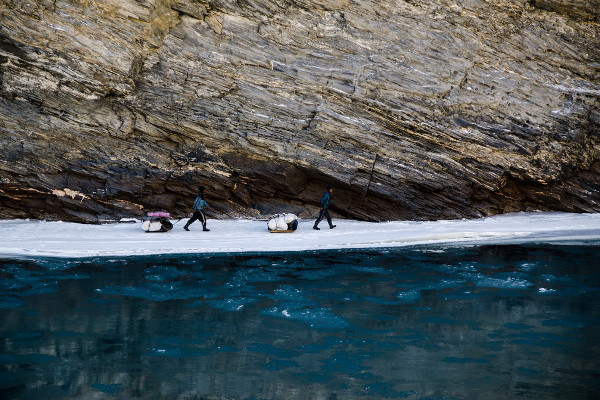
The Chadar Trek, or Zanskar Gorge, is widely known as one of the most difficult treks in the world . If you're an avid trekker, then chances are this wild and challenging trek is on your bucket list.
Chadar Trek Overview
The Chadar Trek is one of the most wild and beautiful hikes on the planet . Frequently covered by the world's top adventure channels and media outlets, the Chadar Trek takes hikers through a frozen river valley into the very heartland of India’s Ladakh region.
The region’s harsh desert environment and towering mountains make the Chadar trek one of the most popular treks in the Ladakh area . Very few treks are as remote as the Chadar and even fewer are conducted in high winter. The trek is not for the lighthearted as temperatures are often lower than -10 degrees celsius in the day and -20 at night.
Cut off entirely from the outside world, the Zanskar river is the only outlet for locals wishing to venture further into the Ladakh region. The trail has been used for nearly a thousand years by the Buddhist monks living in the region. You’ll trek the same route, walking over the frozen river as you cut a path towards Naerak. You will need to have a good level of stamina and fitness to have a really good time.
Accommodation is riverside camping.
Please Note: The Chadar trek is ideally suited to seasoned trekkers looking to experience one of the most remote places on earth.
Regional Map
The Chadar Trek is located in the Zanskar region of Ladakh which is part of the Indian state of Jammu and Kashmir .
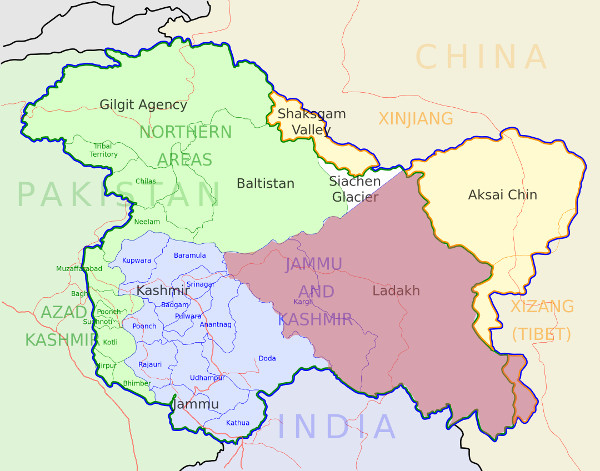
Chadar Hike Itinerary
Below is a detailed Chadar Trek itinerary. Please note that this is a typical itinerary that we would expect many operators to adhere to. However, some tour operators offer variations on this route.
Day 1-2: Arrival in Leh (3500 m)
After taking a flight from Delhi, you will arrive in Leh – the highest airport on earth! Take in the cool mountain air as you explore town before bedding down in your hotel for the night.
Day 3: Drive to Chilling – Hike to Tilad Do (3100 m)
After breakfast, your operator will take you by car to your starting point at Chilling roughly 3 hours away. Along the way, you will no doubt visit the important Buddhist temple of Shanti Stupa. Once in Chilling you will drive a little further to Tildad Do where your hike begins. The drive is fairly high and windy and you’ll need to hold your nerve as the road becomes tighter and more narrow.
You will then trek for several kilometres to reach your first coming ground. Along the path, you will walk for the first time on the river ice and get to grips with the cold weather of the region. Set up your tent quickly before the cold night sets in!
Day 4: Tilad Do to Shingra Koma (3170 m)
Today, you will be walking for almost 12 km as you venture along the valley floor towards your campsite at Shingra Koma. Make sure to follow the lead guide as you will be walking on river ice that can often crack.
As you walk, make sure to take in the incredible rock faces and surrounding snow-capped peaks as you walk in the footsteps of generations before you. The landscape is truly spectacular during winter and very few people get to witness such remote valleys.
Day 5: Shingra Koma to Tib Cave/Tibb (3225 m)
Today, you continue your journey along the river valley taking in the incredible gorges and frozen inlets as you venture towards Tib Cave.
The cave is a huge opening in the rock face in which you will camp for the night to shelter from the snow. Make sure to drink plenty of butter tea to keep your body warm and strong.
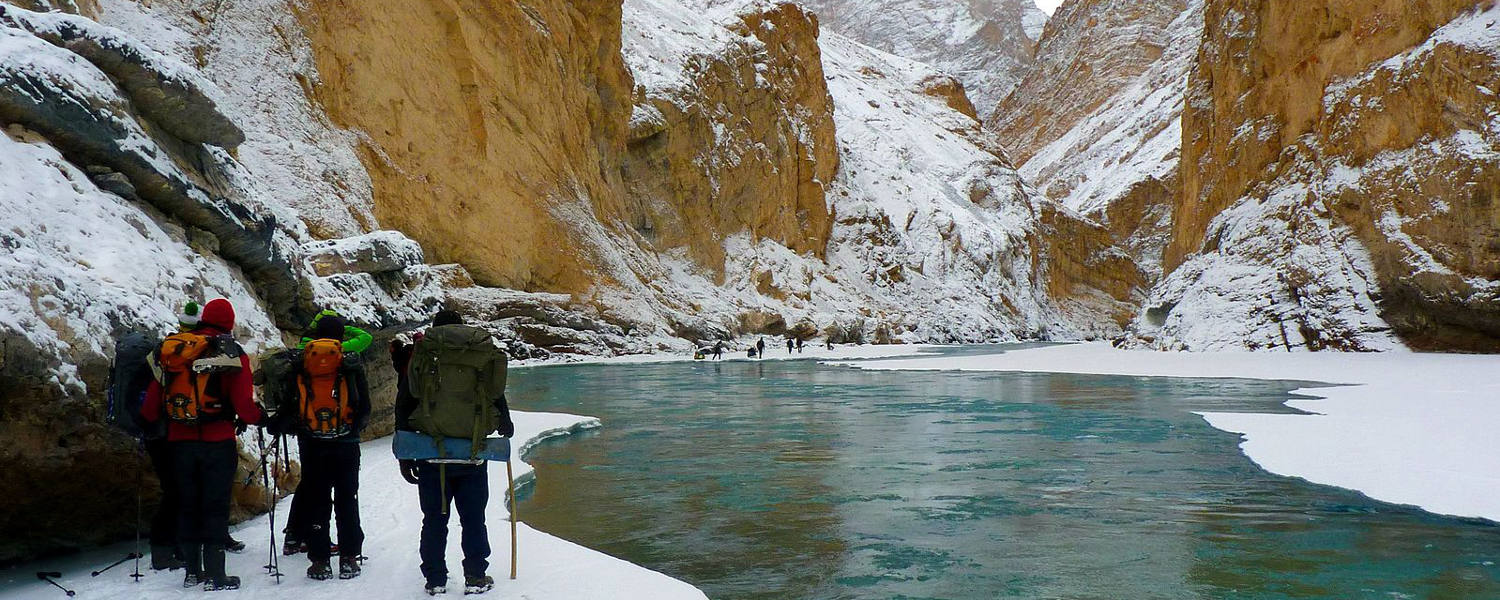
Day 6: Dib Cave/Tibb to Camp at Naerak (3390 m)
Today, you’ll be walking for roughly 10km as you trek the most beautiful section of the valley. Along the route you’ll be dazzled by one of the world's largest frozen waterfalls and large prayer flags fluttering in the cool breeze.
In the late afternoon, you’ll reach the village of Naerak where you have the chance to explore and talk to the locals – maybe share a drink or two!
Day 7: Naerak to Tibb
Today, your return journey begins as you proceed back to Tibb. However, your path may very well be different as the river reacts to the slightest temperature changes. Sections that were frozen may now be running and vice versa. Always follow the steps of your guide.
Day 8: Tibb to Shingra Koma
As you return down the river valley, you’ll have plenty of time to react on the stunning landscape and take pictures to show your relatives and friends back home. Keep a sharp eye out for wildlife including foxes, ibex and the elusive snow leopard. Although rarely spotted, you can be assured the leopards are watching.
Day 9: Shingra Koma to Chilling – Chilling to Leh
This is your last day on the Zanskar River. You’ll trek back to Tilad Do where you will say a final goodbye to the locals before taking a car back to Leh. Relax in a warm and cozy bed for the night to rest your tired muscles.
Day 10: Departure
Today, you say farewell to your crew and depart Leh for Delhi. Here, you will take your international flight home.
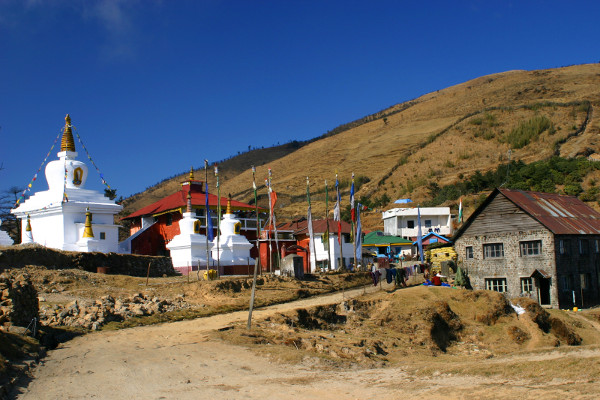
Chadar Trek FAQ
How much does the chadar trek cost.
The cost of the Chadar Trek varies depending on what operator you use. Local agencies often offer a guided trek for as little as US$250 per person (excluding flights). However, for an established western operator, you should look to pay at least double this. The trek can be dangerous and finding the right operator is important as your safety should be paramount.
You will also need to factor in flights, equipment, visas, vaccinations and food and drink. Each operator will offer a slightly varying package when it comes to food and drink on your trek.
- Visa, Vaccinations, Insurance etc: ~$300-$500
- Equipment (buying and hiring): ~$300-$800
- Flights to Leh: ~$1,000
- Tour Agency: ~$250 – 350 for a cheap local agency to ~$500 – 1000 for a Western trekking agency
- Tips: ~$50-$100
- Misc (additional food, unplanned travel / hotels ect): $200
- Total Costs: $2,200 – $4000
Are permits required for the Chadar Trek?
Permits are generally included with your trek costs. However, operators will often ask you to pay around US$50 for a wildlife/environment charge levied by the Indian government.
When is the best time to complete the Chadar Trek?
The best time to trek the Chadar Trek is January and February during the peak winter season . This is when the river is frozen and can be walked on (gently).
The Chadar Trek does not operate at any other point in the year.
Is altitude sickness a risk on the Chadar Trek?
Yes, the entire area is at high-altitude, and you’ll want to make sure you arrive several days before your trek to acclimatise to the thin air.
It is important to have a detailed understanding of the risks associated with high altitude trekking and how the body acclimatises.
We recommend you read our detailed article on Altitude Sickness and Acclimatisation .
How difficult is the Chadar Trek?
The Chadar Trek is considered to be one of the toughest treks in the Ladakh Region. The trail is cold, icy, often steep and always at high altitude.
Only experienced trekkers are recommended for this trek. You will need to be in good physical condition before attempting the route and have a good stamina built up.
The freezing temperatures also make the trek difficult with temperatures often exceeding -20 degrees at night and -10 degrees during the day.
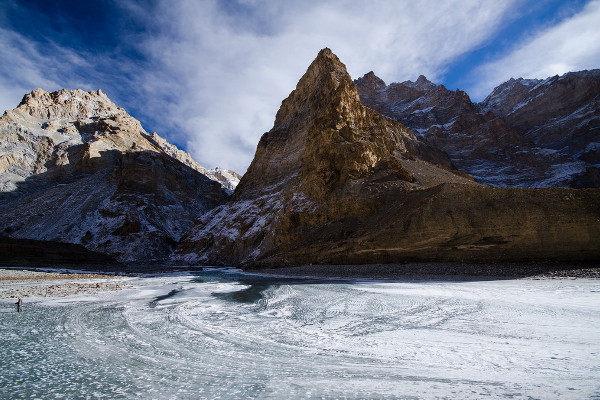
What gear do I need for the Chadar Trek?
Trekking in the Ladakh region requires a number of essential pieces of trekking clothing and equipment. The Chadar trek however requires some cold weather gear that is often not nesscary on the summer treks.
Many pieces of equipment can be rented or bought in Leh, but we recommend bringing the most important pieces of gear with you. The important thing is warmth. You’ll need a winter sleeping bag (may be provided) and good quality thermal gear.
To help you plan and prepare for your trek, we have written a detailed hiking gear list for multi-day treks .
What travel insurance do I need for the Chadar Trek?
Trekking insurance is a must on multi day hikes. This is particularly important on the Chadar Trek which is extremely remote. If an accident should occur that requires medical assistance and evacuation you will definitely want trekking insurance that can cover the costs of air ambulance and treatment.
Moreover, it is prudent to have insurance that covers you for any travel related risks, like lost, stolen, damaged or delayed baggage; flight delays and interruptions; and tour operators default.
Moreover, it is prudent to have insurance that covers you for any travel related risks, like lost, stolen, damaged or delayed baggage; flight delays and interruptions; and tour operators' default.
Are there any recommended guidebooks for the Chadar Trek?
There are a number of excellent guides we recommend for the Chadar Trek. These are:
- Trekking in Ladakh by Radek Kucharski.
- Trekking in the Indian Himalaya by Lonely Planet
- Trekking Guide to the Western Himalayas by Depi Chaudhry
- Ladakh: the Essential Guide: Including Kashmir & Manali by Partha S. Banerjee
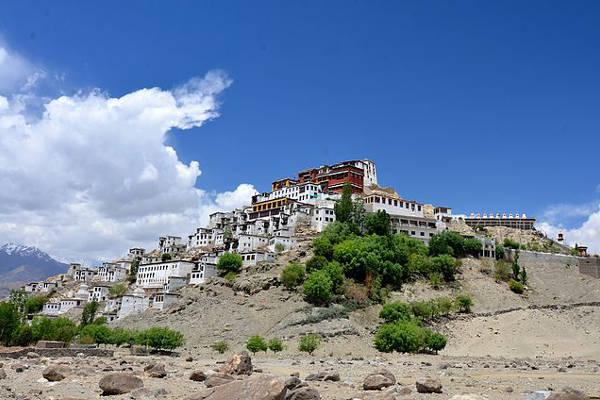
Are there other Indian Hikes besides the Chadar Trek?
Absolutely. We also recommend doing hikes like the Singalila Ridge , Markha Valley and Ladakh for unparallelled sightseeing and experiencing Indian culture and history firsthand.
Continue browsing
See more information on India . Or check out these other Indian Hiking articles:
- Hiking the Himachal Pradesh
- Trekking the Uttarakhand
- Roopkund Hike India
- Arunachal Pradesh India Treks
- Guide to India hikes
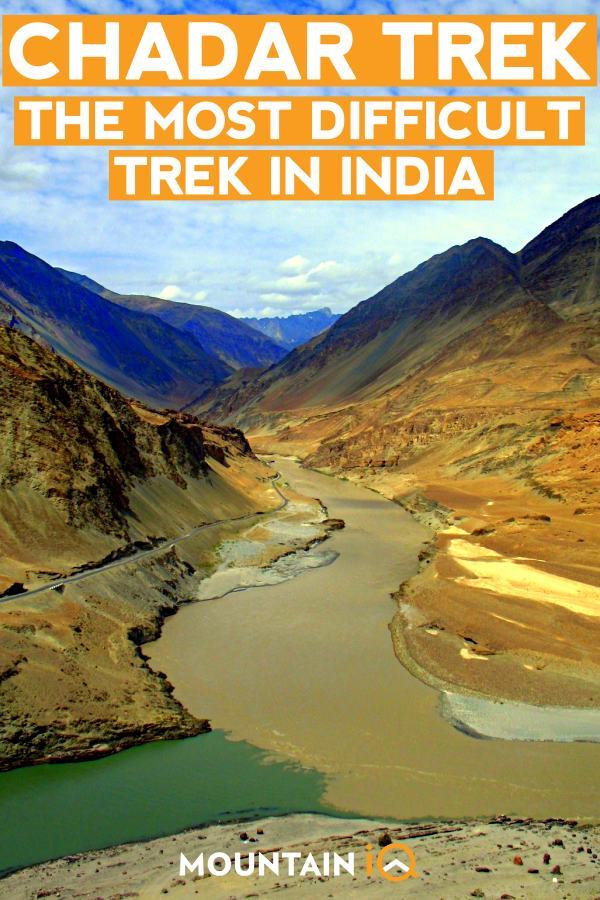
About the author
Mark Whitman
Mark has trekked extensively in Asia, Europe, South America and Africa. He founded Mountain IQ in 2014 with the sole aim to be the best online information portal to some of the most popular mountain destinations around the world. When not writing for Mountain IQ, Mark is out exploring the outdoors with his wife!
Leave a Reply
Your email address will not be published. Required fields are marked
We work with local guides to offer great value adventures at unbeatable prices

Chadar Trek
- Trek Grade Difficult
- Trek Distance 62 Kms
- Trek Duration 9 Days
- Highest Altitude 11,100 ft
- Basecamp Leh
Call Our Mountain Experts
- +91-7060032966 Adhish ( Mountain Expert) [email protected]
- +91-7060017566 Shivam (Mountain Expert) [email protected]
- +91-7060011466 Priyanka (Trek Co - Ordinator) [email protected]
- Transport Included From Leh Airport
The journey begins at Leh, a mountain town. Leh. The only method to get to Leh is via flight, and is surrounded by snow, giving it a completely white appearance. You can get an image of the mountains covered in snow during the flight as it lowers towards Leh which is situated at 11400 feet higher than sea level. The hike is along the Zanskar River which is frozen during winter. The best time to walk across the ice would be during February. At this time the ice is likely to be in its most stable condition. It is the Frozen River Trek begins in Chilling, a small town. Chilling which is which it is from where Zanskar River begins to freeze. The ice is equally dangerous at times, but it is safe at other times. It is essential to determine how to navigate safely through the unstable sheet, and be aware of the conditions beneath the feet. Trekkers may choose to stay in caves along the banks as locals do or build tents on the areas that are the most solid. The temperature is around 20 degrees below the freezing point and then decreases even more after sunset also. Warm and layered clothing is highly recommended for those who are constantly moving as often as you can. They help keep the body warm , and also prevent sores from cold and keep cold blood cells from freezing.
Day Wise Detailed Itinerary
Day 01 arrival in leh 11480 feet (3500 mtrs).
Today morning on your own board the flight to Leh, enjoying the magnificent Himalayan view from the aircraft (probably you should book your seat on left of aircraft for best views). On arrival at Bakula Rinpoche Airport in Leh; meet and received by our company representative and drive you to the booked guest house in Leh. On reaching the guest house check into the Guest House for freshens up. Rest of the day at leisure for acclimatizing your body to the altitude.
Overnight stay in Guest House No Meals

Photos by Preetam
Day 02: Full day for Acclimatization in Leh (Rest/ Mild walk)
Wake to fresh new morning, today the full day will be for acclimatization as per the guidelines and regulations applied by Ladakh Government Authorities, this acclimatization is mandatory for all the trekkers going for Chadar. The trekker should at least spend one day in Leh to get their body used to of the weather conditions and every trekker is requested to strictly follow the same. In the afternoon or evening hours one can choose to stroll around in the local Leh market and spend some time in shopping and preparing for your Expedition. It’s important that your body gets used to the cold temperature of the region, this will help your physical to be stronger as the next coming days will be much colder and temperature will keep Deeping.
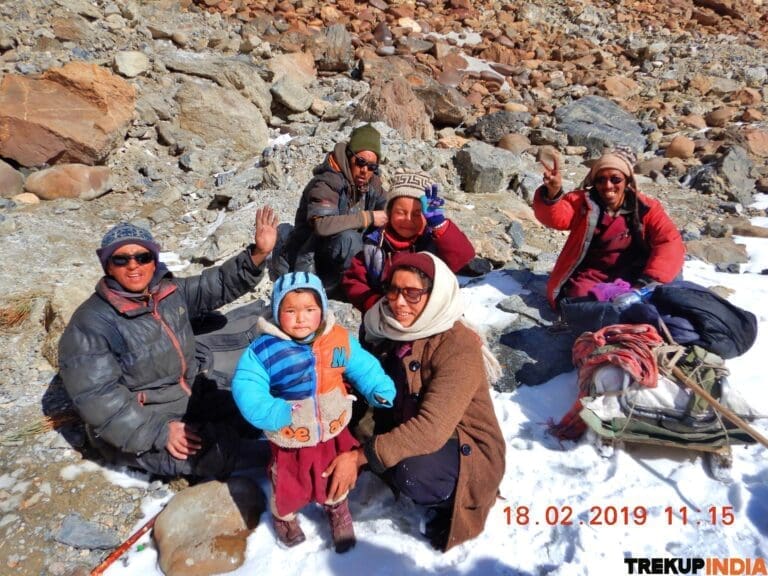
Day 03: In Leh (Get Medical, Insurance, Wildlife Permit and ALTOA NOC).
Today is preparation day; basically, it’s a day we introduce you to our expertise guide along with locals to give you a brief about the trek. So that you are mentally as well physically prepare for every situation; along with it we provide medical check-up to make sure whether you are fit for the trek or not. For this you should start exercising at least a month prior your trek, daily walking / running of 8-10 Kms will build your stamina and make you fitter for the expedition. After the briefing and medical checkup, go for self-exploration and local sightseeing this would be better idea to get habitual with temperature but only in the daytime, you need to come back to Guest house before sunset. Please make sure to keep away from Alcohol and smoking in order to pass your physical fitness and to complete the trek (Trek up India recommends all to quit smoking and Alcohol)
Overnight stay in Guest House No Meals

Day 04: Leh to Shingra Koma (10300 Feet) by drive 75 Kms 3-4 Hrs and to Tsomo Paldar (10500 Feet) by Trek 3 Kms approx 2 Hrs
Finally the day has come, need to steps out of your comfortable and cozy shelter and proceed towards Cristal white Chadar will be waiting for you to take away on it. The drive will be most scenic as your drive through Gurudwara Pathar Shaib, Magetic Hill, Hall of Fame etc. confluence of Zanskar and Indus river is mind blowing, this are some of the place where you might halt for some time and take some great memories in form of pictures. Shingra Koma is the place until where our vehicle will drop you till the end of the road, from where your Chadar Trek starts, initially you will see thin layer of Chadar hence mind your steps, walking with gumboots on Chadar may be challenging in the beginning, understanding the ice pattern might be difficult, however soon you will learn all from our guide and locals, you will start leaning about the walking pattern, realize where the ice is fragile and where trustworthy, so be careful. The nature is treating you to it’s best, rest of the time letting your body relax and be prepared for another adventure day.
Overnight stay in Trekking Tents Meals: Lunch & Dinner
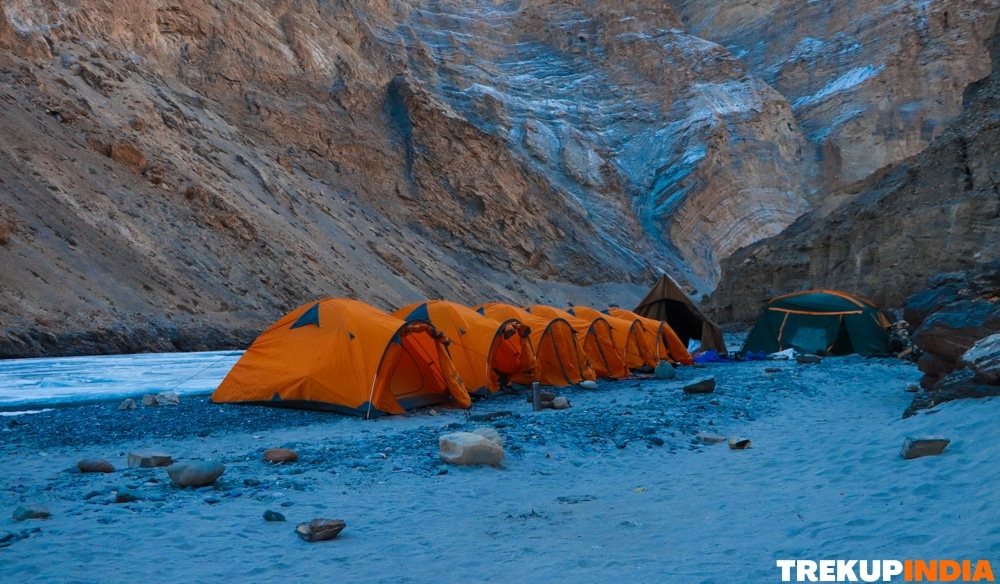
Day 05: Tsomo Paldar - Tibb Cave (10950 feet) by trek 14-15 Kms approx 6-7 Hrs
Appreciate yourself for making it day 02 of trek with much needed hot bed tea in the early morning, later on after breakfast at the camps we will proceed towards Tibb cave. Here we suggest all Trekup India trekkers to eat well to keep yourself energetic as the day will be the harder than the previous one and here you walk approx 14-15 kms. The good things about the Chadar trek are that it does not quickly increase the altitude, slowly but gradually. Through gulches of Zanskar will seem more beautiful and adventurous. While heading towards our camp site there are some good eyes catching waterfalls, as per the locals there are lots of myths of the same, as these water falls are sources still unknown and it certainly reminds you about Disney cartoons from childhood. Crossing up the frozen waterfall, you cannot miss the chance to show your photography talent here and it will compliment your talent perfectly. Butter tea, also known as Po cha will surprise you with the texture of teapot; we will camp around the Tibb cave.
Overnight stay in Trekking Tents Meals: Breakfast, Lunch & Dinner
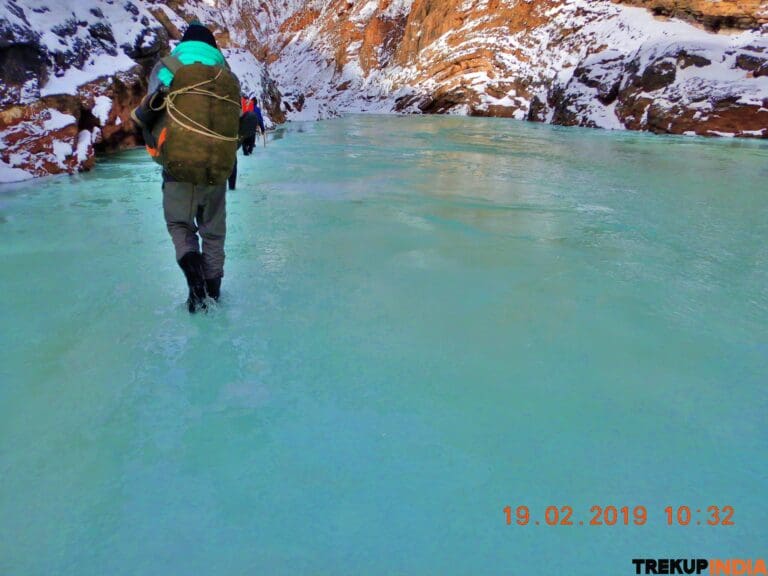
Day 06 Tibb Cave – Nerak (11100 Feet) by trek 12-13 Kms approx 6-7 Hrs
Hello Trekkers, the most awaited day has come, from previous days trek seeing the smaller frozen water falls, certainly the curiosity will be there about nature masterpiece and the big frozen waterfall , It’s a perfect example of witchcraft of nature where several colors are spreading all around; it’s more like a piece of glass made by nature I would rather say. The 12-13 Kms trek you walked today all struggle that you had is going to vanish in few second in this magical land. Narek will be the coldest of all the campsite the temperature during the night time might deep to -30 Degrees, so be prepared with your warm clothing’s. Rest of the day free for our own activities if you are well in time you might have a chance to make an excursion to Nerak village.
Overnight stay in TrekkingTents Meals: Breakfast, Lunch & Dinner

Day 07 Nerak (11100 Feet) -Tibb cave (10950 feet) by trek 12-13 Kms approx 5-6 Hrs
WOW! Narrating this itinerary was like being there on it; imagine when you will be there what a life moment it would be. Today we return from Nerak towards Tibb Cave, we are sure on your way back you might be laughing as you gets the glimpses of nostalgic memory where you had struggle to reach there and some clicks on your mind, you get lots of surprises on your way back you might not see the formation of Chadar through which you walked but the new one has formed, you will be amazed to see how different they appear while returning back. Chadar trek my personal favorite and all adventure lover should witness it once in a lifetime. We are sure you will feel these 8 days the best days of your life you have lived. Evening back to our camps celebrate and enjoy with safety. As it is going to be last day of the camping.
Overnight stay in TrekkingTents Meals: Breakfast, Lunch & Dinner
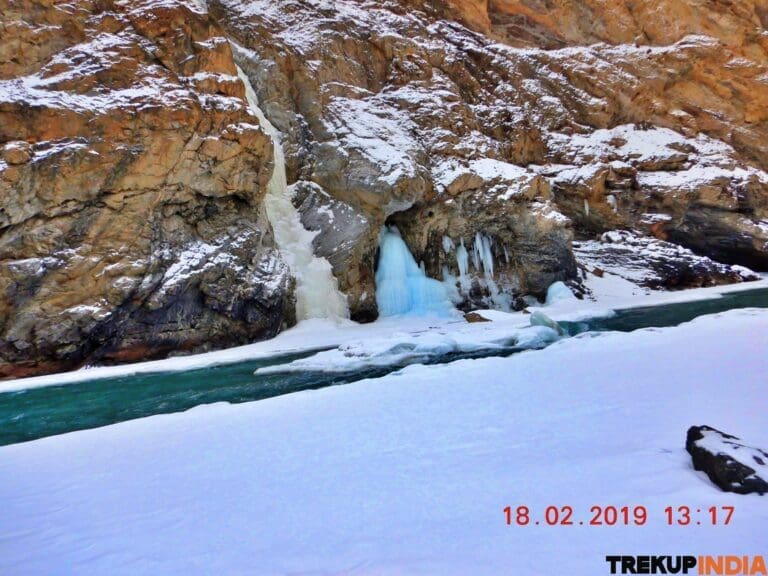
Day 08: Tibb Cave to Shingra Koma by trek 17 Kms approx 5-6 Hrs and drive to Leh 70 Kms approx 3-4 Hrs
Today it’s going to be a longer day, hence we start early definitely it is not going to be as the first day, you are an Experienced trekker now, so you move with a pace, enjoy the sites enroute all have changed, the Chadar has been melted to thinner layer, the beautiful rocks are now visible, soon we reach the road head get into our cars and drive back to Leh. Evening at leisure free for your own activities and celebration.
Overnight stay in Guest House Meals: Breakfast, Lunch

Day 09: Return from Leh
Today morning well in time transferred to Leh airport to board your onwards flight back to home.
No Accommodation Meals: Breakfast, Lunch

Food Provided by Us During the Chadar Trek
We provide only Indian vegetarian food and mainly your meal is going to contain Indian bread, vegetable, lentils and Rice along with delicious dessert. During your trek, we will serve three meals a day including breakfast, lunch, and dinner. In the evening, you will also be served tea & snacks and lip-smacking soup before dinner. If it will be a long day of trekking, you will be given a packed snack.
After doing a lot of research on the nutritional requirements for the trekkers, we prepare the menu. Before putting all the meals together, we also consider altitude gained and weather.
The meal served by us while trek is perfectly balanced with the right amounts of calories, carbohydrates, vitamins, protein, fiber, and minerals. You need to know that all our cooks have great expertise in cooking and have undergone thorough training. So, get ready to enjoy delectable and lip-smacking dishes during your trek. You will be served with lemon tea in the tent in order to start your day with a refreshed feeling. Before leaving the campsite for trekking, you will be given a hot finger-licking breakfast like upma, Aallu Prantha, Besan Chilla, Poha, Daliya, Corn flakes, Maggie, along with tea or coffee.
In case, your trek will be longer one then we also offer some fresh local fruits such as apples and even healthy drinks like Frootie or Maaza. In the afternoon, you will be served simple & healthy lunch, while at around 04:00 pm, you will be given tea and a light evening breakfast. After you reach your campsite at night, you will be served a hot and delightful dinner. After reading this, you must have got the idea about the food provided by us on trek, you don’t need to worry about food. Many trekkers trek with us again and again because of the food we provide. Thus, we will definitely give you unforgettable experiences.
Safety During Chadar Trek
Trekking with us for kedarkantha trek is completely safe because we have a team of trek leaders who are qualified in Wilderness first-aid and also have complete information about the high-altitude glitches. During Trek, we carry a complete first-aid kit that contains all the important medicines. Before trekking with us, you need to ensure that you are medically fit for the trek and if you are able to judge yourself then it is better to take advice from a professional. For us, your medical fitness is very important than anything else.
Know About Us:- You need to know that our company Trekup India has been in the field of Adventure Tourism for the last 23 years. Right from our inception, we have been involved in providing treks, voyage & hiking programs as well as high altitude expedition rafting.
We keep on organizing treks in Uttarakhand and Himachal, while being a part of the trekking community, we feature more than 75 Himalayan documented treks. Apart from other outdoor activities, our company also organizes trips for schools, colleges, and family.
We ensure complete technical safety in the mountain
Our company has a vast team of more than 100 guides, as well as trainers in order, serve in the mountain treks. One of the best things about our team is that all the members are trained professionally from Nehru Institute of Mountaineering, Indian mountaineering foundation Delhi as well as Hanifle Center Outdoor Education Mussoorie.
Therefore, we never believe in compromising on the quality as well as services offered to our valuable customers.
For Us, Your Safety Is the Top Priority
At Trekup India, you will find a team with local knowledge and fluency in English as well as Hindi. This helps in ensuring that you have an amazing trek and not only this, we also pay attention to your health as well as safety because this is something we cannot ignore. All the team leaders involved in trekking have already undergone several professional courses in First Aid, Portable Altitude Chamber Training, CPR, Environmental Awareness Training as well as Advanced Wilderness Emergency Medicine.
We also carry a complete first aid medical kit not only on the trek but on each and every trip which is organized by us. Apart from the medical kit, we carry a portable altitude chamber and medical oxygen for all kinds of high-altitude treks . Our company has great expertise in organizing all sorts of group adventure holidays for family groups, school & college groups as well as friend groups. When it comes to travel options, we have a wide range that suits different fitness levels as well as traveling styles.
Therefore, no matter who big the group size, we pay personal attention to each and every member present in the group.
How We Ensure That Your Trek Is Safe with Us
Right from our establishment, we at Trekup India, are continuously involved in introducing new safety practices into Indian trekking in order to ensure the safety of voyagers. For walking on snow, Trekpp India introduced Microspikes and also made emergency bottled oxygen mandatory for all kinds of treks. In order to test pulse as well as oxygen saturation levels, pulse oxymeters are used. As a safety communication device, we at TrekupIndia introduced radio.
Though we have noticed that most of the organizations organizing treks do not follow these systems but with time several competing companies are adopting these practices and organizing great and safe treks.
Explore our New Safety Protocols
In order to ensure a perfect Trek, we have introduced some new safety checks that will assure more safety for our trekkers. Our On-trek safety checks includes:
- Daily oxygen saturation along with pulse readings
- Stretchers team appointed on every trek
- Trained mountain staff and full safety
- Additional oxygen cylinders
- Special medical kit for high altitude treks
- Microspikes on all types of snow treks
- Experienced Trek leaders as well as safety
- Technical team on all snowy slopes
What should you pack for the Chadar Trek?
Being an trekking, adventure & travel company, we get many questions from our trekkers and most common question that arises is what to carry or what should we pack for the trek? Sometime it becomes difficult to explain in details and therefore below we have prepared the detailed packing list, helpful for all trekkers coming to the Himalayas. Whenever we go on trek or start packing things one should remember the packing pattern i.e. either you start from head to foot or foot to head, this way there will be rare chance that you will forget the items to pack, so go step by step.
Make sure your backpack should be comfortable neither too big nor to small and for a week trek 60-70 liters of backpack should be enough to hold all your belongings. Ensure that your backpack has good hip & Shoulder support and pockets should be accessible quickly.
All trekkers should keep in mind that daypack is very important, this will be a great help to you while on trek, also every single day you won’t be carrying you backpack therefore for day excursion , shorter hikers, sightseeing you can carry your stuff in it.
- Trekking shoes: Preferably water proof, ankle support.
- Walking / Hiking sandals: This can be used off trek i.e. in the morning and evening hours, basically to get your feet rest from heavy boots, sometime used for crossing streams and rivers, it’s more comfortable and safe than crossing barefoot or wetting your boots.
- Sneakers (Optional) : For normal driving days or can use around the camp
- Socks (3-4 Pairs) – Make sure to choose material wisely, it should be quick drying, warm and comfortable.
- Hiking / trekking jacket: Carry good quality layer jackets
- Hiking pants: Check some kind of long nylon blend, light and quick drying pants. Warm covers ups like fleece-lined tracksuit pants or ski pant.
- Undergarments as per your habitual requirement
- T-Shirts and Shorts (3-4 Warm comfortable)
- Ordinary Shirt / T-shirt – Just in case everything gets wet this will help for roaming around.
- Long Sleeve shirt – can be used as a base layer on colder days
- Socks – at least 4-5 pairs
- Leggings – Can be used specially chilling morning and evening , to keep your body warm
- Thermals – get 2 pairs of thermals, this will be great need a body to keep it warm.
- Buff / Balaclava – This is a must to carry to cover your neck and this item is an ideal solution to keep your neck / throat warm.
- Beanie Cap- Very helpful item for colder and windy days should carry 1, also sometime when its freezing cold you can use it a night as well.
- Hiking Hat- this will basically help during the day time specially from the sun rays, make sure it has a strip so that wind does not below is far from your headJ..
- Gloves – 01 pair will be enough to keep your hand warm and nice.
- Rain Coat and Pant – Carry a pair of it to protect you from the rain OR
- Rain Poncho – during long rains, the waterproof jackets starts leaking but poncho does get work in keeping you dry, so choose accordingly.
- Rain covers: Some small water proof to cover your backpack and daypack as well for your gadgets.
- Gadgets and Electronic
- Trekking Poles
- Mobile phone
- Spare batteries for phone and camera, powerbank
- Light weight flash light or headlight
- Waterproof bag made up of plastic for camera
- Music system / Bluetooth
- Plug/converter for electrical items
- 1 liter water bottle
- Journal with pen would be good idea to keep your notes.
- Some book of your interest for ideal time
- Get into habit of keeping Map and guide book of the region.
- Hygiene & Personal toiletry
- Sunscreen with UV protection
- 1 or 2 small quick-drying towels
- Toilet paper/tissues/wet-wipes
- Toothbrush/toothpaste/ mouth freshener
- Deodorant / Talcum powder
- Lip-gloss/salve
- Sanitary pads/tampons (For female traveler)
- Bio gradable Soap
- Nail clipper
- Your other personal items that you use on daily basis
- Personal First aid Kit and Energy – below are some common medicine generally required / used during your adventure trip, however please consult your doctors prior.
- Antiseptic towel or water syringe (to clean the wound)
- Butterfly bandage for small cut
- Cotton and elastic bandages and sterile gauze pad for larger wounds
- Latex gloves used when its wound bleeds
- Medicine for Diarrhea (Upset stomach)
- Medicine for cold, flue / fever headache
- Some pain killers
- ORS pouches
- Quick pain relief spray (External use)
- Any personal medicine prescribed by your doctor
- Dimox / Similar for high altitude sickness
- Bug Repellent
- Carry some nutria / energy bars and drinks (non-alcoholic)
Note: Kindly consult your doctor before purchasing or taking any medicine.
9.Compulsory Documents to Carry
These are files needed to be submitted at Forest Department before ypur trek. With no of these, you will not be permitted to trek . Original and photocopy of government photo identity card. Carry Id’s like adhaar, voter id, etc.
Important note: You can book rent gears , what you can rent & buy from us and what you need to get from your home town, make your bagpack easy not heavy.
Click the link: https://booking.trekupindia.com/rent-trekking-gears/
Now you are all set for your Adventure trip with Trekup India!!
Trek Cost Inclusion
- Accommodation in Leh using Guest houses on triple sharing i.e. on Day 01.02,03 & 08
- Accommodation during trek using good quality trekking Tents Twin / triple sharing basis
- Meals (Vegetarian) Day 04 Lunch to Day 08 lunch All major trekking / camping equipment’s (utensils, trekking tents, kitchen tents, dinning tents, toilet tents, sleeping bags, sleeping mattress (Recommend to carry thin blanket / warm sheet) as inner, ropes etc.
- Transportation as per the itinerary on Day 04 and Day 08 (Leh to drop point / Pick point)
- Leh Airport Transport on Day 01 and Day 09 Support team: Qualified Trek Leader, Guide as per the group size, high altitude cook, support staff.
- Potters to carry trekking equipment’s and rations
- First Aid – Basic First Aid Box, Oxygen Cylinder, stretcher, Oxy meter
Trek Cost Exclusion
- Any kind of travel / health insurance (Trekup India recommends you to get yourself insured)
- Any Air fare / Airport taxes/ baggage charges (We can book the same at additional cost)
- Any personal trekking gears – like Gum Boots, trekking poles
- Adventure insurance and the cost of emergency evacuation.
- Any personal expenses like purchases of beverages/bottled water /chocolates/dry fruits etc.
- Shared or Private Porters for carrying personal luggage.
- Room Heaters at Guest House/ Hotel in Leh (Can be arranged at additional cost)
- Cost of transport, meals and accommodation if in case you have to leave the trek in between and return to Leh before the scheduled arrival i.e. Day 8, due to any reason like accidental, personal or force majeure.
- Wildlife permit fee/Medical check-up & Rescue/ALTOA NOC Cost and Adventure Insurance; an approx. amount of 6000-6500/- (subject to change without prior notice)
- Anything other cost which is not mentioned in Inclusion section.
Trek Logistics
Where will be pickup and meetup point.
Pickup Point Will be Leh Airport.
How To Reach Leh?
A flight that takes you over miles of mountains that are heavily snowed will show you how difficult it is to get to Ladakh via road during winter months. Jet Airways, Air India and Go Air provide daily (once every day) flights in between New Delhi and Leh. If you’re planning your trip to this part in the nation, make sure to reserve your tickets in advance. It could even reduce costs that are assessed when you book your tickets on the last minute. It is a great experience because you will be flying over unexplored areas , and some mountain ranges. The view from the air is amazing and makes for a wonderful beginning to your trip.
Day 01 Arrival in Leh 11480 Feet (3500 Mtrs)
Day 02: full day for acclimatization in leh (rest/ mild walk), mountain expert tips.
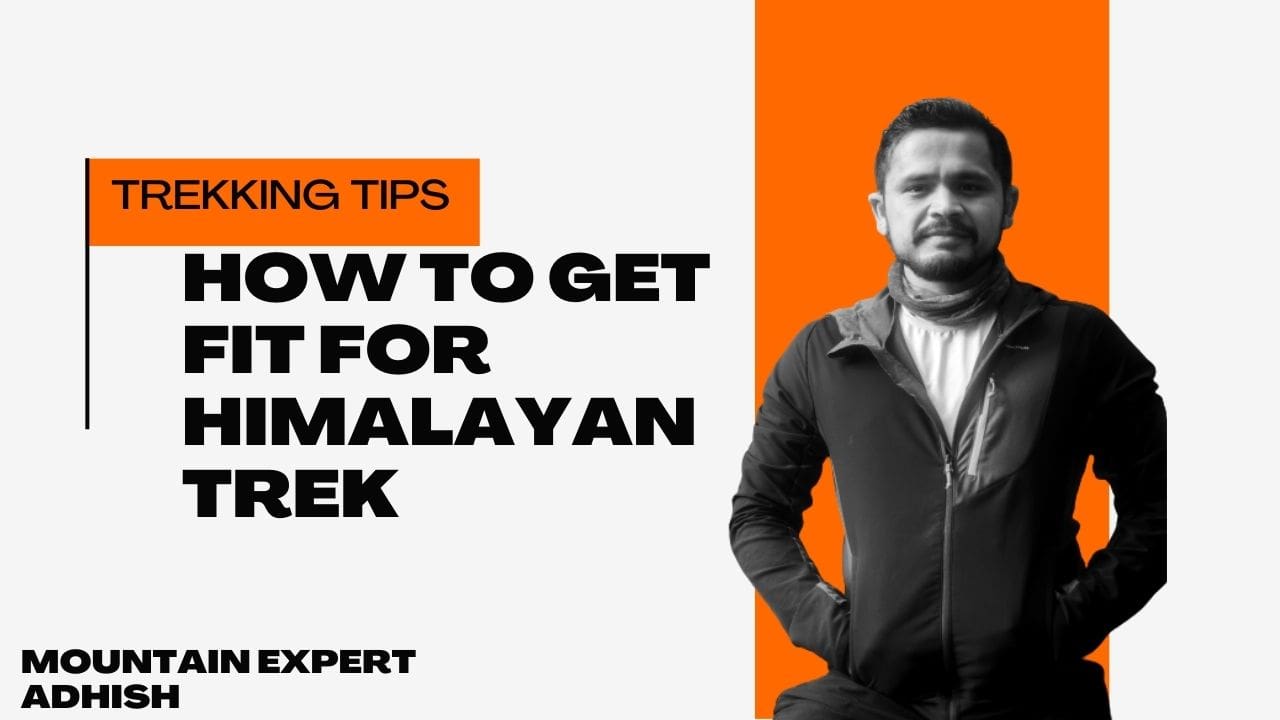
Latest Articles & Updates
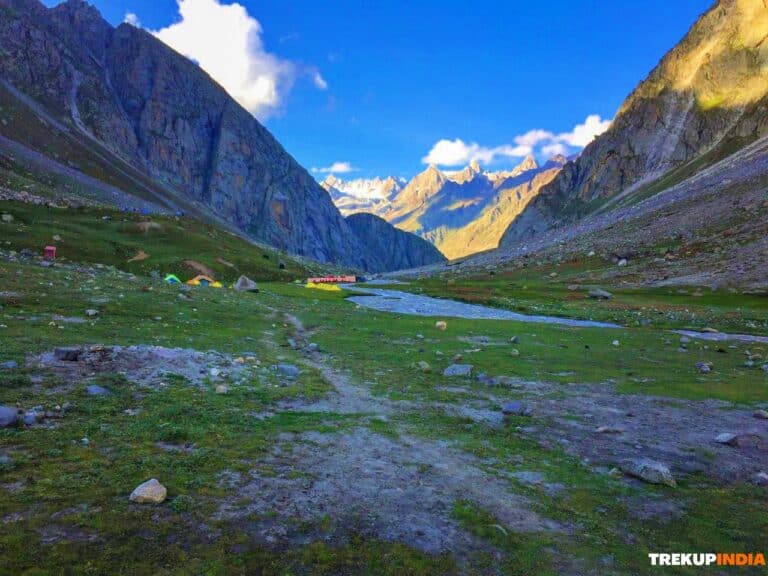
Rent Trek Gears

Chadar Trek
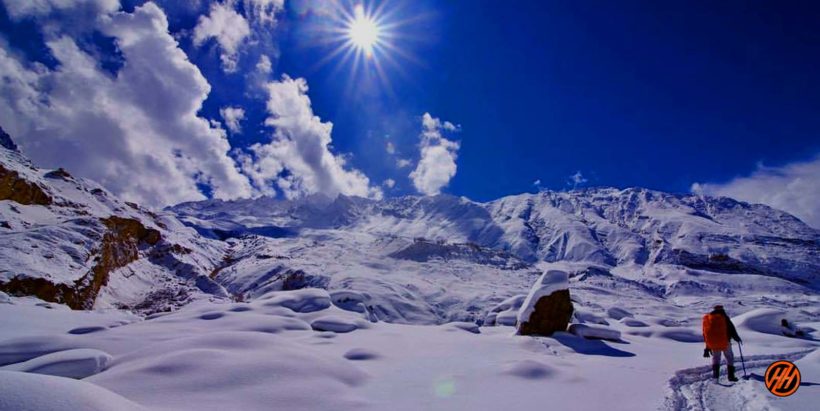
Description
Reviews (2), things to take, available dates, include / exclude, chadar trek in leh – over the zanskar river range of ladakh-2024- complete information, itinerary, costs date.
Your trek journey started with Himalayan Hikers , beautiful mountain town of Leh, all our trekker reach Leh by flight this is best option to you reach to Leh, altitude is 11400 feet above sea level, the trek beautiful Zanskar River which liws totally frozen during the December to Feb, Peak Winters Trek , So, probably the best time to do Chadar Trek is February because the ice remains harsh and stable. Trek starts from the freezing point of Zanskar River and that is Chilling.
Therefore, the “Chadar trek” is also known as “The Frozen River Trek”. This Trek is over a frozen river in the Zanskar region of Ladakh and it is different from all other treks in the Himalayas.
The snow appears as a thick sheet of snow, therefore, it is called “Chadar trek” and it is one of the trickiest treks in the world which is done in peak winter months. On this trek explore the Zankari culture and get to know about it in close proximity and the main highlight of this Frozen River Trek is a completely frozen waterfall “Nerak”.
The Chadar Trek is a popular winter trek in the Zanskar region of Ladakh, India. Here are some highlights of the trek:
- Trekking on the frozen Zanskar River: The highlight of the Chadar Trek is the experience of walking on the frozen Zanskar River, which transforms into a thick sheet of ice during the winter months.
- Breathtaking views: The trek offers breathtaking views of the frozen landscape, towering mountains, and the gushing river beneath the ice.
- Cultural experience: The trek also offers a unique cultural experience, as trekkers get to interact with the local Zanskaris and witness their way of life in the harsh winter conditions.
- Adventure: The Chadar Trek is a challenging trek that requires physical endurance and mental toughness. Trekking on the slippery ice, crossing icy-cold streams, and camping in freezing temperatures make it an adventure of a lifetime.
- Photography opportunities: The trek offers numerous opportunities for photography enthusiasts to capture stunning landscapes and unique cultural experiences.
Overall, the Chadar Trek is a must-do trek for adventure and nature lovers who are up for a challenging winter trekking experience.
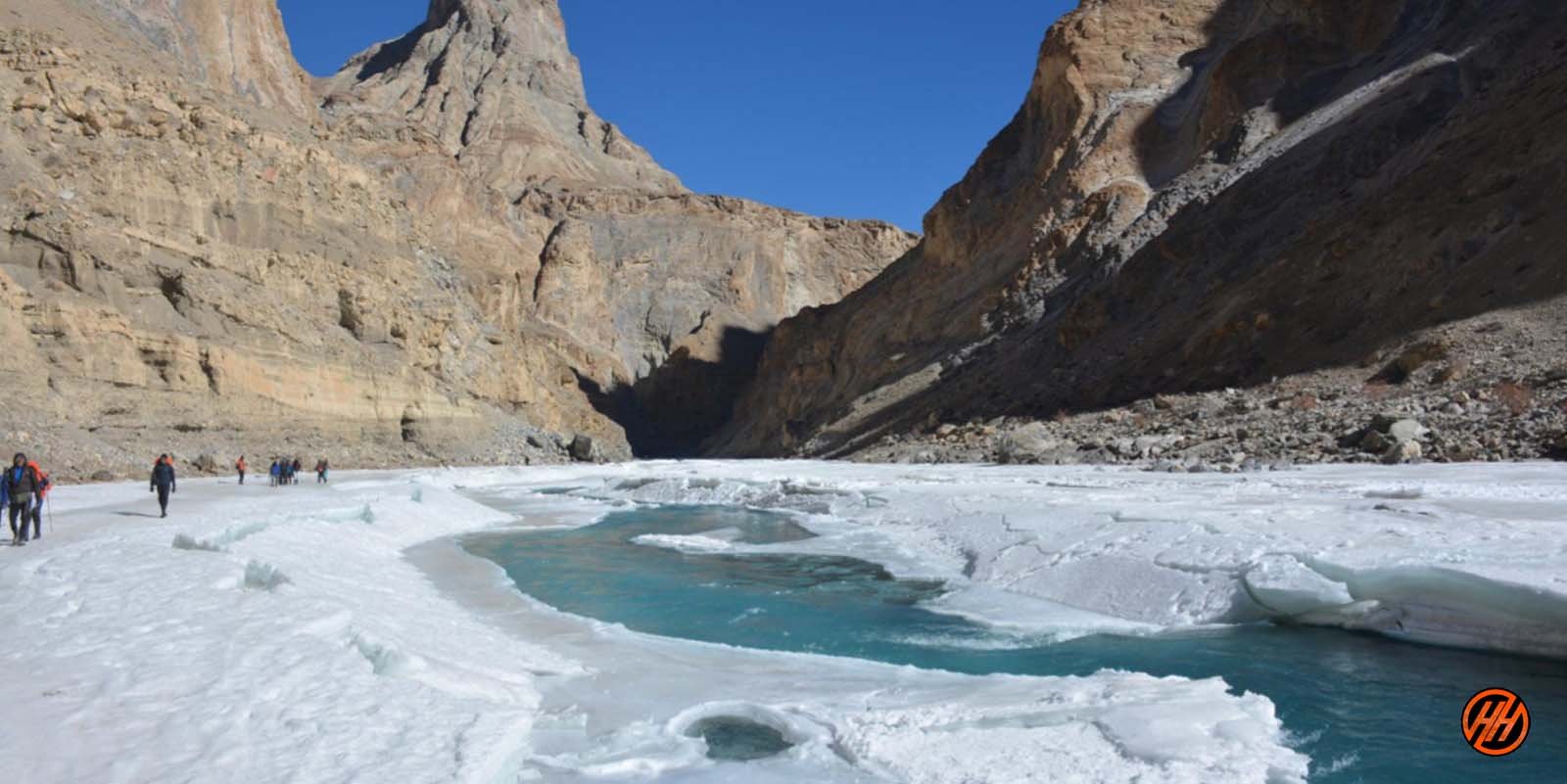
Ice Covering and Freezing Cold in Chadar Trek
The Chadar trek is over a frozen river and the ice can turn dangerous sometimes but can also be safe the other times. But, it is important to find a safe path over the perilous sheet of ice.
During the trek, you do not camp here at the meadows or the forest clearings but inside the caves which are present along the banks or you set up the tents at stable ice.
Here, the temperature remains chilly and freezing (-20) and falls down at night, so keep warm layers to protect the body against chilly cold and prevent the freezing of blood.
Best Time to Visit Chadar Trek
The best time to do the Chadar Trek is during the winter months, from January to February, when the Zanskar River freezes and forms a thick sheet of ice that is suitable for trekking. During this time, the weather is cold and dry, with clear blue skies and minimal precipitation.
It is important to note that the timing of the trek also depends on the weather conditions and the formation of the ice sheet. It is essential to have experienced guides and a reliable trekking organization to provide up-to-date information on the ice conditions and weather forecast.
Additionally, it is recommended to plan the trek in advance and book with a reputable trekking organization like Himalayan Hikers Trekking Organization to ensure availability and to have the necessary permits and logistics in place.
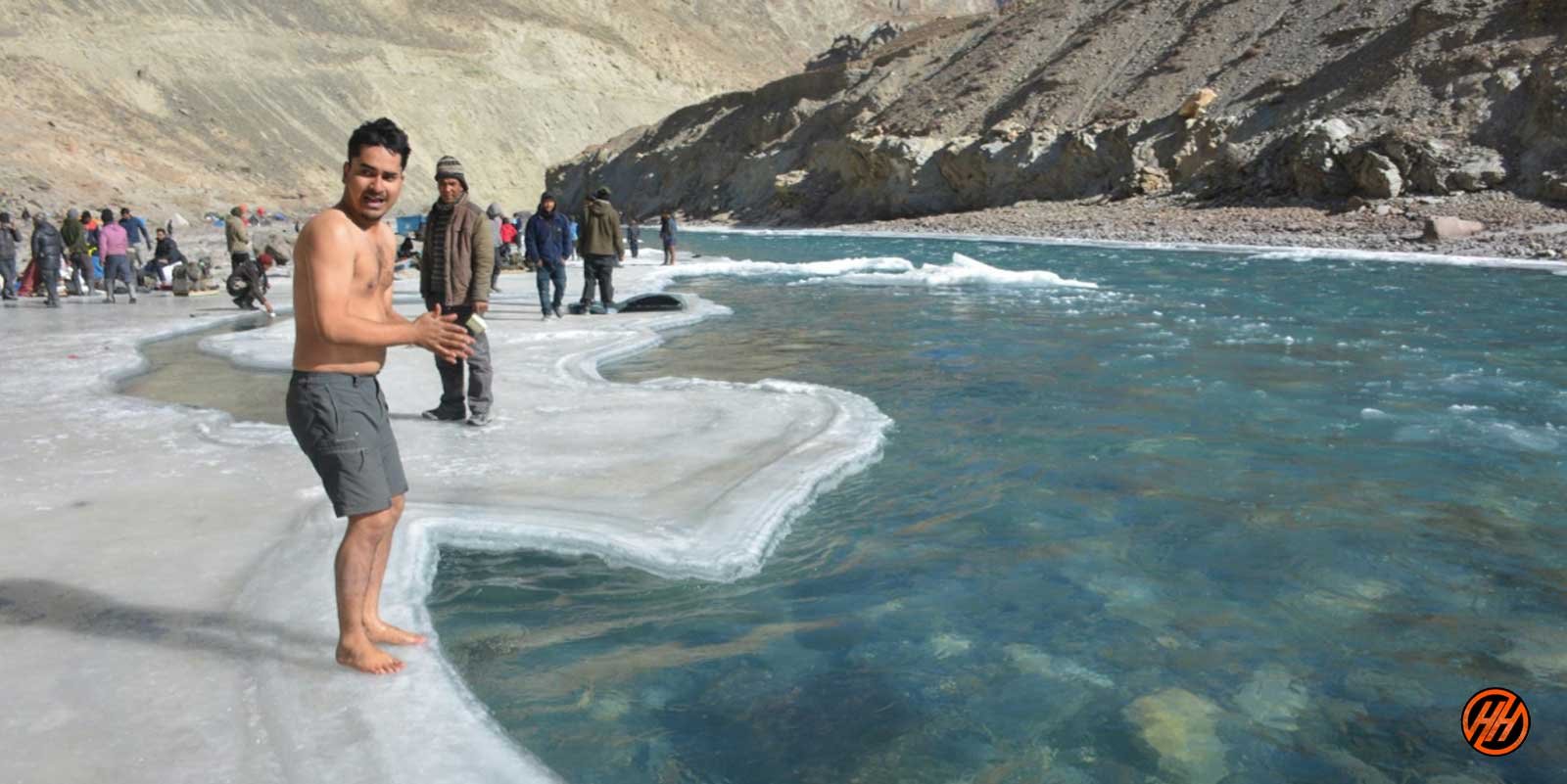
Be Aware During Chadar Trek (Not for Beginners)
You need to be very aware of the stability of ice and conditions below the feet for a safe trek. Sometimes the ice isn’t stable and the choices go wrong so walk carefully if suddenly a crack appears to go fast to the place where the ice is
So, choose a camping spot wisely after properly analyzing the area.
Here are some tips to do Chadar Trek –
Analyze the ice sheet conditions.
Avoid the cracks in the ice.
Walk carefully on the slippery areas.
Run immediately to a stable area if a sudden crack appears under your feet.
Walk on the places with a coating of snow.
Choose camping spots wisely.
Alcohol and smoking are not allowed in during the trek
Level- Difficult
During the trek, proper conditioning & training of body required
Need proper gear & clothing for sub-zero temperature
Shoes are the single most important equipment.
High Altitude requires proper acclimatization. Of base camp Leh
Beautiful landscapes so carry good photo gear & Extra battery backup.
Travel headlight
The backpack should not exceed 12 kg.
Long Gumboots are mandatory to all trekker
About Leh – Ladakh – The Land of High Passes
Area: 98,000sq km
Altitude: 7,500m Max.
Population: 250,000
Religion: Buddhism, Islam. Hindu
Geographical Status: Cold Desert
Across the Kashmir Valley and over the famous Zoji La pass lies Ladakh, the Land of High Passes. It is a magical land, so completely different from the green landscape of some other parts of the Himalayas. It is nature at its extreme. A land of freezing winds and blazing sunlight, Ladakh is a cold desert lying in the rainshadow of the Great Himalayas and other smaller ranges. Little rain and snow reaches this dry area, where the natural forces have created a fantastic landscape.
Ladakh forms part of the state of Jammu and Kashmir in India. Parts of Ladakh are under the illegal occupation of Pakistan and China. The border of Ladakh touches those of Afghanistan, Pakistan, China, the Kashmir Valley (India) and Himachal Pradesh (India). This region is made up of two administrative districts — Leh District, with its headquarters at Leh, and Kargil District, with its headquarters at Kargil –and covers a total area of about 59,000 square kilometers.
Ladakh is at an average elevation of 2,700 m to 4,200 m. The aridity of this region is due to its location in the rainshadow area of the Great Himalayas, elevation and radiation of heat from the bare soil. The most striking physical feature of Ladakh, however, is the parallelism of its mountain ranges. The region is extremely dry, with an annual rainfall as low as 10cubic centimeter.
In Ladakh, large rivers and their tributaries have carved deep gorges far below their steep banks. However, their water is not of much use as the terraced fields lie high above the gorges.
Until the advent of the aircraft, Ladakh could only be reached over dangerous, high passes. The Zoji La pass connecting Ladakh to Kashmir is at 14,000 ft and is the lowest approach from the west. The southeast approach has to cross the 18,200 ft high Tanglang La. And to the north lie the Saser La and Karakoram passes, gateways to Central Asia from where trading caravans used to come for many centuries.
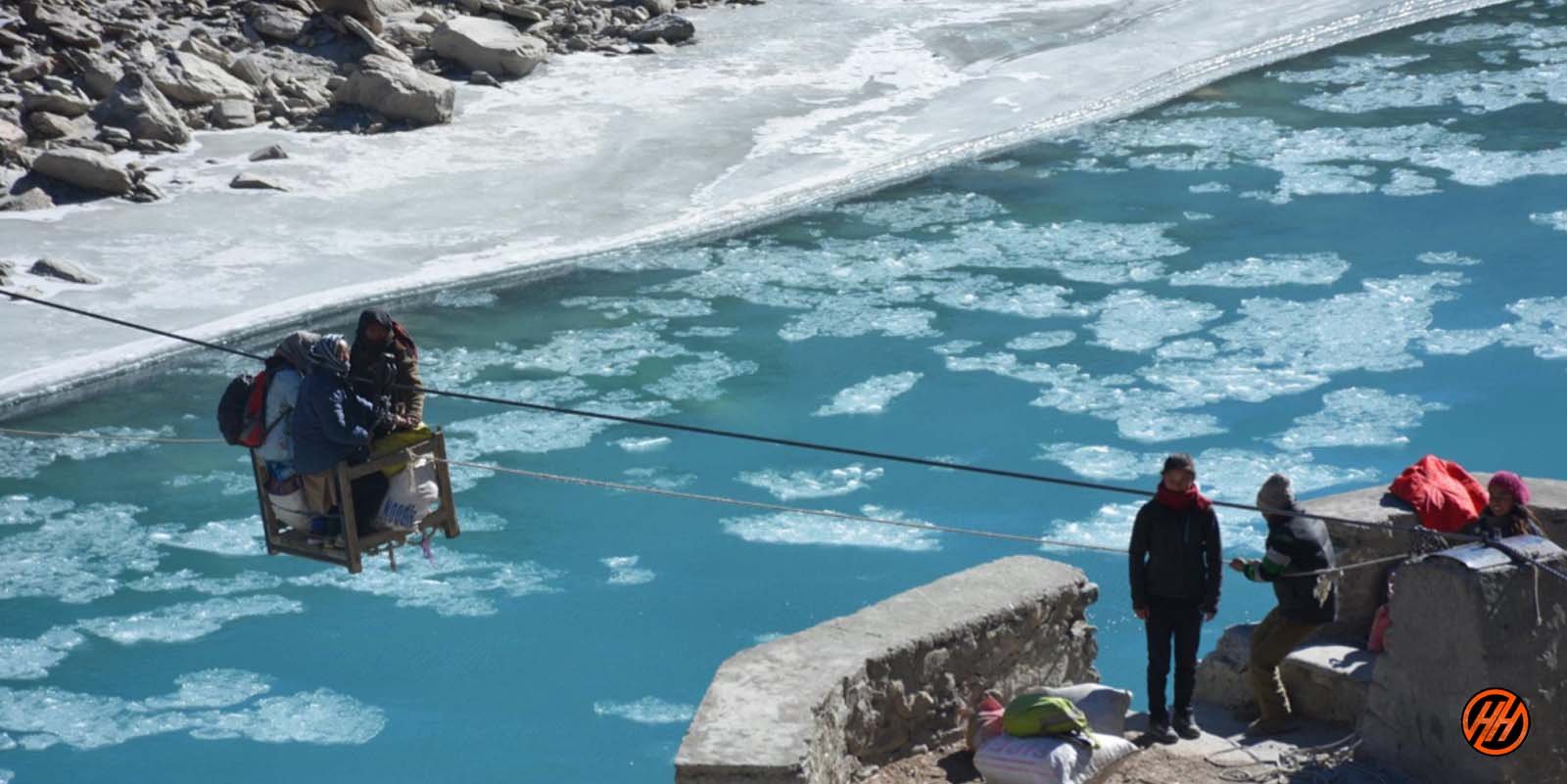
Altitude we are going to cover in Chadar Trek
Leh – 3500 Meters
Tsomo Paldar camp – 3200 Meters
Tibb Cave camp – 3300 Meters
Nerak camp – 3400 meters
The temperatures during the Chadar Trek
The temperatures during the Chadar Trek can be quite cold, as it takes place during the winter months when the region is covered in snow and ice. The average temperatures during the trek range from -10°C to -20°C (14°F to -4°F) during the day, and can drop to as low as -30°C (-22°F) at night. However, it is important to note that temperatures can vary depending on the weather conditions, altitude, and time of day.
It is crucial to have proper clothing and gear to stay warm during the trek, including warm base layers, a down jacket, insulated pants, waterproof gloves, and a warm hat. Additionally, it is important to stay hydrated and eat nutritious food to maintain energy levels and stay warm. Experienced trekking organizations like Himalayan Hikers Trekking Organization provide detailed information on what to wear and pack for the Chadar Trek to ensure a safe and comfortable trekking experience.
ATM Point & Mobile connectivity in Chadar Trek
ATM POINT: Hi trekker ATM available is Leh Withdraw money before your journey,
Mobile Connectivity: There will be available all networks only postpaid
Key Points of Chadar Trek
Duration: – 08 Nights 09 Days from Leh to Leh
Base camp: – Leh
Winter Temperature:- Day -5°C to -15°C) Night – 12° C to -20° C
Chadar trek – Altitude: – 11400 feet
Best Time: – Jan or Feb
Trek Level: – Difficult
Trek distance: – On foot 57 Km – By taxi 140 km
Group Size: – minimum of 05 people maximum of 15 people
Temperature
The winter temp. touches as low as minus 30 degree (Leh & Kargil) and minus 60 degree in (Drass) subzero temp. prevails from December to February throughout Ladakh, whereas, zero degree temp. is experienced during rest of winter months. This results in freezing of all conceivable water resources. During summers the maximum temp. increases from 20 degree C to 38 degree C in July and August
Clothing: Light/Medium woolens in summers to Heavy woolens in winter
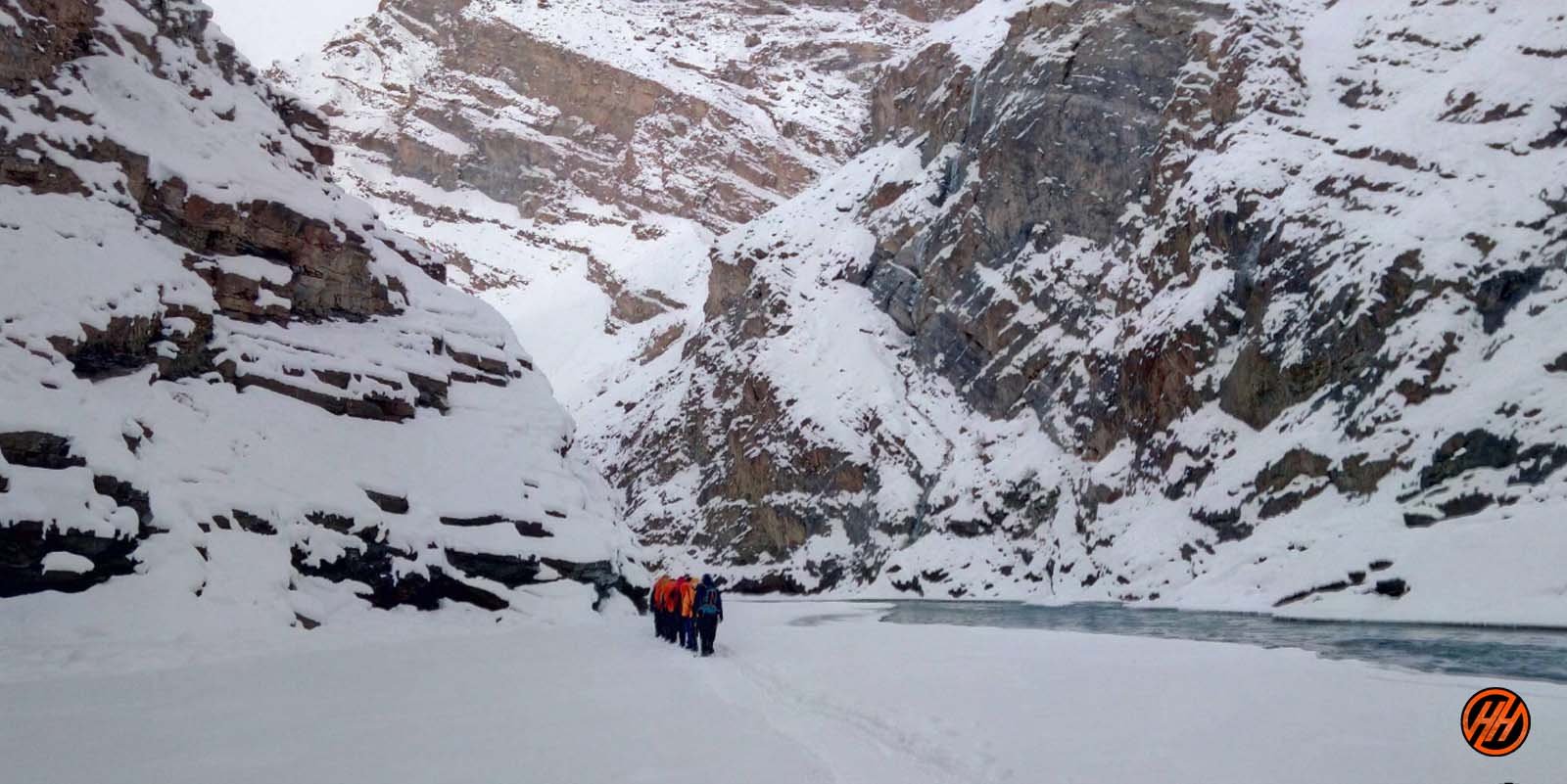
Languages Spoken
Ladakhi is the main language of Ladakh. Other languages spoken are Balti, Shina, Brokshat and Changshat. In hotels and restaurants, staffs speak English and Hindi, while tourist guides are well versed with the language.
Key Points about Chadar Trek
– Level: Difficult (so first-timers trekkers should avoid)
– Proper conditioning & training of body required
– Group size minimum of 05 maximum of 15 people
– Need proper Expedition gear & clothing for sub-zero temperatures?
– Shoes are the single most important equipment
– High Altitude requires proper acclimatization
– Phones don’t work on the trek, we are provide to you Radio Walkie Talkie for Communication
– Beautiful landscape so carry good photo gear (I couldn’t carry my best equipment)
– Travel light (my backpack was heavy at about 12 kg to 15 Kg )
– Keep an extra day in your itinerary for attempt to Chadar trek summit account for bad weather
– Alcohol and smoking is not allowed in during the Chadar Trek Expedition
Difficulty level
Because the top is relatively high in elevation, we strongly recommend a reasonable level of physical fitness. The arduous journey of Chadar trek winter hiking with longer distances and ascending elevations to be covered in a short span of time would require acclimatization. We advise trekkers to physically and mentally prepare themselves prior to this trek. Throughout the course, all groups will be guided by our experts for trekking equipment and any impending terrain.
Any medical assistance that is required will be provided at any point of the journey; however, trekkers must consult their professional care before beginning any trek. We also strongly advise trekkers to learn about altitude sickness and to notify our teams as soon as any symptoms appear.
Short Itinerary of Chadar Trek
Day 1:- Arrival at Leh – pickup to you from Airport drive to Hotel check in Rest and Acclimatization overnight stay Hotel
Day 2:- Trek Planning and Briefing – Acclimatization and Preparation- meet us our Himalayan Hikers Guide overnight stay
Day 3:- Medical Test Day in Leh
Day 4:- Drive from Leh to Bakula (70 km) (2 hours) same Day Trek Bakula to Shingra Koma 2/3 Hours overnight stay Camp
Day 5:- Trek from Shingra Koma to Tibba (16 km) (6/7 Hours) overnight stay Camp
Day 6:- Trek from Tibba to Nerak Waterfall (12 km )( 6/7 Hours) overnight stay Camp
Day 7:- Trek from Nerak to Tibba (16km ) (6/7 hours) overnight stay Camp
Day 8:- Trek from Tibba to Bakula (12 km) (6/7 hours) Same day Drive to Leh Hotel
Day 9:- After breakfast Depart from Leh
permit and passport.
Tourist don’t require permit for Leh, however, all foreigners are required to be registered at Drass, Rumtse and Serchu if they are travelling overland. Those traveling by air get themselves registered at airport. Tourists are required to get permit for restricted areas like Tsomoriri, Tsokar and Pangong Lakes, Dhahanu and Nubra Valley, which can be obtained from District Magistrate, Leh, through Travel Agents at Leh.
Avoid acute mountain sickness
Acute mountain sickness can occur to any one at an altitude above 10,000 ft. above sea level, therefore, make it sure to take complete rest on the day of arrival.
How to Reach Leh or ladakh
Overland Approach
Overland Approach – The overland approach to Ladakh from Kashmir Valley via Kargil is approx. 434 Km, which remains open for traffic from early June to November. The most dramatic part of this road journey is the ascent up the 11,500 feet / 3,505 m high Zoji-La, the pass in the Great Himalayan Wall that serves as the gateway to Ladakh. The J & K State Road Transport Corporation (J&K SRTC) operates regular Deluxe and Ordinary bus services between Srinagar and Leh on this route with an overnight halt at Kargil. Taxis (cars and jeeps) are also available at Srinagar for the journey. Groups can charter Deluxe and A-class buses for Leh, Kargil or Padum (Zangskar) from the J & K SRTC at Srinagar.
Manali to Leh – Since 1989, the 473 km. Manali-Leh road has been serving as the second overland approach to Ladakh. Open for traffic from around mid-June to early October. This high road traverses the upland desert plateau of Rupsho, altitude ranges from 3,660m to 4,570m. A number of high passes fall enroute among which the highest one known as Taklang-La is world’s second highest motorable pass at an altitude of 17,469 feet/5,235m. Himachal Pradesh Tourism, HRTC and J & K SRTC operate daily Deluxe and Ordinary bus services between Manali and Leh. The bus journey between Leh and Manali takes about 19 hours or two days with an overnight halt in camps at Serchu or Pang. Shared taxis are also available both from Leh and Manali
Road Distances
Srinagar-Leh 434 Km
Manali-Leh 473 Km
Srinagar-Kargil 204 Km
Delhi-Leh 1047 Kms
Leh-Kargil 234 Km
Kargil-Padum (Zanskar) 240 Km
Leh-Deskit (Nubra Valley)118 Kms.
Credit Cards & ATM Machine
Credit cards are accepted by very few hotels and tour operators but there will be 2.5% service charge. The Jammu and Kashmir Bank and State Bank of India has placed ATM Machine in Leh. The State Bank of India accepts visa and mastero but this ATM is not very reliable. J&K Bank ATM is more reliable but accepts only Mastero.
Indian Airlines www.indian-airlines.nic.in operates regular flights to Leh from Delhi (fare USD 135), Four flights in a week from Jammu and once in a week from Chandigarh and twice from Srinagar. Jet Airways www.jetairways.com also operates daily flights between Leh-Delhi (fare USD 143).
Internal Transport
The cheapest way to travel within the region is by public buses, which ply on fixed routes according to fixed time schedules. The most comfortable and convenient though expensive mode of travel, however, is by taxi, which are available for hire on fixed point-to-point tariff. For visits to the newly opened areas of Nubra, Dah-Hanu, Tsomoriri, Tsokar and Pangong Lakes. It is mandatory to engage the services of a registered/recognized travel agency for making all the requisite arrangements including internal transport. Detailed information about bus schedules, taxi tariff, travel agencies can be obtained from the Tourist Office or Local travels guide “Reach Ladakh”, available at Book Shops.
Leh is the headquarter of Leh District, and the largest town of the region. It is located to the north of the Indus River at an elevation of 3600m above the sea level. The town is dominated by the nine-storey Namgyal Palace and Namgyal Tsemo (victory peak), built by Tashi Namgyal on his victorious in reunification of the Upper and Lower Ladakh. Leh became the capital of Stod (upper Ladakh) during the reign of king Graspa Bum- Lde,who ruled Ladakh from 1400 to 1430 AD. In the later period, Leh became an important center for trade in Central Asia. Leh remained merely a headquarter of Ladakh district until 1974, when Ladakh was opened for foreign tourists. Since then period Leh became the centre for tourism related activities in the region.
Fact File
Leh provides medium and lower class accommodation, with hundreds of guesthouses and hotels, which can suite every budget. Restaurants offer good multicuisine for a reasonable price. There are number of tour Operator/Travel Agents around the town, which look after traveler’s requirements.
Tour of Buddhist monasteries can be organized in one or two days, as all the famous monasteries are within a drive of one or two days from Leh. For information on monasteries please check monastery section of this web site.
There are several reasons why you may consider going on the Chadar Trek with the Himalayan Hikers Trekking Organisation:
- Experienced guides: Himalayan Hikers Trekking Organization has experienced guides who are familiar with the trek and the local area. They can provide valuable insights into the local culture and help ensure your safety during the trek.
- Safety measures: The Chadar Trek is a challenging trek that requires proper safety measures. Himalayan Hikers Trekking Organization takes safety seriously and provides necessary safety equipment like crampons, ropes, and ice axes, as well as a medical kit.
- Logistics: Organizing a trek like the Chadar Trek can be challenging, especially in a remote region like Zanskar. Himalayan Hikers Trekking Organization takes care of logistics like transportation, accommodation, and food, making the trek a hassle-free experience.
- Reputation: Himalayan Hikers Trekking Organization has a good reputation for organizing treks in the Himalayan region. They have received positive reviews from trekkers who have gone on their treks, making them a reliable choice for the Chadar Trek.
- Support staff: In addition to experienced guides, the Himalayan Hikers Trekking Organization also has a support staff to help with logistics and camp setup. This ensures that you can focus on the trek and enjoy the experience without worrying about the details.
Overall, going on the Chadar Trek with the Himalayan Hikers Trekking Organization can provide a safe and enjoyable trekking experience with the necessary support and guidance.
Day 1 : Reach Leh by Air today is your Reporting day in our hotel (3500 Meter) – night stay hotel
Today arrive Leh, a great tourist attraction. And, the only way you can arrive Leh in winters is by flight, catch the glimpse of snow-capped Himalayas while flying high.
Reach Leh and experience the drastic change in temperature with a touch of cold breeze on your face. Acclimatize and have enough rest today, spend your night comfortably in a hotel.
Day 2 : Rest Day for Acclimatization explore some time Shey Monastery and Thiksey monastery and hall of fame Leh market night stay hotel
Most trekkers go through Altitude Sickness and because of this health issue the government of Ladakh made a rule i.e. anyone who is going for Chadar Trek will spend two days in Leh for proper Acclimatization.
This rule is strictly followed by everyone visiting this place.
Today you can go to the nearby areas, there is a market you can go there. The temperature further will fall when you start trekking over frozen Zanksar, make your body used to the cold temperature.
Stay in a hotel and check all the important things required for your trek.
Day 3 : All trekker wake up early morning or get ready for medical check –up – after lunch our team working insurance working enjoy overnight Leh – night stay hotel
As the rule of Ladakh Government medical check- up of the trekkers in “Tourist Information Center” is mandatory. After the approval you can go for the Chadar Trek and then the trekkers will get their permits and important documents from ALTOA and Wildlife Department.
If you don’t get approved by the officer for Chadar Trek then you can go on “Ladakh Tour” at no extra cost.
Day 4 : Pickup from Leh Drive to Tsomo Paldar by tax
Trek Distance – 73 km – 8/9 Hours journey
Mode of journey – By taxi – 70 km – On foot – 03 km
Altitude – Tsomo Paldar – 3200 Meters
Night Stay – our Camp – on twin/three share basis
Starting of this trek is Shingra Koma, drive through some picturesque places of Ladakh and en route see some place i.e. Magnetic Hill, Gurudwara Pathar Sahib and Indus and Zanskar’s confluence.
Drive is along the Zanskar River and after one and a half hour reach Chilling, the freezing point of Zanskar.
Start your trek over frozen Zanskar, it will be challenging in the starting of the trek to walk with heavy gumboots. Walk carefully and check with the help of your hiking pole if the ice is stable before stepping on it.
Tsomo Paldar is your campsite for today which lies at the river bend surrounded by gigantic peaks and rock faces. Setup your tents after analyzing the place and stability of ice properly.
Day 5 : Trek from Tsomo Paldar camp to Tibb Cave camp.
Trek Distance – 15 km – 6/7 Hours journey
Mode of journey – On foot
Altitude – Tibb Cave – 3300 Meters
You will gain altitude steadily on this trek. Wake up in chilly cold and have hot cup of tea, coffee and salubrious breakfast then head towards your campsite for today i.e. Tibb Cave.
On the way you can have a glance of frozen awe spell binding waterfalls and their origin is not known. Trek next to Zanskar rive which has bluish green water and in middle of the day have your lunch.
Further you will see rock patterns and the campsite today is “Tibb Cave” which is surrounded by sand. Overnight stay in camp.
Day 6 : Trek from Tibb cave to Nerak camp
Total distance – 13 km – 6/7 Hours journey
Altitude – Nerak camp – 3400 Meters
Nerak camp is a frozen waterfall and the most beautiful point of Chadar Trek which lies 13 km away from Tibba Cave and it is your campsite for today. People from different areas desire to come here to catch a glance of this frozen waterfall.
You will get packed lunch which you can have in middle of the journey. This campsite is going to be the most freezing one because the temperature can drop down to -30°C. Wear enough warm layers and stay protected from the chilly cold.
Reach this totally frozen waterfall then go to visit Nerak village. The campsite can be reached in 20 minutes after you’ve reached the frozen waterfall. Setup the tents and retire for the night.
Day 7 : Trek from Nerak camp to Tibb cave (13 km) (6/7 Hours) (3300 Meter) over night stay camp
Trek Distance – 13 km – 6/7 Hours journey
Post breakfast, start the journey back to Tibb Cave. Getting back isn’t easy because the change in temperature changes the Zanksar River and it gets totally different.
While getting back to Tibb Camp you can see the locals wearing their traditional dresses (Woolen Gotchas). The monks can also be seen returning from Lingshed and coming back to Leh. You will be surprised by the way they work in the freezing cold and still have smiles on their faces
Reach Tibb Cave and spend overnight in tents.
Day 8: Tibb Cave to Shingra Koma (13 km) (5/6 Hours) same day drive to Leh
Distance – 83 km – 8/9 Hours journey
Mode of journey – By taxi – 70 km – On foot – 13 km
Altitude – Leh – 3500 Meters
Night Stay – our Camp – on hotel
From Tibb today you will be returning to Leh via Gyalpo and Shingra Koma. On side of the river you can see big and high mountain walls and also the footprints of animals like Fox and Snow Leopards will be visible on the trail.
You can spot Snow Leopards if you’re lucky. Trek over the white sheet “Chadar” this is the last day you will be walking over it. Completing this tricky frozen River trek will be a total different experience.
From Shingra Yokma leave for Leh and you can reach in the evening there around 6:30 am. From Leh return the next day, so book the flight tickets of another day. Stay at hotel in Leh.
Mandatory Documents
Please carry the documents given below.
Original and photocopy of government photo identity card- (Aadhar Card, Driving License, Voters ID, etc, Passport and Visa important to foreigners Medical Certificate (First part should be filled by the Doctor and Second part by the Trekker) Declaration Certificates
Note: – Many trekkers commit the same mistake of carrying unnecessary items on a trek which only makes the backpack heavy. It is important to know the right items to carry. It differs from season to season if you are trekking in summers then carry less layers of warm clothing and if you are trekking in winters carry enough layers to protect yourself against chilly cold.
Necessary Items for trekkers

Backpack (50 to 60 liters) A strongly built backpack with good support is compulsory for a trek. (Rain cover is important)
Sturdy Trekking Shoes The shoes should be strong enough with good support. The people ask if sports shoes would be comfortable but it is good to bring the right trekking shoes.
The Clothes You Should Bring On a Trek Avoid keeping extra clothes because it only makes you backpack heavy.
Trek Pants – The jeans are never suitable for a trek so you need at least 2-3 trek pants for treks carry more for longer treks.
Jacket – Jackets are very important to carry on a trek it protects you against the chilly weather. So carry 2 jackets on a week long trek.
Layers of warm Clothing Carry warm woolen layers or fleece. Carry more layers during winter season (at least 2 to 3) and less during summer.
Thermals – The Temperature decreases at night so you might be need thermals for Night.
T- Shirts – Bring those t shirts which dry fast.
Poncho –They are needed if you are trekking on a Rainy day to keep you dry.
Hiking Pole
Water Bottle 2
Cap or Balaclava
Woolen and Waterproof Gloves
Socks (Woolen and Regular)
Torch head light
Personal Toiletry Items – (toothpaste, toothbrush, toilet paper, sanitizer etc.)
Carry Personal Medical Kit
Personal Medical Kit (Carry minimum 5 tablets and maximum 10)

Diamox – (Prevents altitude sickness)
Digene – (It cures discomfort in stomach, acidity)
Crocin Advance – (Cures fever and headache)
Aspirin/Combiflam – (Pain reliever)
Disprin – (Cures headache)
Avomine – (Prevents motion sickness)
Avil – (It treat allergies)
Norflox TZ & Lomofen – (Prevents Diarrhoea)
Ranitidine – (Reduces the amount of acid in stomach)
Volini/Moov spray – (For sprains)
Betadine/Savlon – (Antiseptic cream)
Stretchable/Elastic bandage
Note:- Use medicines only when prescribed by the doctor. In case you face any problem during your trek, discuss and take advice from the Professional guide.
What is Included In This Trek?
Transport from Airport Leh to Leh.
Sightseeing tour on day two visit Sindhu Ghat Shey palace, 3 Idiot School Thikshey Monastery.
Centrally Heated Rooms – Running hot water ( Day 1, 2,3, or 08 )
Accommodation in Hotel Leh twin sharing Basis
Accommodation in tents on twin share basis
All meals: Breakfast, Lunch, snacks, and Dinner ( provide you During the Trek Day 04 lunch to Day 8 Lunch )
Radio Walkie Talkie for Communication
High quality Dome tents
Sleeping bags
Good comfortable Mattress
Toilet tent
Dining Tent
Kitchen team
Good Experience Trek Leader guide and Technical guide
Medical Kit
Oxygen Cylinders
Technical Equipment for your safety
What is Not Included In This Trek?
Personal Insurance
Personal toiletry Items
Personal trekking gears
Hotel leh food not includes
02 Dose vaccinated certificate please carry with you or Negative – RT-PCR
Domestic flights & Travel insurance ( mandatory)
Please carry your personal use medicine
Backpack and offloading Costs pay to Directly before trek Leh (5000 full Trek)
Inner Line Permit
Meals in Leh and any Sightseeing
ALTOA & Environmental / Wildlife permit fee Approx. 5 k to 8k to be paid on the spot to the Authorities
Note- We serve three meals a day including snacks and soup. A variety of delectable and healthy food is provided which includes; Indian, Chinese and other Western meals. They are nutritious and keep you fit and healthy on the trek. (Veg food or egg).
2 reviews for Chadar Trek
Darshan Shah – November 20, 2020
Please information us about this trek
admin – November 21, 2020
Okay sure, Can you please contact or WhatsApp us at 9756197558 and Main us at [email protected]
Your email address will not be published. Required fields are marked *
Name *
Email *
Save my name, email, and website in this browser for the next time I comment.
Related Tours
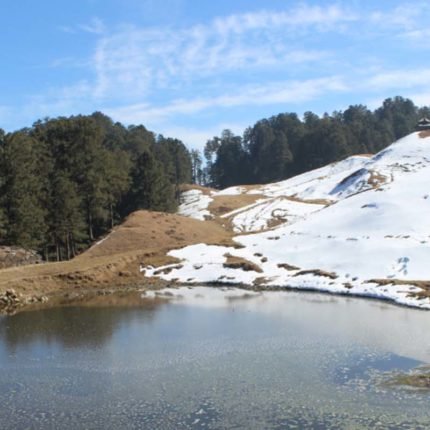
Deoban Trek
“God’s Forest” in the peaceful hills of Chakrata
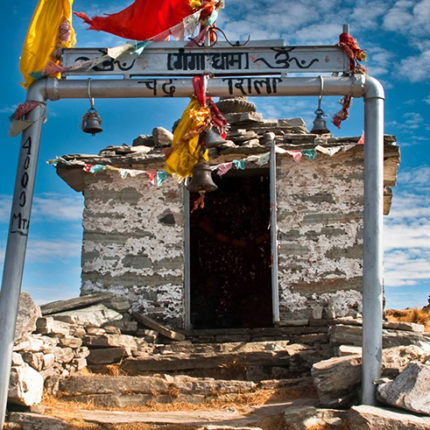
Chopta Chandrashila Trek
Chopta Chandrashila trek is a very beautiful and an Easy trek in the Uttarakhand Himalayas ,
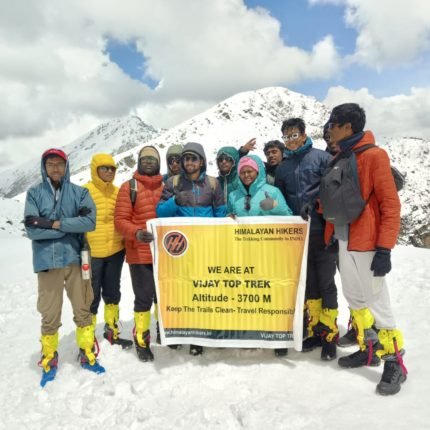
Vijay Top Trek
It’s away from hustle and bustle not known by more people
Price: ₹ 23,000.00
Book the tour
Send a quick enquiry.
- Overview Itinerary Dates Include/Exclude
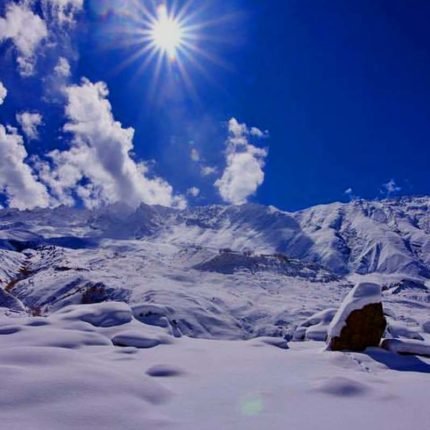

- Treks in Himachal Pradesh
- Treks in Uttarakhand
- Treks in Sikkim
- Treks In Jammu & Kashmir
- Uttarakhand
- Himachal Pradesh

Chadar Trek Guide 2024: Distance, Route, Map, Best Time & Itinerary
Table of Contents
Displaying a surreal backdrop of vibrant colors, the Frozen River Trek popularly known as the Chadar Trek is one of the most challenging and strenuous treks in the Ladakh region of Jammu and Kashmir State in India.
Therefore such a trek is only and only meant for those amateur and experienced trekkers that have one or two trekking experiences and also, wish to experience the ultimate thrill and excitement.

This trek is a winter trail in the Zanskar region of Ladakh . Moreover, the Zanskar region is famous for its stunning scenery and Tibetan-style Buddhist monasteries.
This arduous trek trail on the ice-clogged river under the gleaming blue winter sky passes through numerous beautiful valleys, mountain caves, and frozen waterfalls.
It is also one of the most strenuous treks in the Indian Himalayas as trekkers have to pass through rugged rocks and temperatures may surprisingly dip to minus 10 degrees, a rare climatic condition that can be difficult to acclimate to.
Chadar Trek Images
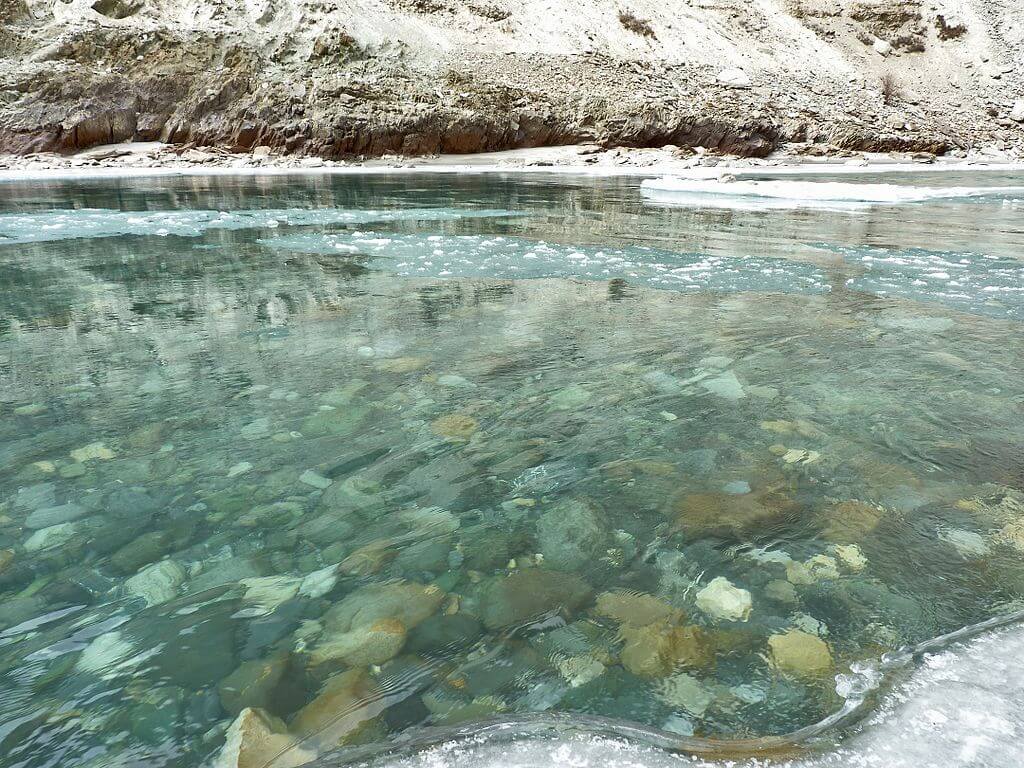
Where is Chadar Trek?
During the winter season, the Zanskar River freezes, giving trekkers a perfect solid platform for trekking. So just imagine, the trail to the Zanskar valley is going to be a challenging yet thrilling experience for the trekkers as the frozen vertical cliffs are 600 m high, and the Zanskar river is about 5 m wide.
Best Time to Visit Chadar Trek
The ideal time to visit the Frozen River Chadar Trek is between mid-January to February as during this time the upper layer of the Zanskar River freezes. The river looks like a sheet of ice; hence, it is referred to in the local language as ‘Chadar’ which means blanket.
Read more: Hidden Hill Stations In India
The winter in Ladakh region is frigid with nature. From January to February the days are relatively warmer but there will be a chill in the air. January is the coldest month in Ladakh. Early mornings, evenings and night times are extremely cold.
Daytime temperatures in Leh, and on the trek, will be between –25°C to 6°C and night-time temperatures can drop to -25°C to – 35°C. There is heavy snowfall in January and February and everything around is covered in pristine white snow.
Chadar Trek Highlights
- Trek along the conventional winter trading route connecting Padum to Ladakh along the frozen Zanskar River.
- This is an arduous adventure with only a couple of groups making the trek every year. The conditions on the river can vary so a flexible approach is required!
- Gain insight into the local culture of Zanskar and you will get a unique opportunity to homestay in the beautiful Zanskari villages along the way.
- Go for a sightseeing tour to explore the architecturally rich Gompas and forts around Leh as you
- let yourself acclimatise to the altitude.
How to Reach Chadar Trek?
Leh Kushok Bakula Rimpochee Airport is the main airport in Leh City. There are quite a number of flights like Air India and Go Air that connect Leh with Delhi and with a few other major cities in India. You can opt for air travel and have a very unique and thrilling experience of flying over the mountains.
Leh is inaccessible via roadways and railways during this time period(winter season).
Read more: Sham Valley Trek Ladakh
Places To Visit Near Chadar Trek (Zanskar Region)
1. Zanskar Valley
An acute and mesmerizing sight, Zanskar Valley is popular for the challenging treks it offers. With the craggy landscape of the surrounding mountains, the snow-covered peaks, the smooth flow of the misty clouds, the breathlessness offered by the isolation, and the flawless glory of nature, the valley is a breathtaking sight. This valley sits in the Zanskar range of the great Himalayan Mountains.
The range, rising to an elevation of about 6000 meters, is home to several exotic flora and fauna species. On the way to the valley, you can witness captivating meadows, gleaming streams, and the Drang-Drung Glacier among other sights.
2. Pensi La Pass
Known for separating the Zanskar valley from the Suru valley, Pensi La Pass is located at 4400 meters above sea level in the Zanskar range of mountains.
Rich with exotic medicinal plants, blue-green water springs and a spectacular view of the circumscribing mountains, this region is the best campsite for trekkers who wish to refresh themselves before resuming their journey. A variety of fauna are also present here including the commonly observed marmots and brown bears .
The Pass is also bounded by glaciers on both sides, from which streams flow into the Suru and Zanskar river, creating an enchanting sight.
But it is accessible only during the months from May to September, and the region is submerged and hazardous due to heavy snowfall observed during the rest of the months.
Named after an ancient Indian Buddhist master called Padmasambhava who was known as the second Buddha, the historically rich town of Padum rests at an altitude of 3669 metres in the Zanskar range.
The most populated town of Zanskar, Padum also serves as the abode of flora and fauna species.
Once the known capital of the ancient Zanskar Kingdom, the region still holds ancient relics like intricate carvings on a large rock situated on the banks of the river Lung-nak, dating back to the 8th century.
The town also consists of two ancient Buddhist monasteries situated on the hilltop. Apart from these attractions, the breathtaking beauty of the surrounding areas from this region is too lovely to be put into words.
Also acting as a trekking base, the landscape comprises of vast grasslands, huge agricultural fields, lush green forests, beautiful streams and the ruggedness of the mountains.
4. Zanskar River
As mentioned above, the Zanskar River trek or the Chadar Trek is a winter trail and is undertaken by some of the bravest souls of the land. One of the largest tributaries of the river Indus, Zanskar River emerges from the north-facing Himalayan slopes.
Further, the Zanskar River bifurcates into the Doda tributary, which begins in close proximity to the Pensi La Pass and flows alongside the Zanskar Valley towards Padum, whereas the Kargyag river tributary forms the second branch emerging from the Shingo La and Tsarap river.
The confluence of these two tributaries forms the Lungnak river which is also called as Lingti or Tsarap river. The entire area of the Zanskar river forms a U-shaped valley owing to the surrounding glaciers.
A captivating sight by day as well as during the night, the river provides an enthralling trek, especially during the winter months at a whopping elevation of 3800 metres making it a must-visit site.
Situated between Kargil and Padum, Rangdum is an elliptically shaped plateau in the Kargil district of the Jammu and Kashmir State. Situated at an elevation of 3657 metres, the plateau lies in the Suru Valley region about 100 kilometres away from the Kargil city.
Surrounded by colourful hills on one side and dazzling white glaciers on the other, the region is an alluring place. The Drang-drung glacier can also be witnessed from this region.
A beautiful region in the north of India, Zanskar is home to such amazing places that you can explore to relish your lovely vacation.
Frozen River Chadar Trek Itinerary
Day 1: Delhi – Leh (Rest for acclimatization)
Take a flight from Delhi to Leh. I would suggest a morning flight. On arrival at Ladakh, take a taxi in order to reach the hotel. Then you can visit the local markets of Leh like the Tibetan market for clothes and the Moti market in the evening. Try to return early from the markets and take proper rest in the hotel.
Day 2: Leh – Shey – Thiksey – Hemis
So, today you will be heading on a sightseeing tour to some important monasteries in the area. You will be visiting Shey Gompa, which was once the summer capital of Ladakhi kings; Thiksey Gompa, which is said to be one of the most beautiful structures in Ladakh and the famous Hemis Monastery belonging to Drukpa Order. Then, you may stay at the guest house in Leh.
Day 3: Leh – Chilling (3200 mts/ 5 hrs drive)
Start the day with a hearty breakfast and then embark on a trip to Pishu Village, through the roads that are bestowed with the sheer charisma of nature. Overnight, stay in the guest house.
Day 4: Chilling – Zaribago (3250 mts / 5 hrs)
Try to wake up by 7 am. I know it is difficult to wake up so early when you are on vacation. Yet, to make your vacation special try to follow some tips. Then get fresh and eat a proper, light, and healthy breakfast. Also remember to carry some biscuits, fruits, water bottles, and napkins along with you.
Begin the first day of the trek to Zaribago, which will take approximately five hours to reach. Overnight, stay in Zaribago.
Day 5: Zaribago – Deepyokma (3300 mts/ 5 hrs)
Today, it is going to be a thrilling yet exciting experience as you will walk on the frozen Zanskar River till you reach Deepyokma. Overnight, stay in the Deepyokma camp.
Day 6: Deepyokma – Nyarakpulu (3400 mts/5-6 hrs)
Today you need to reach Nyarakpulu below the Nyarak village from Deepyokma by trekking for about 5-6 hours. Overnight, stay in the camp.
Day 7: Nyarakpulu – Lingshed (3800 mts/ 4 hrs)
Depart from Nyarakpulu and have an hour’s walk to reach the small village of Lingshed. Relish the local culture and pleasing atmosphere of the private houses equipped with central heating systems.
Day 8: Lingshed (3800 mts)
Get ready for a fun-filled and exciting day of the Frozen River Chadar Trek. Witness the breathtaking landscapes of Lingshed, visit the monasteries and spend time with the natives of Lingshed. Stay in a Lingshed guest house.
Day 9: Lingshed – Nyarakpulu ( 3400 mts/ 5 hrs)
Today you need to trek till Nyarakpulu. Overnight, stay in a Nyarakpulu guest house.
Day 10: Nyarakpulu – Tso Mopoaldar (3200 mts/8 hrs)
Today, get ready for a long walk of around 5 hours from Nyarakpulu to the campsite at Tso Mopoaldar.
Day 11: Tso Mopoaldar – Tilatdo
Post a nutritious breakfast and embark on a trek till Tilatdo. Overnight, stay in Tilatdo.
Day 12: Tilatdo – Chilling – Leh
Return to Chilling. Drive ahead and reach Leh. Overnight, stay at a hotel in Leh.
Day 13: Leh – Delhi
Now your trip is still not got over. You still have to reach your home. So, reach the airport in time to catch the flight to Delhi and also, for those who have come by road, I wish you a safe journey ahead. Do not forget to capture some photos,and shoot videos while driving through the hills, forests, and then the plains.
I know you must be feeling quite tired and also sad at the same time because your trip has now come to an end. But I hope you enjoyed your trip to Frozen River Chadar Trek. Till then, keep on trying new trekking activities. We will meet soon with a new trek!
Frequently Asked Questions About Chadar Trek
When should i book for chadar trek.
You should book this trek two to three months in advance so that you get an ample amount of time to prepare for the trek.
What is the Minimum Age Required for Chadar Trek?
The Chadar trek is a moderate trek with a maximum altitude of 3850 mts/12628 ft, so the minimum age required is 15 years.
What kind of shoes will be Required for Chadar Trek?
Trekking shoes with good ankle support are a must for any trek in the Himalayas. Quechua Forlclaz 500, Hi-Tec Colman, and Salomon are some of the ideal shoes with value for money.
Is it Safe to Drink Water From Streams?
Himalayan stream water is safe to drink as well as for cooking but it is better if you can carry a few chlorine tablets for disinfecting water.
Which Vehicles are Used for Transportation Purposes?
Most of the Himalayan roads towards the trek are rugged, so a vehicle with good ground clearance like Mahindra Bolero, Scorpio, Safari Dicor, Tata Sumo, etc are used for transportation purposes

Is Chadar Trek for Beginners?
What i believe is that yes, chadar treks are for beginners but if they follow your guide instructions properly so there is no harm and the rest of thing is dependent upon yourself.
- Share This Post:
Related Articles
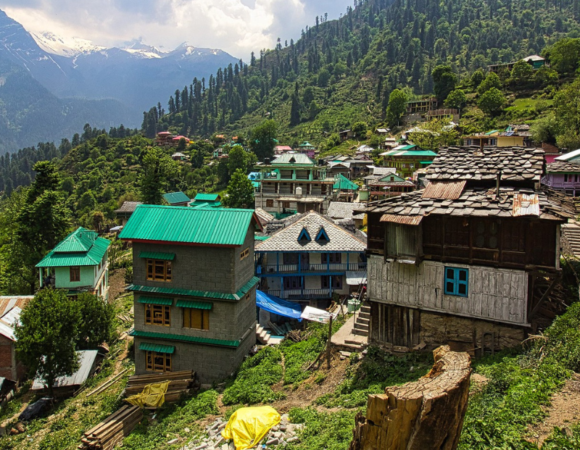
10 Best Hill Station In Himachal Pradesh, Highlights, FAQ’s
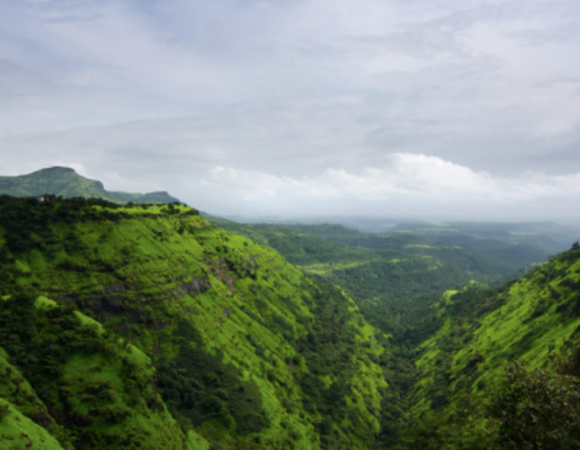
10 Best Hill Stations In Maharashtra, Highlights & FAQ’s
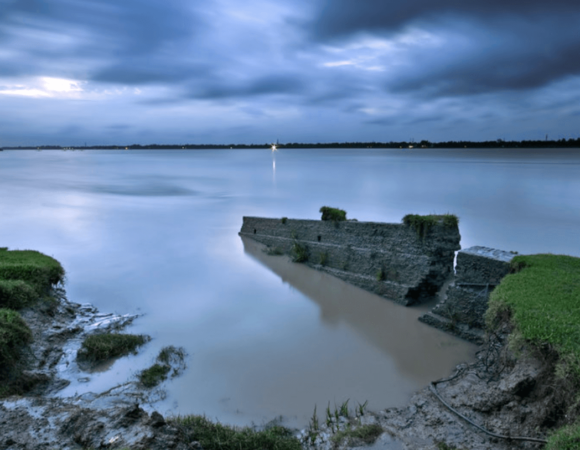
10 Best Hill Stations In West Bengal – Best Time, How to Reach Highlights & FAQs
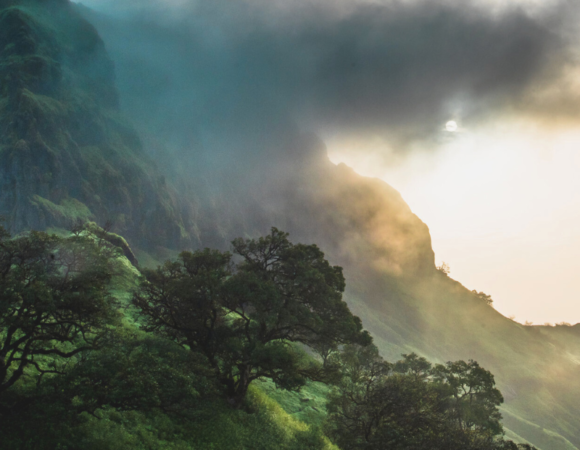
10 Best Maharashtra Trekking Places, Highlights, Treks & FAQ’s
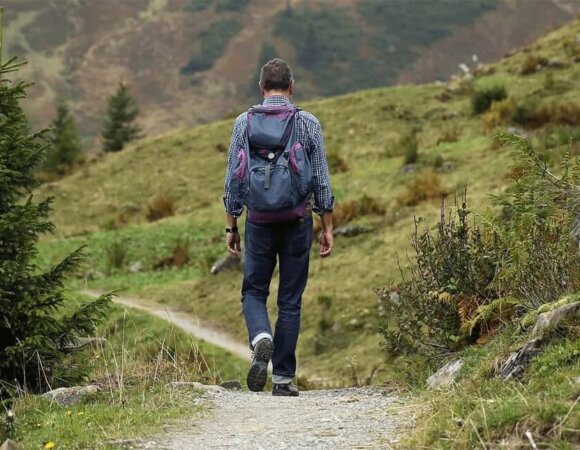
10 Best Trekking Places Near Delhi In 2024 & FAQ’s

10 Best Treks in Himachal That You Can Do in Winters
Add a comment cancel reply.
Save my name, email, and website in this browser for the next time I comment.
Things To Carry On Your Trek
Book your experience with us.
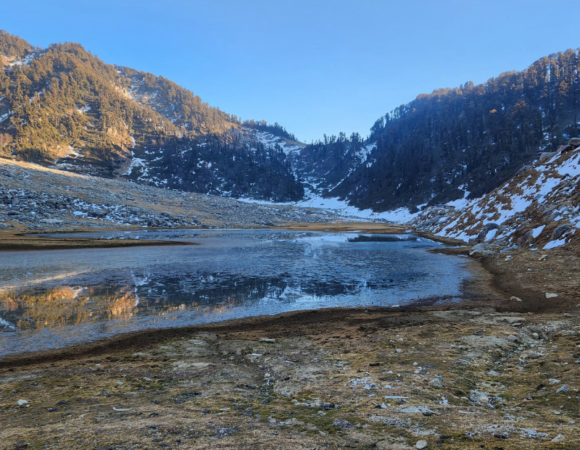
- Amenities 5
Kareri Lake Trek
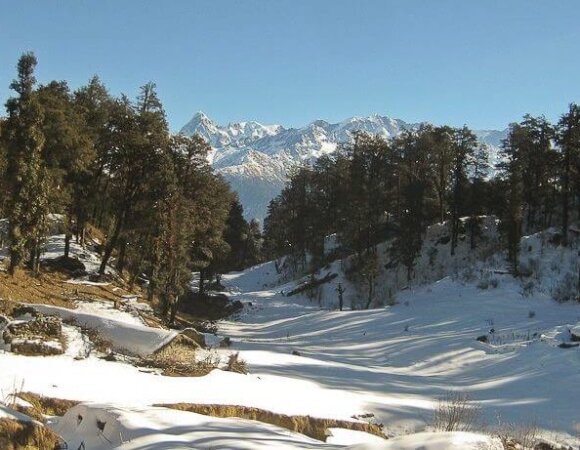
Dayara Bugyal Trek
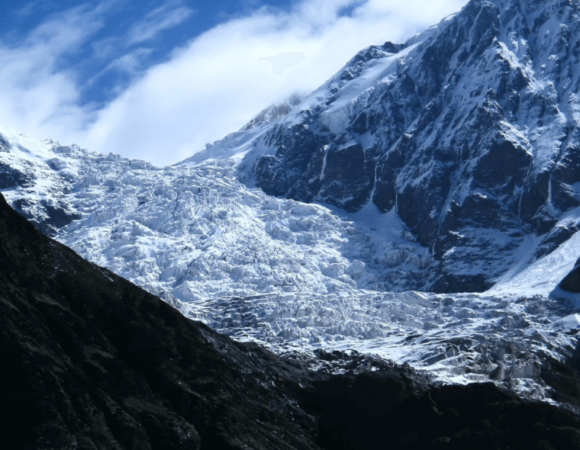
Pindari Glacier Trek

Snowline Trek
Book your unforgettable experience with us, reset password.
WhatsApp Us
- More Networks

Chadar Trek, Ladakh: Everything You Need to Know
Nestled in the stark landscapes of Ladakh , the Chadar Trek is an adventure unlike any other, offering trekkers the unique opportunity to walk on a frozen river amidst towering mountains and surreal icy formations. In this comprehensive guide, we'll delve deep into everything you need to know about embarking on the Chadar Trek, from its route and highlights to essential tips for a successful expedition.
Also Read: 10 Best Trekking Destinations in India for October and November
1. Understanding the Chadar Trek:
The Chadar Trek, also known as the Zanskar Frozen River Trek, is a winter trekking expedition that takes adventurers along the frozen Zanskar River. The trek derives its name from the 'Chadar,' which refers to the thick blanket of ice that forms over the river during the winter months. This iconic trek is not just a test of physical endurance but also an opportunity to witness the raw beauty of Ladakh in its most pristine form.
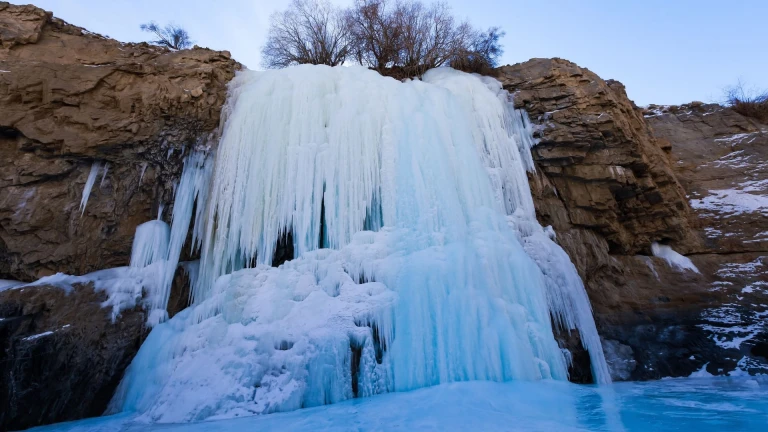
2. Route and Highlights:
The Chadar Trek typically starts from the village of Chilling, located about an hour's drive from Leh, the capital of Ladakh. From here, trekkers embark on a thrilling journey along the frozen river, navigating through narrow gorges, icy cliffs, and surreal ice formations. The trek offers stunning views of the towering Himalayan peaks and allows trekkers to immerse themselves in the remote wilderness of Zanskar Valley.
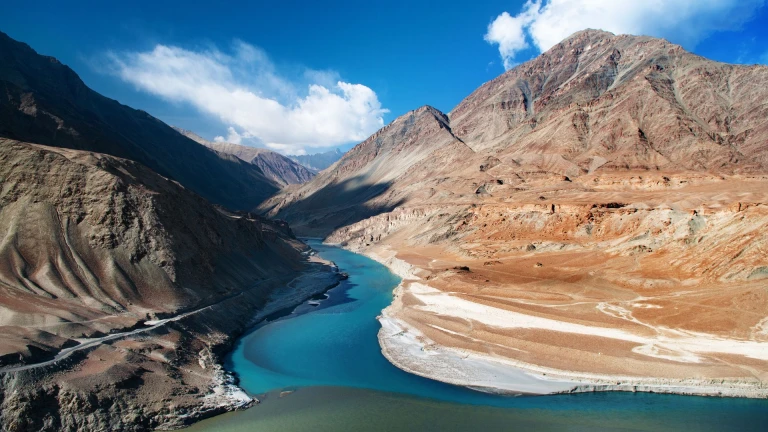
One of the highlights of the Chadar Trek is the opportunity to witness the mesmerizing beauty of the frozen waterfalls along the route. These cascading ice formations, sculpted by nature's hand, create a magical ambiance that leaves trekkers in awe of their surroundings.
3. Best Time to Visit:
The ideal time to undertake the Chadar Trek is during the winter months of January and February when the Zanskar River freezes over, creating a solid ice sheet that is safe for trekking. During this period, temperatures in Ladakh plummet well below freezing, often reaching as low as -30°C (-22°F). However, the harsh conditions are what make this trek so unique and rewarding, offering trekkers a chance to experience the raw beauty of Ladakh in its most extreme form.
4. Difficulty Level and Fitness Requirements:
The Chadar Trek is considered to be one of the most challenging treks in the world, primarily due to the extreme weather conditions and the rugged terrain. Trekkers are required to cover long distances each day, often walking for 6-8 hours on the icy surface of the river. Additionally, the sub-zero temperatures and high altitude can take a toll on the body, making it essential for trekkers to be in excellent physical condition and adequately prepared for the challenges ahead.
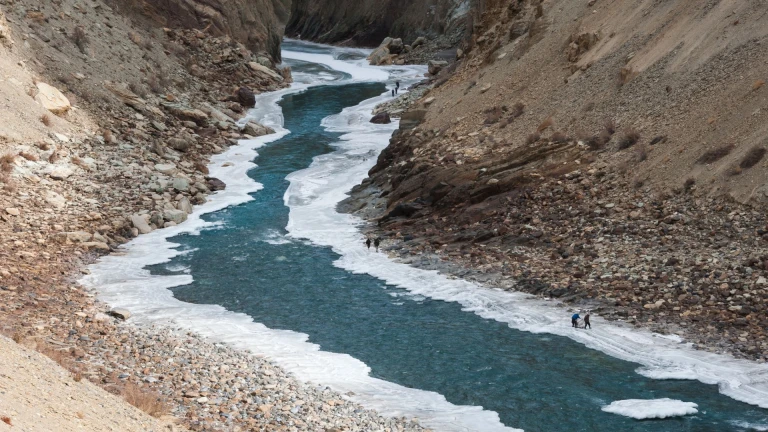
5. Essential Gear and Packing List:
Packing the right gear and equipment is crucial for a safe and comfortable trekking experience on the Chadar Trek. Some of the essential items to carry include:
Insulated, waterproof trekking boots with good grip
Layered clothing including thermal innerwear, fleece jackets, and windproof outer shells
Waterproof pants and gaiters to protect against snow and ice
Insulated sleeping bag suitable for extreme cold temperatures
High-quality down jacket to keep warm during rest breaks
Sunglasses with UV protection to prevent snow blindness
Headlamp or flashlight with extra batteries for night trekking
Personal hygiene essentials including wet wipes, hand sanitizer, and toilet paper
First aid kit with essential medications for altitude sickness, cold, and injuries
It's crucial to pack light while ensuring you have all the necessary items to stay warm and comfortable in the harsh winter conditions of Ladakh.
6. Permits and Regulations:
Before embarking on the Chadar Trek, trekkers need to obtain the required permits from the Ladakh Tourism Department or local authorities. As per the new directives received from the local authorities in Leh, it is mandatory for all participants to undergo a medical examination at Leh and spend 3 nights in Leh before departure for the trek. Also the forest department & ALTOA have made it mandatory to obtain a special permit to trek on the Chaddar. Rs 5000 /- per person has to be paid for the medical checkup & permit individually by each participant at Leh.
Additionally, it's essential to follow Leave No Trace principles and adhere to all regulations to minimize environmental impact and preserve the fragile ecosystem of the Zanskar Valley.
Documents to carry:
A photo ID proof like driving license, voter ID, passport. ID proof would be required at the airport and the hotel. Also, the ID proof would be required to make the permit for the Chadar trek.
4 Passport size photos to make the permit and insurance.
A medical certificate of your fitness for the trek. The medical certificate should be from a recognized doctor.
Indemnity certificate
Covid-19 vaccination certificate
7. Hiring Guides and Porters:
Due to the challenging nature of the Chadar Trek, it's highly recommended to hire experienced local guides and porters who are familiar with the terrain and weather conditions. Experienced guides not only provide valuable insights into the region's culture and history but also ensure safety and navigation through treacherous sections of the route. Porters can help carry heavy equipment and supplies, allowing trekkers to focus on enjoying the journey without the burden of excessive weight.
8. Must Visit or Must Do during the Chadar Trek:
While the entire Chadar Trek is filled with stunning landscapes and unique experiences, there are a few must-visit places and must-do activities that trekkers should not miss:
1. Shingra Koma: Located along the route of the Chadar Trek, Shingra Koma is a picturesque camping site surrounded by towering cliffs and frozen waterfalls. Trekkers can spend the night here, marveling at the star-studded sky and enjoying the warmth of a bonfire amidst the icy wilderness.
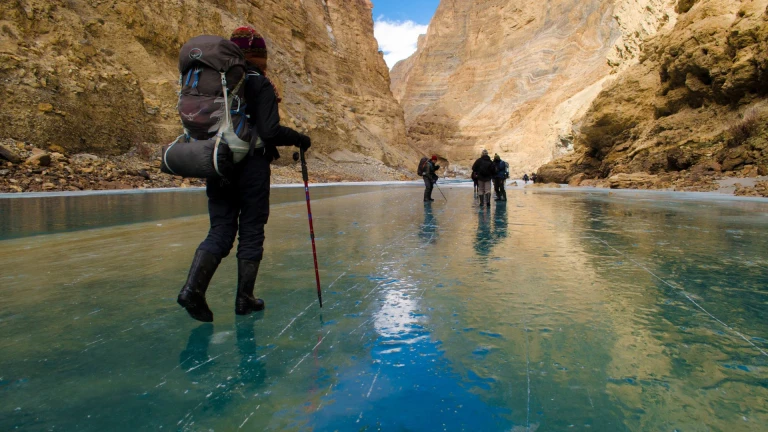
2. Nerak Village and Frozen Waterfall: Nerak Village is a remote settlement nestled in the heart of the Zanskar Valley, accessible only by foot during the winter months. Trekkers can visit the famous Nerak Frozen Waterfall, a towering ice formation that glistens in the sunlight, creating a mesmerizing spectacle against the backdrop of snow-capped mountains.
3. Chadar Formation and Ice Patterns: As trekkers make their way along the frozen river, they'll encounter various formations and patterns created by the natural movement of ice. From intricate icicles hanging from rocky cliffs to smooth, glass-like surfaces stretching as far as the eye can see, the Chadar Trek offers a visual feast of unique ice formations that are a photographer's delight.
4. Cultural Encounters: The Chadar Trek provides opportunities for cultural immersion as trekkers interact with the indigenous people of Zanskar Valley, including the hardy Ladakhi porters and guides. Trekkers can learn about the traditional way of life in this remote region, including age-old customs, rituals, and beliefs passed down through generations.
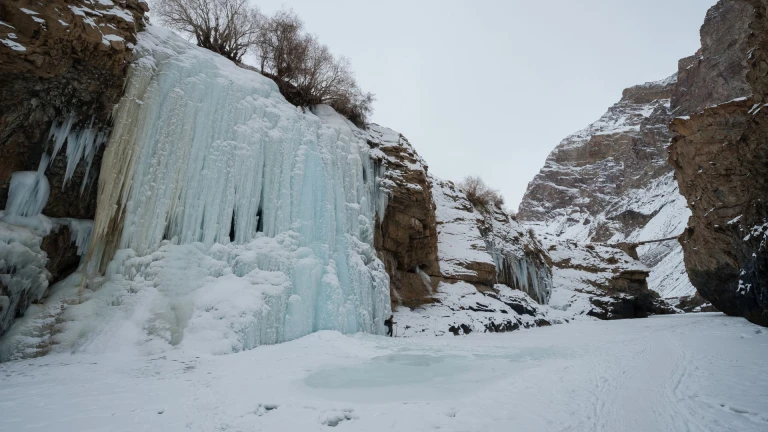
The Chadar Trek is not just a physical journey; it's an expedition into the heart of Ladakh's winter wilderness, where every step is a testament to the resilience of the human spirit and the beauty of nature in its most extreme form. From walking on frozen rivers to camping under starlit skies, the trek offers a once-in-a-lifetime experience that leaves trekkers with memories to cherish for a lifetime. So, gear up, brave the cold, and embark on an unforgettable adventure into the frozen kingdom of Ladakh.
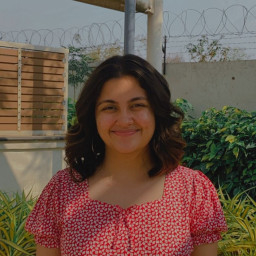
By Manya Shastry
Hampta Pass Trek: Everything You Need to Know
IndiGo Launches Direct Flights to Colombo from Mumbai
Subscribe to TripZilla
Get updated on travel deals and trip ideas!
Related Posts
10 amazing hacks for comfortable train journeys in India
Make your Indian train journey comfortable with these 10 hacks: choose the right class, pack essentials, stay hydrated, wear comfy clothing, charge devices, bring entertainment, prioritize safety, book lower berths, use travel apps, and socialize.
10 Food Items That You Must Try While In Sri Lanka
Embark on a culinary escapade through Sri Lanka's vibrant streets and discover the top 10 mouthwatering dishes that define this island paradise!
10 Hidden Destinations In Northeast India
Immerse yourself in the magic of unexplored landscapes, vibrant cultures, and breathtaking adventures. Ready to redefine your wanderlust?
10 Important Things you should know about South Korea before traveling
Explore the wonders of South Korea with 10 Important Things to Know Before Traveling. This blog unveils cultural insights, from decoding Hangul to navigating bustling streets.
10 Luxury Hotels in Bangalore That Are Too Good To Be True
From regal palaces to eco-chic retreats, join us as we uncover the city's 10 Luxury Hotels that redefine opulence!
Latest Posts
Passenger Stands on Indigo Flight Due to Overbooking
An overbooked IndiGo flight from Mumbai to Varanasi sparks debate on airline policies and passenger rights, raising questions about effective travel management.
10 Luxurious Resorts in Himachal Pradesh for Comfort Lovers
Explore Himachal Pradesh's most opulent resorts!
Heavy rain alert in Kerala: What should tourists be careful of?
Discover important safety tips, health precautions, and flexible travel plans to ensure a safe and enjoyable visit during the monsoon season.
Taj Mahal's Competetion is here? Agra Gets a New White Marvel
A new white marble structure is taking its shape in Agra.
Kodaikanal Tourism Dips Despite 70,000 E-passes Issued
Kodaikanal Tourism Dips Despite 70,000 E-passes Issued, revealing challenges amid a transformative moment for the hill station. Local businesses express concerns over decreased footfall and canceled bookings, highlighting the impact of the e-pass system.
Chadar - The Frozen River Trek
Walk on a Frozen River. Literally! / The ultimate Ice Walking Experience of Ladakh
Available Batches
Brief description.
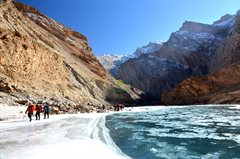
Brief Itinerary
Detailed itinerary.
Arrive in Leh (3,500 M)
The trek starts from Leh, which is a headway into Ladakh that is home to some of the highest peaks in the region. Because the roads are shut, the only way to get to Ladakh in winters is through air. There are flights that fly into Leh through Delhi and this two hour journey is where the magic begins. Try to get a window seat on the plane for the bird’s eye view of the Himalayas is absolutely mesmerizing.
Day one is reserved for you to make your way to Leh and get settled into your accommodation. Since you will be coming to this altitude from sea level, the body will need time to get comfortable with the altitude and the mountain air. Winters in Leh are quite harsh but the cold you experience here is only just the beginning!
Rest and Acclimatization in Leh (3,500M)
Day two is reserved for rest and acclimatization to the altitude, too. This is important to allow your body to adapt to its new environment and reduce chances of adverse health conditions. You can go around and explore the city market, delve into the colors and culture of this high-mountain city and visit some places nearby. A little movement around the city would be good for acclimatization. Also, use this time to go through your checklist and do some last-minute shopping for what you might be missing for the trek. Leh has the best market for trekking essentials.
While the body acclimatizes, we take this time to get together with the group for a debriefing session where we get to know each other better and delve into the happenings of the next few days - schedule, what to expect, basic do's and don'ts in the mountains, how to maintain the sanctity of the environment and other such matters of importance.
Day 3 is also reserved to adapt to the cold winters of Leh. The only other thing on the agenda is a mandatory medical check-up at the Tourist Information Centre which is essential to obtain a NOC from ALTOA and a permit from the Wildlife Department to trek on Chadar.
Leh (3,500M) to Shingra Koma via Bakula (3,215M)
Distance: 70 kms
Duration: 2-3 hours
Today is going to be our first actual day on Chadar – the first day when we trek in this winter wonderland. But not before we drive to Bakula which is the starting point of the trek. We start early in the morning to drive along the beautiful Indus River and past the confluence of Indus and Zanskar rivers at Nimmu. This short 70 km drive which should take close to 3 hours to cover, offers some of the most spectacular views as the vehicle goes around some narrow hairpin bends. As we inch closer to Bakula, we start to see the frozen marvel – Zanskar, waiting in all its glory. Once out of our vehicle and on the Chadar, the trek leaders will give you some quick tips on how to best manage yourself on this sheet of glassy ice. It will take a while to get a hang of it so don’t worry if you don’t get it right, right away – no one does. Walk around as much as you can using the Penguin Walk and you will soon find yourself giving tips to others.
The best thing about Chadar trek is that you walk on a flat surface throughout the trek. There are no steep ascents or descents and very little chance of catching AMS since you don’t gain any altitude throughout the trek. If you are comfortable today, you are already acclimatized and you should be able to finish the entire trek without any major issues.
Depending on the weather, the Chadar changes its forms. It can be hard and glass-like in some patches, or it can have a layer of powder snow on it giving you a better grip, or you could face thin ice in certain areas, so you might have to walk in slush or dodge that entire patch and go over the rocks on the side of the river. Walk together as a team and always follow the sledge route used by the porters as it is the safest route on Chadar.
We should reach the next campsite within 3-4 hours, depending on our speed and will spend our first official night camping on Chadar.
Shingra Koma to Tibb (3,280M)
Distance: 14 kms
Duration: 6-7 hours
The hardest part from here on is getting out of the warm sleeping bag and your cozy tents to step out into the freezing cold. However, the people of Zanskar are known for their hospitality – you will always wake up to a hot cup of tea and a meal waiting for you - all of which makes waking up in subzero temperatures just a little bit easier.
Today is a long day with 14 long kilometers to our next campsite. Since walking on Chadar is not the easiest, this should take anywhere between 6-7 hours to cover. Remember to top up your thermos with warm water – regular water bottles cannot fight the cold of Chadar and the water tends to freeze up. Sunshine in this bend of the land is a scarce commodity as well. You will only see the sun for an hour or two on the trail and that too, in patches since the walking trail is fenced by giant mountains on both sides. Marvel at the views as you walk in this huge valley with nothing but pure crisp air and huge rocks on both sides. The color of the Zanskar river is a vibrant deep blue that matches the blue of the sky on a clear, sunny day. The trail also offers frozen waterfalls all along the way. We stop along the river to cook our meals so that we are not walking empty-bellied. The last 200M to Tibb is stunning. Expect to reach the campsite by late afternoon.
Tibb (3,280M) to Nerak (3,400M)
Distance: 12 kms
Duration: 5-6 hours
At the end of today we get introduced to one of the biggest highlights of Chadar trek, the mother of all waterfalls – Nerak Waterfall. It is going to be another long day, so we begin early and aim to reach the waterfall by late afternoon so that we have all evening to marvel at it. The sun makes an exit from the Zanskar Valley early and the only way to keep warm is to keep moving. The ice in various patches is broken in the middle of the frozen river, forming geometrical structures of various shapes and sizes, which are fascinating to see. The lunch today is peculiar too, inside of a cozy cave, mid-way through our day. The cave is massive and can fit 12-15 people comfortably. Once we make it to the campsite, we feast our bellies to some snacks and make our way to the gigantic Nerak waterfall. It should take us about 30 minutes to get there. Along the way, we might even see a few domestic Yaks grazing the higher grounds. Right next to the waterfalls is a bridge across the river, which takes you up to Nerak village. It’s fascinating to see the old wooden bridge under the new concrete/steel bridge. We spend some time at the Nerak waterfall, before heading back to the campsite for dinner.
Nerak (3,400M) to Tibb (3,280M)
After that thrill of a climax which is Nerak waterfall, we start our journey back to where we came from. Today, we head back to Tibb campsite but nothing on Chadar is ever the same. If you think you know the route back and can predict the challenges for the day, you are in for a surprise. The frozen Zanskar river reacts to the slightest change in temperatures, and constantly keeps changing its form – hence, even though the trail is the same, it is different! Pay close attention to all the changing sounds as you walk on different kinds of surfaces – it is fascinating. Along the way, we see local porters wearing traditional woolen robes called ‘Gonchas’, with colourful beads around their neck and their traditional hats. It’s fascinating to see the locals negotiating the frozen river, as they seem to walk like the wind, absolutely comfortable with the slippery uneven icy surface. They greet you using the local phrase ‘Julley’ which is the Ladakhi term for hello/welcome. You might also catch a few locals singing traditional Ladakhi songs while pulling their sledges and enjoying the journey. We penguin walk our way to Tibb, as the locals zoom past us with such ease.
Tibb (3,280M) to Bakula (3,215M) and drive to Leh (3,500M)
Distance: 12-13 kms
Duration: 7-8 hours
For our last day of the trek, we head back to where we started from – and we’ve come a full circle. To reach Bakula, we should take 7-8 hours. The drive back to Leh should be close to 3 hours from there on. We stay the night at a hotel.
Departure from Leh
The trek ends here. If you plan to stay for a few more days to explore the wonders of Ladakh, the article below might help start you off on what places to consider. Places that you must visit in Leh Ladakh
Like we indicated before, the weather on high-altitude is unpredictable as are many other conditions. We would suggest you keep spare days between the end of the trek and your travel arrangements to head back home.
What's Included
- Camping during the trek on twin sharing basis and hotel stay in- Leh on Day 1, Day 2, Day 3 and Day 8 on twin/triple sharing basis.
- Meals during the trek starting lunch on Day 4 till lunch on Day 8
- Trek equipment includes Dome Tents (twin sharing), Siachen sleeping bags, mattress
- Helmet, Gaiters, Harness & Carabiners as required
- Experienced & mountaineering certified trek Leader with first aid certification.
- Services of Guide, Cook and Support team
- Transport from leh to Road head and return
What's Not Included
- Meals during hotel stay in Leh
- Any expenses incurred on medical examination in Leh
- Gum Boots will not be provided by us. Please carry your own Gum Boots or buy the same in Leh.
- Inner Line Permit Fee
- Any kind of personal expenses
- Any kind of Outdoor Insurance
- Portage of personal luggage
- Anything not specifically mentioned under the head price Includes
- Altoa & Environmental / Wildlife Permit Fee. Approx Charge 6k to 8k to be paid on the spot to the authorities
Are you Eligible for this Adventure?
Climbing up to an altitude of 3,400M, Chadar - The Frozen River Trek is as challenging as it is beautiful. Although it does not involve too much of a gain in altitude, adapting to the extreme temperature which drops to as low as -30 degrees and walking on a frozen river for 9 days is what makes this trek difficult. It is perfect for someone with prior trekking experience looking to level up a notch!
Max Altitude

BRS Level Required
Chadar - The Frozen River Trek is a level 5 adventure on the Bikat Rating Scale.
This makes it mandatory for you to have high-altitude experience of preferably multiple treks marked at level 4 on the BRS. The altitude, the terrain and the nature of the climb demand a certain level of skill and a need for you to be aware of how your body reacts to the various features of a high altitude environment.
If you do not know what level of BRS trek would suit you best, worry not! Fill out this Form:

we will send you a progression chart to help you comfortably get out of your comfort zone in order to level up and ultimately reach your highest potential in the big, bad world of outdoor adventure.
Packing List
This is a list of essential items for individuals doing the trek with Bikat Adventures. This list contains only those items which the participants are required to bring with them. The list excludes those items which are provided by Bikat Adventures on the trek. We have divided the items into five categories. All the items in the list are essential except for those marked as optional.
Trekking Gear
- Ruck sack bag with rain cover. Qty -1
- Day Pack Bag - Recommended for treks with summit day
- Head Torch with spare Batteries. Qty -1
- U V protection sunglasses. Qty -1 Here is how you can choose the best sunglasses for trekking.
- Water Bottles: 2 bottles of 1 liter each
- Non-skid, deep treaded, high-ankle trekking shoes Qty -1
- Pair of light weight Slipper/Sandals Qty -1
- Quick Dry Warm lower or Track Pants. Qty - 2
- Full sleeves T-shirts/ Sweatshirts. 1 for every 2 days of trekking
- Pair of thick woolen socks. 1 pair for every two days of trekking
- Thermal Body warmer Upper & Lower. Qty-1
- Undergarments. Qty - 1 for every day of trekking
- Warm jacket closed at wrist & neck .Qty-1
- Full sleeves sweater. Qty -1
- Rain wear ( Jacket & Pants ) . Qty-1
- Pair of waterproof, warm gloves. Qty-1
- Woolen cap. Qty-1
- Sun shielding Hat. Qty -1
- Personal toiletries kit (Small Towel, Toilet paper, paper soap, Bar soap, toothbrush, toothpaste, cold cream, etc.)
- Sun screen lotion small pack. Qty -1 Here is your Sun Protection 101 to stay safe in the bright sunny outdoors.
- Lip Balm small pack. Qty-1
- Small size, Light weight & Leak proof lunch box. Qty-1
- Plate. Qty- 1
- Spoon.Qty-1
- Tea/Coffee (plastic) Mug.Qty-1
Miscellaneous
- Camera (Optional)
- Carry your medicines in plenty in case you have any specific ailment. Consult your doctor before joining the trek.
- Dry fruits, Nuts, Chocolate bars (Optional)
Frequently Asked Questions
Eligibility, is this adventure good for me, what’s a good fitness benchmark for this adventure, what skills do i need to complete this adventure, what is the minimum and maximum age limit, about the activity, where is it located, what are some of its highlights, what are some of its challenges, what is the best season for this, what is the accommodation type, what is the temperature like here, is it technically challenging, connectivity, how do i reach the starting point, is there cellular network available throughout, where is the nearest atm, if i choose to travel to the base with you, what is the pick-up point, what time is the drop-off on the last day, what are the nearby attractions that i can explore, equipment & gear, what equipment is provided to us, what can i rent from you, where will i receive the rented items, where do i have to return the rented items, what gear do i need to bring, are there local shops to rent/buy equipment, facilities & additional services, can i offload my bag, can i leave any extra luggage i carry at the base of this adventure, what are the meals like, what are the washroom/ toilet facilities like, what should i do if i get my period on this adventure, what are the medical facilities available to me on this adventure, are there any electricity charging points on this adventure, mandatory documents, what documents do i need to carry, do i need insurance for this, do i need a permit for this, certification, do you provide a certificate of completion, when and how will i get the certificate of completion, international travel, will i need a visa, when should i apply for the visa, what kinds of insurance do i need to travel here, what is the specialty of this when compared to other mountain ranges, till which month can i make a booking for this, what is the qualification of the outdoor leader provided to us, how do you choose your outdoor leaders, is it safe for women, what is the ratio of outdoor leader to participants, what do you do in case of an emergency, what are the rescue options on this adventure, how do you choose your equipment, can i attempt this adventure if i have a specific medical condition, sustainability, what kind of camping do you practice on your outdoor adventures, why are you against fixed camping in the outdoors, how do you manage overcrowding on certain trails, what are some things to remember when using a dry toilet, why should i avoid wet wipes in the outdoors, where should i dispose of my sanitary waste if i am on my period, why should i carry my own utensils on an outdoor adventure, booking process, what happens after i make the payment, do you create a whatsapp group of participants before the start date of the activity, do i need to submit a medical certificate, do i need to submit an undertaking form.
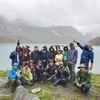
Small Group Size
Our batch sizes are capped at 15 for smaller treks with the trek leader and trekker ratio of 1:8. This ratio, in our years of experience, has proven to deliver the best trekking experience for individuals as well as groups. Capping the size of the group ensures individual attention to each trekker so that no signs of distress or need during the trek go unnoticed. It also helps to form a more cohesive cohort with better group energy which helps define the rhythm and pace of days on the trek. As you go higher up on the BRS scale, since the stakes are higher, expeditions have an even smaller group size with the ratio of expedition leader to climber set at 1:2.
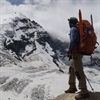
Qualified Trek Leaders
We follow a rigorous regime of hiring and training our experts in the field. Each trek leader is a certified mountaineer with years of experience in the field. In addition to their qualification, they also go through practical and situational training to tackle any and all kinds of sudden conditions that may present themselves on the ground. Being unpredictable is the core nature of the mountains but being ready for any circumstance as best as possible is a controllable asset that we try to nurture. Our field experts are also trained in basic medicine and first-aid response. Watch: Forerunners - The Making of A Trek Leader At Bikat Adventures
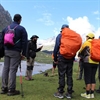
Guided Progression
Since Bikat Adventures is a learning-based organization, we help you climb up the ladder of difficulty within the sphere of outdoor adventure systematically. Our on-ground training modules are designed to handhold you through the upskilling process so that you are ready to take on bigger challenges.
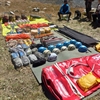
Equipment Quality and Check
All the gear used on our treks and expeditions is tried and tested, maintained for good quality, and is overall top-notch in quality and condition. We are continually looking to obtain the best of everything there is in the market so as to ensure optimum safety.
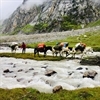
Support Systems
Along with the staff you see on-ground, we have a team of superheroes working in the background to give you the best experience possible. Our background team also comprises local staff from each area who know the region best. Having local support helps with studying the area, pre-planning, execution, and in receiving timely support in case of emergencies in these remote locations.
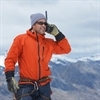
Communication
Our on-field staff is in constant contact with our teams based in primary locations so as to eliminate any avoidable delay in reaching additional help and support when required. We try to use the best tools for communication available, including satellite phones, in regions where they are not restricted.
What our customers Say

Cancellation Policy
Cash refund
Cancellations up to 30 days prior to departure date
5% deduction
Cancellations between 30 days to 15 days prior to departure date
50% deduction
Cancellations within 15 days prior to departure date
Voucher refund
Cancellations up to 5 days prior to departure date
No Deduction
Cancellations within 5 days prior to departure date
- Cash refund is applicable only in case of bookings made without using any promotional offer code or vouchers
- This is only a brief of cancellation terms. For finer details please refer Detailed Cancellation Policy.
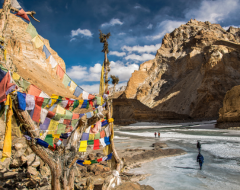
Subscribe for latest updates & offers
Similar adventures.

Sumda Chey Winter Trek
A mystical winter trek where adventure meets culture.
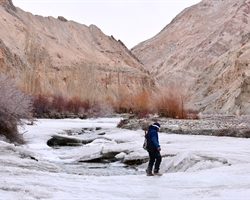
Markha Valley Winter Trek
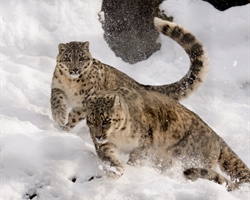
Snow Leopard Trek - Spiti
Trekked by many, discovered by a handful, enter your email, events by categories.

Mountaineering

Scuba Diving
Events by months.
- January July
- February August
- March September
- April October
- May November
- June December
Events By Nights
- 5 & More Night
- Environmental Policy
- Privacy Policy
- Term & Conditions
- Work With Us
- Address: 303, 3rd Floor, Tower B4, Spaze Itech Park, Sector 49. Gurgaon
- Pre Sale - 7838148127 , Post Sale - 8588878499, 9667639126
Bikat Adventures
- Cancellation & Refunds
- Content Sharing
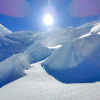
© 2024 Bikat Adventures - All Rights Reserved
Powered by: novel knett software solutions, submit enquiry.

Adventure Pulse
Feel the Pulse of Adventure !!
- High Altitude Treks
- One Day Treks
Everything you need to know about the Chadar Trek/Frozen River Trek
- posted on April 8, 2021 April 26, 2021

The Chadar Trek or the Frozen River Trek is the most popular winter trek in India. A 09-day trek walking on the frozen river of Zanskar and temperatures as low as -30C. Taking place in the beautiful land of Ladakh, the Chadar trek is truly an experience of a lifetime. In winter, as the temperature plummets, a layer of ice develops on the river Zanskar. This layer of ice acts as a highway connecting Leh with the Zaskar Valley and for hundreds of years, Zanskari people have used the ice to travel. The flat ice saved them time as it cuts down the trek up and down the passes. Nowadays, with a road network being constructed, the ice is used as a trek taking people from the village of Chilling to Nerak in the middle of winter.
Winter in Ladakh is truly a mesmerizing spectacle. With light snow covering the arid landscape, Ladakh transforms into a new place where the day starts when the sun is at its zenith. Leh Market becomes the main hangout spot with people relaxing on the benches taking in the sun. The few restaurants that are open act as garlic soup and Timok dispensers.
How cold is it on the Chadar Trek?
Very Simply, extremely cold. The temperature while on the Chadar can plummet as low as -30C. As the river flows at the bottom of the valley the temperature is the lowest there. A slight breeze moving downstream adds to the wind chill as well. Even though you only cover around 50 kilometres, the cold makes the Chadar Trek one of the harder treks on our roster.
While on the trek you’ll have to wear close to 5 layers of clothes and at night, hot water bottles are the only respite from the cold. As you walk during the day, your body heats up (alas just a little) and stopping even for a sip of water seems like a chore. You will be shivering most of the time and everything not near your body will freeze, even cold creams. Devices last a mere 5 minutes in the cold and the act of taking pictures will remind you of the Kodak days.
After all this, you might be wondering as to why we love the Chadar Trek? It’s because we’re crazy, but aren’t we all?

How do you expect to survive the cold?
As mentioned above, the best way to survive the cold is the technique of layering. In short, Layering is several clothing items worn in sequence for protection. While on the trek, your superhero costume is going to comprise of a base layer or thermal, a regular t-shirt, one or two fleece jackets, a down jacket and a windcheater. All this ensure that the precious heat your body produces doesn’t get lost to the air. The clothing acts as an insulator from the cold. Chemical heat/warm packs can be used to keep your extremities warm. If the sun is out, you’re in luck, the temperatures will be relatively warmer (maybe a couple of degrees warmer).
We at Adventure-Pulse provide dual sleeping bags to sleep in at night. These sleeping bags come with an inner liner that fits into a waterproof outer layer. These are similar to the ones used by the army at their High-Altitude outposts. Additionally, our Alpine tents work better at insulating and wind protection as they are made from canvas as opposed to polyester or nylon.
We encourage clients to also carry hot water bags. These rubber bags will be filled with hot water at night and can be strategically placed to keep you warm.
Nibbling on chocolates and dry fruits provided your body with much needed sugar that it instantly converts into heat. We encourage clients to carry sweets and chocolate with the most sugar as it is what will keep you warm.

What’s the itinerary like?
You can find the full itinerary here .
The trek is a total of 9 days and 8 nights in Ladakh. As mandated by the Leh Authorities, as you land in Leh, you’ll be expected to spend 3 nights in Leh before you head off for the Chadar Trek. This is so that your body has enough time to acclimatize to the altitude. The first day is spent in the hotel and maybe a hike to the Leh Market in the evening. Day two is when we’ll hike up to Shanti Stupa and Leh Palace.
On the third day, Adventure-Pulse representatives will escort you for the mandatory medical check-up and insurance purchase. Here the local doctor will check your oxygen saturation, blood pressure and pulse. Only on their approval will you be able to head to the Chadar. Most people meet the requirement as after three days, your body can adjust to the altitude.
After you’ve cleared the medical, the next day is when we’ll head off to the Chadar. You will spend 4 nights on the Chadar, slowly journeying to Nerak and back.

Where will I be staying?
The night on Chadar Trek will be spent in Alpine Canvas Tents on a double sharing basis. The Canvas tents will be lined with 3 layers of foam on which your sleeping bag will be placed. As written above, the sleeping bags will be dual-layered with a polyester fill. There are specific camping sites on the bank of the river, which the Leh District Administration has designated. These locations historically were used by Zanskari Traders as they have caves that protected them against the elements. These caves are still used by some of the porters and can be explored when you reach the campsite.
In Leh, you will spend 4 nights in a comfortable hotel near Leh market. The hotel will be fully heated and equipped with a water supply. We encourage our guests to use minimal water as Ladakh is a cold dessert.
What will I be carrying while on the trek?
For a list of items to carry on the trek, we would recommend going through this list .
While trekking, your personal bags with most of your items will be loaded on sledges in the morning. You will be able to access this bag only once we reach the next campsite. Most of the clothes and stuff that you don’t need while trekking should be packed into this main bag. A good duffel bag (80-100 litres) or a rucksack (50-70 litres) can be used as your ‘main’ bag. If you have some clothes or miscellaneous items that you do not wish to take on the trek, they can be left at the hotel and we’ll ensure you get them at the end of the trek.
On your back, you’ll have to carry a small daypack (15-20 litres) with water and your packed lunch. This will act as your ‘secondary’ bag. You will need to carry your daypack and we would recommend keeping it as light as possible.
What kind of food will be provided on the trek?
On the trek, our staff will be carrying a kitchen tent with all the ration. They will accompany you for the entire duration of the trek.
As you wake up in the morning, you will be provided with hot coffee or tea with some biscuits. It is important to stay hydrated in the mountains and the best way to consume liquids is in the form of hot beverages. Tea and Coffee will also be available for breakfast and in the evenings.
For Breakfast, you can expect parathas, bread and jam, poha, oats and noodles. We will try our best to provide an assortment of food and avoid repetition. Hot lunch will be provided at a predestined rest stop.
The Dinner Menu will include items such as fried rice, Hakka noodles, biryani, Dal-Roti-Sabji-Rice among others. We will also provide soup and dessert before each supper.
What is the strength of the support staff on the Chadar Trek?
Each group will have a lead guide and numerous assistant guides (depending on the strength of the group). The guide’s responsibility is to keep you safe. They will make sure that the group is following the right route and at the right pace. They will also be your Single Point of Contact with the staff. The guide will be from the area and will also have access to the necessary paperwork. In the case of an emergency, they will also organize the necessary evacuations. The assistant guide will assist the guide and will either walk behind the group and/or in the centre. They will make sure that no person will be trekking alone and that the group does not spread out too thin.
If you wish, we can also hire a dedicated assistant guide who will walk with you the entire time. They will make sure that you follow the right pace and will be able to check on you on a more personal basis.
Along with the guides, you will also be accompanied by a Cook, who will cook all the meals. If it’s a large group, there will also be a kitchen helper/s.

How do I get to Leh?
The easiest and only way into Ladakh in winter is to fly. There are daily flights from New Delhi and Mumbai to Leh. We would recommend booking a seat on the right of the aircraft while landing into Leh. Flying over the snow-capped mountains is the perfect way to start the trek of a lifetime.
How do I Prepare for the Chadar Trek?
Like most treks, a certain level of fitness is required. For a sample fitness plan, you can refer to our plan here . If you are a fit individual, dedicated training for 15-20 days should be more than enough. You can contact us at [email protected] and we’ll be happy to help you draft a fitness plan for your needs. A large portion of trekking is the mental fortitude and your ability to push yourself regardless of your physical fitness.
Share this:
« mountaineering courses and institutes in india: a definitive guide., everything you need to know about the markha valley trek in ladakh ».
Suchit Bawa
A keen Mountaineer and Rock Climber. Graduate from Symbiosis Centre for Management Studies, Pune and have completed both Advance and basic Mountaineering courses from HMI, Darjeeling.
Leave A Comment Cancel reply
Post Comment
Quick Links
- Registration Form
- Upcoming Events
- Our Everest Story
- Media Coverage
WANT TO SHARE YOUR TREKKING EXPERIENCE?
We at Adventure Pulse love to hear your trekking stories, especially the outrageous ones. If you have a trekking story, send it to us at [email protected] as a blog or photo blog and we’ll be happy to publish it on our website. HAPPY TREKKING!
India's Highly Recommended Trekking Company
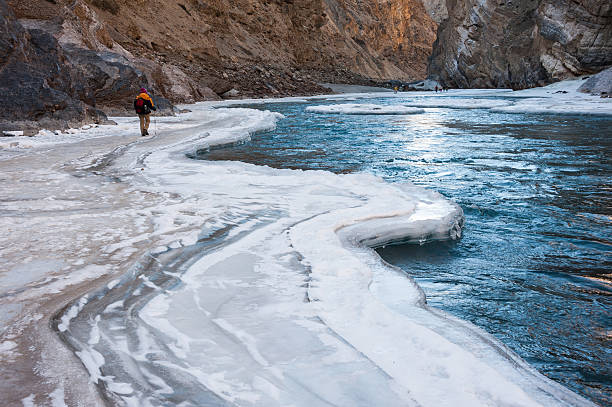
Chadar Trek (Frozen River)
₹35,000 (flat 40% off), ₹ 21,000, (leh hotel to leh hotel), service tax @ 5% (gst), + single tent occupancy: ₹ 2,000, + backpack offloading: ₹ 5,000, batch availability.
- Overview & Itinerary
Chadar Trek in Ladakh is a unique experience, unlike any other trek in the Himalayas. Walking on a frozen river with towering mountains on either side is simply breathtaking. The trek, situated at an altitude of 11,150 feet, feels like a journey to the North Pole with temperatures dropping to -30 degrees. It's an experience of a lifetime that shouldn't be missed by any hiking enthusiast.
The Chadar Trek is an exciting winter trek on the frozen Zanskar River, with sightings of blue sheep, snow leopards, and ibex adding to the adventure. This expedition is one of the most breathtaking experiences on Earth, as you trek across the ice and snow and revel in the beauty of the frozen surroundings. The rewards of this trek are truly unforgettable, and the chance to discover the natural wonders of the Himalayas is something that cannot be missed.
The Chadar Trek in the Leh region of Ladakh is a popular winter trek and one of the longest in the Indian Himalayan region, covering 62 km in 9 days. It is a dream for many trekkers, as it offers magnificent scenery and challenges, such as walking on a frozen river. The trek is a test of endurance and perseverance in extreme weather conditions, but the sense of achievement and the natural beauty of the region make it all worthwhile.
The Chadar Trek offers more than just walking on ice over the Zanskar River, it also attracts adventure seekers with its unique and breathtaking sights along the way. The trek begins at the Magnetic Hill and takes you through fascinating frozen waterfalls, towering cliffs, and stunning landscapes. The experience is truly out-of-this-world, making it a must-try for those seeking an unforgettable adventure.
Best Time to Visit: The optimal time for the Chadar Trek is from mid-January to mid-February as the Zanskar River freezes, and trekkers can traverse unbroken rivers of ice. This period offers a captivating landscape, and the experience will become a cherished memory.
Trek Itinerary
Arriving at Leh airport is a breathtaking experience, with stunning views of snow-capped peaks just before touchdown. Known for its picturesque setting, be sure to keep warm clothes handy as the chilly climate may surprise you. The airport's location in the valley adds to its charm and offers visitors a unique perspective on the surrounding landscape. Don't forget to take in the stunning scenery before heading off to explore the rest of what Leh has to offer.
- Keep your woolen cap and gloves handy at the Airport.
- Airport pickup is not included in the cost.
- Orientation Briefing of the trek at 12:00 noon (Mandatory)
- Check-in Hotel (10:00 am | centrally heated room | attached washroom in running condition | hot water in buckets.
- Bring a copy of your ID proof and 2 photographs. Foreigner, a copy of passport and visa.
- Keep the boarding pass with you, it will be needed for permission on the third day.
- The network is available (only post-paid).
- ATM is available.
- Visiting any very high-altitude place or pass is not advisable.
- Consumption of alcohol and smoking is strictly prohibited.
- Spend the day in the room itself to acclimatize.
New regulations for the Chadar Trek require trekkers to spend at least two days in Leh to acclimate to the weather conditions and prevent altitude sickness. This health problem, commonly known as AMS, has become a concern and should be taken seriously. Strict adherence to this rule is essential to ensure trekkers' safety while enjoying the beauty of the Chadar Trek.
- Rest + Acclimatisation day.
- Sightseeing is included in the cost (Hall of Fame, Shey Monastery, Thiksey Monastery).
- Visit any very high altitude place or pass is not advisable.
- Stay in Hotel | centrally heated room |attached washroom in running condition | hot water in buckets.
Today is a crucial day as it determines the next steps. It's advised to wake up early and head to the Medical Camp promptly to avoid any delay due to the tourist crowd. The tests, though quick, might take longer than anticipated. The afternoon is reserved for finishing any insurance formalities required. This day's outcome will have a significant impact on what's to come, so make sure to be punctual and prepared.
- Wake up early and get ready for medical tests | height & weight, blood pressure, and oxygen level.
- Drive/Walk to the Government Medical camp.
- Get your Oxygen and BP reading (There is a long queue due to the rush of tourists. It may take 3-4 hours depending on the rush).
- Late afternoon insurance formalities.
- Enjoy the evening in Leh.
Today, you will journey towards the first campsite at Tsomo Paldar via Chilling and Shingra Koma. Shingra Koma is a distinctive spot in Chadar, located at a U bend in Zanskar. It offers breathtaking views and is sure to be a highlight of your trip. This will be a highly picturesque drive, allowing you to take in plenty of stunning landscapes along the way.
Walking on the thin layer of Chadar in this region can be challenging, especially with gumboots on. However, the sight of various rock formations along the way provides a mesmerizing view. Identifying the fragile and steady ice surfaces may take time, but with patience, it can be accomplished. Gradually, walkers can understand the ice patterns and know which surface is safe to walk on.
- Breakfast at the hotel included in the cost
- Drive: Shingra Koma 75 km, 3-4 hrs
- Gumboots are mandatory
- Carry two thermos flasks of 1 liter each
- Hot lunch on the way
- Stay in tents | triple sharing
- Drive through Gurudwara Pathar Sahib (3,500 m / 11,500 ft), Magnetic Hill (3,350 m / 11,000 ft), and the confluence of the Zanskar and Indus (3,100 m / 10,200 ft)
Note: When walking in gumboots, expect to slip and fall occasionally. To protect your back during falls, consider bringing a small backpack. Additionally, be prepared for a slower pace than normal.
Chadar trek gradually gains altitude from Tsomo Paldar to Tibb Cave, taking around 6-7 hours to cover a distance of 400 ft. With a starting altitude of 11,400 ft and reaching 11,800 ft, the trek is unique as it does not involve quick successions of altitude gain. Trekker spends a chilly night in the tent at Tsomo Paldar before embarking on the trek. There are frozen waterfalls in the Zanskar region whose origins are unknown, leading to many myths among locals. A hike through this region will allow you to follow the powerful Zanskar River and enjoy its calming emerald-green waters. A midday break for lunch is provided at Tibb Cave.
- Make sure you fill your thermos with warm water before you leave
- Pass through a waterfall that never freezes
- It will be sunny only around 9-10 in the morning
- Hot Lunch on the way
- Visit a small cave, in that cave the local porters rest for the night
The 13 km long trail towards the Nerak campsite is the most anticipated part of the Chadar trek. It leads to the most iconic landmark of the trek- the frozen waterfall, which is a masterpiece of nature and a favorite of trekkers worldwide. The trek will offer a hot lunch break before reaching Nerak. The Nerak will be the coldest campsite on the trek, with temperatures dropping to as low as -30°C at night. It is crucial to layer up with appropriate clothing to withstand the bitter cold. However, if you make it to the waterfall on time, there may be an opportunity for something special.
- Attraction Frozen waterfall
- Nerak is the first village in the Zanskar region
- If we reach Nerak Camp on time, we can go to Nerak village
- Stay in tent | triple sharing
The Chadar trek is notorious for its unpredictable weather patterns, with instances of the ice formations disappearing on the way back from Nerak. Nevertheless, new layers of Chadar may form during the journey. Regardless of the route, the terrain remains challenging and exciting for trekkers willing to explore this unique experience. The trek requires careful attention to the weather conditions and suitable gear for the sub-zero temperatures. Despite the hardships, the trek is a fulfilling and memorable adventure with stunning natural beauty and cultural significance. Chadar Trek is a must-do for any trekking enthusiast. Eight days of walking on a frozen river in the Himalayas will be an unforgettable experience that will leave a lasting impression. These will be some of the best days of your life, and the memories will stay with you forever.
Take the return route to Tibb Cave for one last trip down memory lane. Take in the sights and bid farewell to the locals en route. Savor your final stay in the tents, but be cautious as you do so.
Wake up early to begin a long walk back, but don't think of it as simply retracing steps. Many things could have changed along the way, such as the melting and thinning of the Chadar or the beauty of visible rocks. This is the beauty of the Chadar trek and nature itself. Finally, reach Shingra Koma and prepare yourself for the journey ahead.
- Drive to Leh 70 km, 3-4 hours
- You will reach Leh by the evening
- Stay in a hotel (Centrally heated room) (Running hot water in taps)
After completing your trek in Ladakh, there are plenty of other sights and experiences to enjoy. You could explore the historic Leh Palace, visit the Shanti Stupa for stunning views of the city, or head to Pangong Lake for a peaceful retreat. Additionally, make sure to try delicious local food and immerse yourself in the unique culture of the region. With so much to see and do, your stay in Ladakh is sure to be unforgettable.
The cab will be arranged at an additional cost from Trekkaro Leh Hotel to Leh Airport. (Check-out time: 10:00 AM)
How to reach
The best way to reach Leh is by taking a flight to Kushok Bakula Rimpochi Airport, which is located just 4 km away from the main city. The airport is well connected to Delhi and other major cities in India and also receives flights from Srinagar, Jammu, Chandigarh, and Mumbai. International travelers can also reach Leh via this airport.
Upon arrival at Leh airport, Trekkaro will take responsibility for all your further travel arrangements. Whether you need help booking transportation to your next destination or planning your next outdoor adventure, our team will be there to provide expert guidance and exceptional service. You can sit back and relax, secure in the knowledge that Trekkaro has everything covered. With our local knowledge and vast network of trustworthy partners, we'll make sure your journey is seamless and stress-free from start to finish.
There is no direct or indirect train to Leh.
Due to heavy snowfalls in Ladakh, the Manali-Leh Highway and Srinagar-Leh Highway are not accessible during winter, prohibiting travel by both road routes.
The Manali-Leh and Srinagar-Leh highways usually close by October or November due to heavy snowfall in the region. These highways connect various remote areas in the Northern region of India, including Leh-Ladakh. The closure of these highways leads to a complete cut-off of Leh from the rest of India during the winter season.
Things to carry
- Basic Gears
- Accessories
- Mandatory Documents
• Backpack & Rain Cover (40-60 Litres)
• Trekking Shoes
• Gum Boots
• Trekking Pole
• LED Torch/Headlamp
• Two Water Bottle (one liter each)
• Basic Medications (or prescribed if any)
• Trekking Jacket
• Three (Five in winter) Warm Layers
• Two trek pants (one Wear and one carry)
• Two collared t-shirts
• Thermals
• Sunglasses
• Sunscreen Lotion (SPF 50/70)
• Lip Balm (SPF 30)
• Sun cap
• Synthetic hand gloves
• Two pairs of Socks
• Raincoat/Ponchos
• Daypack (20 liters), if you opt to offload your backpack
• Toiletries
• Cutlery & Lunch Box
• Plastic cover (for wet clothes)
• Original and photocopy of government photo identity card- (Passport, Aadhaar Card, Driving license, or voter ID)
• Passport size 2 photographs
Terms & Conditions
1. Accommodation : (as per itinerary)
- Guest house (centrally heated room)(attached washroom) in Leh on Day 1, Day 2, Day 3 & Day 8 (twin sharing basis, triple in very rare cases).
- Camping during the trek (Day 4 to Day 7)
2. Meals : Day 4 Breakfast to Day 8 Lunch (Veg + Egg)
3. Transportation : (as per the itinerary)
- Leh (Guest house) to trekking point (Day 4)
- Trekking point to Leh (guest house) (Day 8)
4. Leaders & Guides : Trek leaders are assisted by certified and experienced local guides.
5. Trekking Equipment : High-quality tents, sleeping bags, ice axes, ropes, micro spikes, gaiters, etc. as required.
6. Safety Equipment : First aid, medical kit, oxygen cylinders, stretchers, etc. will be available at all the campsites to deal with emergencies.
7. Hot Water :
- Hot water: Hot water in buckets on Day 1, Day 2, Day 3
- Running hot water in taps on Day 8
8. Leh Sightseeing is included in the cost (Hall of Fame, Shey Monastery, Thiksey Monastery).
9. Facility of keeping extra luggage at Leh when leaving for the trek
1. Food in Leh.
2. Any kind of personal expenses.
3. Porter to carry personal luggage.
4. Pre Medical Check-up and Rescue fees, Wildlife/environmental charges, ALTOA NOC, and entry fees up to Rs. 6,000 to Rs. 8,000 will be paid to the authority on the spot.
5. Pick up and drop from Leh airport.
6. Any kind of emergency evacuation charge, hospitalization fee, etc.
7. Any additional cost due to the final decision incurred by the Administrative.
8. Insurance: It is mandatory to take high altitude risk insurance before joining this Expedition (as per the ALTOA guidelines).
9. Anything not specifically mentioned under the head.
Cancellation Policy
Cancellation requests are not taken over the phone.
In case you wish to cancel your trek please e-mail us at [email protected]
1- Cancellations up to 21 days prior to departure date - 70% refund
2- Between 21 days to 14 days prior to departure - 50% refund
3- Between 14 days to 10 days prior to departure- 30% refund
4- Less than 10 days of departure – No refund or you can transfer your trek (same batch date & same trek) to your dear one OR apply for TREKCASH Voucher 1 0 days before your trek date which comes with 2-year validity.
a) Change of trek batch date is dependent on the availability of seats in the batch.
b) In case of transferring a trek to your dear one, he/she should satisfy all the mandatory requirements laid down by Trekkaro.
c) Trekkaro holds the right to change/cancel the policies, without prior notice.
Refund Policy The applicable refund amount will be processed within 10 working days. If we have to cancel/suspend your trek before the date of departure or at the last moment due to a natural calamity/unforeseen circumstances (like rains, earthquake, landslides, strike, curfew, etc.), then you will get the TrekCash Voucher of the total fee you have paid to us and you can redeem it within 2 year on any trek but where this is of a higher price, you will be expected to pay the difference. The TrekCash voucher will be generated within 10 working days and sent to your email address by us.
Note: In the instance of exchanging a TrekCash Voucher for your dear one, he/she ought to fulfill all the obligatory necessities set around Trekkaro.
Trekkaro team will specifically ensure your safety with...
1. Daily oxygen saturation & pulse reading (if required in trek) :- We go on treks that feature a different lifestyle to the one we typically lead. Everyday living generally overlooks healthy habits, yet when it comes to trekking and surviving in an unfamiliar environment for more than a day, our bodies must adapt. Oxygen saturation measures the ratio of oxygen-saturated hemoglobin to total hemoglobin in the bloodstream. To ensure everyone remains in good health, our team will carry out oxygen saturation and pulse readings before we set off. It is important that everyone is conscious of their well-being.
2. Oxygen cylinders and medical kit :- During high-altitude treks, the body does not get enough oxygen. It isn't always that you cannot survive high-altitude treks, but to be safe, we are always prepared with oxygen cylinders in case you are not accustomed to the environment. On the trek, one of our team members carries an oxygen cylinder and all the essential medicines.
To prevent high altitude conditions - Exercise, cycle, and swim more to prevent high altitude conditions. The more you practice, the easier it will be.
3. Stretchers on every campsite :- Even though we are physically and mentally prepared for the environment, accidents or uncertain situations still happen. In those cases, we have stretchers at each campsite, so in case of emergency, porters will drop you safely to base camp where we can do further treatment.
4. High-Quality Trek Equipment :- You can survive in extreme cold with Trekkaro's quality tents and sleeping bags. Our sleeping bags can hold cold up to -5 to -20 degrees Celsius. Tents are always warmer, so Trekkaro can provide you with quality shelter.
In spite of the fact that we are prepared for the storm, you should let us know if anything concerns you regarding safety.
5. Radio (for communication between camps and guides) :- Our camps are a bit far from each other. But they connect through radio, although there is a problem with the network in the hills. If you miss anything, if the weather is bad, or if we require medical help from the base, we can still communicate via radio.
6. Technical team on all snowy slopes All treks come with an adventure. However, safety is an important aspect of all treks. We ensure the turn with our technical team whenever we find risky slopes or areas. We already mentioned that our team is well-trained and knows how to handle hassles in emergencies.
Expectations
When you take an adventurous trek with us, then be assured that whatever we do is more than your expectations. In fact, our wish to excel goes beyond the point where your boots hit the trail – it begins the moment that you get in contact with us, and it never ends. There is nothing more satisfying than hearing from our trekkers that they’ve just had “another trip of a lifetime with Trekkaro ”.
Your Expectations
• Safety, of course, is non-negotiable. Safety is embedded in our business and it’s something that we take very seriously in all our treks. It's the primary reason we're very popular in just a year.
• Personalized Service, Care, and Attention to Detail For some organizations, this is, surprisingly, negotiable. But it isn’t for us. After safety, if we can do one thing right, every time, it’s to ensure that we sweat the small things.
• The Best Guides If you are already trekking with us, then you’d be forgiven for thinking our guides are superhuman. It doesn’t mean a feat to entertain, cook, guide, and facilitate, but our guides, handle it with grace, and all the while the attention is on you.
• The Best Itineraries It takes a lot of refinement to make a perfect trek, from dawn to dusk there are a lot of moving parts and the potential for things to go awry. For the last year, we’ve balanced on the tightrope of offering the right amount of activity, flexibility, and trek time. Whilst utilizing the best lodgings in the most unique places.
• Value We’re not in the business of making money and providing you with nothing. Our treks aren’t expensive, they represent excellent value for money, and for those seeking to maximize their time, there is no better way.
Our Expectations
It may come as a surprise, but the reality is that it is a two-way street (or trail), and you are ultimately responsible for the nature of the experience that you have with us. And not only that, but you also have an influence on the experience of others in your small group.
• Attitude This is your vacation, and the attitude that you bring will set the tone for your experience. We get that at times it’s difficult (we plan to challenge you) and we get that at times it’s a bit uncomfortable (this is not a cruise trip). All we ask you to keep an open mind, a big smile on your face, and readiness for the unexpected.
• Physical preparedness Our treks are designed for everyday people. You definitely don’t have to be an athlete, but to be fair to yourself and your group members, you do need to be ready. Worried about it? Do not stress it, our team is 100% dedicated to helping you pick the right trek, bring the right gear, and be physically and mentally prepared.
• Know who’s in charge As we’ve mentioned, you rightly expect when you join our trek to be in good, safe hands. For us to ensure the entire group’s safety, we suppose you, as our guest, to listen to your lead guide. They are the expert when it comes to decisions made on the trek.
How To Reach
Things to carry, brief description, gallery of this trek, people reviews, short itinerary.
The cab will be arranged at an additional cost from Leh Airport to Trekkaro Leh Hotel.
ATM point and Mobile connectivity
Leh has the last ATM point before you start your trek if you need to withdraw money. Leh is the last place before starting your trek where you’re likely to get a stable mobile signal (only Postpaid). Finish all your important phone calls here and inform anxious family members about limited phone connectivity.
Why trekkaro?
We’ve been the leaders in providing Free Trekking Gear (FTG) on treks for more than 5 years. How’d we get here? By redefining the way, everyone must trek. Check out how we’re creating the future of trekking around the globe.

Trekkaro is the world's only free trekking gear company, providing high-quality gear from the Decathlon brand to trekkers at no cost. Say goodbye to the hassle and expense of buying or renting gear for your next trek. Trekkaro offers everything from trek shoes to jackets rated for temperatures as low as -10 degrees, as well as poles, gaiters, and microspikes. Join Trekkaro today and experience the freedom of trekking without the burden of expensive gear.

Trekkaro offers free cancellation policies for all trekkers. If you need to cancel your trek for any reason, we provide a TrekCash Voucher that is equal to 100% of the amount you paid. This voucher has a 2-year validity, so you can use it towards any future trekking adventure with us. We want to make sure that our trekkers have the flexibility they need to plan their trips with confidence.

Trekkaro is the best trekking company in India, according to its impressive 4.9/5 rating on Facebook and 4.8/5 rating on Google. Customers rave about their experiences with Trekkaro, leaving glowing reviews and recommending the company to others. With such high ratings, it's clear that Trekkaro is a top choice for anyone looking to explore the beautiful landscapes of India through trekking.

We always help keep you safe from the moment you book to the moment you (reluctantly) head home.

No matter the trek difficulty, our treks balance well-planned itineraries with the flexibility to do your own thing and make the experience your own.

When you trek with us, you experience first-hand our commitment to making the trek a force for good in everything we do.
🗓 Best Time To Visit: January to February
⏰ Open Hours: N/A
🏞 Things To Do: Trekking, Photography, Camping, Nature Walks
💰 Budget: INR 15,000 - 25,000 per person
🧳 Traveller Types: Adventure Seekers, Nature Lovers, Photographers
🔍 Known For: Unique frozen river trek, Beautiful landscapes, Leh Palace, Zanskar River
📍 Distances: Leh Airport - 9 km, Srinagar Railway Station - 421 km, Leh Town - 5 km
🥾 Trek Difficulty: Moderate to Difficult
🧣 Essential Gears: Thermal Clothes, Trekking Shoes, Trekking Pole, Sunglasses, Sunscreen, Medicines
📜 Permit: Mandatory Ladakh Autonomous Hill Development Council (LAHDC) permit
🔺 Altitude: 3,850 meters
Chadar Trek: A Complete Guide to the Frozen River Trek in Ladakh
Have you ever dreamed of walking on a frozen river, surrounded by snow-capped mountains and stunning scenery? If yes, then you should definitely try the chadar trek, one of the most unique and adventurous treks in the world. The chadar trek is a winter trek that takes you along the frozen Zanskar river in Ladakh, a region in the northern part of India. The chadar trek is not for the faint-hearted, as it involves braving the extreme cold, the slippery ice, the unpredictable weather, and the remote wilderness. But if you are up for the challenge, the chadar trek will reward you with an unforgettable experience, a sense of achievement, and a glimpse into the culture and lifestyle of the local people who have been using this route for centuries.
In this article, we will tell you everything you need to know about the chadar trek, from what it is, why you should do it, how to reach it, when to go, what to expect, what to prepare, and how to book it.
What is Chadar Trek?
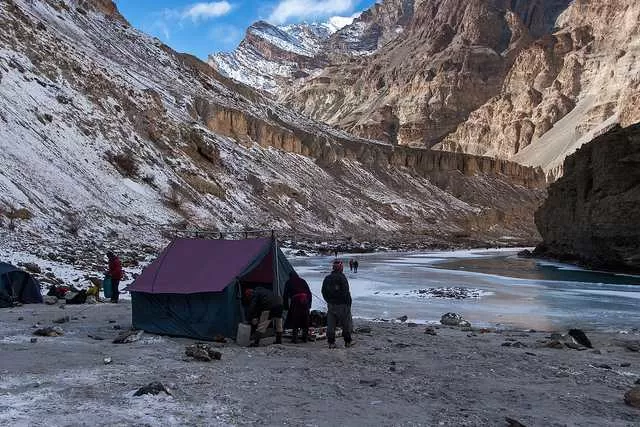
The word chadar means blanket in Hindi, and it refers to the thick layer of ice that covers the Zanskar river during the winter months. The Zanskar river is a tributary of the Indus river, and it flows through a deep and narrow gorge in the Zanskar valley, which is part of the Greater Himalayas. The chadar trek is a trek that follows the frozen river for about 105 km, from Chilling to Naerak and back. The chadar trek is also known as the frozen river trek or the Zanskar trek. The chadar trek is one of the oldest and most traditional routes in Ladakh, as it was used by the local people, especially the Zanskari people, to trade and communicate with the outside world when the road access was blocked by snow.
Why Chadar Trek?
The chadar trek is not just a trek, it is an adventure, a challenge, and a learning experience. Here are some of the reasons why you should do the chadar trek:
1. The chadar trek is a unique and rare trek, as it is one of the few places in the world where you can walk on a frozen river. The chadar trek is also a seasonal and unpredictable trek , as it depends on the weather and the river conditions, which can change anytime. The chadar trek is also a dynamic and diverse trek, as it offers different landscapes, terrains, and views, depending on the time of the day, the angle of the sun, and the thickness of the ice.
2. The chadar trek is a thrilling and exciting trek, as it involves walking, sliding, crawling , and sometimes even swimming on the frozen river. The chadar trek is also a challenging and demanding trek, as it requires a high level of fitness, stamina, endurance, and mental strength. The chadar trek is also a risky and adventurous trek, as it exposes you to the extreme cold, the slippery ice, the unpredictable weather, and the remote wilderness.
3. The chadar trek is a cultural and educational trek, as it introduces you to the culture and lifestyle of the local people , especially the Zanskari people, who have been living in this harsh and isolated environment for centuries. The chadar trek is also a spiritual and inspirational trek, as it passes by many ancient and sacred sites, such as monasteries, shrines, and caves, that are revered by the Buddhists. The chadar trek is also a social and fun trek, as it allows you to meet and interact with other trekkers, guides, porters, and locals, who share your passion and enthusiasm for the chadar trek.
Best Time to Go for Chadar Trek
The best time to go for the chadar trek is from mid-January to mid-February , when the Zanskar river is frozen enough to support the weight of the trekkers. The chadar trek is not possible before or after this period, as the river is either too thin or too thick to walk on. The chadar trek is also not possible during the summer months, when the river is flowing and not frozen.
The best time to go for the chadar trek also depends on the weather, the river condition, the availability, and the preference of the trekkers. The weather in Ladakh during the winter months is very cold, dry, and windy, with temperatures ranging from -5°C to -25°C.
How to Reach Chadar Trek
The chadar trek starts and ends at Chilling , a small village in the Zanskar valley, which is about 65 km from Leh, the capital of Ladakh. To reach the chadar trek, you need to first reach Leh, and then take a taxi or a bus to Chilling. To reach Leh, you have two options: by air or by road.
By air , you can take a flight from Delhi, Mumbai, Bangalore, or other major cities in India, to Leh, which is the nearest airport to the chadar trek.
By road , you can take a bus or a car from Manali, Srinagar, or other nearby towns in Himachal Pradesh or Jammu and Kashmir, to Leh, which is the nearest road head to the chadar trek. The road distance is about 475 km from Manali, and about 420 km from Srinagar, and the road duration is about two days, with a night halt at Keylong or Kargil, respectively.
The best way to reach the chadar trek is by air, as it is faster, easier, and more reliable than by road. However, you need to be prepared for any changes or cancellations, and acclimatize yourself to the high altitude and low oxygen level in Leh, before starting the chadar trek.
The chadar trek is a unique and adventurous trek that takes you along the frozen Zanskar river in Ladakh, a region in the northern part of India. The chadar trek is a winter trek that is only possible for a few weeks in the year, when the river is frozen enough to support the weight of the trekkers.
The chadar trek is a challenging and rewarding trek that requires a high level of fitness, stamina, endurance, and mental strength. The chadar trek is also a cultural and spiritual trek that introduces you to the culture and lifestyle of the local people, especially the Zanskari people, who have been using this route for centuries.
The chadar trek is also a scenic and beautiful trek that showcases the natural beauty and splendor of the Zanskar valley, the Himalayas, and the Ladakh region. The chadar trek is a once-in-a-lifetime opportunity, as it is threatened by the effects of climate change, global warming, and tourism, which may alter or melt the ice in the future.
Chadar Trek Reviews
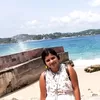
Places To Visit In Leh Ladakh
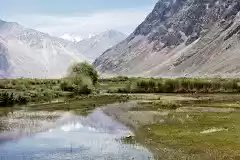
Travel Blogs for Chadar Trek - Trekking In Ladakh - Frozen River Trekking In Ladakh
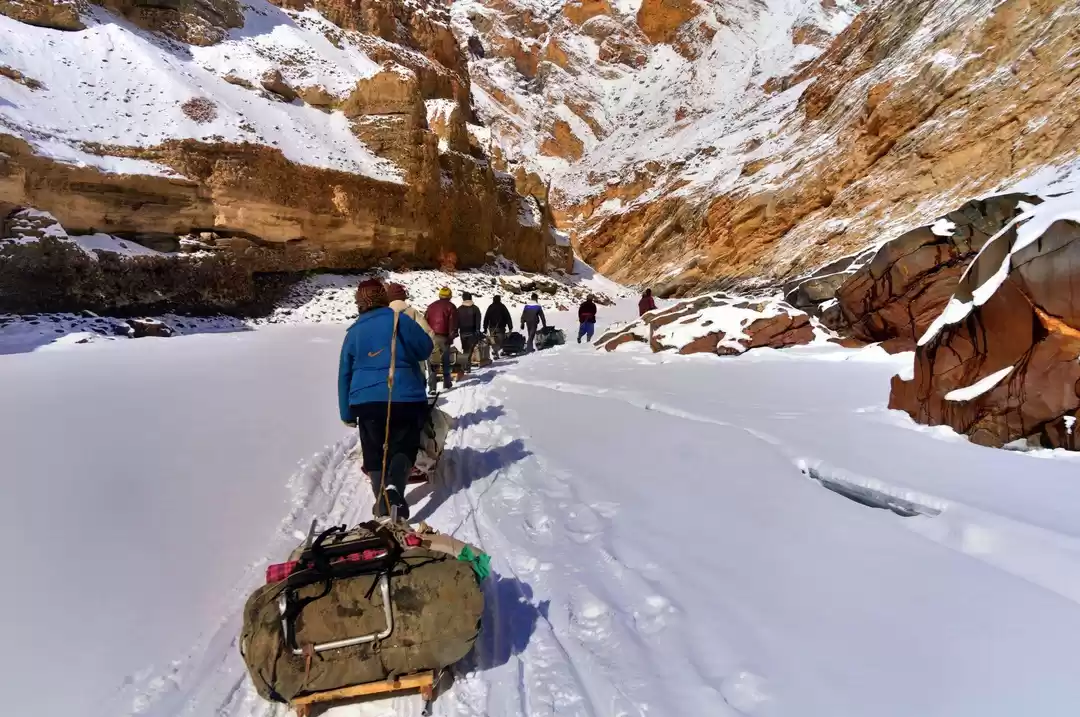
Chadar Trek

Top ways to experience nearby attractions

Also popular with travellers

Chadar Trek - All You Need to Know BEFORE You Go (2024)
You will receive an email containing a link allowing you to reset your password to a new preferred one.
Verification mail has been sent.
Please check your mail to verify your account.
Click Here to Login
- How To Reach

33°54'07.9"N 77°00'03.9"E
- Chadar Trek

Inquire Now
Pickup point.
Leh Airport, India
Minimum Age
- During winters, the water in the Zanskar river remains frozen and hence Chadar trek is also known as Frozen river trek.
- It is one of the most difficult treks which involves a temperature of less than -20 degree centigrade.
- Trekkers from all over who are in quest for thrill and adventure experience this trek once in their lifetime.
"CHADAR" refers to the blanket or sheet because the Zanskar river transforms itself from a fast river into a white blanket of ice all through winter. Your trek adventure will begin in the beautiful mountain city of Leh, all our trekkers generally reach Leh by using flight. This proves to be a quality choice for you to reach Leh. The altitude is 11,400 feet above mean sea level along the beautiful Zanskar River which remains totally frozen in the course of the December to February. The trek starts to evolve from the freezing factor of Zanskar River which is chilling. This trek is over a frozen river within the Zanskar region of Ladakh and it's very specific from all different treks within the Himalayas.
The Chadar trek is over a frozen river and the ice can flip dangerous from time to time. It's very important to discover a secure course over the perilous sheet of ice. During the trek, you do no longer camp here on the meadows or the wooded area clearings but within the caves which can be along the banks or you set up the tents at stable ice. Here, the temperature stays chilly and freezing (-20) and falls down at night time, so keep warm layers to shield the body in opposition to chilly bloodless and save you the freezing of blood.
Trekmunk as a Chadar Trek Organizer will make sure that you get once in a lifetime experience that will stay in your memory for years to come. Find your way through Ladakh with a different lens by pursuing this trek. The Chadar trek cost 54,500 rupees which covers all the inclusions from the base camp.
The Chadar trek is your chance to pledge a connection with the majestic Himalayas, serene lakes, and rugged terrain. Trekmunk has the perfect itinerary for your trekking plans. Place your trust on us to lead you through the most enriching route you've ever marched across. Join the Trekmunk team on this rare trek and discover the concealed enthusiast in you.
Best Time to Visit
The best time to venture out to Chadar Trek is during the winter months of January and February when the whole region remains frozen. Quietness and isolation are at its best during the post rainstorm at Chadar Trek. The area is honoured with substantial snowfall during winters. In any case, you can see the best of Chadar Trek post-storm as paradise on earth.
Brief Itinerary
Detailed itinerary, day 1: arrival in leh.
Chadar trek starts from Leh. Land in Leh through flight or train. Your stay will be in the inn after you reach. Leh is at an elevation of 11,400 ft, consequently, you ought to be acclimatized entirely well. Utilize this day as a chance to rest and get your body acclimatized to the high altitude. Mobile networks are accessible in Leh. You can utilize this day to look for the overlooked things. You can furthermore wander around and get adjusted to the way of life. Leh is very well known for its social fortunes, cloisters, castles, and sanctuaries.
Day 2: Rest day in Leh
Rest day for acclimatization. You can visit nearby tourist places in Leh. One more day to become accustomed to the low temperatures or to find the wonderful Leh! Aside from undertakings and strange views, Leh is notable for its religious communities and castles. Venture into the historical backdrop of Leh through the Shey Palace, Thiksey Monastery, and ThikseyGompa. Leh is acclaimed for its bistros and hanging out spots.
Aside from social legacy, Leh is famous for its passes and lakes like Nubra valley, Pangong lake. We don't permit wandering of trekkers to such places. This is to maintain a strategic distance from strain on the body that may go against the procedure of acclimatization.
Day 3: Medical Check up Day
You will be taken for a Medical Check up on this day as it has been made mandatory by Ladakh Government to avoid any accidents. After that, you can take a rest and go shopping, prepare for the trek.
During the evening, a few activities will be arranged in order to increase the interaction between the trekkers. Trekking is a team activity and in order to reach the summit, it is very important to climb together. You will certainly light up in the hues of the place, welcoming strangers to become a part of your life. Dinner will be served at night. This will mark the end of the first day of the trek.
Day 4 : Drive from Leh to Shingra Koma and Trek to Tsomo Palder
On this day, we will pick you up from Leh. From Leh, we will drive to Shingra Koma. Today in the morning, we will drive with a small brief halt at the magnificent confluence of River Zanskar and Indus and then again, take a drive to the chilling, one of the most famous villages in Ladakh, known for craftsmanship, especially the metal works. The stretch from Leh to Shingra Koma is scenic, and we drive past several grasslands, alpine forests, and lofty mountains. The transition in the beauty of the landscapes will be worth it. You will feel like you have finally made your way to heaven. Once we reach Shingra Koma, we will settle a bit and get ready for the further trek to Tsomo Palder. You can roam around and embrace the beauty of this amazing place.
Touching the Chadar for the first time, we will start the trek along the magnificent frozen river Zanskar till Tsomo Paldar. Overnight stay will be arranged in a cave/camp/tent.
Day 5: Trek from Tsomo Palder to Tibb Cave
This will be the fifth day of the trek. On this day, we will make our way from Tsomo Paldar to Tibb Cave. We will pass through some magnificent beautiful waterfalls and frozen ice cliffs on the left – it is like walking through a giant freezer! The walk additionally crosses through narrow gorges, in which the trekker may need to climb briefly on to the rocky river. The sharp bends and current of the river break the ice in some locations. Lunch will be served on a flat rocky hillside with the aid of the river.
Dinner will be served at night. Overnight stay will be set up at Tibb Cave. This will mark the end of the fifth day of the trek.
Day 6: Trek from Tibb to Nyerak Pullu
Again one of the fantastic days on the Chadar trek. However, the caution is that this day might be a little difficult. The vistas are lovely although as we skip through giant frozen waterfalls, ice cliffs and one may even catch sight of the mountain fox. Nyerak village is placed high above. You can interact with friendly folks. Sharpen your photography skills, write, or just meditate! Undoubtedly, this is one of the best places to widen your camera gallery with the most beautiful pictures.
We will play some games, indulge in storytelling until the dinner is served. We will sleep overnight in a cave/tent.
Day 7: Trek from Nyerak to Tibb Cave
This will mark the seventh day on this frozen expedition called Chadar trek. Though technically it is the same way back, it is also quite different. The Chadar or the blanket of ice that is forming at the River Zanskar is continually converting, breaking up and forming itself once more.
Revel in the beauty of this beautiful cave. Dinner will be served at night along with lots of life stories. Overnight stay will be set up here.
Day 8: Trek Tibb Cave to Shingra Koma and Drive to Leh
Today we trek from Tibb to Shingra Koma. It’s right below a huge stone wall which is straight out of a Hollywood movie. The Zanskar river takes a beautiful turn right in front of the campsite and sharp peaks rise on the other side of the river.
Today you will have blended sentiments, misery because the trek ends today. The path changes through the landscape of Indus valley and Ladakh extend. This is the last stop of the whole trek, that additionally has numerous homestays. Think back and attempt to fill the remarkable highlights of the Ladakh in your eyes that you have quite recently experienced while recollecting the Chadar trek. Your vehicle will bring all of you the route down to Leh.
Day 9: Depart from Leh
You can go with your onward travel plans on this day. You can either stay back in Leh and enjoy the local sightseeing or return back to your own city. This marks the end of your beautiful trek to Chadar along with Trekmunk. Here the trip ends physically but not in your memories. You will surely cherish this awesome trip for a lifetime. You will feel changes in your perspective and you will feel more energized and adventurous. The mountains are huge and hence it will occupy a huge space in your heart forcing you to return back real soon.
We will arrange pickup from the airport.
How to Reach Chadar Trek Base Camp (Leh):
By Air Stream Airways, Go Air and Air India give day by day (when consistently) flight administration between New Delhi and Leh. You would appreciate the trip as you would fly over numerous immaculate territories and even some mountain ranges. The elevated view is simply captivating and gives an extraordinary beginning to your visit.
Latest Stories
Why trek with us .
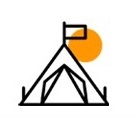
Get Yourself Fit
Nutrition tips, things to take, health & safety.
- Accommodations at Trek: All accommodations on the trek will be on twin sharing basis in Tents or Homestays. Any accommodation in a hotel/guest house/hostel will be in a budget hotel.
- Trek Leader and Guides: An experienced and certified Trek Leader , as well as a professional guide, will accompany you for the trek. The team will have years of experience and well equipped for any emergency situation.
- Services of a Professional Trekking Team: A team of an experienced Cook, Camp Staff, Porters/Mules will accompany you for all the arrangements on the trek .
- Meals: All Meals on the Trek are included. We will serve Vegetarian Indian food on the trek which will be cooked by our high altitude chefs. It will be a five-course meal plan.
- Camping and Safety Equipment: All the camping equipment such as Tents, Sleeping bags, Toilet Tents, Dining Tent, Mattresses, and other things will be provided by us and we guarantee the quality. Safety Equipment including Medical kit, Oxygen Cylinder, Oximeter, Crampons & Gaiters(if required) will be provided by us. We recommend you to bring your own sleeping bags if possible.
- Trek Permits and Forest Camping Charges: Only for Indian Clients, All the applicable trekking permits, Camping Charges, Forest Entry Fee, etc will be paid by us. Foreigners have to pay these charges if not mentioned.
- Portage of Personal Bags(Offloading): We highly advise you to carry your own burden (your rucksack) but due to any reason, if you wish to not carry your rucksack, we can arrange for a porter/mule to carry it. For this service, you will be charged over and above the trek cost. The charges for offloading vary with every trek.
- A Life-Changing Experience: We assure you that by trekking in the Himalayas you will have a life-changing experience and we will do everything we can to provide you with the best services and make your venture in the wild an unforgettable one.
Note: Prior to booking any adventure with Trekmunk, it will be mandatory to sign the waiver form and get a medical certificate from a doctor in due time, without these, you will not be allowed to start the trek. All this will be done online without using any paper.
- GST and Other Taxes: The goods and services tax is not included in the price mentioned with the trek. They are subjected to change according to the government rules of India.
- Flights and Transportation: Flights or other means of transport are not included in the package. Transportation from Home city to Leh and Leh to Home city is not included in the package. Any expenses occurred during the journey are not included in the package cost.
- Personal Equipment: Your Rucksack, personal clothing, shoes, trek poles, and other personal trekking gear is not included in this package. You have to bring your own gear according to the weather and difficulty of the trek.
- Travel Insurance: Travel Insurance is not included in this package. We recommend you to have travel insurance before opting for such adventures. You can buy insurance from us while booking the trek, it is optional.
- Personal Expenses: Any personal expenses incurred (Laundry, Bottled Water, Beverages, Snacks, Orders at tea houses or dhabas, Tips for guides, Camera fees, etc) are not included in the package.
- Emergency Expenses: Any costs arising out of unforeseen circumstances such as accidents, bad weather, landslides, road conditions and any other circumstances beyond our control are not included in the package.
- Anything not mentioned in Inclusions of the package.
Cancellation Policy And More Information
Booking Terms:
1. Confirmation Policy :
Upon Booking, An invoice will be sent to your mail & within 12 to 24 hours the booking confirmation with additional details will be sent to your mail.
2. Cancellation Policy:
Note: Following Cancellation policy will be followed for departures booked on or before 31st May 2021-
1) Cancellation up to 7 days before the start date of the trek: Get a complete cash refund (minus 5% transaction fee). The money is refunded to the same bank account, credit, or debit card from where the payment was made.
2) Cancellation during the last 6 days before the start date of the trek, and not counting the day of the trek: Full refund with 100% of the trek fee in the form of a Trekmunk Trek Voucher. Valid for 1 year from the date of issue. Can be used on any Trekmunk trek.
3) Cancellation on the start day of the trek, or no show on the start day of the trek : Unfortunately, no refund.
For more details, go to https://www.trekmunk.com/cancellation-policy
3. Refund Policy:
Any refund applicable will be processed within 10 to 15 business days as per the company policy.
4. Postpone/Transfer of a booked trek:
1. You can postpone your booked trek for a period of two months (61 days) but we will charge a 20% processing fee. The last date for the postponement will be 15 days before the start of the trek. Failing to book the slot in 2 months (61 days) time, would be considered a cancellation with no refund of any kind. Postpone of a booked trek can only be done once.
2. You can transfer your booked slot for the trek to any fit person till 15 days before the trek. You just have to mail us the request and rest we will handle. The new person has to get all the mandatory documents duly signed for the trek.
More Information:
1. We Trek for a Cause : For overall development of the areas we run our operations in, we donate Rs 100/- per booking from our profits which are used for the upliftment of the local people and conserving nature. We have named this initiative as - Trek for a Cause. For more details, follow: https://www.trekmunk.com/trek-for-a-cause
2. We are paperless : We are focusing on Sustainable Tourism and to do that we are trying all measures to convert our trek operations to be Eco-Friendly. Going Paperless is one step closer to our aim.
3. Single-Use Plastic : Trekmunk does not encourage the use of single-use plastic items. We are ensuring that our team is working together to reduce the problem and educate those around them. We will send you instructions on how to go plastic-free on your adventures.
4. Preparing for your Holiday : Getting some additional exercise makes a lot of sense to spend time before coming on a trekking adventure. The fitter you are, the more enjoyable you will find the experience. Hiking in the hill country is the best training but jogging, squash and swimming are also good for developing cardiovascular fitness and stamina. To read more on how to get fit, follow: https://www.trekmunk.com/get-fit-for-trek
5. Electricity Supply & Plug : You will get electricity supply till the starting point of the trek. If not Indian, We recommend you check if you require an adaptor for your electrical items at: http://www.worldstandards.eu/electricity/plugs-and-sockets/
6. Currency: The unit of currency in India is the Indian Rupees.
7. Health & Vaccinations:
Severe Allergies : If you have a severe allergy please inform the Trekmunk office before you travel. We will do all we can to help, but we cannot guarantee an allergy-free environment on trekmunk trips. You will need to carry your own treatment for the allergy with you, as 'adrenaline auto-injectors' are not carried as standard by our leaders and staff. You should inform your leader on the arrival of your allergy, and let them know where you keep your adrenaline pen.
Vaccinations : You should contact your doctor or travel clinic to check whether you require any specific vaccinations or other preventive measures. You should be up to date with routine courses and boosters as recommended e.g. diphtheria-tetanus-polio and measles-mumps-rubella, along with hepatitis A and typhoid. Malarial prophylaxis is not usually required for trips in the mountains, however, if you are visiting rural and remote low lying areas then they might be necessary.
8. Passport & Visas/Identity Proofs : If foreigner, Validity for 6 months, should have blank pages, and should be kept with yourself all the time.
9. Water : If you are on a trekking or cycling holiday, water is supplied to fill up your individual bottles. This will be boiled or filtered. Additionally, you should take purification tablets or a filter bottle (such as a LifeStraw, Sawyer Filter) to treat your water when in towns or where water is not supplied. We do not encourage the purchasing of single-use plastic bottles.
10. Altitude : This adventure involves going to a very high altitude. This is not something that you should worry about; the human body is quite capable of adapting to a very wide range of altitudes, but it is important that we follow some simple rules in order to acclimatize successfully. We will send you the information in your mailbox about Acute Mountain Sickness and trekking in high altitudes. On this trip, we carry bottled oxygen for use in emergencies.
11. Guidance on Tipping : Tipping is the accepted way of saying thank you for good service. Normally the guide and any other trek staff are given their tips at the end of the trek and this is best done as a group. The main guide will make sure that the tip is appropriately distributed among all the staff members on the trek.
12. Spending/Emergency Money : Approximately Rs. 8000-10000/- (in Indian Currency)should be carried for miscellaneous expenses including porter and trek crew tips, drinks, soft drinks, etc. We recommend that you carry your travel money in the form of cash as the availability of ATM is less in these remote areas. This can also serve as your emergency spending money.
13. Travel Insurance : It is recommended to have travel insurance for these kinds of adventures. When taking out insurance please ensure the policy you choose covers you for the activities and altitude included in your itinerary. We will ask for the Travel Insurance Details over a mail. Indians can buy insurance from us while booking the trek.
I had the best time of my life at Sandakhphu Phalut trek arranged by Trekmunk. Literally I felt like I was in heaven and I was soo very happy. I will recommend everyone to opt for Trekmunk. I was a solo woman traveler and was a bit worried, but things went very smoothly and I en ...
I and my friends went to Markha Valley trek with Trekmunk and we all had a great time. Walking up and down the hill, coming across some beautiful sites was mesmerizing. Staying in tents was so much fun. And our guide had all the knowledge about the trek. Trekmunk is really good w ...
Traveling with these people is surely an insanely enthralling experience. This is my second backpacking trip with these people and the way I had imagined backpacking to be has been fulfilled by them and they have given me surely more. The best thing about travelling with these pe ...
I had the best time of my life at Sandakhphu Phalut trek arranged by Trekmunk. Literally I felt like I was in heaven and I was soo very happy. I will recommend everyone to opt for Trekmunk. I was a solo woman traveler and was a bit worried, but things went very smoothly and I enjoyed it a lot. I miss my fellow trekkers too. I am very satisfied with their arrangements.
I and my friends went to Markha Valley trek with Trekmunk and we all had a great time. Walking up and down the hill, coming across some beautiful sites was mesmerizing. Staying in tents was so much fun. And our guide had all the knowledge about the trek. Trekmunk is really good with its food and accommodation facilities. I highly recommend Trekmunk. Kudos to their Team.
Traveling with these people is surely an insanely enthralling experience. This is my second backpacking trip with these people and the way I had imagined backpacking to be has been fulfilled by them and they have given me surely more. The best thing about travelling with these people is that you understand the true meaning of travelling and experience it very closely. You are given great freedom but at the same time taking care of. You participate in the process of backpacking. You have a trip leader with you but he acts more like a friend as the days pass by! We attended the hornbill festival and did a wonderful trek to Dzukuo valley in Nagaland with the leadership of this group. You break the boundaries of yourself when you travel like a true traveller and that is possible with these people.
No words for the bike trip from Srinagar to Leh. One should experience it to feel it and all this because of the management of Trekmunk especially Mohit and Harshit whose efforts even made the hardest of the ride exciting adventurous and above all safe. Although some hindrances which are quite common like bike issues and medical problems arose with our co-riders, I liked the way these two guys handled it dexterously. I went with one of my best friends and came with a lot more and the trip turned out to be memories that can be cherished for a lifetime. Thanks, Team Trekmunk for giving me a wonderful experience. I can't wait to go on my next adventure with them.
I chose (after a lot of research) Trekmunk for my first trek - The Hampta Pass and Chandratal Trek. And I am so really glad I did so. The trekker needs to only focus on the trek and the beautiful landscape around him/her. The rest of everything is taken care of by Trekmunk from day 1 till the end of the trek. Scrupulously managed logistics; no compromise on safety and security; experienced, intelligent and knowledgeable trek leaders; scrumptious meals; contingency and backup plans; etc. make Trekmunk an ideal choice to go trekking with. My trek was lead by Ashish Pathania, Prashant Reddy and Sanjay Thakur. The three are were thorough professionals. They were jolly, very helpful, experienced, knowledgeable, organized, and needless to say polite yet strict when needed. They played the most important roles in making sure our overall trekking experience was a wonderful one. Thank you Trekmunk for one of the most beautiful experiences I have had till date. Will see you guys soon.

Related Blogs
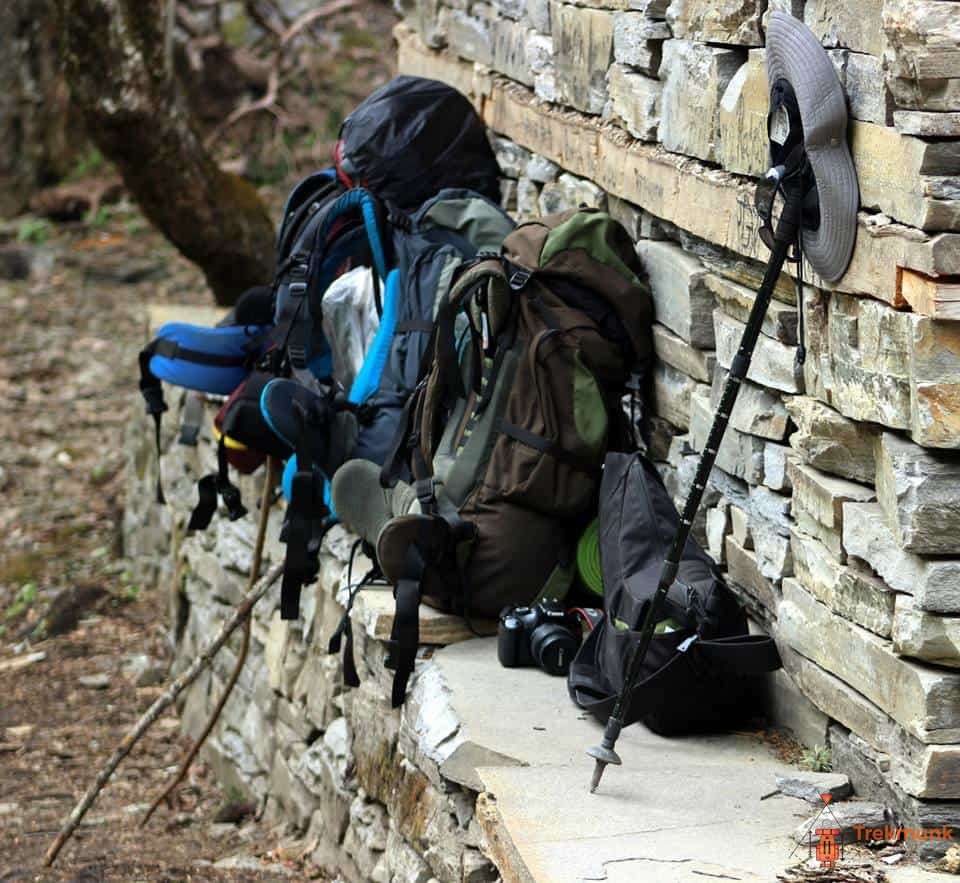
Related Tours
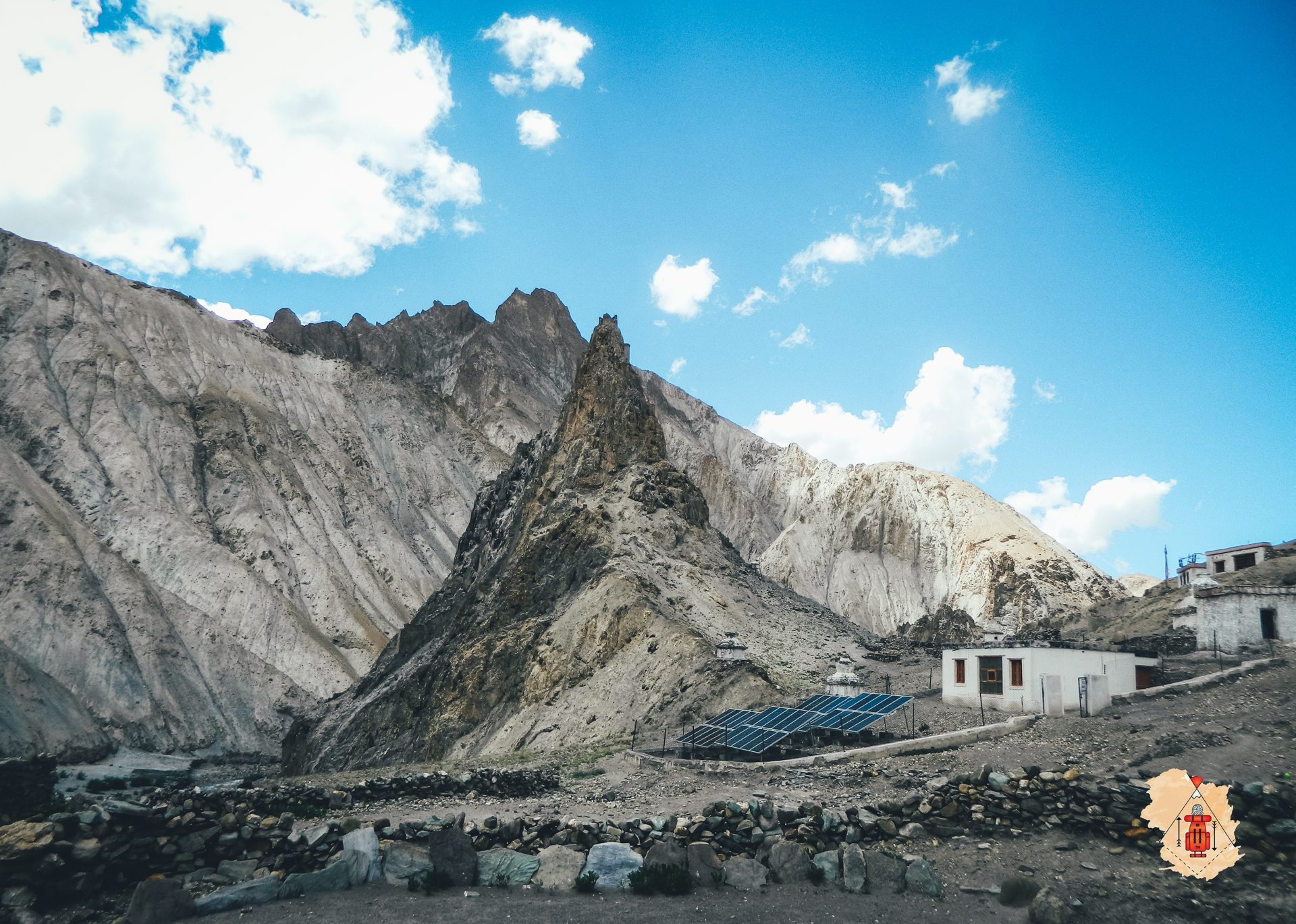
Markha Valley Trek
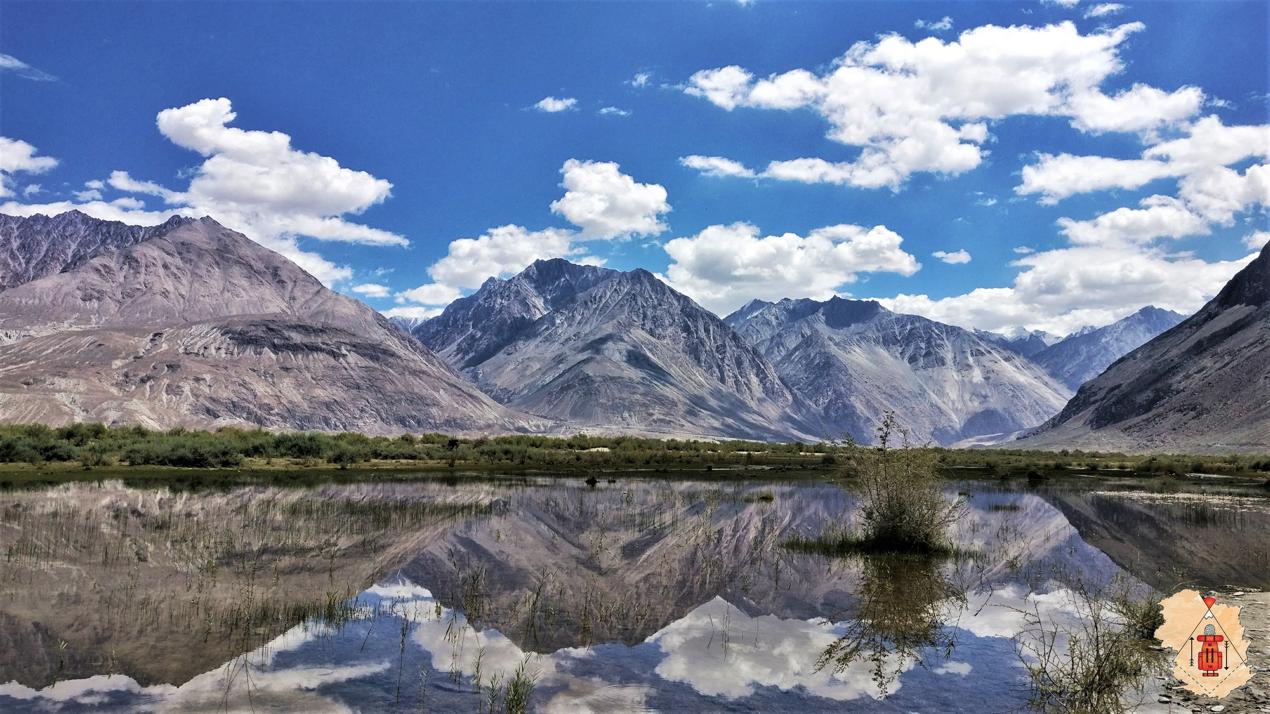
Saboo to Khaltsar Trek
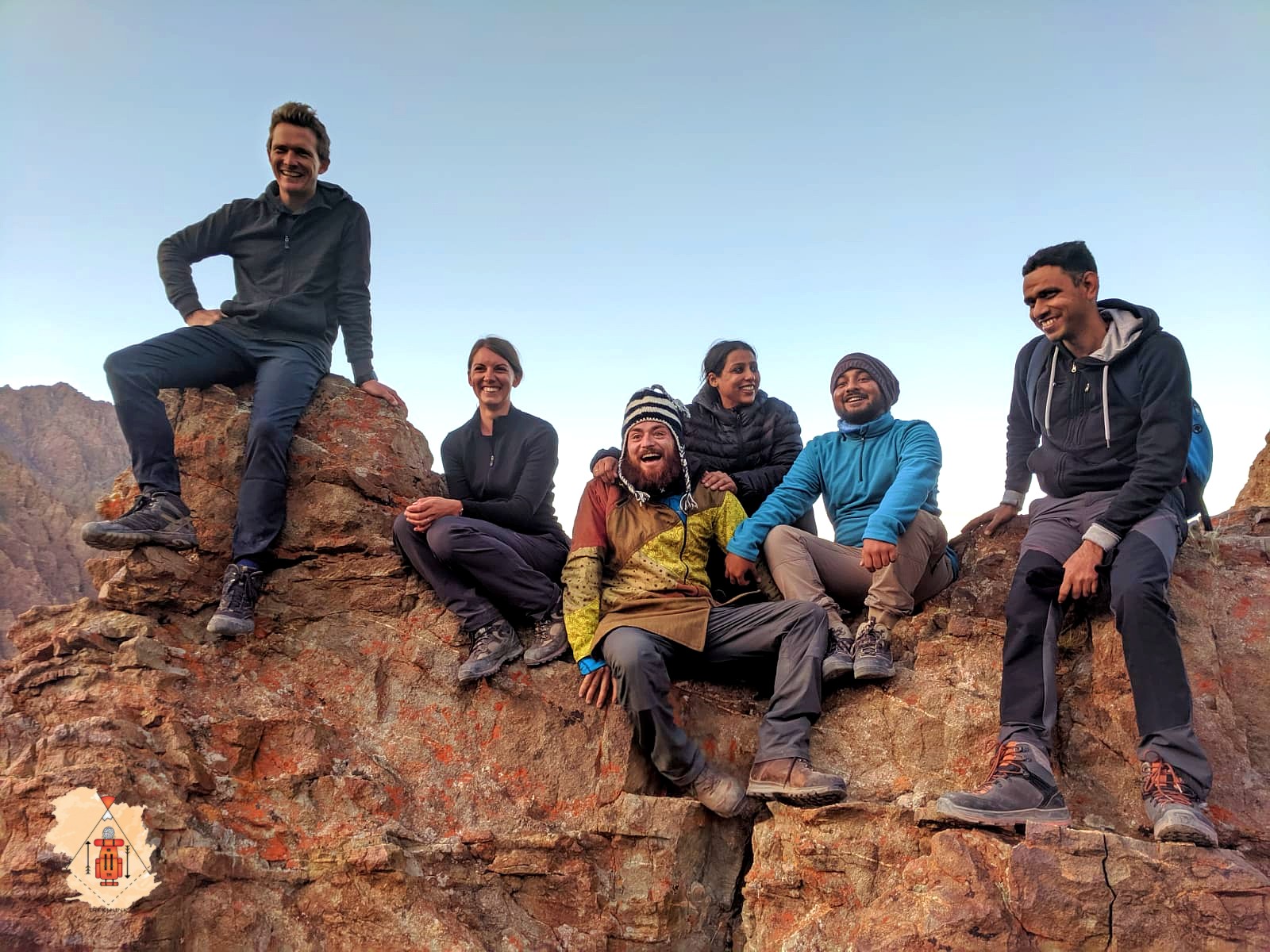
Sham Valley Trek
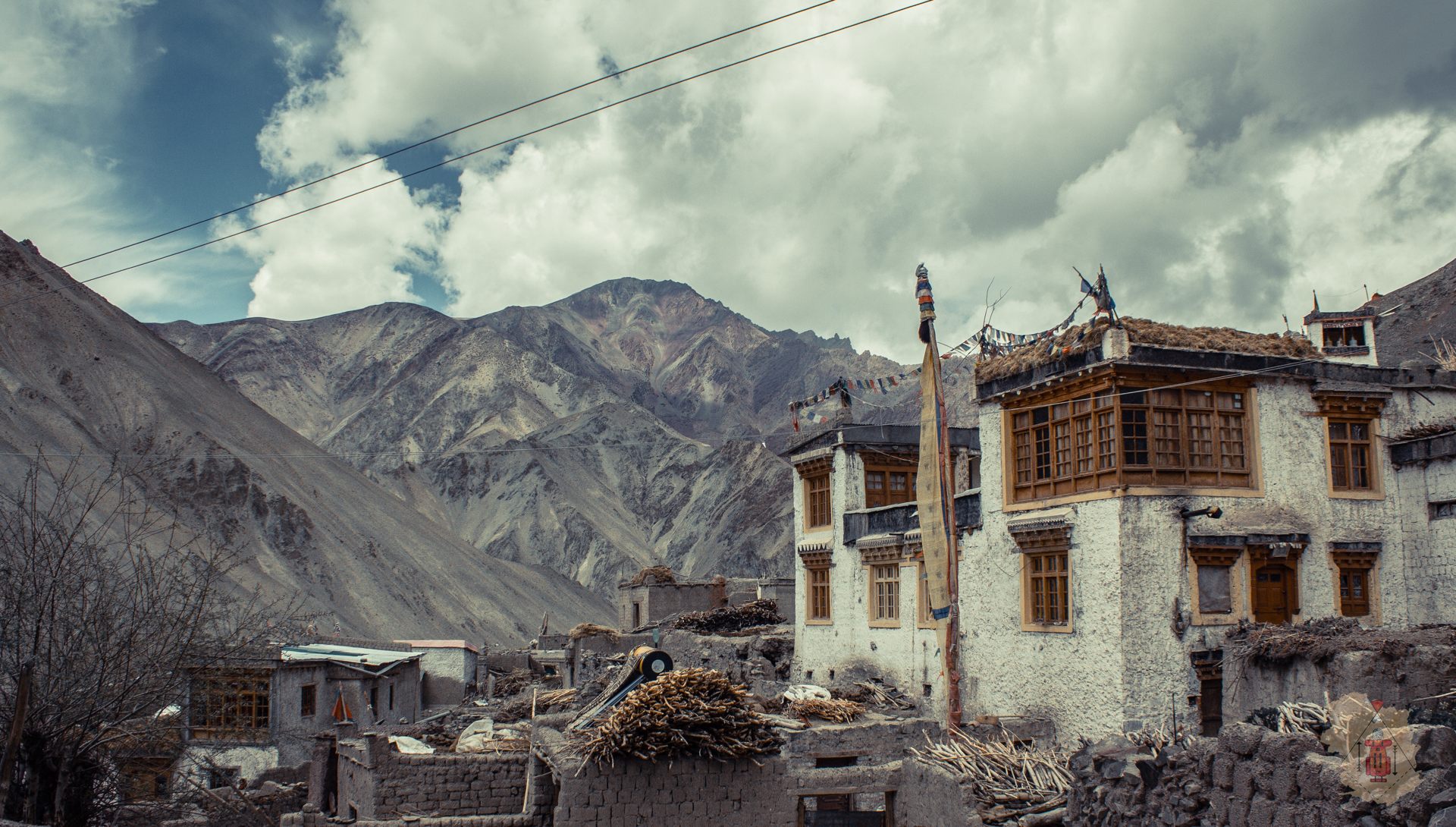
Snow Leopard Trek
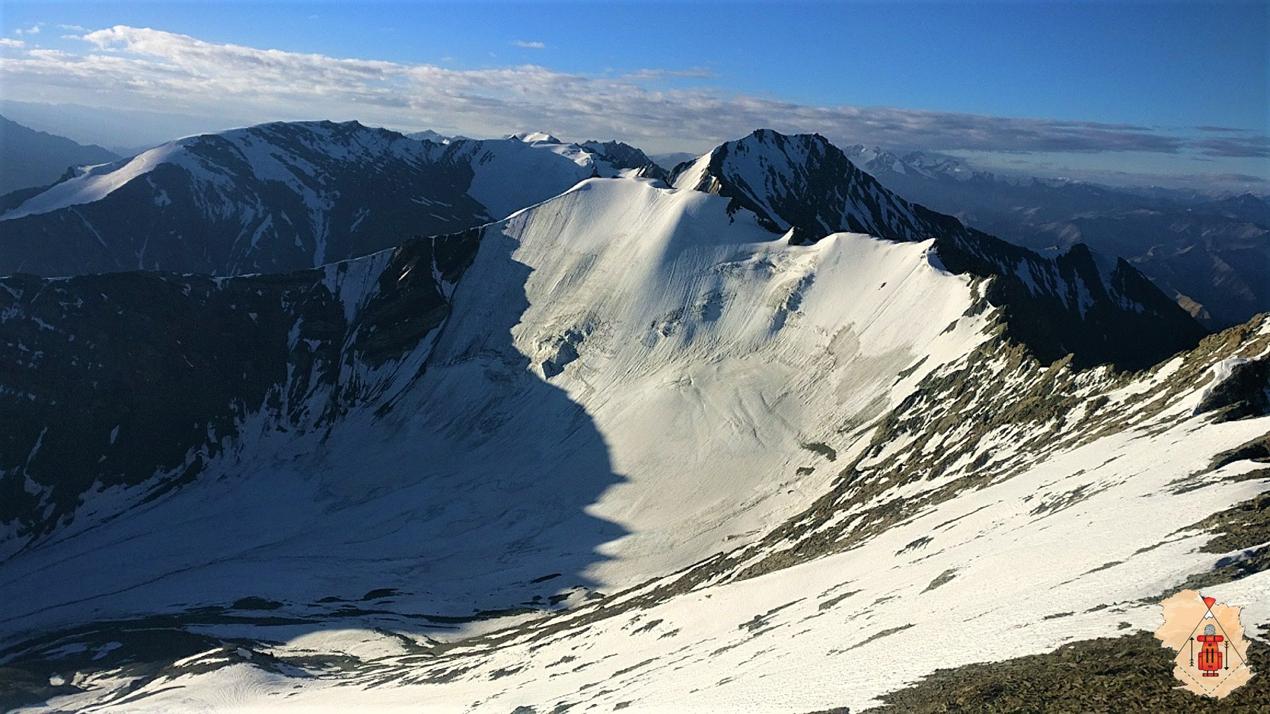
Stok Kangri Winter Expedition

"Trekmunk is changing the indian trekking industry"
"10 Most Promising Adventure Sporting and Trekking Companies - 2020"
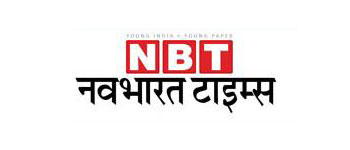
" Things you do for the Passion for Travel"
Hello there, How can we help you ?
Timing: 10 am to 6 pm IST (GMT +5:30)
Whats App Us
- River Rafting
- Rock Climbing
- Scuba Diving
- Wildlife Safari
- View All Tribes
- Ajeet Bajaj
- Amit Chowdhury
- Gayatri Sawhny
- Latika Rana
- Rajesh Kalra
- View All Gurus
activity guide
- Bungy Jumping
- Hot Air Ballooning
- View All Activity Guides
destination guide
- Lahaul and Spiti
- Lakshadweep
- Nubra Valley
- View All Destination Guides

NORTH INDIA
- Himachal Pradesh
- Uttarakhand
SOUTH INDIA
- Western Ghats
INTERNATIONAL
- South Africa
- United Kingdom

LAND ACTIVITIES
- Camel Safari
- Horse Safari
- Jeep Safari
- Mountaineering
- Motorsports
- Photography
AIR ACTIVITIES
- Bungee Jumping
- Paragliding
WATER ACTIVITIES
- River Cruising
- Family Outings
- Fixed Departures
- Weekend Getaways

` 24,999 ` 17,499 per person
Duration: 9 days, talk to an expert, 0120-6907340.
Proud winner of Tripadvisor Travellers’ Choice Award 2020. Encapsulated within the range of the Great Himalayan Mountains –with peaks as high as 7,000m – India’s Zanskar valley aka Chadar Trek has stayed isolated for centuries. But with boosted tourism in recent years in Leh and Ladakh, the Zanskar valley has garnered immense attraction from people all around the globe. After footage of school children walking 100 km to the study goes viral, now as many as hundreds of visitors go to Zanskar for Chadar trek every year. The journey embarks at the mountain town of Leh. The best way to reach Leh is by a flight, and honestly, a glimpse of snow-drenched mountains looks so surreal from the plane. The trek is over the frozen river of Zanskar , and it is a huge favourite among Indians and travelers from abroad. At just 11,078 feet, the walk on the frozen river feels like a small expedition to the North Pole. The ration is carried through sledges, tents and extra stuff by the porters and the kitchen wealth by the cooks. Due to its remoteness to the modern world, Chadar Trek is one of the most uninhabitable regions in the world, and also one of the World’s most beautiful place to see once-in-a-lifetime.
The best time to take Chadar Trek is in January or February as the ice sheet is sturdy and solid to walk for long kilometers. The temperature, in general, is twenty degrees below the freezing point and sometimes goes even below. Due to the harsh circumstances on the trek, one finds refuge in the caves, life works on instincts, and camping on the river banks, make the destination ‘do before you die” trip.
Whether you are a seasoned professional or a novice in trekking, Chadar Trek can be experienced by all. The extreme challenge of this trek is not the terrain but the extreme cold weather that tends to challenge people of all age. Proper clothing, trekking shoes, hydration and food is enough for your body to endure the challenging lifestyle of Zanskar that thrives in sub-zero temperature.
The most rewarding sight of the trek is the spectacle of a frozen cascading waterfall called Naerak from a height. The formations of frozen water will give your eyesight a new perspective to visualize a waterfall. Most of the people get overwhelmed to see nature’s finest creations on the trek. The landscapes and overall experience will leave their imprints on your hearts forever.
And if all this information piqued your interest, let us give you an insight into how the Zanskari people survive in these arduous conditions. Did you know Zanskari people can walk to and fro from their village in just 24-35 hours? They spend the nights in the caves, camp at the river banks and walk miles and miles without proper trekking shoes. They are so used to the climate, that even without the proper attire, the locals can endure the harsh weather conditions.
Lastly, the Chadar frozen river the trek is an experience for the brave-hearted that seek thrill through responsible eco-tourism. The weather and terrain might shake your confidence a bit but if you can surpass that then the journey to the marvellous and exhilarating frozen river trek will be the most enriching experience of your life. Know more about Trekking in Leh Ladakh .
Detailed Itinerary for Chadar Trek:
Day 01: Arrive in Leh (3500m) Team Briefing, Day at Leisure Leh, which lies at an altitude of 3500 metres above sea level, is one of the largest districts in the country. In winters, as most passes leading to Leh are closed, you can only reach the city by taking a flight to Leh airport which has the distinction of being the highest airport in the world. As soon you land at the airport, you will be greeted by dry and cold air, but what will take all your attention is the lofty, snow-capped mountains all around; a sight that will remain with you forever. After completing the arrival formalities and picking up your bags from the baggage counter, take a taxi and proceed towards the pre-arranged hotel. Get acquainted with your co trekkers and the Adventure Nation team members and rest in the hotel. Stay overnight. Day 02: Acclimatization Walk in Leh Acclimatization Walk, Leh Exploration Get up early in the morning and begin the process of acclimatization at high altitude. Proceed to walk towards Shanti Stupa, a sacred Buddhist stupa, from where you will get an opportunity to witness a beautiful view of the sunrise and a panoramic sight of the town of Leh. Staying hydrated is extremely important so make sure you drink at least 3-4 litres of water everyday. Day 03: A Visit to the Hospital Medical Check-Up Due to the challenging nature of this particular trek, the government has made it mandatory for participants to acquire medical certification before they undertake this Himalayan Expedition. A clearance certificate upon a health check-up is mandatory and will be issued by the positioned medical centre. One will get a certificate only when adequately fit and acclimatized for the trek. The basic medical examination is done at the SNM Hospital. Day 04: Leh - Shingra Koma - Tsomo Paldar (3200m) Distance/Duration: 70km Drive (4 Hours), 3km Trek (2 Hours) Grade: Moderate This is the day you’re going to start the extraordinary journey, known as the Chadar Trek. Enjoy breakfast in the morning and start your journey by driving to Shingra Koma. This ride is not for the faint-hearted as bumpy roads and hairpin bends are quite common on this route. The sight of the surrounding high mountains will give you a sense of awe. After reaching, you will have to deboard from the vehicle and prepare to start the trek. Initially, you may find it a bit difficult to walk on the ice but after a few minutes (and a few falls ;-)) you will get comfortable. Reach the first campsite after trekking for a couple of hours. Have some fresh cooked food and stay overnight. Day 05: Tsomo Paldar to Tibb Cave (3300m) Distance/Duration: 14km / 6-7 Hours Grade: Moderate Today, you will set out to trek to Tibb Cave/. You need to cover a rather long distance so starting early is very important. During the day, you will behold the breathtaking beauty of the region including ravines and gorges. You might not see sunshine properly as the cliffs in this area obstruct them. Once you reach Tibb, you will see a large cave. This is the place where you will halt for the night and rest. Butter tea would be offered and we recommend you to try it. Enjoy overnight stay at the campsite. Day 06: Tibb Cave to Naerak (3400m) Distance/Duration: 13km / 7 Hours Grade: Moderate Today, you will trek the most scenic part of the expedition and get a chance to witness the largest frozen waterfall in the valley. The bridge built next to the site of the waterfall is used in summers to reach Zanskar from Leh. Thereafter, you can proceed towards the village of Naerak to mingle with the locals and understand their way of living. The temperature in Naerak can get as low as negative 30 degree celsius during the night so you will need to take extra precaution in regards to the clothing. Stay overnight at the village camp comfortably. Day 07: Naerak to Tibb (3300m) Distance/Duration: 13km / 7 Hours Grade: Moderate On this particular day, start your return trip and proceed towards Tibb. The return trail would not be easy and the river quickly reacts to any change in the temperature. By now the frozen river might have taken an entirely new form. On the way back, admire the beauty of the region, click pictures and meet locals, who can be seen wearing traditional woollen Gonchas (robes). Upon Dib Cave, relax and stay overnight at the campsite. Day 08: Tibb - Shingra Koma - Leh (3500m) Distance/Duration: 14km / 7 Hours Grade: Moderate In the morning, get ready to leave Tibb and proceed towards Shingra Koma, crossing Gyalpo. The trail today will give you a chance to witness high mountains and pugmarks of wild animals like snow leopards, ibex and foxes. If lucky, you just might spot a leopard; even if you do not, then at least be sure, you would be watched by them. After trekking through the day, make your way to Shingra Koma which is technically the finishing point of the trek. Take some rest after arrival and manage your luggage accordingly for the ride to Leh.
Later, drive back to Leh and stay overnight at the hotel. Day 09: Departure from Leh Today, the mesmeric journey to one of the most scenic destinations in India will ultimately come to an end. The entire experience, we are sure, would give you an unmatchable feeling of achievement and satisfaction. In the morning, check-out from the hotel and depart for Leh airport.
FAQs for Chadar Frozen River Trek
1) What is the best time to go? January to February is the best and the only time to go for the Chadar trek because this is when the Zanskar River is frozen and is considered safe for walking across it. 2) What is so unique about the Chadar trek? Marked as one of the most unique treks of the country, Chadar trek exhibits beauty nowhere to be found. The extreme climate, the ever-changing weather, sledges, walking on ice with water underneath it, the frozen waterfall view, and camping near the frozen river will give you the experience of a lifetime. 3) How are the weather conditions on Chadar Trek? Dealing with low temperatures is what makes this trek challenging. Temperatures vary between +5 to -5 degree celsius during the day and -20 to -30 degree celsius during the night. The oxygen level is really thin, as the onset of winter brings harsh weather that causes temperatures to go below freezing point. 4) What kind of shoes should I buy? We recommend that you have trekking shoes which are waterproof and have high-ankles, as your shoes might get drenched while walking on the frozen river. You can also buy gumboots from the local market in Leh, which would be helpful when crossing stretches of the river that is not frozen. 5) Is Chadar Trek dangerous? Every trek has its difficulties, challenges and dangers, Chadar is no exception. This trek happens in one of the remotest gorges of mighty frozen River Zanskar, in Leh. The important and unique challenges and its solutions are as below:
6) Is Chadar Trek closing? Nobody wants the Chadar trek to get closed, obviously. The Chadar formation and the trek itself is very important for the local people living in this region. But climate change is real: glaciers melting, polar ice covers shrinking, are some of the factors which are to be looked at to assert the future of this trek. This part of the world is very sensitive to pollutants and disturbance, it is in our hand that we conserve our nature and sustainably do the trek so that the trek is open for the upcoming years too. 7) Is Chadar trek suitable for beginners? Considering the extreme conditions of Chadar, it is definitely not an easy place to go trekking. Yes, even the beginners can complete this trek successfully if the preparation of the trek is strong. However, prior experience in high altitude trekking enhances the experience of Chadar Trekking. 8) What should I pack for the trek? You can see the detailed packing list here. You can also watch our Chadar trek packing video here. 9) Will bonfires be possible on the trek? No, we do not recommend having a bonfire on a trek like Chadar. Leh and the Zanskar region where the trek happens is a high altitude cold desert. You will rarely see any trees throughout your trek. The sparsely available wood supports the livelihood and extreme survival of the local people. Being a socially responsible organisation, we prefer to not disturb the local lives by doing something for our creature comforts. 10) What about the cell reception and the electricity, on the trek? There is no mobile network availability or the possibility of charging batteries during the trek. Yes, you can use your phones as a camera to click the wonderful moments. In this extreme high altitude and low temperatures, the batteries tend to drain very fast. So ensure you keep your gadgets inside your warm jackets and sleeping bag when not clicking photos. 11) Is hot & safe water available during trekking? Yes, hot and safe drinking water will be provided during the trek every morning and evening. Please bring insulated water bottles to fill and use it while on the trek and during sleep. 12) How should I prepare physically? A 30 min workout session which should gradually be built up to a 1hr session, for a minimum of 45 days and four days a week, before the start of the trek, is what we recommend. The work out sessions should majorly consist of cardio like swimming, jogging, cycling, etc. Closer to the trek, if you can jog for 4KMS continuously without taking any major breaks, you are good. Remember, “A Fit Body Means a Fit Mind”, to complete this trek in extreme conditions it is mandatory to have both mind and body to be extremely fit. 13) What kind of sleeping bags are required? We recommend not to bring sleeping bags as we provide you with a very good quality sleeping bag. If you are concerned about hygiene, the best thing to carry is a good sleeping bag liner. Sleeping bags used in the Chadar trek must withstand a minimum temperature of -30 C and must have been personally tested in similar conditions before using it on the trek. 14) Are there any markets open in Leh during the winters? Yes, some of the markets remain open throughout the year. Big ventures close in winters, however, small eating shops are open. You can easily get gumboots, trekking equipment, shawls, carpets, masks, etc. in the market. Simple Indian and Tibetan foods are available for the trekkers even in winters. 15) Can I visit Nubra Valley/Pangong Tso during the time in Leh? No, traveling to any of these places is absolutely not recommended in peak winters. There are great chances of avalanches and road blocks due to heavy snowfall. 16) Can I bring my medicines for the trek? Yes, you must bring all your prescribed medicines enough to last the number of days you will be in and around Leh and maybe for a couple of more days just in case of any delays. Leh is a small town and in winters very few medical shops open, sometimes it may not be easy to find your medicines or the desired brands in Leh. Although we carry a basic first aid kit during the trek and even in Leh, it does not have any prescribed or over the counter medicines. It will only have the first aid materials which are supposed to be used in case of any emergencies. Women must bring their menstrual-related materials and medications even if the trek duration does not fall in their cycle as sometimes the menstrual cycle gets slightly changed due to extreme weather conditions. 17) How hygienic are the sanitary facilities? Dry pit hygienic toilets will be available in all our campsites which can be used for sanitary purposes. We also follow a ‘leave no trace on the trail’ policy, so make sure you are not littering sanitary napkins or wet wipes. 18) Is the trek safe for solo female travelers? Yes, our main priority is the safety of our trekkers, be it male or female. To make it better and safe for girls, we even have segregated tents for males and females. We always create a friendly environment for our trekkers so that they are comfortable and feel secure during the trek expeditions.
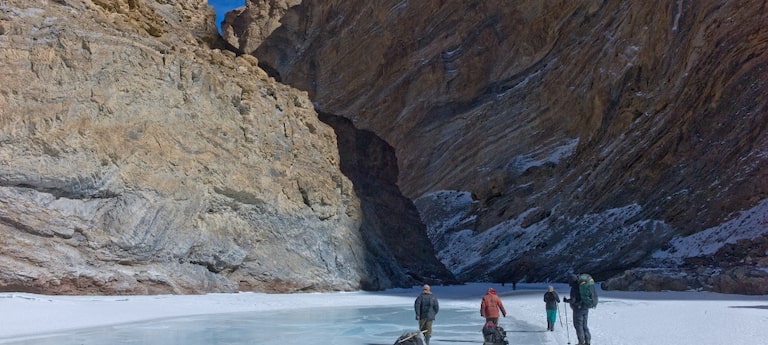
Package Details
Chadar frozen river trek, price (per person): ` 24,999, duration: 9 days, cancellation policy | payment policy.
In case the Chadar is not formed your local operator shall offer you the alternate trek for same duration. If a trip must be delayed or the itinerary changed due to the following events, then the cost of delays and/or other changes are normally the responsibility of the participant.
- Bad weather
- Road conditions
- Transportation delays,
- Government intervention
- Airline schedules
If Minimum group strength is not met, we have the right to cancel the departure. Should you wish to customise the trip as per your preferred date, separate charges will apply. Itineraries are based on information available at the time of planning and are subject to change. Tour operator reserves the right to change expedition dates or itineraries as conditions warrant.
You need to bring the Medical certificate from your respective city
Chadar Trek is surely going to be one of your most thrilling experiences of a lifetime. So, get ready for this exhilarating adventure and bring back home some embraceable memories. Cherish each and every moment of this trek and also share your amazing stories with the world
COVID 19 related Terms & Condition Adventure Nation shall follow Covid 19 Protocols as per the government guidelines applicable to it. However, it is made clear, that the individual participants are responsible for maintaining all such protocols and guidelines that are applicable at his/her own level towards the prevention and spread of Covid 19. If any participants develop any symptoms around Covid 19, it shall immediately inform the Adventure Nation's team who shall then follow and adopt all such measures as it deems fit under the situation. Adventure Nation's decision shall be final and all participants shall abide by the above conditions to ensure safely of himself/herself and the people around.
Adventure Nation shall not be liable for any loss, cost, expense, damage, delay, missed connections, or any other consequential damages or losses which may be the direct or indirect result of any actions taken by it as stated above.
Inclusions:
Exclusions:.
- Welcome & Greeting on Arrival at the hotel
- Accommodation in Leh - Stays in Guest Houses on triple sharing basis in Leh on Day 1, Day 2, Day 3, and Day 8 (Double Sharing for couples).
- Stay in Alpine/Dome Tents on triple sharing the basis on Day 4, Day 5, Day 6, and Day 7 (Double Sharing for couples).
- Breakfast when in Leh on Day 2, Day 3, Day 4, and Day 9.
- Celebration Dinner on Last Night in Leh.
- Skilled local staff who has ample knowledge of the route.
- Transportation from Leh to Trekking Point on Day 4 and Trekking Point to Leh on Day 8.
- Vegetarian meals on the trek (Breakfast/Lunch/Dinner) starting on Day 4 Packed Lunch to Day 8 Lunch.
- Common Kitchen/Dining/Toilet tents will be used during the trek.
- Cooks/Helper and other requisite staff.
- Porters for carrying common equipment’s (like rations/tents/utensils/groceries).
- Equipment – Sleeping bags / Sleeping Mats.
- Basic First aid Kit with a portable oxygen cylinder.
- The Facility of keeping extra luggage at Leh when leaving for the trek.
1. GST @ 5% 2. Personal trekking equipment – like Gum Boots, trekking poles or sleeping bag liners 3. Personal insurance or the cost of emergency evacuation 4. Purchases of personal natures (like mineral water bottles/bottled or canned beverages/chocolates/dry fruits etc) 5. Shared Porters for luggage offloading upto 10kgs (back pack or duffle bag only) is Rs. 4500/- and Private Porter max 20kgs will be Rs. 9000/- Potrers are subject to availability & need to check at the time of booking. 6. Room Heaters at Guest House in Leh(We suggest not to use the room heaters as the same dehydrate the body and your body won’t get acclimatize to gear up for the Chadar trek) 7. Cost of transport, meals and stay if in case you leave the trek in between and return to Leh before the scheduled arrival on Day 8 8. Wildlife permit fee/Medical check-up & Rescue/ALTOA NOC Cost and Adventure Insurance ; an approx. amount of 8000/- (subject to change without prior notice) 9. If your trek remains incomplete or uninitiated for any reason we will not refund, reschedule or replace any services that remain unutilized by you. 10. Any additional cost incurred due to do changes in Government Guidelines related to travel/trek/COVID-19 will be borne by the Guest. 11. Insurance of any kind.
12. Anything notmentioned under 'Inclusions'
Reviews for Chadar Frozen River Trek

It was amazing. Your management was very good. The best thing I liked about the trek was the people there. The guide, porters, their work as at the top, without them we couldn't trek.
Being an adventure enthusiast, Chadar trek had always been on my bucket list. But it wasn't until February 2018 that I ticked this off my list, and I am extremely proud of myself for completing it. The trek was challenging because of the below freezing temperatures, but kudos to the trek leaders, porters, cooks and organisers, who kept the camp running like a well-oiled machine. The trek leader especially kept me motivated throughout the entire trek. I couldn't thank them enough for their sheer efforts. A hearty thanks to Adventure Nation for fulfilling my dreams. I had the time of my life!
I saw the pictures of the frozen Zanskar river on a Facebook post by Adventure Nation, and I was awestruck by its beauty. I have always wanted to have an experience of this kind, so I enquired about the Chadar trek. I booked through Adventure Nation itself-which was an incredibly smooth process, and then started packing to leave for my epic adventure. The trek leaders were quite knowledgeable about the do's and don'ts and guided everyone cheerfully and patiently through the challenging terrain. All my tiredness was over when I saw Zanskar River with my own eyes. I was mesmerized by the beauty of the frozen river with the high mountains in the back drop. I had a phenomenal experience on this trek, and would recommend Adventure Nation to everyone!
The Famous Chadar Trek-what a paradise on Earth! Whether it's the trail, the high mountains surrounding you, or the frozen river, the entire trek keeps you on your toes with excitement. Walking on the frozen river and viewing the frozen waterfall were the best highlights of my trek. Whenever we camped, I was really pleased with the arrangements that had been made. And to put a cherry on the top, the hot food made by the cooks was a blessing. The trek guides were very responsible with the team, giving us time to acclimatise. The trek was amazing, and I am happy to have booked with Adventure Nation.
What a trek!!!! The best winter experience one can have is on Chadar Trek. From walking on the ice to camping at the riverbank, Chadar Trek holds nature?s one of best creation in its true form. Though it seemed difficult at the beginning but with constant support from the Adventure Nation?s team, I completed the entire 52 km walk. Also, I salute to the sturdiness of Zanskari people, they were a great inspiration.
It took me a while to convince my friend to book Chadar Trek. We had been on many treks but since Chadar is a little tough due to cold temperature and extreme climate, it took me time to convince him. After a lot of discussions, we decided to call Adventure Nation. We did not regret at all. To be fair trek was tough and little scary at some parts, but it was totally worth it. The team of Adventure Nation was phenomenal. The trek leader was inspirational, and the way he took care of the entire team was commendable. Thanks!
Almost a dream that turned into reality, the journey of Chadar Trek gave us moments that will stay fresh in our memories. Almost 5 of us were there. Thanks for the amazing service. The tents were in great shape and the food and other arrangement were also taken care of in the best way possible. Will choose Adventure Nation for another trek as well.
2019 was like a dream come true. I did Chadar trek in Jan which was way too cold for a trek. It was nothing I had ever seen. The still and frozen waves of the Zanskar River seemed like a race against time. I had great fun with other companions as well and made new friends. The service and the on-ground operation was great. Kudos to team Adventure Nation.
Chadar trek aka frozen Zanskar River is an amazing escape into nature if you are looking for a unique and out-of-the-box experience. Frozen in time, Chadar give people a dozen of memories that stays fresh for a lifetime. I would recommend this place to each and every trekker. Our group had great fun while walking - many of us slipped and spending time in the tent talking about travel. Also, I am grateful to Adventure Nation for giving us such amazing trek leaders for whom we were the first priority. Thanks a lot for this.
Similar Adventures
Cancellation policy.
CANCELLATION POLICY
Cancellation charges per person
30 days or more before departure: 25% of total cost 29 - 20 days before departure: 50% of total cost Less than 20 days before departure: 100% of total cost
IF WE CHANGE OR CANCEL YOUR ADVENTURE HOLIDAY
We do plan the arrangements in advance. It is unlikely that we will have to make any changes to your travel arrangements. Occasionally, we may have to make changes due to Force Majeure Events and we reserve the right to do so at any time before or during the trip. If there are any changes, we will advise you of them at the earliest possible date before or during the trip based on the Force Majeure Events. We also reserve the right under Force Majeure Events to cancel your travel arrangements / offer alternative dates / revise the itinerary before or during the trip. Any additional cost incurred due to the above-mentioned reasons will have to be borne by the traveller himself. There shall be no refund to the traveller under Force Majeure Events.
Force Majeure Event shall mean and include any circumstance beyond the reasonable control of Adventure Nation, including without limitation, any act of nature or the public enemy, accident, explosion, fire, storm, earthquake, flood, drought, perils of the sea, casualty, strikes, lock-outs, labour troubles, riots, sabotage, terrorists acts, embargo, war (whether or not declared), governmental actions, delay in issuance or processing of Visa/permit, change of laws and regulations, orders, or decrees, or other causes of like or different character beyond the control of Adventure Nation.
IF YOU WANT TO CHANGE YOUR ADVENTURE HOLIDAY PLAN
After you make full or partial payment, if you wish to change your travel arrangements in any way (e.g. your chosen departure date or accommodation), we will do our utmost to make these changes but it may not always be possible. Any request for changes must be in writing from the person who made the booking. All cost incurred due to amendment will be borne by the traveller himself.
Payment Policy
46 Days or more before date of departure: 25% of total cost. 31 - 45 Days before date of departure: 50% of total cost. 30 days before date of departure: 100% of total cost.
Important: The booking stands liable to be cancelled if 100% payment is not received less than 30 days before date of departure.
- Submit Query
Provide your details, we'll call back
EMI Options
*Including GST
Sign in to your adventurenation account, login to your account, invalid email address or password, sign up and get the best adventure deals, sign up & get best deals.
- Accessible Adventures
- Adventure Running
- Off Roading
- Outdoor Photography
- Wind Surfing
Invite your friends.
Sent you a adventure nation request.
You have been invited to join adventurenation.com, a community for outdoors enthusiasts where you can join Tribes, interact with Gurus and get up to speed on adventure activities and destinations
Suggested Friends
Chadar Trek - Book Your Bucket List Adventure!

Starting from
₹ 23125 ₹ 18500 +5% gst.
- 9 Days 11,100 ft. 62 Km
- Difficult Ladakh
- Best season : Jan, Feb
Trek Highlights
- Unique experience of trekking on the frozen Zanskar River.
- Amazing scenery, wild gorges and frozen waterfalls.
- It is an adventure-seeker's paradise.
- The frozen river which connects Zanskar valley to Ladakh.
- It's one of the thrilled and adventurous treks in India.
- The frozen river called Zanskar.
- Walking on an ice sheet is the most iconic thing one experience in the Chadar trek.
Inclusion/Exclusion
- Inclusion in cost during the trek:
- Airport Pick and Drop.
- Welcome & Greeting on Arrival at Guest House.
- Accommodation at Leh in Guest Houses on Double sharing basis on Day 1, Day 2, Day 3, and Day 8.
- Breakfast when in Leh on Day 4, and Day 9.
- Skilled local staff with years of experience in Chadar and Zanskar region.
- Transportation from Leh to road head on Day 4 and road head to Leh on Day 8 (Sharing basis).
- Vegetarian meals on the trek (Breakfast/Lunch/Dinner) starting on Day 4 Lunch to Day 8 Lunch.
- Hot water in buckets shall be provided on request while staying in Guest House in Leh.
- Stay in Alpine/Dome Tents on Double Sharing the basis on Day 4, Day 5, Day 6, and Day 7.
- Common Kitchen/Dining/Toilet tents will be used during the trek.
- Cooks/Helper and other requisite staff.
- Porters for carrying common equipments (like rations/tents/utensils/groceries).
- Double Layered sleeping bag and 1 inch sleeping mattress.
- Basic First aid Kit with a portable oxygen cylinder.
- The Facility of keeping extra luggage at Leh when leaving for the trek.
- Celebratory Team Dinner & certificate distribution on Day 8.
- Exclusion in cost during the trek:
- Mandatory GST of 5% on Invoice Amount.
- Any personal trekking gears – like Gum Boots, trekking poles or sleeping bag liners.
- Adventure insurance and the cost of emergency evacuation.
- Any personal expenses like purchases of beverages/bottled water /chocolates/dry fruits etc.
- Shared or Private Porters for carrying personal luggage.
- Room Heaters at Guest House/ Hotel in Leh.
- Cost of transport, meals and accommodation if in case you have to leave the trek in between and return to Leh before the scheduled arrival i.e. Day 8, due to any reason like accidental, personal or force majeure.
- Wildlife permit fee/Medical check-up & Rescue/ALTOA NOC Cost and Adventure Insurance; an approx. amount of 5,500/- (subject to change without prior notice)
- Anything other cost which is not mentioned in Inclusion.

Have any question?
contact us @
+91 8958094170
- OVERVIEW & ITINERARY
- THINGS TO CARRY
- SAFETY & SECURITY
- FITNESS TIPS
Short Itinerary:
Day 1: Fly to Leh.
Day 2: Acclimatization in Leh (Rest/ Mild walk).
Day 3: In Leh (Get Medical, Insurance, Wildlife Permit and ALTOA NOC).
Day 4: Drive to Shingra Koma (Tsomo Paldar).
Day 5: Shingra Koma to Tibb Cave.
Day 6: Tibb cave to Naerak camp.
Day 7: Naerak to Tibb Cave.
Day 8: Tibb Cave to Shingra Koma and drive back to Leh.
Day 9: Return from Leh.
Available Departure Dates:
Note: If you are more than 6 person you can ask for your preferred dates.
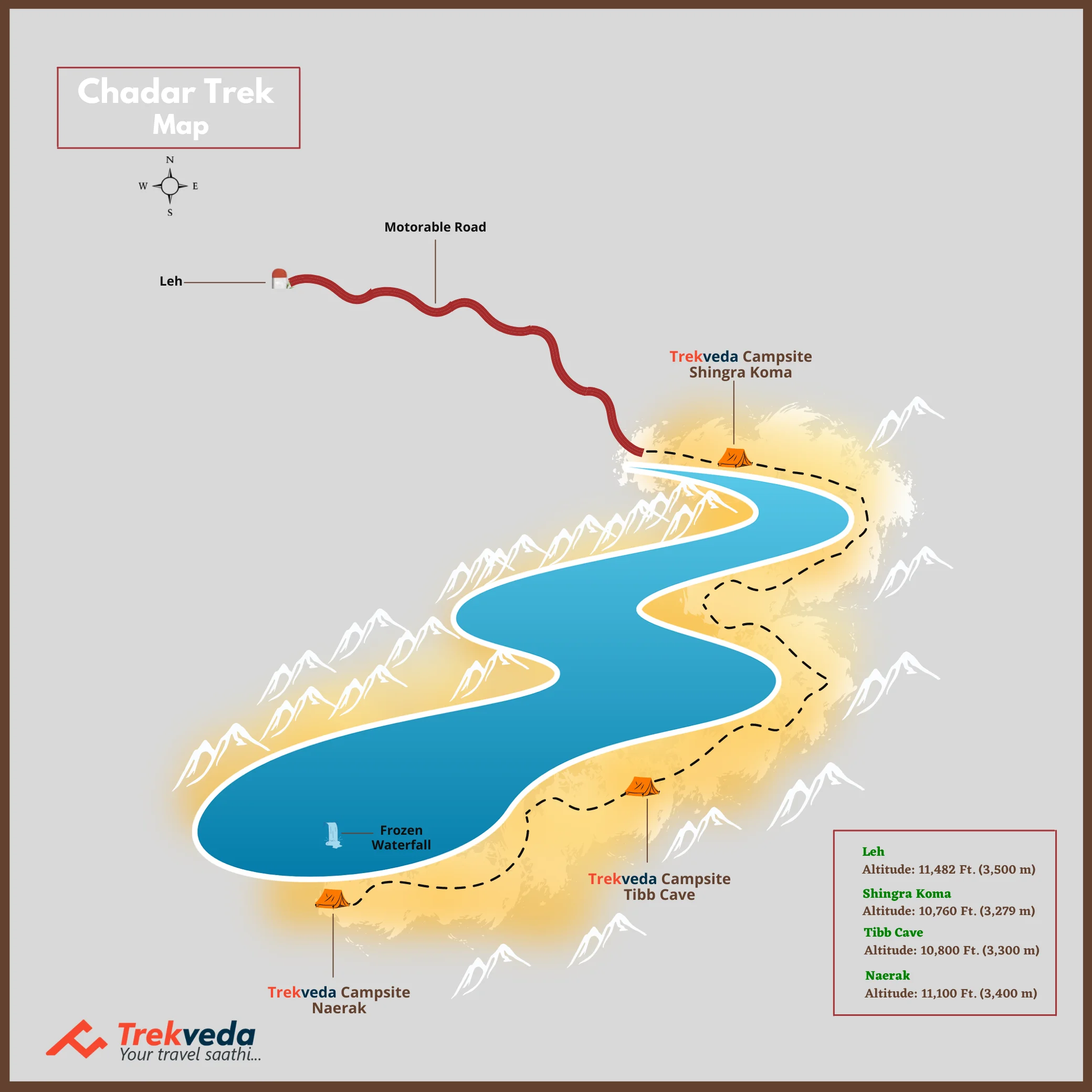
The frozen Zanskar river Trek is the chadar trek Ladakh and its main attraction is the frozen river of Zanskar made from the ice sheet. It connects Ladakh to Zanskar and takes place on a trade route used by indigenous people for centuries. The chadar trek Ladakh is perfect for people who want a thrilling winter experience like never before. The frozen lake trek in Ladakh is one of the most popular ways to experience a completely different side of this region.
Chadar Trek is one of the most thrilling and adventurous treks in India. The frozen Zanskar River provides endless opportunities for camping and skiing. Chadar Trek is one of the most popular adventure activities for tourists visiting Ladakh can witness the beautiful view of photography.
Chadar Trek best time is from January to February when the frozen Zanskar river freezes into an ice sheet. The campsite at Nerak will be the coldest of all on the trek, with temperatures dropping as low as -30 degrees during the night.
The thrilling walk becomes challenging for trekkers when the frozen Zanskar river freezes over. Though treks in India are well known, Trekking in Jammu and Kashmir like the chadar trek Ladakh is one of the most beautiful treks, as you walk on the frozen river. The Chadar Trek best time is mid-January to end-February when most groups trek the frozen river in their Chadar Trek packages.
What makes this Trek Different?
Walking on an ice sheet is the most iconic thing one experiences in the chadar trek Ladakh. In the world of trekking where you do summit treks, and ridge treks amongst those you get the chance to walk the ice sheet, a frozen Lake trek in Zanskar valley. The culture of Ladakh and the life of people beyond the modern era are so dynamic that make this trek a different one.
Difficulty Level : Chadar Trek
Trekking in Jammu and Kashmir like the Chadar trek is that it's not easy to get accustomed to the harsh climate, which turns the trekkers' exhaustion. Therefore there is a need for high endurance and expertise while picking the Chadar Trek package.
Highest Altitude : Chadar Trek
The highest altitude of the Chadar Trek is 11,123 Ft. this is the average highest, but the trekking is so tricky because of the climate condition of the trek.
Is it suitable for Children's?
No, trekking is not for children because of its high altitude and temperature condition. Therefore Chadar Trek package is not for Children.
Season : Chadar Trek
The best time for the Chadar Trek package is between mid of January and early February.
Trek Itinerary : Chadar Trek
Altitude 11,400 ft.
Stay in guest house.
Keep your woollen cap and gloves handy.
Landing in Leh at the 22nd highest commercial airport in the world which is “Kushok Bakula Rimpochee” airport; The airport is named after 19th Kushok Bakula Rinpoche, an Indian statesman and monk, whose Spituk Monastery is in direct vicinity to the airfield. Where our guide will pick you up from the airport and you will be heading to guesthouse, throughout the way you will get the idea about the lethal temperature with push back air flow; after reaching to the guest house you can freshen up yourself and can get all the essential equipments and cloths for trekking. There is a market called “Old Tibetan refugee market” which can help you to make your mood relax, and after all over the market session; you will get back to the guest house before the sun goes down as per our safety norms.
All the health-related issues that trekkers can face, as per the new regulations applied by Ladakh Government Authorities, this acclimatization is giving to the trekkers so that anyone doing the Chadar Trek should be at least spend one day in Leh to get their body used to of the weather conditions here, every trekker strictly follows that. You can spend the day shopping at the Leh market. It is essential that you get used to the cold temperature in Leh because the frosty weather will only tend to fall as you start walking on the frozen Zanskar.
Basically, it’s a day where we provide expertise guide along with local people to give you a brief about the trek. At least you’ll get mentally as well as physically prepare for every situation; even though we provide medical check-up to make sure whether you are fit for the trek or not. You can do some exercises which help you to get fit for the trek. Sightseeing would be a good idea to get habitual with temperature but only in the daytime, you need to come back to Gust house before sunset. Alcohol and smoking are prohibited during a trek along with camp and guest house area as per our safety norms.
Altitude : 10,390 to 10,550 ft.
Trek Distance : 10 km
The day will start with some challenging steps like to get out of your comfortable and cozy shelter but you have come so far where Cristal white Chadar will be waiting for you to take away on it, mind your steps on snow bail roads because you will not be familiar as much as localities are. You’ll drive till Nimu where Indus & Zanskar meets, military sub area with some Bourg houses shut down the cause of weather. This day will cover 10 km at least; while walking on the side of Chadar and glimpses of slush appear to keep drift away with the flow. After an hour you’ll be in Tilat Sumdo; this will be the very 1st place where you can see Tibetan tribes people. Singra Koma is 9.5 km from this place; an average trekker takes 6 hours to reach. After a bit, you’ll get used to of walking on Chadar, it’s like a nature treating you with skating adventure. Camp food after fatigue day will make your mood on; at the parabola edge exactly bang on the river Gyalpo is located. It seems handmade white frost spread around; humongous trail will make you feel safe and protected. After night meal retains your only liveliness in trek and inverts from stockpile for next day.
Altitude : 10,550 to 10,760 ft.
Trek Distance : 15 km
Applause yourself for the next day with a bed tea in the early morning, after having breakfast we’ll move towards Tibb cave. Eat well it gives you the energy to walk; even though walk makes your body warmer than meals but still for safety purposes, as well as for this day because the day will be the harder than the previous one and here you walk around 15 K.M. at least. Through gulches of Zanskar will seem more beautiful and adventurous. While walking on the way tunnels will be visible, it seems rock solid with ice pelted. In mid-way, frozen waterfall reminds you-you're all Disney cartoons from childhood because the waterfall will be big from one another. Crossing up the frozen waterfall, you cannot miss the chance to show your photography talent here and it will compliment your talent perfectly. Tibb cave is a gift from Zanskar valley to Tibetan carriers. Butter tea, also known as Po cha will surprise you with the texture of teapot; it will help your healing chapped lips.
Altitude : 10,760 to 11,150 ft.
Trek distance : 12.5 km
Attraction : Frozen waterfall
Yesterday’s curiosity will be there about frozen waterfall because the big one is about to come. It’s a perfect example of witchcraft of nature where several colors are spreading all around; it’s more like a piece of glass made by nature I would rather say. Getting after the source of energy through the day meal you can say, the Skycaps Mountains seems to be struggling with the sunlight. The only thing which connects the river to the valley is the bridge which you can see only in summers. Outstretch tent will prepare night meal for you till then if you want to get colored into Zanskari life you can. You’ll forget your 12.5 km journey in just a few moments.
Altitude : 11,150 to 10,760 ft.
The day is about going back to Tibb Cave, but this is not too easy to do. Cause temperature will surprise you all the time till morning to sunset. On the way you’ll get the glimpses of nostalgic memory where u had struggle to reach there and some clicks on your mind, the local people fresh up your memory more when they come back from Leh to their villages. Kind of positive and to be a happy kind of attitude will make you feel if they can why don’t you. Name of some Zanskari lifestyle fatter getting yesterday’s session; you’ll automatically speak like Goucha (Woolen robe) and colorful sash Schrage.
Altitude : 10,760 to 10,550 ft.
Trek distance : 15 km.
From the home of Tibetan, carriers will be a bit nostalgic. The day will start towards Shingra Koma, the humongous trail with white coated Gyalpo seems to be reachable after an hour, but it’s not. Because we have to cover around 15 km or more than that as you already saw and got the idea about Gyalpo it’s a summit of the enormous mound, so it will be such a great thing to be the part of an indelible moment. Some descry feeling can get you some Himalayan animals.
After departing from Leh this journey will remind you always be the part of the land beyond the world but located in J&K. The people are behind the wall of snow, Brave Zanskaien I must say, that innocent smile overlaps your smile when you ever think about your Chadar trek experience. Respect comes from the heart for the people from Ladakh valley to be so Patriotic for their land. Linguistically they are different but they are more prominence than anyone because nature blesses them well.
Chadar Trek: Essentials
Trekking, no doubt, is one of the most thrilling adventure one could ever have in his/her life. With an elegance of nature and unmatchable experience of the pristine mountain ranges, trekking stands out among all the adventures across the world, but nothing comes free, there are certain aspects of the trekking which one needs to consider while he/she is making up his/her mind for trekking. Here’s a list of some basic requirements which one would need during his/her camp trekking. Let’s pay some heed to these prerequisites for trekking.
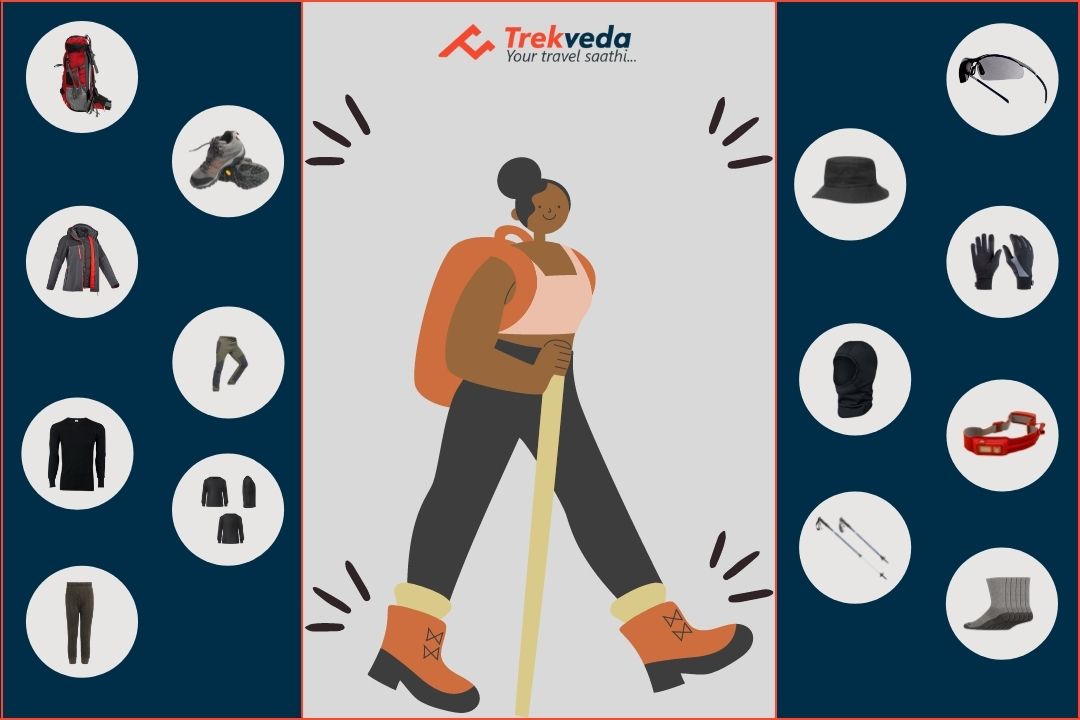
Things You Can’t Afford Missing On Trek
1. A Sturdy Backpack/RukSack
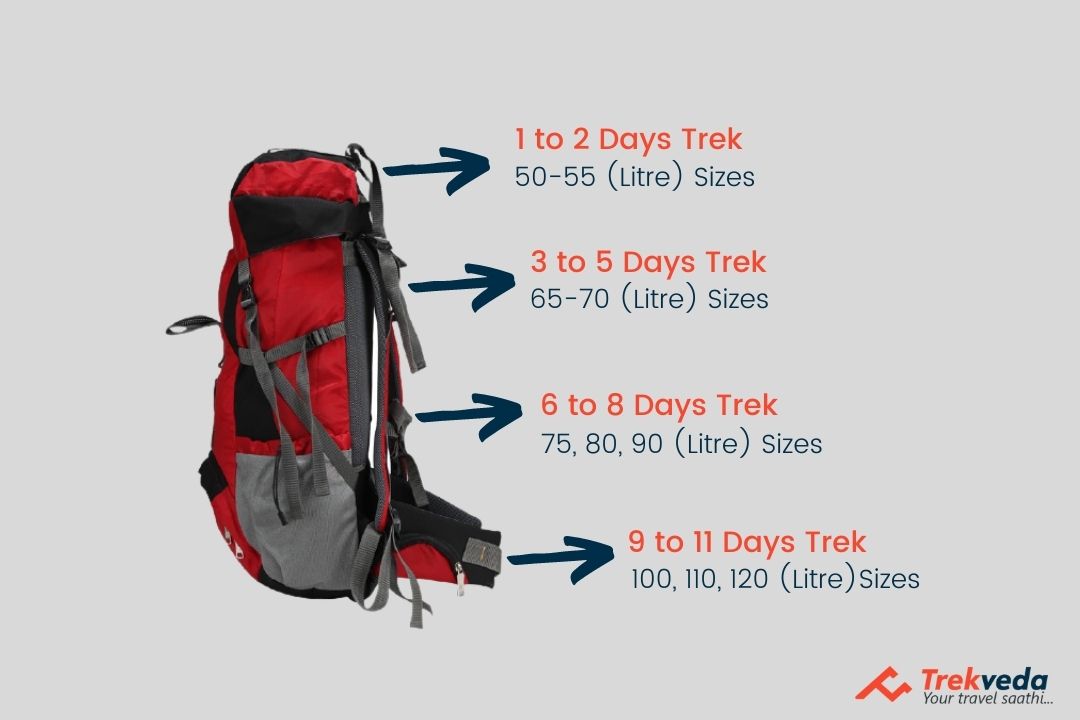
A high-quality backpack with an ease of carrying facility with durable and stern straps is one of the pivotal thing that you’d need during the entire trekking. The easier it’s to carry, the more fun you can have during your trek.
2. A Pair of Trekking Shoes
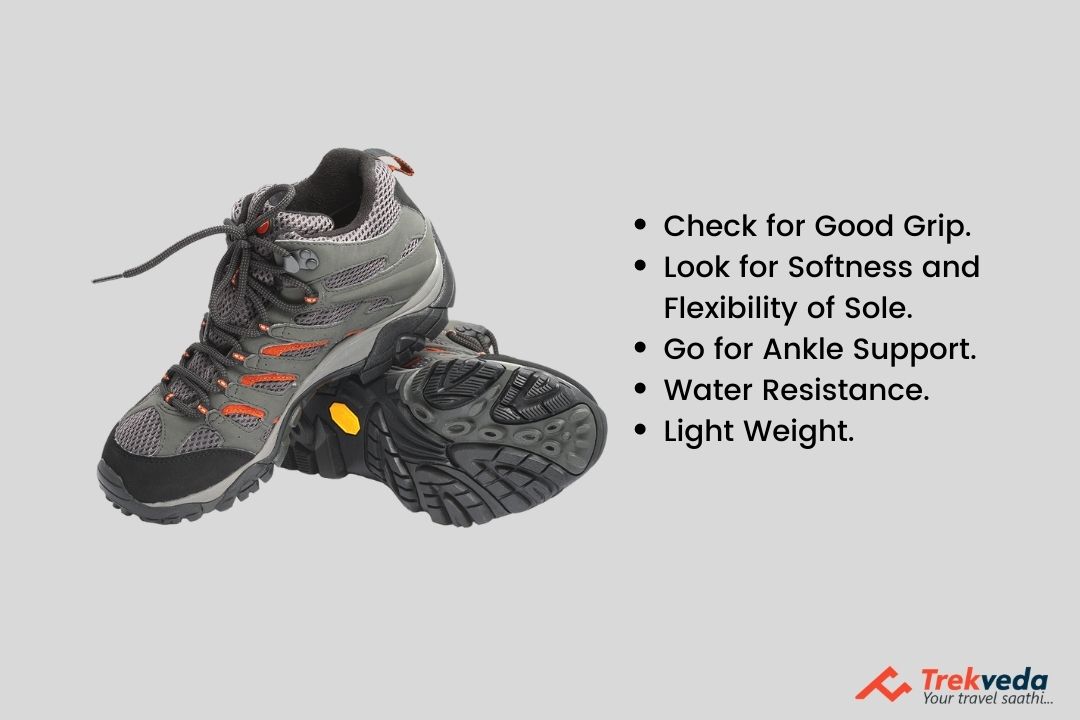
Your regular sports shoes can be a mess during the trek and one of the most regretting thing that might take away the joy of trekking. To prevent yourself from slippery patches through the streams, a pair of trekking shoes with good grip would do a great work for you and reciprocate your experience of trekking to the manifolds.
Clothing is one of the most important aspect of trekking but that doesn’t imply the “what if situation”, hence carry the clothes that you’d need normally. Carrying more and more clothes will only add the weight, thus problem. Once on the trek, you’d not generally need to change the clothes every now and then, provided if you maintain your hygiene properly.
Three Warm Layers Jacket

On high altitude treks, temperature after the sunset drops to the considerable degrees. So during these campsites, you might need an additional layer along with the padded jacket coupled up with a fleece and a warmer.
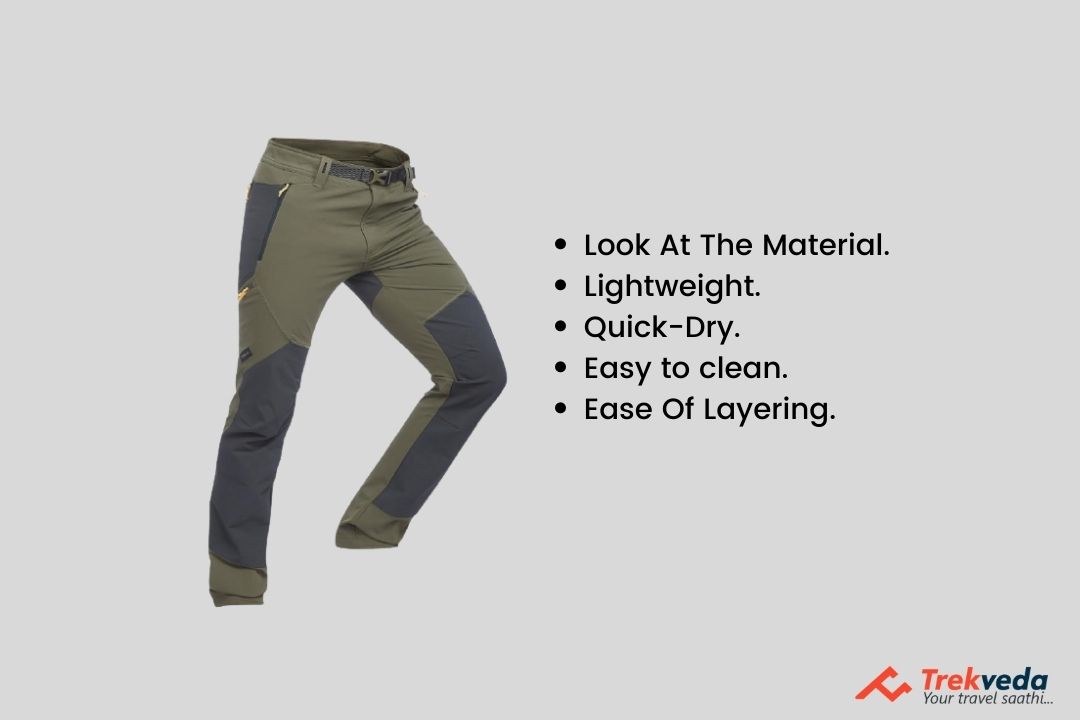
Please don’t go for jeans/ denims for the substitute for the trek pants since they’d not add comfort to your stay at the campsites. Wear one pair and carry the remaining two.
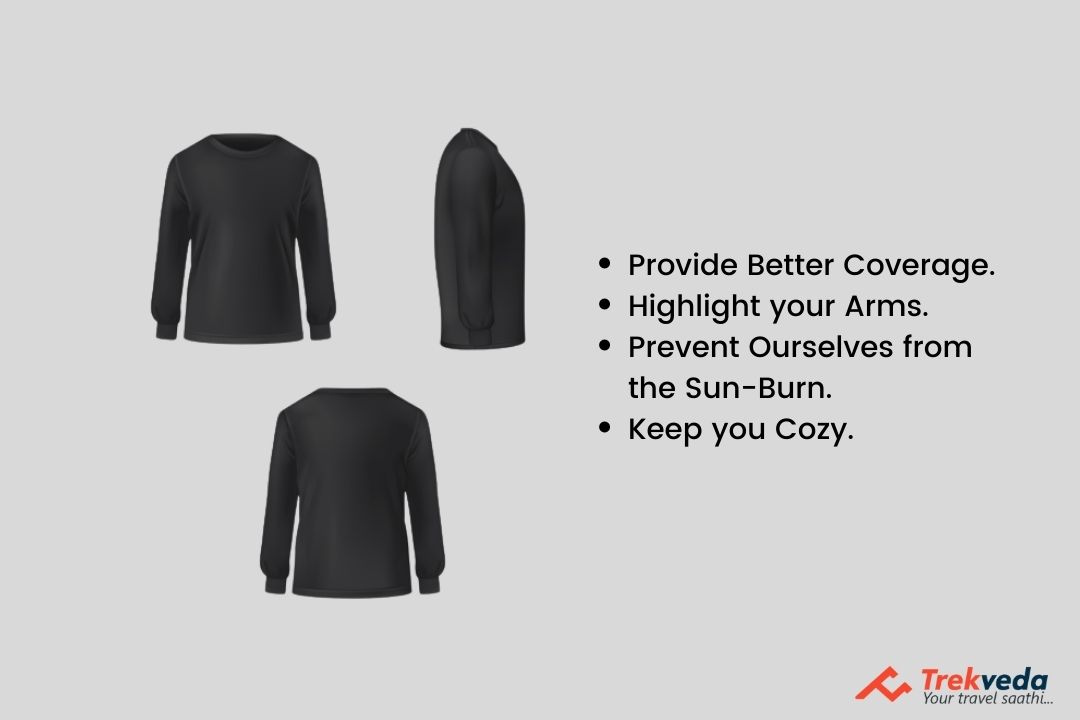
It’s advised to wear full sleeved t-shirts in order to prevent ourselves from the sun-burn. Carrying a dry-fit t-shirt or two can be a wise idea if you’re trekking during the rainy season. Regardless of the cold weather, trekkers’ bodies tend to sweat and to prevent yourself from falling ill, you’re advised to change your clothes at campsites.
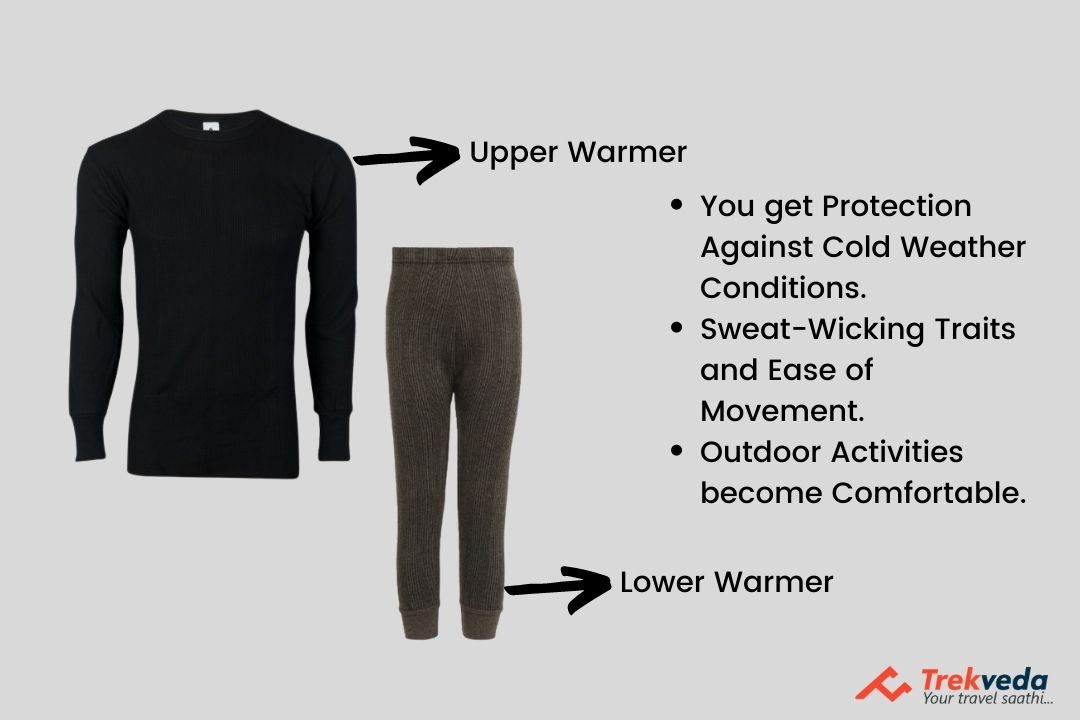
Warmers or thermals can be added on one’s own concern related to their health and their exposure to the cold climate.
Accessories
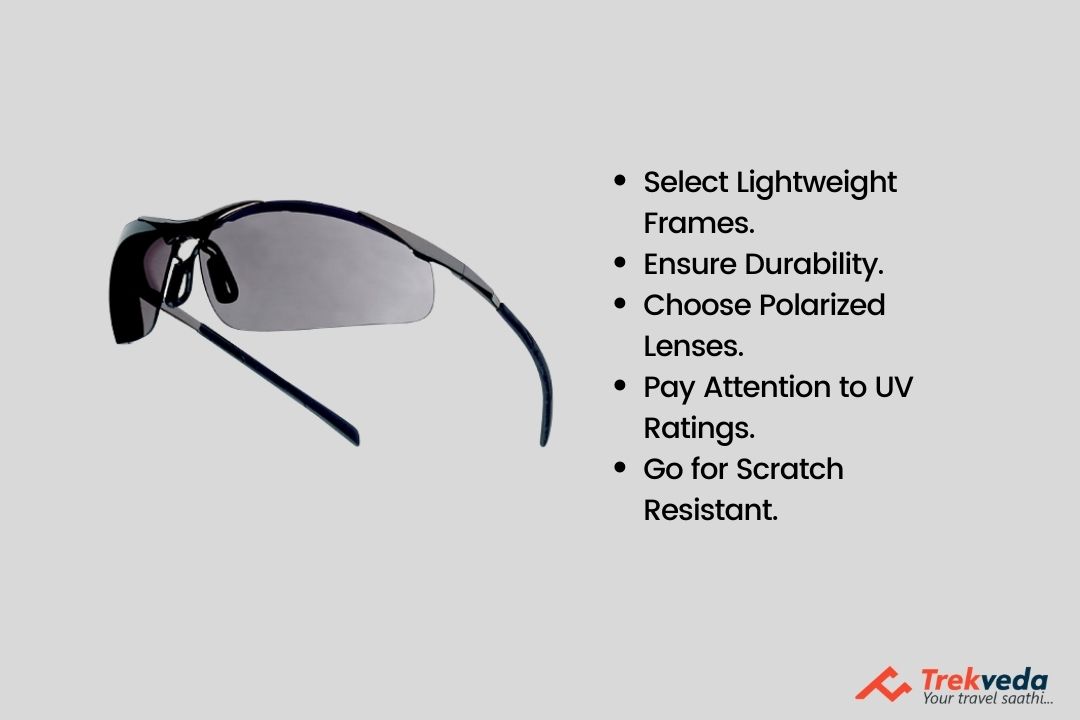
Sunglasses are to counteract snow visual deficiency. While at the same time you're probably not going to discover snow in October, convey a couple in any case.
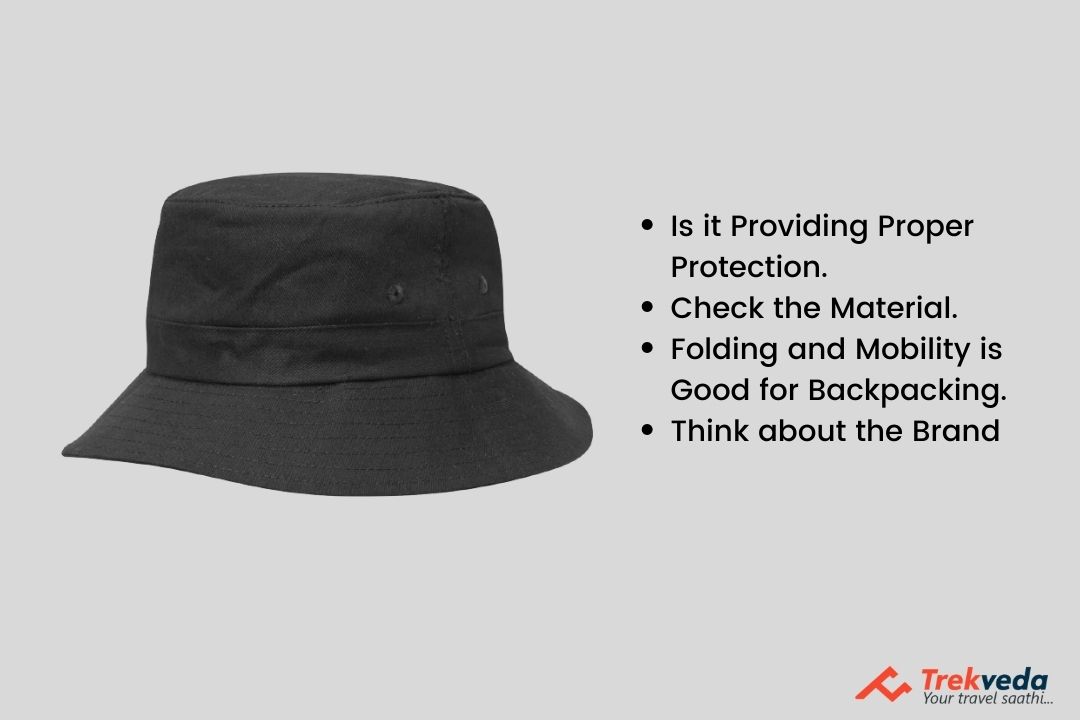
The sun feels more grounded while at the same time strolling on the mountain slants. Convey a sun cap to shield your head and neck from the warmth, particularly in case you're trekking later in the day.
Engineered Hand Gloves
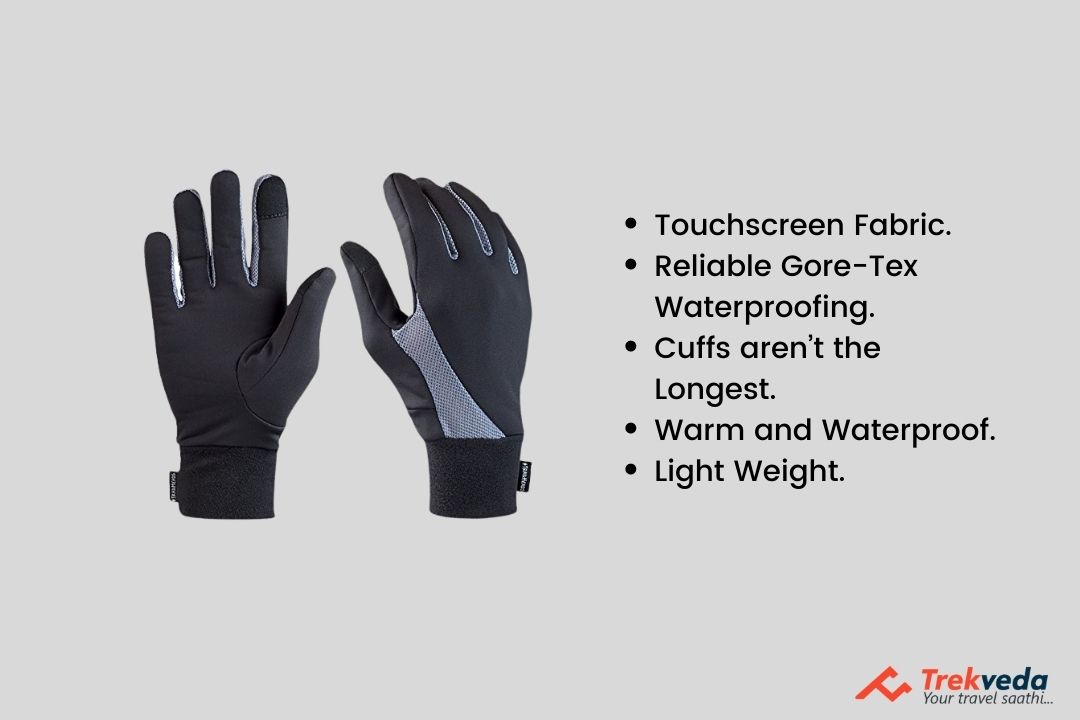
One sets of downy or woolen hand gloves. One sets of water evidence/safe, wind verification gloves.
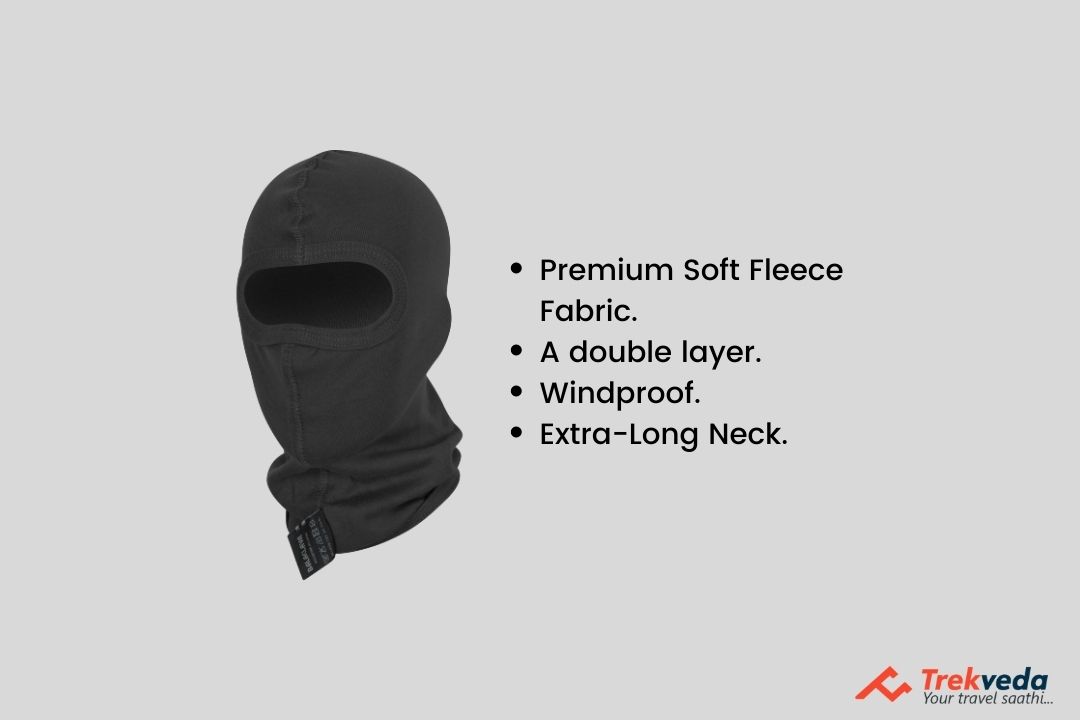
You may utilize woolen scarves rather too.

A part from two sports socks, you can take a couple of woolen socks for the night as they’d spare you from the dripping temperature.
Headlamp/LED Burn
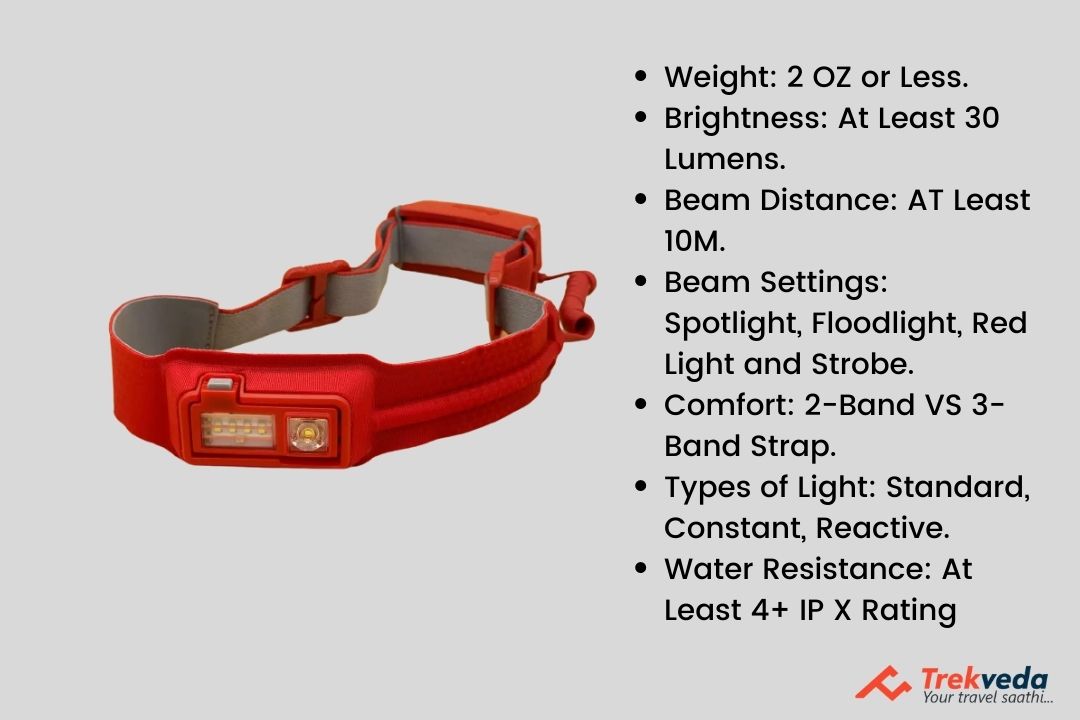
Trekking Pole
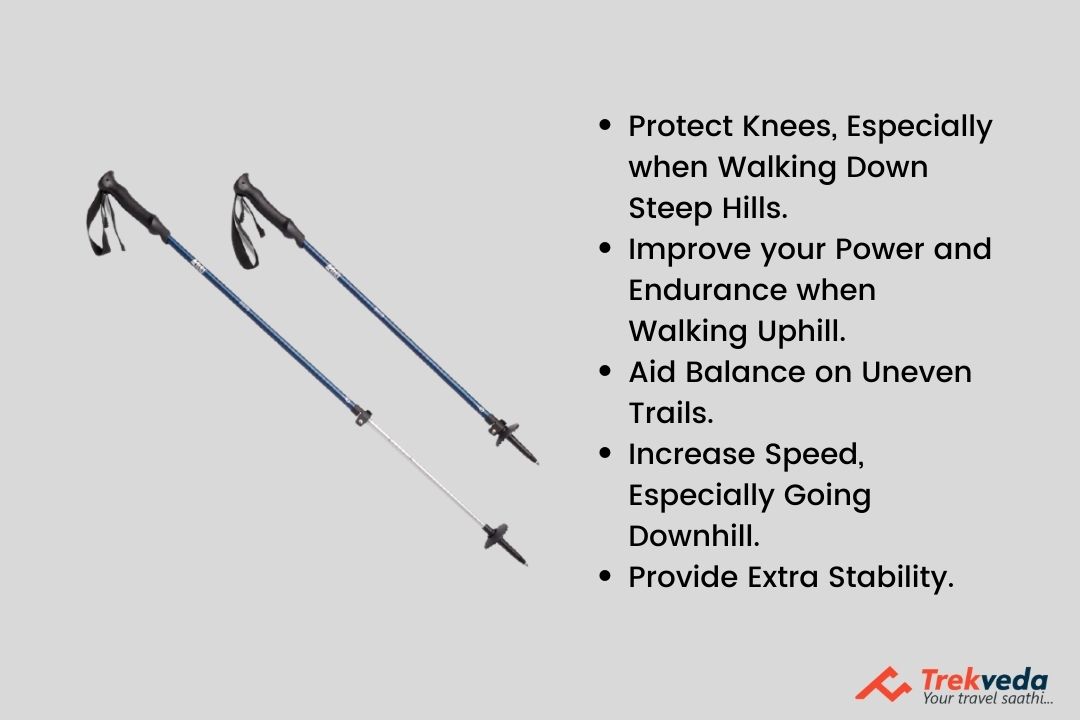
Having a trekking pole in your hand during the trek is boon, although at times it may bother you as an unnecessary article but it proves out most handy during the submit as it curbs your effort of straight inclinations of the high altitudes which often turns out tiring.
Other Essentials to Carry
An Additional Pack: This is one of the best practice you can do on one-day submits or treks where you need to get back to your campsite by the end of the day. Here you can pack your essentials like, water bottle, medical aids and snacks. This keeps you away from carrying the unnecessary weight.
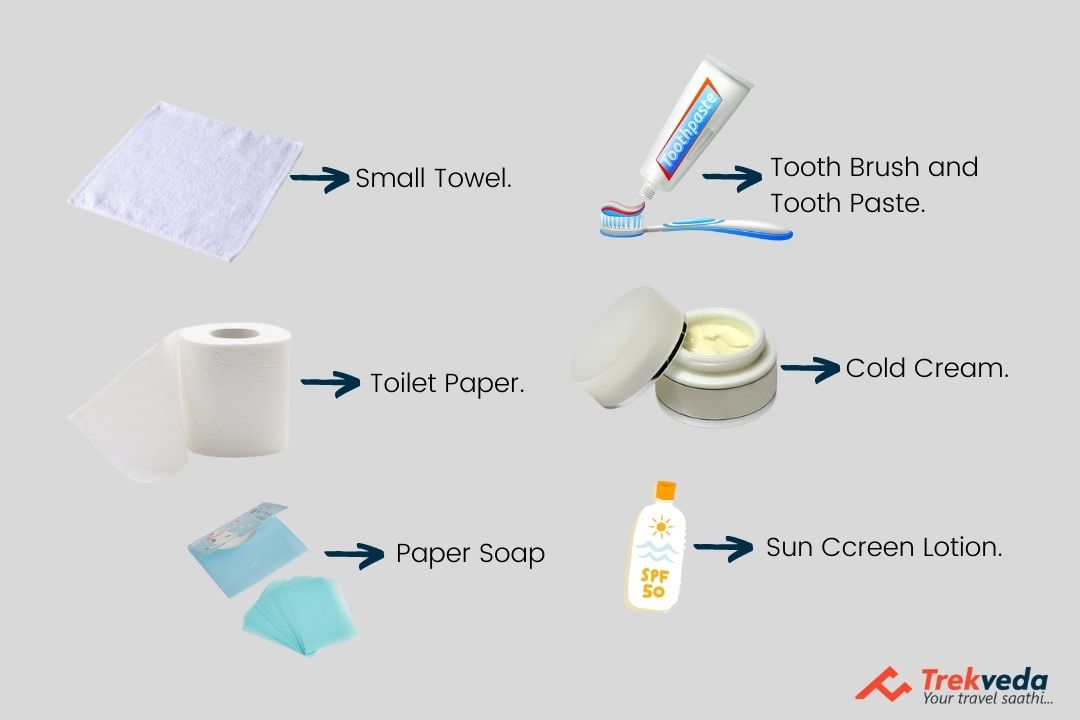
Be wise while choosing your cosmetic needs and daily use products. Refrain from using the non-biodegradable products, if you do so then make sure that you leave residue on the mountains. Always carry a zip bag to put such piece of stuff after use. Sanitary napkins also needs to be treated in the same manner.
Indispensable Water Bottles
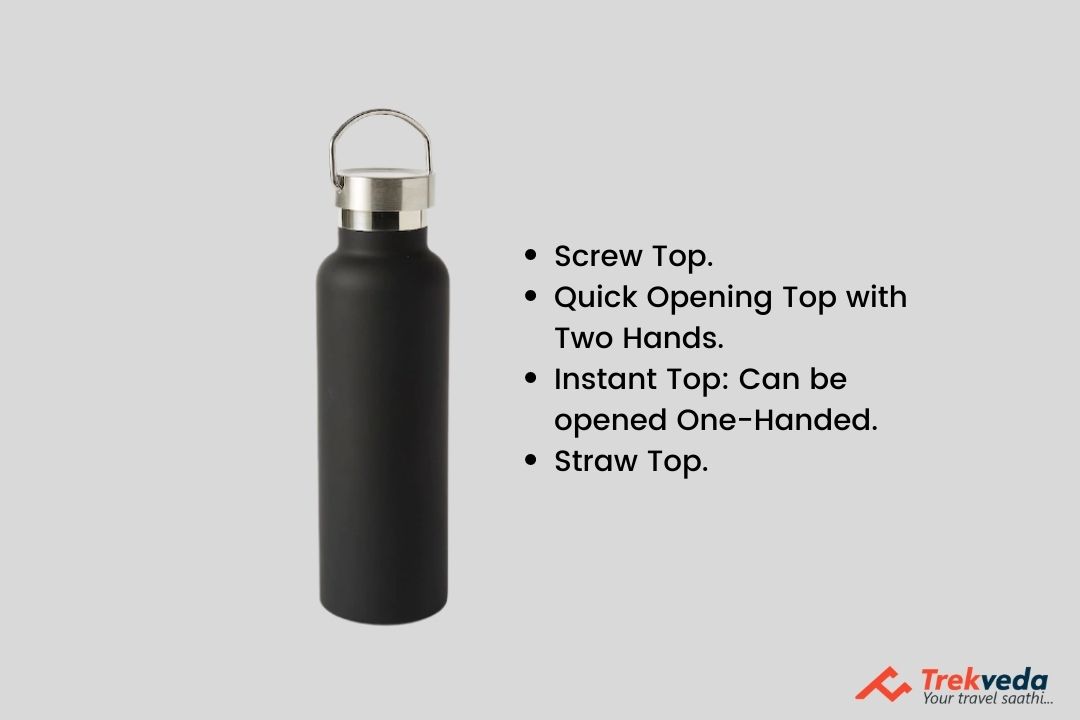
To keep your body hydrated during the trek, you are advised to carry your own water bottles during the treks since leaving plastic and its product is not advised on the mountains since they are not suitable for the environment of the altitudes.
Plastic Bags
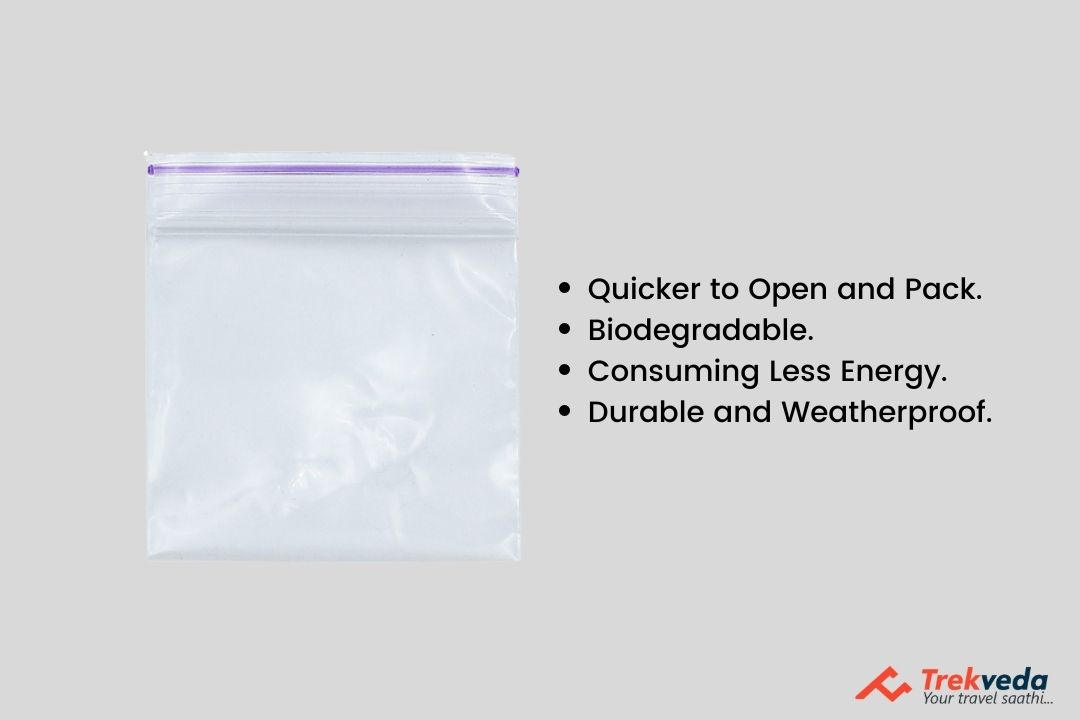
To keep everything organized, you should compartmentalize the stuffs into plastic zip bags and also carry a few in spare for wet clothes and other by-products.
Mandatory Documentation
There are certain rules and laws that you need to abide by, while going for the treks, however Trekveda takes care of all such kind paper works which is inclusive in the package. Certain registration fees and document verification along with some permissions are required in order to protect the nature and its evergreen heritage for future. In addition to this, if you need to avail a guide, you can also hire a guide with some bucks and a nominal paper work.
Please carry the documents mentioned below. Documents two and three need to be downloaded (PDF), filled in, signed and handed over to the trek leader at the base camp.
- 1 passport size photos and an original + copy of government photo ID document – required for Sanctuary registration and TIMS (Trekker’s Information Management System)
- Medical Certificate (first part to be filled by a doctor and second part by the trekker)
- Disclaimer form (to be filled by the trekker)
Measures Taken by Trekveda to Ensure the Security of Trekkers
Trekking is altogether a different kind of adventure where you required to be physically and mentally prepared for the best and adverse, all at once. With high altitudes making it tough to breath, the scenic beauty of those pristine mountains leave you spell-bounded so that you forget to breath for a moment or two. In addition to the physical and mental preparation, there are certain aspect of the health that are needed to be considered at the first hand when you make up your mind for the trekking,
Trekveda, by dint of its team of trained professionals, leave no stone unturned to provide you with the best trekking experience while ensuring your safety as its priority. Here are some vital aspects that Trekveda includes in its checklist to ensure the safety of its trekkers.
Criteria for Fitness Analysis
Trekking at high altitudes demands endurance and fitness and those who are prone to any kind of physical or physiological ailments are advised to not to go for high altitude treks in the beginning. To get assurance about the trekker’s fitness, we comply with certain aspects of the being fit such as BMI (Body Mass Index) along with the fitness proof since we can’t put the trekkers into the risk.
Acclimatization is another important aspect when it comes to getting an adaptation to the climate at the high range treks. A day at rest is not just the rest but a chance to get used to of the place and its habitat.
Monitoring the health is one thing that is conducted regularly during the trek by the trek leaders which includes the monitoring of your blood pressure, oxygen level and pulse rate. Details of your health during the trek is maintained in the health card on the regular basis. Health card can be collected from the trek leader at the end of the trek.
Medical Kit for High Range Trekking
An ideal medical kit that’s developed for the trekking has Blood Pressure Monitor/checker, Stature, Oxygen checker and Oxygen Cylinder coupled up with certain must have medicines, in case of medical emergency:
- Dexamethasone
- Asthalin Inhaler
Trekking Equipment for High Altitudes
Trekveda provide you all the necessary equipment for trekking from tents to ropes. In addition to that, our trek leaders also ensure the safety by various safeguards they take time to time for your safety. Micro spikes are provided to attach to your shoes which help you to keep the traction on the snow and make it easier to climb. An additional gaiters are provided to cover the shows which prevent the entering of snow into the shoes. Customized tents are provided to the trekkers which ensure the warmth and temperature 10 degrees higher than the outside coupled up with high quality sleeping bags which can endure the temperature up to 15 degree Celsius below the freezing point.
Nutrition and Hydration
Trekveda, keep all your nutritional and hydration requirements on its checklist, our trek leaders will guide you to keep your body hydrated on the high altitudes as de-hydration can attract to the severe medical emergencies on high altitude treks.
We provide the highly nutritious meal to energize your body for the trek, however before certain long trails we ensure your nutritional requirements to be fulfilled with some high energy snacks or packaged lunch.
Make sure you keep up with your hydration and nutritional part as this can lead to some fatal consequences for your health.
In case of any symptoms you feel during the trek, don’t ignore or avoid them, immediately tell the trek leader.
Keeping up with the pre-defined processes and the guidelines will help you to have a memorable trekking experience.
What Trekveda has to offer in case of medical emergency like AMS, HAPE or HACE?
In case of medical emergencies, Trekveda and its trek leaders bear the sole responsibility to get you back to your wellbeing with their training and techniques. Suspecting any physiological disturbance in your body, immediately report to your trek leader as they are trained to counter such problems.
Problems like Acute Mountain Sickness can be prove fatal if not taken into consideration seriously on time. If you encounter/experience any of the symptoms such as persistent headache, fatigue or weakness, nausea, dizziness, loss of appetite, difficulty in sleeping, you shouldn’t let it go or treat it by your own either.
Acute mountain sickness is one of the most common yet the fatal problem trekkers face due to number of reasons, if the problem continues to persist, then you’re advised to descend down to the basecamp and then to visit the doctor immediately.
People with AMS are treated with number of medicines such Diamox, Nifidipine etc. coupled up with methods like Triple One Test- where one disprin is given with a liter of water along with the rest for an hour.
While AMS is most common at the high altitudes yet it can’t be risked taken casually as it leads to severe fatal conditions like HAPE (High Altitude Pulmonary Edema) or HACE (High Altitude Cerebral Edema) which, if not treated on time can lead to number of serious chronic disorders. These conditions need to not to comply with AMS, they can occur without AMS preceding.
It’s suggested to take every single disturbance into the consideration while you’re on the trek.
However, Trekveda is capable of tackling all the medical emergencies with its trained professionals yet there are several things that you need to consider, specially the intake of medicines and the knowledge about their advantages and side-effects. Don’t administer the medicine if you’re trekking through an organization, always seek help from the trek leaders, they are trained for such purposes, while in case of being a solo trekker, you should know about the medicines.
Keeping yourself hydrated and nutritionally fulfilled curbs the chances of AMS.
Risk and Response
A high altitude trek requires an audacious state of mind, however leaving on a bold excursion without computing the dangers is absolute idiocy. That is the reason we have recorded a couple of Risk and the Response arranged by Trekveda to limit or address the dangers in the most ideal way.
Risk: Altitude
Before you begin the trek, it is critical to comprehend the ramifications of high altitude on your body. Know about side effects of AMS (Acute Mountain Sickness) like mellow cerebral pain, queasiness and general distress.
Response: If you feel any of these indications, illuminate the trek pioneer on need and take after his directions. Each campground has as stretcher, completely prepared medical aid pack, oxygen chambers to address the circumstance.
Risk: Weather
Weather is unusual in the Himalayas. Despite the fact that we are constantly attentive about the evolving climate, nobody can ensure a snowfall, rain or Sun. Do comprehend that your security is of most extreme significance to us and we won't continue any further from the campground if the climate isn't ideal.
Response: The choice of the Trek Leaders and Guides to continue or sit tight for the climate to show signs of improvement will be last.
Risk: Injuries
Often, while trekking over troublesome territories, you may have minor wounds like leg sprain, wounds and so forth. Genuine wounds like breaks or real cuts are exceptionally uncommon.
Response: All our Trek Leaders are Certified Wilderness First Aid responders. They are prepared to deal with crises and can handle minor wounds with an all-around prepared medical aid unit. If there should arise an occurrence of genuine wounds, the patient is carried on a stretcher to the closest street head and is directed to closest therapeutic focus.
Risk: Lack of Communication
In the remote zones of the Himalayas, portable systems don't reach. On a trek, one is cut off from the universe of calls, SMS or WhatsApp Messages.
Response: We’d depend on walkie-talkies and sprinters to communicate between the campgrounds and the base camps.
Pre-Trek Preparations
Trekking, for its ever-lasting memories and experience, demands just a few things which involve physical endurance with physiological wellness. Not just the one who’s physically fit would do the magic in trekking but one also needs to be mentally fit as well in order to cope up with the adversities one might have to face during the treks such natural calamities, rains or other unforeseen conditions. To keep up with such requirements of trekking here are a few things you can do to get yourself physically fit.
Prerequisites of the Trek
Cardiovascular Endurance and Stamina
Cardiovascular endurance is the primordial thing that this trek asks for along with the stamina to withstand the stringent conditions during the trek. There are number of ways you can increase your endurance level but Jogging regularly with gradual increase in the pace would do the magic in just 2 or 2 and a half months. You can also increase your endurance and stamina through swimming, cycling and much more.
Combining the speed and distance target is the most effective way to get your body and mind prepared for the Trek. If you’re planning to build your stamina in a phased manner then here you should pay heed to:
- Target completing the distance of 5 km in 35 minutes or less at the beginning
- Pace up your legs to complete the 5 km in 30 minutes or less
- Before you begin the trek, you should be able to complete 10 km in 60 minutes or less
To build the strength is another most important thing and a major requirement for this trek. The whole journey of the trek is like an eternal staircase, the more you climb the better you can have the view. It goes with a climb followed by a flat then again, a climb followed by a flat. All the scenic beauty of the trek demands no less than the power of your legs.
The strength of your legs is something you need to work upon. Here is what you can do to strengthen your leg muscles to bear the pain of the trek.
Doing the squats can help. Goal for 3 sets of 15 repetitions without fail. You can begin with 8 squats in each set at the beginning, subject to your core strength for the exercise.
Flexibility
The more flexible you are the more you have the chances to get the glimpse with lesser hustle. Stretching is another major aspect of the trekking which provides you the much-needed flexibility to climb the altitudes with ease while carrying the backpack altogether is not an easier errand.
Stretching your body at large can bring you the utmost comfort during the trek. Here are some stretching you can do to get the flexibility-Stretch your hamstring, quadriceps, hip flexors, lower back muscles and shoulders. They’ll give strength and help you arrive on the slopes with the relaxed muscles. All these exercises would help you to get through the trek with ease and comfort provided you give an ample time to these.
Cardiovascular Exercise
Cardiovascular exercise is one of the most sought-after method which provide not just the physical endurance but also the strength to withstand any unavoidable circumstances sternly. Trekking demands the high endurance which you can develop in a month or two where you need to begin with the jogging or running (only if you could do). This practice needs to be combined with the speed and distance targets. You need to keep on increasing both with the time.
Begin with the small chunks of the targets and gradually increase for the bigger one. For instance,
Begin with a target of completing a distance of 5km. in 45 minutes and then gradually increase it to 7 km. in the same time and remain stick to this practice until you are able to cover 10 km. in 80-90 minutes without fail, at a stretch.
Strength Building Exercise
Another vital area of improvement, you need to work upon. Before you head to the trek, you need to have the physical strength in order to carry backpacks on the uneven terrains. Considering everything under the sun, you ought to prepare yourself for the core strength. A strength would be make you suffer less than others who’d not pay the heed.
Flexibility in the body is what the trekking demands the most. Carrying the backpacks without flexibility in your hamstrings, quadriceps, shoulder, lateral sides etc. can prove out to be fatal. More the muscles relaxed, easier would be your trekking experience. Carrying a backpack, however light in weight, can bring you the unnecessary pain which may spoil your entire trek.
Concentration
To pacify yourself or any other companion, yoga and meditation are the key. These practices not only give you the mental peace but also provide you with a placid inner conscience which is extremely important in order to withstand the cons during the trek.
This also improves your decision-making ability in the direst stressful situations, during the trek.
Terms and Conditions
Tour Payment Terms
Initial amount of 20% of the Invoice amount, the Client must pay the balance amount 15-20 days prior to the date of departure of the Tour.
Adventure Tours (Trek & Expedition) Payment Terms:
- INR 1500/- per person as an advance booking amount to confirm your adventure tour.
- Remaining amount of your booking will have to be paid 1 days before the date of travel.
Tour Amendments / Cancellations Policy
If the Client is willing to amend or cancel his/her booking because of whatsoever reasons including death, accident, illness, or any other personal reasons including non-payment of the balance payment, the Company is liable to recover Cancellation charges from the Client, as company had already paid your amount in advance in order to Guarantee your services.
For Adventure Tours (Treks & Expedition)
For Other Tours.
- 100% Voucher will be provided if the trek/ tour is canceled due to unforeseen circumstances or any kind of Natural Calamities, Political Unrest, and Sudden Global Health Concern, Riots, Lockdown Government instructions etc. in this case Trekveda will issue you a voucher of respective amount having 1 year validity from Voucher date, which can be used in any trek of your interest operated by Trekveda.
- In case of any restriction/health issue (guest gets Covid +ve), we will be avoiding charging any cancellation basis documents been shared .The credit note for the same amount will be issued which guest can use in future.
Itinerary Policy
This itinerary is a sample itinerary based on the information available at the time of publication, all information given in this program Trekveda reserves the right to change any program information before or after your booking the tour due to any events beyond our control. In case if we are aware of any changes sufficiently in advance we will notify you at the time of booking, otherwise our Tour Manager or Local representative will inform you of the changes. Major road works or floods, landslides may necessitate route changes in the itineraries. All of these may cause us to make changes in the itineraries. The Company has mentioned the detailed itinerary, price inclusions & exclusions, special notes etc. in the pdf.
Activities Of The Itinerary
Trekveda is a travel and holiday organizers only, we do not control or operate any airline, neither do we own or control any shipping company, coach or coach company, Hotel, Transport or any other facility or service mentioned in this program. We take care in selecting all the ingredients in your holiday; but because we only select and inspect them and have no control in running of them, we cannot be responsible for mechanical fault or any injury, death, loss or damage which is caused by the act or default of the management or employees of any hoteliers, airlines, shipping company, coach owner/ Transport operator who are the company’s independent contractors arising outside our normal selection and inspection process.
Terms & Conditions:-
- There is no Contract between the company and the client until the company has received the initial deposit amount per person as specified for each tour package. The full payment must be received in accordance with procedures laid down under Payments Terms. If not paid in that time, the company reserves the right to cancel the booking with consequent loss of deposit and apply scale of cancellation charges as mentioned in the cancellation policy hereunder.
- The Company has the right at any time and for any reason:-
- To terminate the Contract after acceptance of the deposit but prior to the Commencement of Tour without assigning any reason whatsoever. In the event, the Company terminates the Contract, the company shall refund the initial deposit amount without payment of any interest.
- To amend, alter, vary or withdraw any tour, holiday, excursion or facility it has advertised or published or to substitute an Independent Contractor of similar class if it is deemed advisable or necessary. In either case, the Company shall not be liable for any damage, additional expense, or consequential loss suffered by the Clients or for any compensation claims made.
- The Company would be operating its Group Tours with minimum group strength of 6 adult passengers in each group. If the group strength falls below 6 passengers, the Company reserves the right to Pre-pone OR Postpone OR Merge or Cancel the group. If the Company cancels the Group Tour for any of the above reasons then the monies paid till then by Clients will be refunded against the receipt copies. It is clear understanding between either parties that any loss arising on account of cancellation of flight / train / bus tickets booked by the Clients; either through the Company or on his/her own or through a third party; the Company shall not be liable for such losses or additional expense, or consequential loss suffered by the Clients.
- No person other than the Company, in writing, has the authority to vary, add, amplify or waive any stipulation, representation, term or condition in this program.
- In the event of the Company exercising its rights to amend or alter any of the services as mentioned in the itinerary, after such tour or holiday has been booked, the Client shall have the right:
- To continue with the tour or holiday as amended or altered.
- To accept any alternative tour or holiday which the company may offer. In either of these above cases the Client shall not be entitled to, or the Company shall not be liable to the Client for any damage. Additional expense, consequential loss suffered by him or to pay any amount as refund.
- In case of any dispute, decision of TREKVEDA will be final and binding.
- TREKVEDA reserves the right to call you back on the contact number shared by you on the website.
Health & Safety: The Company shall in no circumstances whatsoever will be liable to the Client or any person traveling for:
- Any death personal injury, sickness, accident, loss, delay, discomfort, increased expenses, consequential loss and / or damage or any misadventure howsoever caused.
- Any act, omission, default or Independent Contractor or other person or be any servant or agent , employed by them who may be engaged or concerned in the provision of accommodation, refreshment, carriage facilities or service for the Client or for any person travelling with him howsoever caused.
- The temporary or permanent loss of or damage to baggage or personal effects howsoever caused In this condition the expression “Howsoever caused” includes negligence on the part of any person.
- No liability on the part of the Company arising in any way out of this Contract in respect of any tour, holiday, excursion facility shall exceed the total amount paid or agreed to be paid for the tour holiday, and shall in no case include any consequential loss or additional expense whatsoever.
- If the Client has any complaint in respect of the services provided by any of the Independent Contractors, the Client shall immediately notify the same in writing to the Independent Contractor and a copy thereof should be handed over to the Tour Manager of the Company in order to enable the Company to take up the matter with the Independent Contractor so that in future other Clients do not face the same difficulty.
- Any claim or complaint by the Client must be notified to the Company in writing within 07 days of the end of this holiday tour. No claim notified to this Company beyond this period will be entertained and the Company shall incur no liability whatsoever in respect thereof.
- Each of this condition shall be severable from the other end if any provision be invalid, illegal or unenforceable. The remaining provisions shall nevertheless have full force and effect.
- Insurance: The tour cost does not include any costs towards the Travel / Meclaim Insurance premium. In case if the Client needs an Insurance coverage, it is suggested to go for suitable insurance policy on your own. The Client has to deal directly with the Insurance Company in case of settlement of any claim.
- Change in Tour Price: The tour prices printed / advertised / quoted to Client are dynamic prices. The person booking tour early is likely to get the lowest price as communicated / offered by the Company, subject to availability of seats. Similarly, person booking tour at the last will be offered the highest prices. This pricing module has been adopted to get early bookings on tours. Hence it is quite obvious that persons travelling on a same group tour are likely to have paid different tour prices. The Company will not entertain any claim whatsoever on account of the same. Also it is clear agreement between either parties that the prices quoted in the proposal / brochure have been calculated based upon the prevailing hotel / transport tariffs and applicable taxes thereon at the time of printing this brochure. The Company reserves the right to amend the price published in this program in case of costs increased before the date of departure. All such increases in price must be paid for in full before departure by the Client. The company also reserves the right to charge offer time to time as per the present situation demand / circumstances.
- Force Majure:-Acts of god (including exceptional adverse weather conditions), earthquake, fire , war (declared or undeclared), invasion, rebellion, revolt, riot, civil commotion, civil war, nuclear fission, Lockdown, strike, act(s) of omission/commission by any concerned government(s), or government agencies, judicial or quasijudicial authorities, occurrence of any event can force the Company to change or extended. Hence any additional expenditure occurred due to the above reasons the same will be borne by the passengers.
- Please note trekking / driving time given in the program are approximate and it may vary due to break for refreshments, photography, bad weather and Road conditions
The menus are pre – set menus provided for breakfast/lunch/dinner on the tour as mentioned under each Tour itinerary and inclusions as printed in our brochure. The meals will be served at restaurants of hotel of stay. The enroute meals or meals during excursions could be packed meals or served by enroute/local restaurants / Dhabas. We cannot process a special meal nor do we guarantee the special diet to the customer. We however reserve the right to change the meal arrangement if circumstances make it necessary to do so. If a tour participant does not avail his/her meal in stipulated time; he/she has to avail the meal on his/her own arrangement and expenses. No claim can be made for the meal which he/she has missed and not utilized.
Itinerary Changes
For the comfort and convenience of our clients, we will sometimes reverse the direction, or slightly amend the itinerary. We will try to advise you of these amendments, prior to the start of the tour or on tour. In the event that a tour participant misses on any part of the sightseeing tour or any such tour due to delay on his part, he will not be entitled to claim refund of the same.
We have mentioned the indicative names of the Hotels for each tour. We reserve the right to change the same due to unavoidable circumstances. In that case we may provide alternative, similar accommodation for which we are not liable to pay any refund. We will not be responsible or liable in case of loss of property or life at the Hotel. Similarly any damages caused to the hotel rooms during your stay, shall be payable by the Clients and the Company will not be liable for the same.
Transport / Coach / Sitting
We use Deluxe 2 X 2 Coaches or vehicles such as Tempo Traveller, Tata Winger, Chevrolet Tavera, Mahindra Scorpio, Toyota Qualis, Tata Sumo or similar as per the availability of vehicles and actual size of the group. Our tour manager / local representative will take reasonable care of your luggage but if you are carrying any high value items on the coach, we advise you not to leave them behind when you leave the coach. We will not be responsible or liable in case of theft or robbery of the said items from the coach. All baggage and personal effects are at all times and under all circumstances your responsibility. Any damages caused to the hotel rooms / coach during your stay, shall be payable by the Clients and the Company will not be liable for the same. The drivers of the vehicles are bound by specific rules like maximum driving hours within a day/during a week, rest period per day/week etc. Clients will have to strictly adhere to the prescribed timetable for the day so that the driver can complete the travel. In case, any of the sightseeing schedules is missed due to delays caused by the client, the same will not be refunded to the client under any circumstances. Please note that AC will not work in Hills and no claims to this regard shall be entertained.
Risk and Liabilities - Clients shall agree that Trekveda shall not be held responsible for consequences of natural calamities, weather condition, failure of scheduled airline, detention and delays due to quarantine, strike, theft, force major, civil disturbance, government restriction or regulation, accident by aircraft, car, bus or any other form of transport relating to program schedule. The travelers understand that such situations may occur, and we will inform you of the situation as soon as we have knowledge of it. The right is reserved to cancel or alter any package as conditions require, all additional cost occurs in such case will fully be borne by the travelers. Also, Trekveda shall not be held responsible for any loss/damage of your personal belongings.
- Price is subject to change without any prior notice.
- Price is based on the “Base” Category of Hotel Room; this is Irrespective of the Package Category Chosen. Upgrade to Higher Category is available at an extra cost.
- All domestic Hotels/Transport rates are based on current tariff & subject to change without prior notification; the revised rates will be charged extra.
- Many regions do not have star category hotels. Generally there isn’t any star categorization in this sector, however the same is demarcated as per prices and put into slabs of 2*/ 3*/ 4*or STD/ DLX/ PRM or equivalent.
- Quote based on Non-Ac Rooms in Hills. AC Rooms on Extra Charges.
- Please be reminded that all special requests like early check-in, smoking, non-smoking, views, floors, king, twin, adjoining and/or interconnecting rooms are strictly subject to availability upon arrival and cannot be guaranteed prior. Any expenses arising out of this is to be borne by the customer.
- Only 01 extra bed/mattress is allowed per room. This extra bed means a Mattress / Roll over Extra mattress on floor provided where proper extra bed isn’t available.
- In case of guests cannot climb the higher floors, we request you to update this at the time of booking so that we may take appropriate action and try for rooms in the Ground floor. This is again subject to availability and difference if any will have to be settled directly before check out.
- There will not be any refund in cased any of the sightseeing is missed/uncovered during the trip.
- In hills, hotels may be located in a way where the view might be of a building in the front, beside or behind it.
- The Hotels may/may not have some of following amenities as per its policy. Tea/coffee maker/ mini fridge/ enhanced toiletry kit (with moisturizer, tooth paste, brush, shaving kit, lufa, bathroom sleepers, bath-robe) etc.
- For meal plans, menu will be on fixed plan/ buffet basis and not on A-la-Carte basis. MAP & AP Meal plans do not include Evening snacks & cold drinks / liquor, Soups or Deserts. For order on A-la-Carte basis, guests are requested to make direct payment for additional items.
Incidental charges due to unforeseen situations
All arrangements made by Company are in the capacity of an agent only. Company will not be liable for claims or expenses arising from circumstances beyond our control such as accidents, injuries, delayed or cancelled flights & acts of Force majeure/ traffic jams / traffic halts/ diversions/ bandh/ curfew, Union strike, VVIP movement, etc. – We will request you to bear with us the situations beyond our control. We will arrange for alternate sightseeing. In case of discontinued itinerary due to these reasons no refund on the hotel booking will be provided and alternate accommodations (as per availability) are managed in the place where you have to stay back. While it is our endeavor to manage the alternate arrangements during such scenarios, please note the difference may be charged for the same.
1. Is Chadar trek suitable for the Beginners?
Chadar trek is graded as difficult trek with an altitude of 11,100 Ft. A beginner can’t opt for Chadar trek.
2. Where Chadar trek is situated?
The trek starts from Leh Ladakh, a union territory of India.
3. What is the physical fitness requirement for Chadar trek?
Chadar is a difficult trek. Hence, not recommended to the beginners, only those can hit the trail to Chadar trek, having experience in Himalayan treks before. Mental & Physical fitness has equal importance in this trek. A trekker needs to start yoga along with weight lifting exercises with meditation so that strength, stamina and strong mind and make you lead the trek.
4. What is the best time to do Chadar trek?
Best time for the trek is between mid of January and early February.
5. What is an age limit for Chadar trek?
The age limit for Chadar trek is between 12 to 15 years.
6. Which mobile network works in Chadar trek?
Chadar trek nestled at an altitude of 11,100 Ft. which is inaccessible for any mobile networks. So, it would be better to inform your family earlier in Leh only.
7. Is there any risk of wild animal or avalanche in Chadar trek?
There are chances of Avalanche in Chadar trek; therefore, it is advised to not go beyond your trekking group. However it is informed earlier about the weather forecast.
8. Is liquor and smoking allowed in Chadar trek?
No, Liquor and smoking aren’t entertaining in Himalayas, for your own health where people get easily sick of high altitude. Having liquor in Himalayas is not at all advisable and smoking? A big no, because one needs fresh oxygen to trek, therefore smoking is like a Trauma.
9. What is a trek distance of Chadar trek?
Chadar trek distance is 62 Km.
10. Is Chadar trek hard to Conquer?
No, the trek is not hard to conquer; anyone with decent fitness and have at least an experience of Himalayan treks before.
11. Chadar Trek Temperature?
-5 to -15 degrees (during the day) and -15 to -25 degrees (during the Night).
12. What is the best time to go to Chadar Trek?
January and February.
Recommended Treks
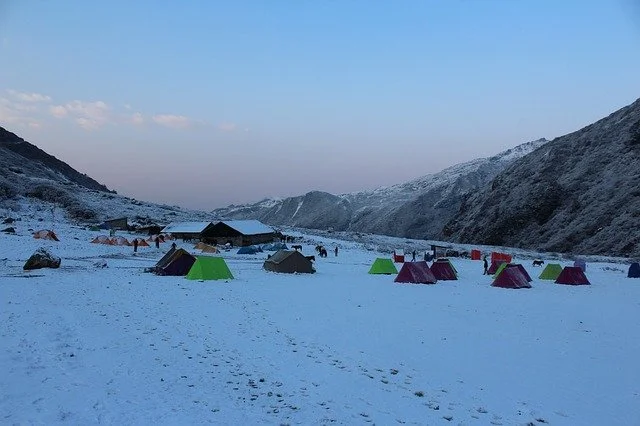
Goechala Trek
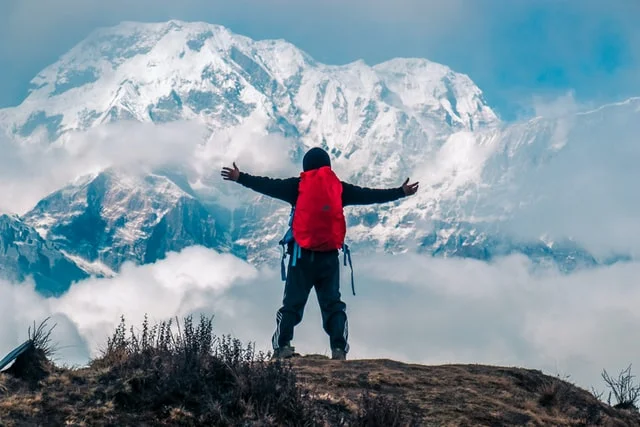
Annapurna Base Camp Trek
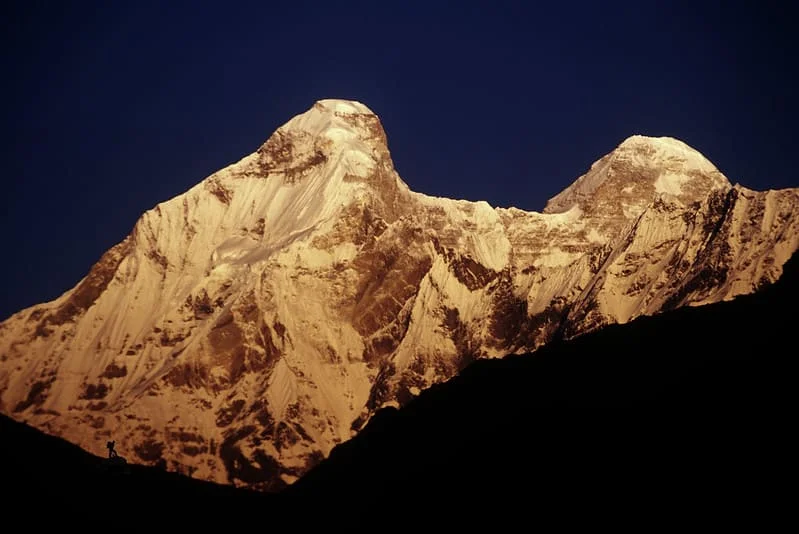
Nanda Devi Base Camp Trek
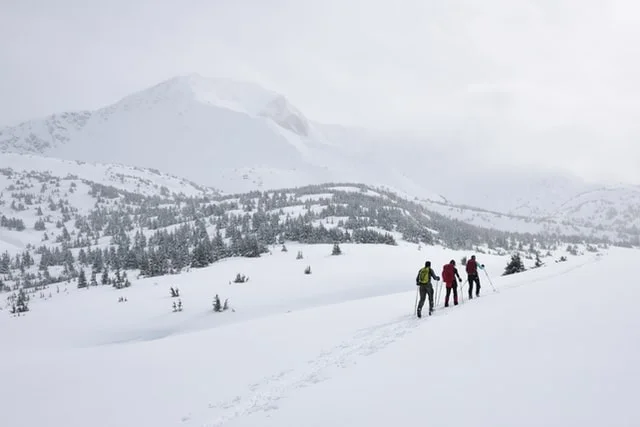
Pin Parvati Pass Trek
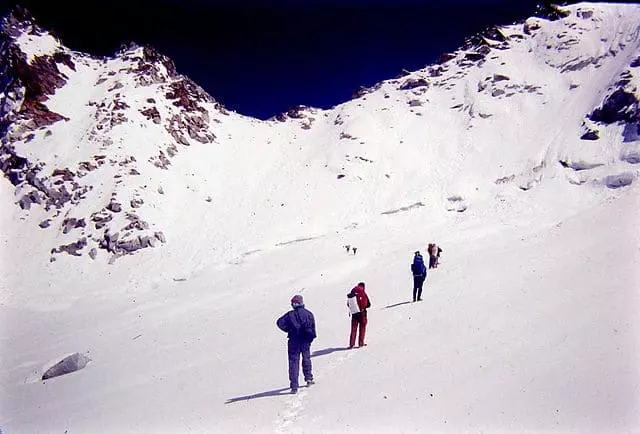
Borasu Pass Trek
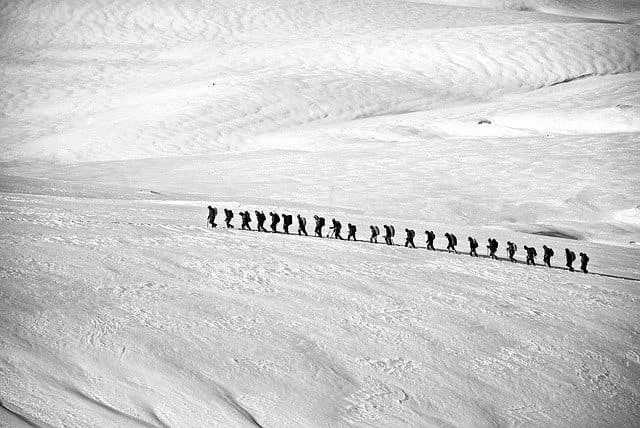
Lamkhaga Pass Trek
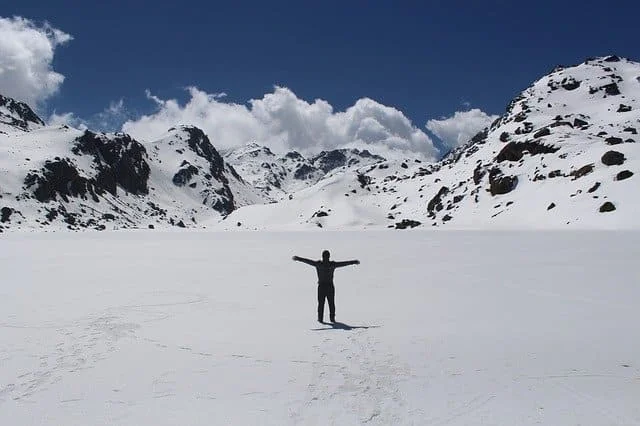
Kalindikhal Pass Trek
Choose your date.

CHADAR TREK
With the word Chadar meaning a blanket, the Chadar Trek depicts a trail over the frozen Zanskar River, on which people travel for several kilometers to reach the final destination. Unlike other trekking expeditions in India, this one does not require you to pass through forests or rock formations, but instead lets you walk over frozen water, which once was a gushing river.
Chadar Trek in the Zanskar Region has been talked about by adventurers all over the world. Hundreds of tourists have seen the secret thrills and mind-blowing sights near the frozen river of Zanskar. In fact, the Chadar Trek is one of the most popular and beautiful hikes in the Himalayas and must be part of your Ladakh trip packages . The Zanskar river is a 5KM long tributary of the mighty Indus river, and is surrounded by 600 meter high vertical cliffs.
This winter trek, which takes place over a frozen stream of river, is a once-in-a-lifetime opportunity for individuals seeking extreme adventure. The trek towards the frozen river begins at Chilling as this is the spot where the stream begins to freeze. While the ice sheets are more stable during the winter months, many people consider heading out on this expedition between the months of December to February.
To finish this trek, the adventurers are required to cover at least 16 KM on a daily basis. Since the overall trekking distance is around 75 KM, people generally take a 10 to 15 days long trip to Chadar. With the temperature dropping to -35 degree celsius, the Chadar Trek becomes even more difficult in the winter season.
• The most fascinating thing about the Chadar Trek is that it is done on a frozen stream of the Zanskar River. • While the river flows in its full gush in the summers, as the winters come, the whole stream freezes and becomes thick enough to let people walk over it. • To complete the Chadar Trek, a trekker is expected to complete 16 KM of walk on a daily basis. • Stop at Nerak Waterfall which showcases little waterfalls frozen into dangling icicles, formed by the chilling weather of the Zanskar region • The basecamp of this trek is Tilad, which can be easily reached by taking the local transportation. • Rest at the Tibb Cave, a natural shelter from the biting cold nestled along the frozen river. • Get an adrenaline-pumping experience of walking alongside towering cliffs and snow-covered landscapes and enjoy breathtaking views of snow-covered peaks, frozen waterfalls, and icy gorges.
How To Reach
To embark on the Chadar Trek, one must first travel to Leh , around where the journey commences and continues to Chilling, which is the spot where the Zanskar river starts freezing. It would take about 65-70 kilometers for people to cover the distance from Leh to Tilad via Chilling, the trek's base camp.
Checkout & Book: Homestays in Leh Ladakh
Best Time To Visit
The best time for Chadar Trek is during the peak winter season from January to early February. This is when it is the coldest here and the river is fully frozen, which is perfect for taking up this adventurous trek. This will also ensure safer and more enjoyable trekking conditions.
Planning a Ladakh Trip, Checkout: Leh Ladakh Bike Trip Packages
Other Essential Information
Things to carry for Chadar Trek:
Pack only enough toiletries to last a week in small bottles as it will help you save a lot of room and weight in your backpack.
- Small toothpaste
Trek Equipment's
- UV Protection Sunglasses
- Rucksack (50-60 L)
Miscellaneous
- Trail Munchies
- Hot Water Bag
- Medicine kit
- Ziplock bags or poly bags to compartmentalize wet, dry, and dirty stuff.
- Insulated water bottle or thermos flask
- Hot Water Bottle
Getting Acclimatization
The most harsh difficulty during the Chadar Trek is getting Acclimated with the weather conditions. Hence, it is at all times advisable to spend at least three nights in Leh before heading out for the trek. Make sure that you carry your boarding pass or any other proof of your arrival in Leh as it will be needed to reassure that you have acclimatized at least 3 days in Leh.
Mandatory Medical Checkup
Tourists must go through a mandatory medical checkup in Leh, after which only they will be allowed to head out on the Chadar trek. Tourists who are medically unfit will not be permitted to participate in the trek.
To participate in the Chadar Trek, travelers must first get a NOC (No Objection Certificate) from the ALTOA (All Ladakh Tour Operator Association).
Also See: Festivals Of Ladakh
Chadar Trek, Ladakh - Frozen River Trek
Tourism board alliances, chadar trek reviews.

More Things to do in Ladakh
Ladakh tourism, popular related attractions.
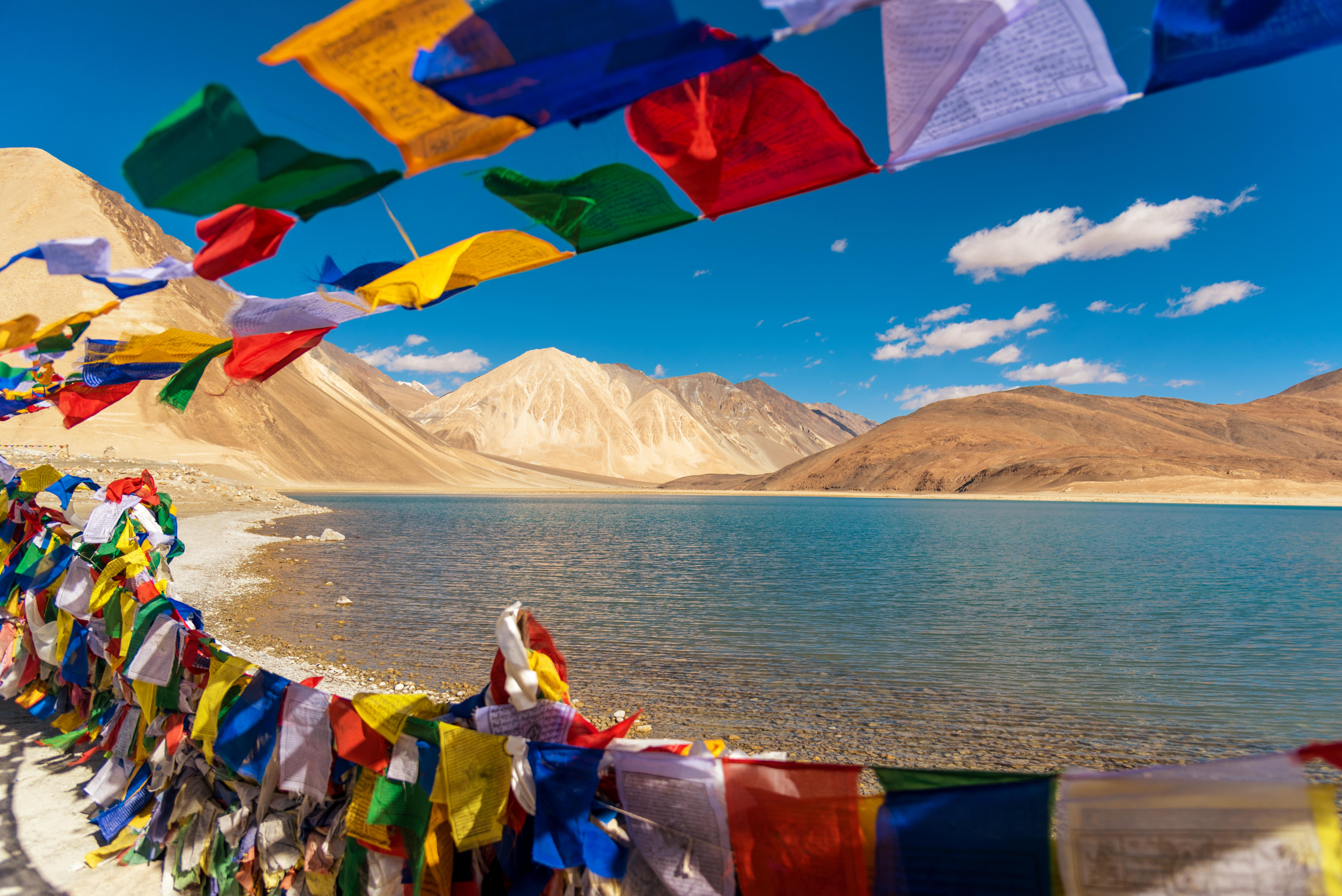
More Ladakh Attractions
Popular related destinations.
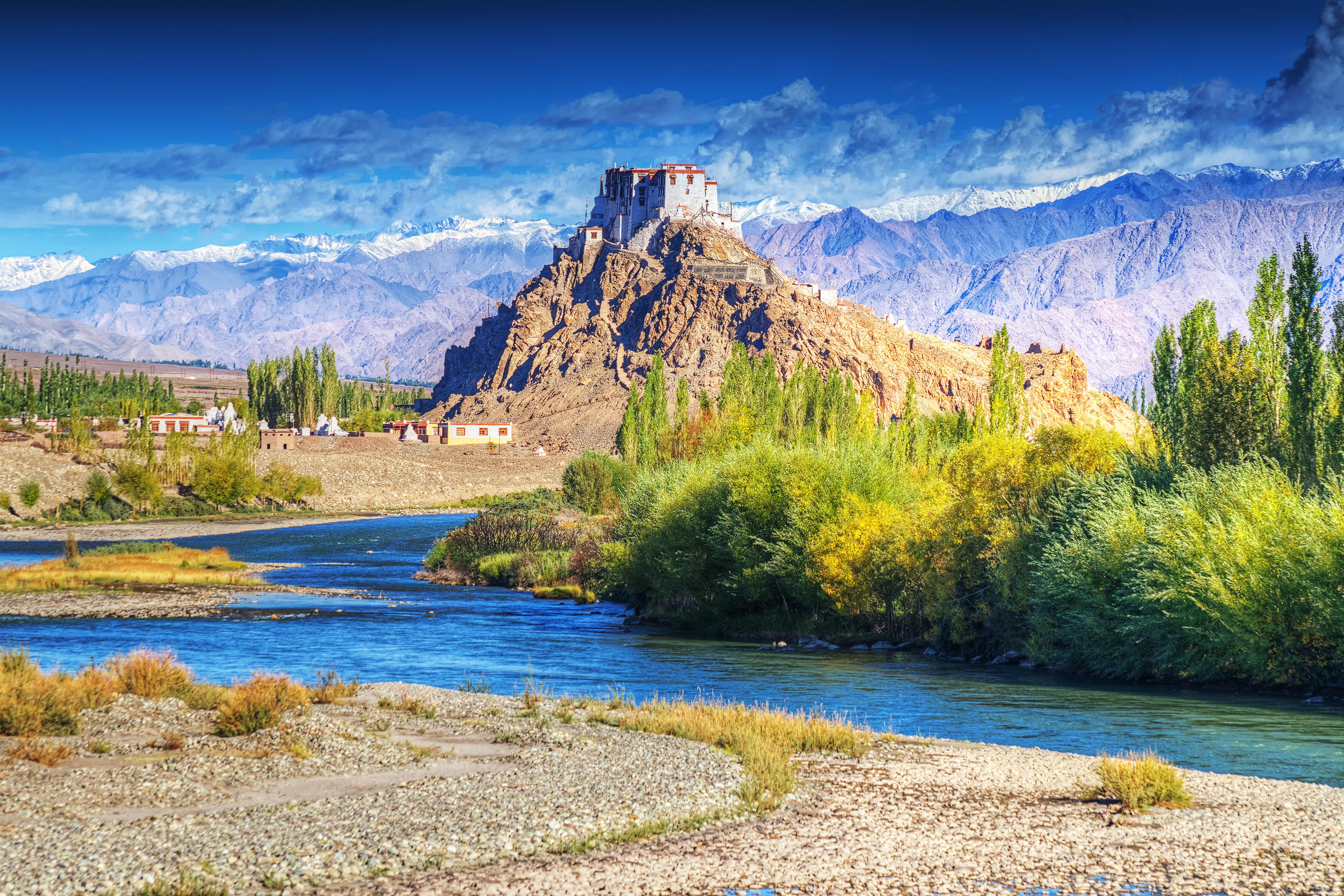
Why Choose Thrillophilia
Travel guides, best domestic packages, best international packages, domestic honeymoon packages, international honeymoon packages, places to visit in india, international places to visit, international things to do, popular on thrillophilia.
High ON Himalayas
One source for all your Himalayan Inspiration

CHADAR TREK | Walking on the frozen River Zanskar in Leh – Ladakh – A Photo Blog
The chadar trek experience .
Chadar Trek – Something that had been on my bucket list for the past three years, has finally been ticked off in 2020 ! And what an experience it was !
So for starters, the whole Chadar Trek Experience if of 8 Days , where you arrive in Leh on Day 1 , and head straight to your hotel to rest and acclimatise .
Day 2 also you rest , and possibly stroll around Leh market , and do your shopping for the Chadar Trek. The best place to get all your supplies at the cheapest possible rates is the New Army General Store in the Main Bazar in Leh.
Day 3 you go for the Medical Check up and finish up with the Insurance formalities.
Day 4 you start your Chadar Trek Experience from somewhere between Chilling and Nerak at a place called Bakula, which takes 2-3 hours by road. This day you camp at Shingra Koma, after walking for 2-3 hours.
Day 5 you head towards Tibb Cave from Shingra Koma which takes you around 6-7 hours.
Day 6 you start from Tibb Cave to reach Nerak again taking 6-7 hours.
Day 7 you start your journey back by first walking for 6-7 hours towards Hotong where you camp.
Day 8 you walk the remaining distance all the way back to Bakula taking not more than 5-6 hours , and you are back in Leh by late evening.

However, in our case things went a bit sideways!
We got done with our medical check up and got our Insurance cards on the 12th Jan 2020, and were ready to start the trek on 13th Jan 2020, but as luck would have it, the Chadar Trek got temporary suspended for two days – ie 13th Jan 2020 and 14th Jan 2020, due to bad weather. The situation was such that the river started overflowing at places beyond Tibb Cave, and a lot of trekkers had to be rescued by the Indian Army.
However, we got lucky and the authorities decided to open up the trek on the 15th Jan 2020, and we were off!
The only limitation was that we couldn’t even go beyond the first campsite Shingra Koma, as the clearance was only issued till Shingra Koma – the first main base camp of the Chadar Trek.
Despite knowing this, we started our trek on the 15th Jan 2020, camped for 2 nights in the freezing cold, and were back after ticking off the once in a lifetime experience of walking on the Chadar formed on the frozen Zanskar river on 17th Jan 2020.
While there were plenty of loopholes in the system, for example – the authorities have started charging a mandatory fees which includes the Environmental Fees, the ALTOA fees and the Medical Insurance. However, the authorities have failed to regulate the number of trekkers going for the trek.
The reality is that in a matter of 1 – 1.5 months, there are 10 to 15 operators running batches every 2-3 days, each comprising of 10-30 trekkers, which ultimately means that, on any day, there are around 100-150 trekkers starting the Chadar Trek. So you can imagine, the heavy footfall on the sensitive Chadar.
Nevertheless, doing the Chadar Trek is a once in a life time experience , which I recommend all the adventure enthusiasts should definitely do, as the whole landscape is so unreal, like straight out of a fairy tale.
So without me taking more of your time, start scrolling down and check out this Photo Blog on the Chadar Trek 2020!

If you are not that adventurous but want to explore Ladakh in the Winters , this 5 Day Leh Ladakh in Winters Itinerary would prove to be of help to you. However, if you want to visit Ladakh in the summer months, this 7 Day Leh Ladakh Road Trip Itinerary is your best source of information and inspiration.
I hope you enjoyed scrolling through these pictures, and if you too are interested in ticking off Chadar Trek off your list next year , get in touch with us at [email protected] and we along with Ladakh Travel Craft will hook you up.

Hi, I am Arnav Mathur , a hard core foodie and a travel aficionado at heart. Having changed over 8 schools in 6 different cities, every 2 years, since birth, traveling and socializing has been in my DNA. “Follow your Passion and Travel to a new place every 3-4 months and Eat, Travel, Live and REPEAT.” That’s my mantra to live a life without regrets.
Share this:
11 replies to “chadar trek | walking on the frozen river zanskar in leh – ladakh – a photo blog”.
8 days of to trek is just wow! And I feel you on the inconsistencies of those managing the trip I think it happens anywhere especially if the activity is quiet a popular one. Good thing you did not lose hope when the trek trail was suspended for 2 days.
Like you, this one is high on my list of things to do. And yes, I agree, it requires quite a lot of courage and endurance. I loved reading through your experience. Of where there was no chadar and u find new roads or the fact that you could drink straight from the zanskar. Well, kind of lived my dream through this journey but I hope I can do it for myself.
Those views are amazing!! I haven’t been on a trek before, but I had never thought about the fact that you’d have to have a medical check and insurance beforehand. That’s good to know in order to prepare. It truly looks lovely!!
Awesome pictures of this Chadar trek. It must be such great adventure. And also making new friends on the way. I would really love to have this experience sometime soon.
Chadar Trek was high on my list too but after hearing stories on how it is affecting locals I have dropped the idea. I think it is good to skip some places for skilled individuals and hikers rather than joining the bandwagon. Beautiful pictures and such a beautiful experience to cherish forever.
Your post brought back my memories of 2014 when I did this trek. The friends that I made during that trek are still in touch. As you said, this trek does require courage and endurance. While the views were grand, I loved the frozen waterfalls the most. Your pictures are stunning and description apt to the point. Now I feel like doing it again.
I have not been for such adventurous and beautiful trek before but would love to do one day. I loved your 8 days itinerary and it is very helpful too. It is good that due to bad weather and overflowing river, your trek was suspended for couple of days which shows that safety of trekkers are also considered by authorities. Enroute to Bakula which is the starting point of the Chadar Trek is really stunning. Freshly prepared Fried Rice for Lunch with view of stunning snow capped mountains look would be your best meals.
Hi Arnav, thanks for sharing your experience at Chadar Trek. I have so much wanted to do this trek but I somehow end up traveling elsewhere. The cheapest way to shop from the New Army General Store is a good tip. Your 8 day Itinerary clearly described all the things very nicely, and the photo that you clicked was really mind blowing. Thanks for the lovely blog.
Thanks. In reality its so dreamy and something that you’ve never imagined.
Wow those pictures of chader trek are mind blowing . Looks like you had a adventure for life. Am sure you never wanted those 8days to get over during the trip. This is truly an inspiration for all the travelers out there. Thanks for inspiring us
Well, we were only able to have the Chadar Trek experience for 3 days, because of the heavy snowfall, leading to weakening of the Chadar.
Leave a Reply Cancel reply
Your email address will not be published. Required fields are marked *
Notify me of new posts by email.
This site uses Akismet to reduce spam. Learn how your comment data is processed .
Privacy Overview
Chadar Trek

Top ways to experience nearby attractions

Also popular with travellers

Chadar Trek - All You Need to Know BEFORE You Go (2024) - Tripadvisor

IMAGES
COMMENTS
The Chadar Frozen Trek is renowned as one of the world's most iconic and challenging treks, offering a unique and extraordinary experience for adventurers. Takes trekkers through the starkly beautiful and remote landscapes of Ladakh, providing an opportunity to witness the untouched beauty of the region. Trekkers traverse the frozen Zanskar ...
The Chadar Trek is one of the most wild and beautiful hikes on the planet. Frequently covered by the world's top adventure channels and media outlets, the Chadar Trek takes hikers through a frozen river valley into the very heartland of India's Ladakh region. The region's harsh desert environment and towering mountains make the Chadar trek ...
Chadar Trek is a unique and exhilarating winter trek in Ladakh, where you walk on the frozen Zanskar river. Learn about the itinerary, reviews, cost, expert tips and safety precautions from Trekup India, the best trekking company in India.
Chadar Trek In Leh - over the Zanskar River range of Ladakh-2024- Complete information, Itinerary, Costs Date. Your trek journey started with Himalayan Hikers, beautiful mountain town of Leh, all our trekker reach Leh by flight this is best option to you reach to Leh, altitude is 11400 feet above sea level, the trek beautiful Zanskar River which liws totally frozen during the December to Feb ...
Best Time to Visit Chadar Trek. The ideal time to visit the Frozen River Chadar Trek is between mid-January to February as during this time the upper layer of the Zanskar River freezes. The river looks like a sheet of ice; hence, it is referred to in the local language as 'Chadar' which means blanket. Read more: Hidden Hill Stations In India.
The Chadar Trek is considered to be one of the most challenging treks in the world, primarily due to the extreme weather conditions and the rugged terrain. Trekkers are required to cover long distances each day, often walking for 6-8 hours on the icy surface of the river. Additionally, the sub-zero temperatures and high altitude can take a toll ...
BRS 5. Chadar - The Frozen River Trek is a level 5 adventure on the Bikat Rating Scale. This makes it mandatory for you to have high-altitude experience of preferably multiple treks marked at level 4 on the BRS. The altitude, the terrain and the nature of the climb demand a certain level of skill and a need for you to be aware of how your body ...
The Chadar Trek or the Frozen River Trek is the most popular winter trek in India. A 09-day trek walking on the frozen river of Zanskar and temperatures as low as -30C. Taking place in the beautiful land of Ladakh, the Chadar trek is truly an experience of a lifetime. In winter, as the temperature plummets, a layer of ice develops on the river ...
Chadar Trek. Proceed cautiously on this 48.1-mile point--point trail near Ladakh, Jammu and Kashmir. Generally considered a highly challenging route, it should only be attempted by experienced adventurers. This is a very popular area for backpacking, camping, and hiking, so you'll likely encounter other people while exploring.
Chadar Trek in Ladakh is a unique experience, unlike any other trek in the Himalayas. Walking on a frozen river with towering mountains on either side is simply breathtaking. ... People Reviews. Short itinerary. Day 1 : Reporting at Leh (3,500 m / 11,450 ft) The cab will be arranged at an additional cost from Leh Airport to Trekkaro Leh Hotel ...
The chadar trek is also a dynamic and diverse trek, as it offers different landscapes, terrains, and views, depending on the time of the day, the angle of the sun, and the thickness of the ice. 2. The chadar trek is a thrilling and exciting trek, as it involves walking, sliding, crawling, and sometimes even swimming on the frozen river. The ...
Chadar Trek, Ladakh: See reviews, articles, and 10 photos of Chadar Trek, ranked No.142 on Tripadvisor among 146 attractions in Ladakh.
Read Thrillophilia reviews of Chadar Trek Ladakh. Check what 7967 happy customers have to say about their experience with Thrillophilia before booking. Chadar Trek, Ladakh 2024: Book @ Best Price only at Thrillophilia. Avail Best Offers on Chadar Frozen River Trek. Get the best deals on Chadar Trek Package. ...
The Chadar trek cost 54,500 rupees which covers all the inclusions from the base camp. The Chadar trek is your chance to pledge a connection with the majestic Himalayas, serene lakes, and rugged terrain. Trekmunk has the perfect itinerary for your trekking plans. Place your trust on us to lead you through the most enriching route you've ever ...
Chadar Frozen River Trek. Proud winner of Tripadvisor Travellers' Choice Award 2020. Encapsulated within the range of the Great Himalayan Mountains -with peaks as high as 7,000m - India's Zanskar valley aka Chadar Trek has stayed isolated for centuries. But with boosted tourism in recent years in Leh and Ladakh, the Zanskar valley has ...
Chadar Trek - Book Your Bucket List Adventure! Starting from. ₹ 23125 ₹ 18,500 +5% GST. 25% OFF. (28 reviews) Unique experience of trekking on the frozen Zanskar River. Amazing scenery, wild gorges and frozen waterfalls. It is an adventure-seeker's paradise. The frozen river which connects Zanskar valley to Ladakh.
The best time for Chadar Trek is during the peak winter season from January to early February. This is when it is the coldest here and the river is fully frozen, which is perfect for taking up this adventurous trek. This will also ensure safer and more enjoyable trekking conditions. Planning a Ladakh Trip, Checkout: Leh Ladakh Bike Trip Packages.
As mentioned earlier in the Chadar trek review, mid-January to mid-February is the best period to plan this trek. During this period, the river freezes and the sheet of ice isn't thin enough to cause any problems. As the snow starts melting in the last week of February, the sheet of ice gets thin, which can be risky and dangerous for trekkers.
Day 4 you start your Chadar Trek Experience from somewhere between Chilling and Nerak at a place called Bakula, which takes 2-3 hours by road. This day you camp at Shingra Koma, after walking for 2-3 hours. Day 5 you head towards Tibb Cave from Shingra Koma which takes you around 6-7 hours. Day 6 you start from Tibb Cave to reach Nerak again ...
Chadar Trek. See all things to do. See all things to do. Chadar Trek #142 of 146 things to do in Ladakh. Hiking Trails. Closed now. Wednesday. 12:00 AM - 11:59 PM. Write a review. Full view. All photos (10) Suggest edits to improve what we show. Improve this listing. Top ways to experience nearby attractions.
Chadar Trek follows the River Zanskar in the northern reaches of Himalaya in Ladakh, a waterway that has been the source of life and passageway for the locals for centuries. In winter, the connecting trails to villages disappear under snow and so they use this frozen river as their pathway instead, 'Chadar' means a frozen blanket of ice. This multi-day trek should only be done in a group due ...
The Chadar trek is one of the most difficult, exciting, and worthy trek with the thrill of walking on crystal clear Ice. It is an 8-day trek and one of the longest treks with a distance of 52 km. It takes place in the coldest months of the year, January to February. Experience the exotic vistas of frozen waterfalls get a glance at the tough yet ...
Chadar trek is the most famous trek as it offers a sheer thrill of walking over a frozer river. During the winter ,Ladakh, is isolated from the whole country due to heavy snowfall. The only way to Ladakh is by air from Delhi. In winter the temperature goes down to 30 below zero and the mighty Zanskar river freezes.